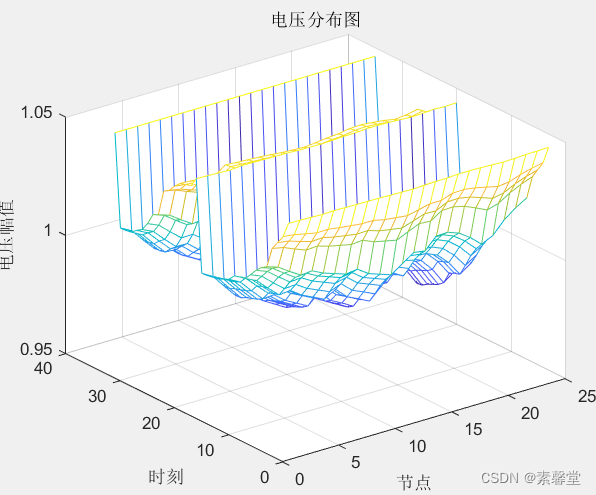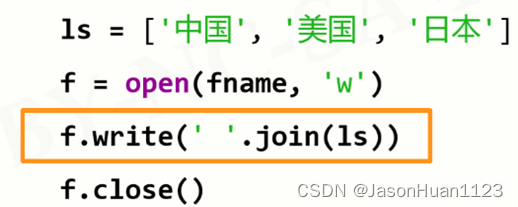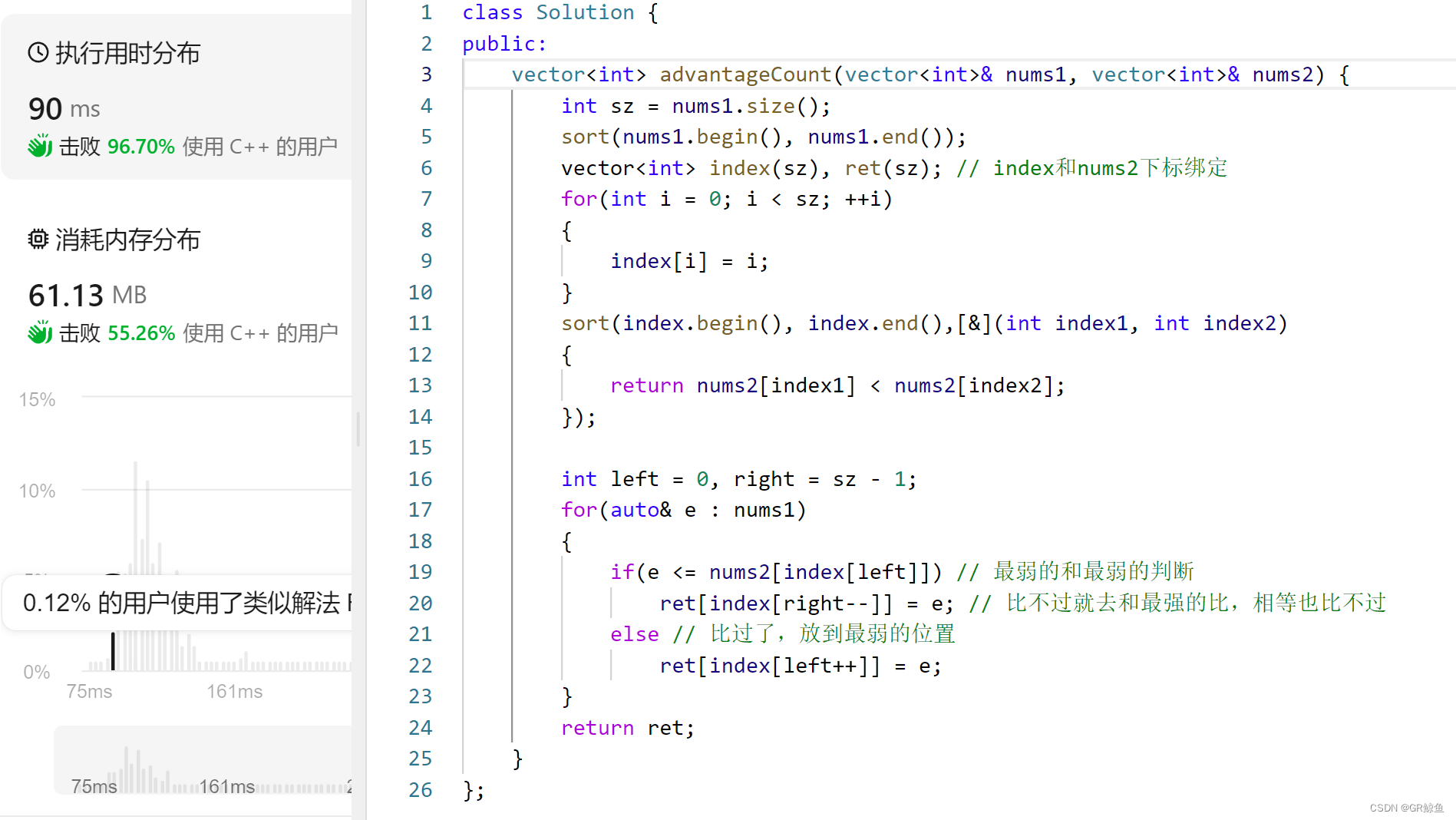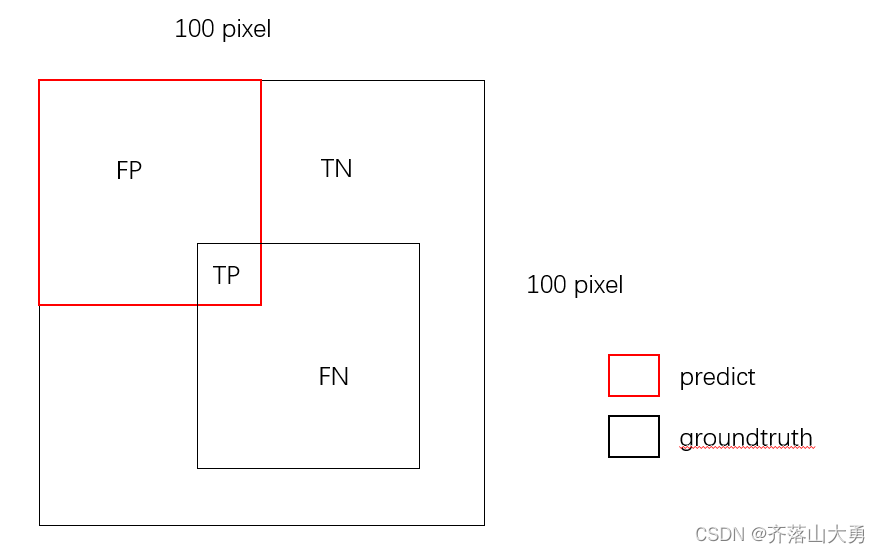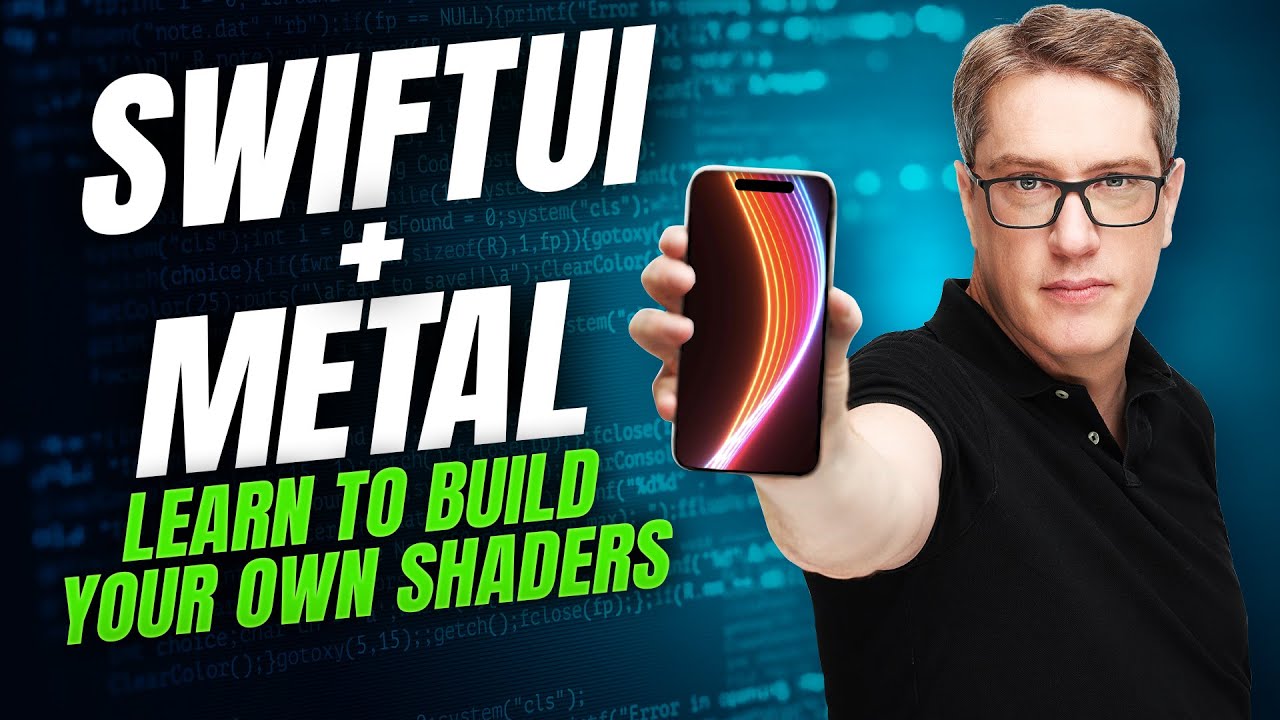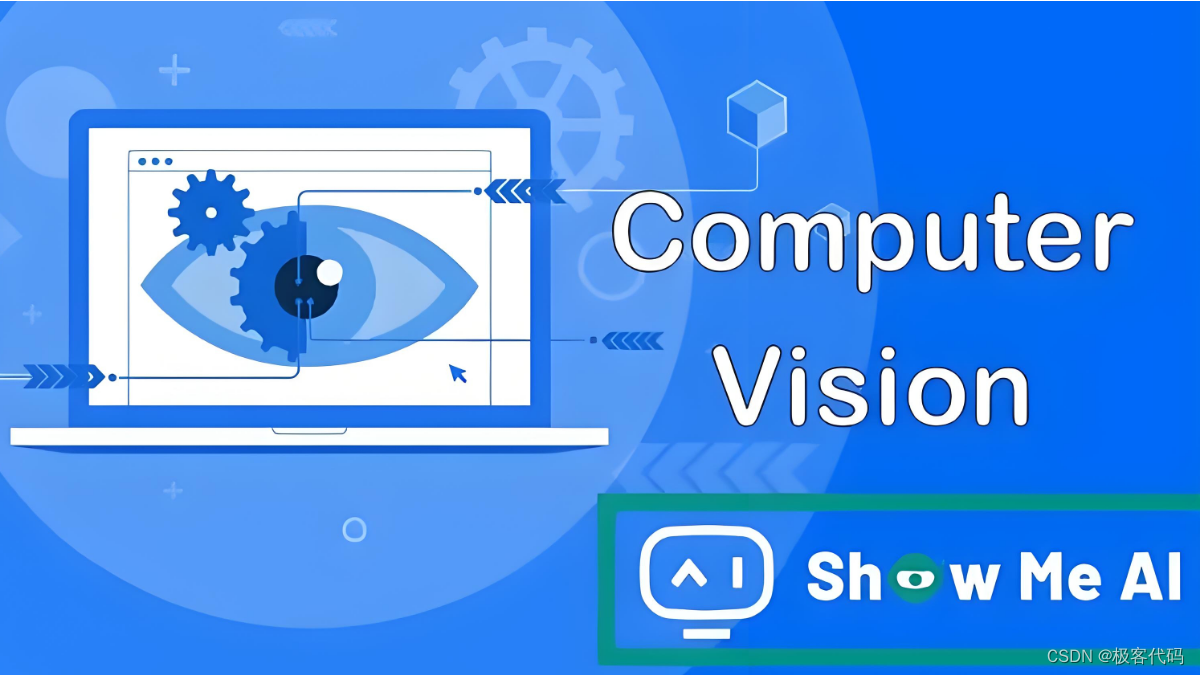Tricky English Grammar
Course Certificate
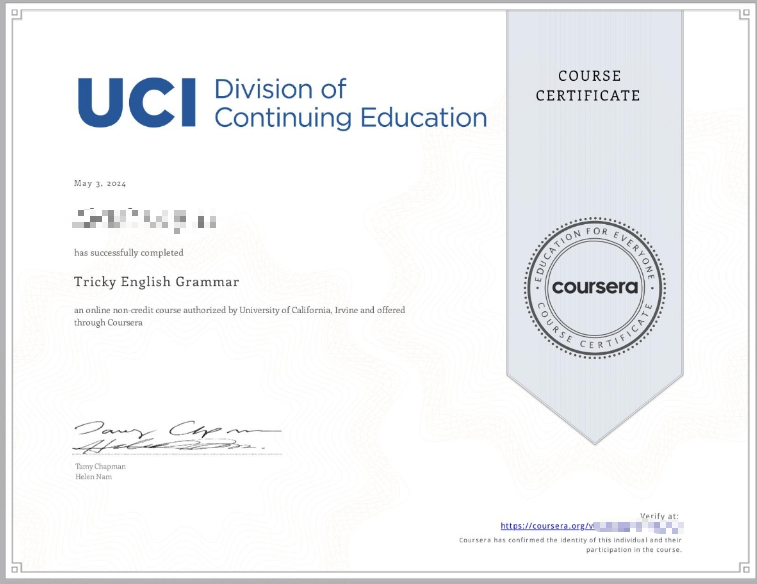
Course Intro
本文是学习 https://www.coursera.org/learn/tricky-english-grammar?specialization=intermediate-grammar 这门课的学习笔记

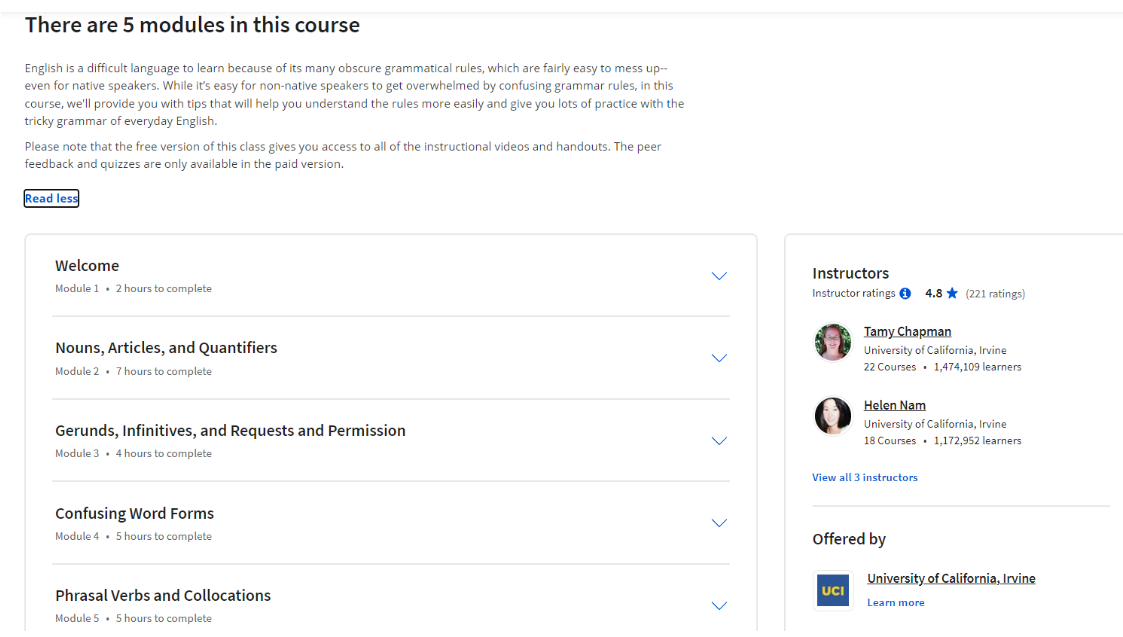
文章目录
- Tricky English Grammar
- Week 01: Nouns, Articles, and Quantifiers
- Learning Objectives
- Count and Noncount Nouns Review Lecture
- Count and Noncount Noun Mistakes Lecture
- Count and Non-Count Noun Practice Quiz
- Count and Non-Count Nouns Practice
- Articles Review Part 1 Lecture
- Articles Practice Quiz
- Articles Review Part 2 Lecture
- Articles Review Part 3 Lecture
- Mistakes with Articles Part 1 Lecture
- Mistakes with Articles Part 2 Lecture
- Articles Practice
- Quantifiers Part 1 Lecture
- Quantifiers Part 2 Lecture
- Quantifiers Part 3 Lecture
- Quantifiers Practice Quiz
- Quantifiers Part 4 Lecture
- Quantifiers Practice
- Graded Assignment: Nouns, Articles, and Quanifiers Assignment
- Graded Quiz
- Week 02: Gerunds, Infinitives, and Requests and Permission
- Learning Objectives
- Gerunds and Infinitives Part 1 Lecture
- Gerunds and Infinitives Part 2 Lecture
- Gerunds and Infinitives Practice
- Gerunds and Infinitives Practice Quiz
- Requests and Permission Lecture
- Requests and Permission Practice Quiz
- Requests and Permission Practice
- Graded Assignment: Gerunds, Infinitives, Requests, and Permission Assignment
- Graded Quiz
- Week 03: Confusing Word Forms
- Learning Objectives
- Confusing Pronouns Lecture
- Confusing Pronouns Practice Quiz
- Confusing Pronouns Practice
- Confusing Adjectives and Adverbs Part 1 Lecture
- Confusing Adjectives and Adverbs Part 2 Lecture
- Confusing Adjectives and Adverbs Practice Quiz
- Confusing Adjectives and Adverbs Practice
- Confusing Nouns and Verbs Part 1 Lecture
- Confusing Nouns and Verbs Part 2 Lecture
- Confusing Nouns and Verbs Practice Quiz
- Confusing Nouns and Verbs Practice
- Confusing Prepositions Lecture
- Confusing Prepositions Practice Quiz
- Confusing Prepositions Practice
- Graded Assignment: Confusing Word Forms Assignment
- Graded Quiz
- Week 04: Phrasal Verbs and Collocations
- Learning Objectives
- Phrasal Verbs Review Lecture
- Problems with Phrasal Verbs Lecture
- Phrasal Verbs Practice
- Phrasal Verbs Practice Quiz
- Collocations Review Lecture
- Tricky Collocations Lecture
- Collocations Practice Quiz
- Tricky English Review
- Tricky English Practice Quiz
- Tricky English Final Practice
- Graded Assignment: Tricky English Assignment
- Graded Quiz
- 后记
Nouns, Articles, and Quantifiers: 名词、冠词和量词
determiner:限定词
gerund: 美 [ˈdʒerənd] 动名词 注意发音
Infinitive:不定式
indefinite article: 不定冠词 美 [ɪnˈdefɪnət ˈɑːrtɪkl]
the definite article:定冠词
possessive pronoun: 物主代词
reflexive pronoun: 反身代词
indefinite pronoun:不定代词
collocation: 美 [ˌkɑːləˈkeɪʃn] 搭配;组合
transitive and intransitive phrasal verbs:及物和不及物短语动词
——————————————————————————————————————
measles:美 [ˈmiːzlz] 麻疹
mumps:美 [məmps] 流行性腮腺炎
measles, mumps, and AIDS. 麻疹、腮腺炎和艾滋病。
Billiards:美 [ˈbɪljərdz] 台球,桌球
utensil:美 [juːˈtensl] 器皿;用具
hippo:河马 (hippopotamus)
safari:美 [səˈfɑːri] 观兽旅行;捕猎旅行;长途旅行;旅游期间; safari park:野生动物园
mountain ranges:山脉
ordinal:顺序的,序数的
curtain:美 [ˈkɜːrtn] 窗帘
campfire:美 [ˈkæmpfaɪər] 营火,篝火
jewelry:美 [ˈdʒuːəlri] 珠宝;首饰;珠宝类 注意发音
job hunt:找工作,名词
podium:美 [ˈpoʊdiəm] 讲台;乐队指挥台;
To place the podium center stage would be best. 最好把讲台放在舞台中央。
silverware:美 [ˈsɪlvərwer] 银餐具;银制品;银器
napkin:餐巾纸
Would you also consider setting the silverware and napkins on the tables? 你会考虑在桌子上摆放餐具和餐巾吗?
event:美 [ɪˈvent] 事件;(尤指)重要事情;大事;赛事; 注意发音
moped:美 [ˈmoʊˌpɛd] 机动自行车;轻便摩托车;
Week 01: Nouns, Articles, and Quantifiers
This week, you’ll learn about tricky nouns, articles, and quantifiers. When should you put “a” or “the” in front of a noun? When should you put nothing in front of the noun? In this module, you’ll find the answers to these questions, and you’ll get lots of practice to help you use nouns and articles correctly.
Learning Objectives
- • identify some common non-count nouns
- • determine whether a singular or plural verb is needed for a particular noun
- • identify six common mistakes with count and non-count nouns
- • correct common mistakes with count and non-count nouns
- • list the two indefinite articles
- • use the indefinite articles correctly with nouns
- • use the indefinite articles in correct situations
- • list the one definite article
- • use the definite article correctly in sentences
- • summarize the rules for using articles
- • identify mistakes with articles
- • use articles correctly most of the time
- • explain what quantifiers are and where to put them
- • list several examples of common quantifiers
- • list many different quantifiers
- • use big-quantity and small-quantity quantifiers with both count and non-count nouns
- • list and use the quantifiers that are used with only count nouns
- • list and use the quantifiers that are used with only non-count nouns
- • identify common mistakes with quantifiers
- • use quantifiers correctly most of the time
Count and Noncount Nouns Review Lecture
Hi there. In this lesson,
we will review the main rules for count and noncount noun use. Remember, nouns describe people,
like doctor, teacher, student, lawyer. Places, such as school,
work, bank, restaurant. And things like water,
sun, love, textbook.
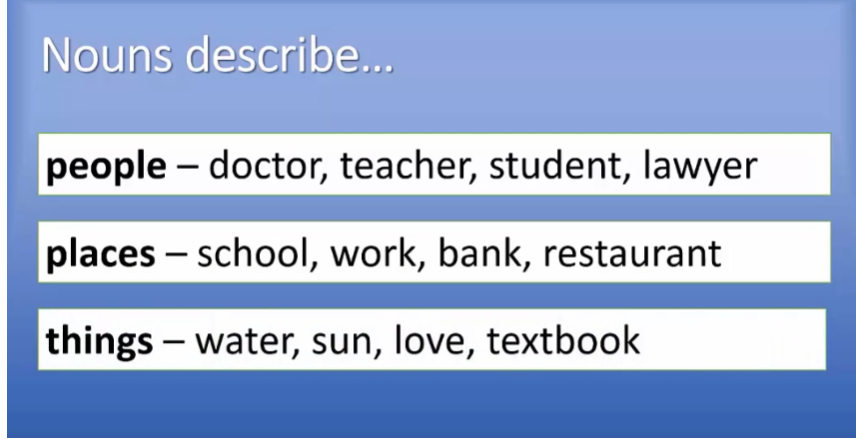
For example,
in these sentences we have several nouns. They’re underlined in yellow. What’s important about nouns is
actually there are two types, countable and noncountable nouns. For short, we’ll call them count and
noncount nouns. With count nouns that means we can use a,
an, one, and numbers because these
items are able to be counted. But with noncount nouns
we can’t use numbers. They cannot be counted. With count nouns,
if you have more than one, then we have to use the plural
forms by adding s, es, or ies.
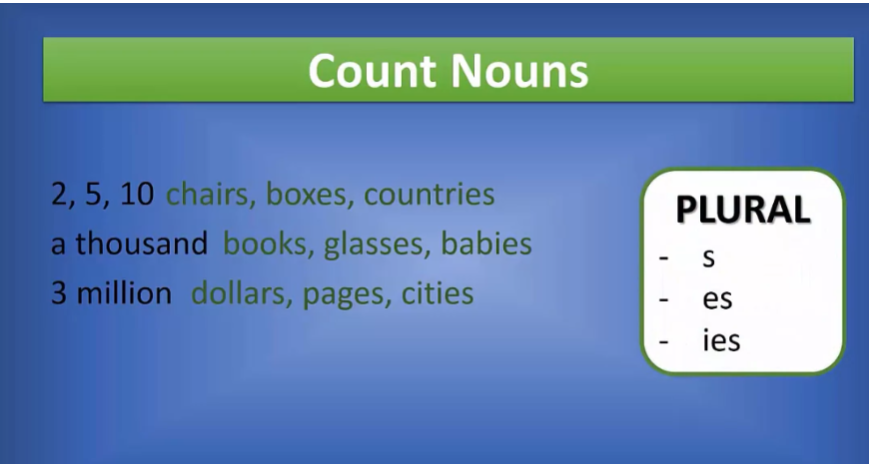
Let’s review some rules for
making plural nouns. Here, V means vowels,
which are the letters A, E, I, O, and U. And C represents consonants, which
are all the other letters in English. To make most nouns plural,
we simply add an s, such as ants, desks, seasons, cars. If there is a vowel and y, we just add s, like essays, boys, keys, and toys. If we have a word with a vowel and
o, we just add s, for example, zoos, pianos, videos. If a noun ends in a consonant plus y, we need to change the y to i and
then add es, such as libraries,
countries, babies, ladies. Words that end in sh, ch,
ss, and x need es added, for example, boxes, buses,
matches, and taxes. Words that end in a consonant and o, we
add es like heroes, potatoes, and zeroes.
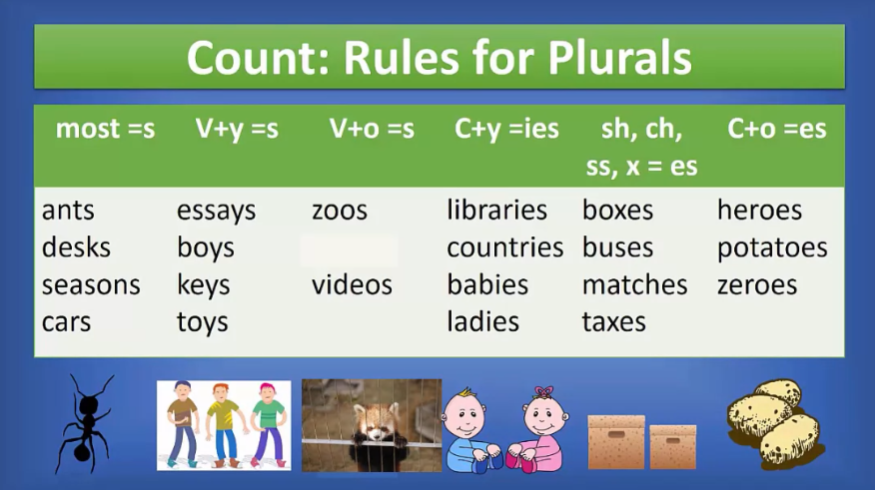
But there are also irregular plural
nouns that do not follow these patterns, such as children, men,
women, mice, and feet. Noncount nouns like these
are a little different. Because count nouns are countable,
we can use numbers. But we cannot count rice or air, so we can’t use numbers in
front of noncount nouns. Most noncount nouns fall into
a few categories like very small things that are too
difficult to count alone, gases, things you study in school, things that make up the whole
of a group of items. Other categories include activities
such as things you do for fun as well as diseases and
abstract ideas.
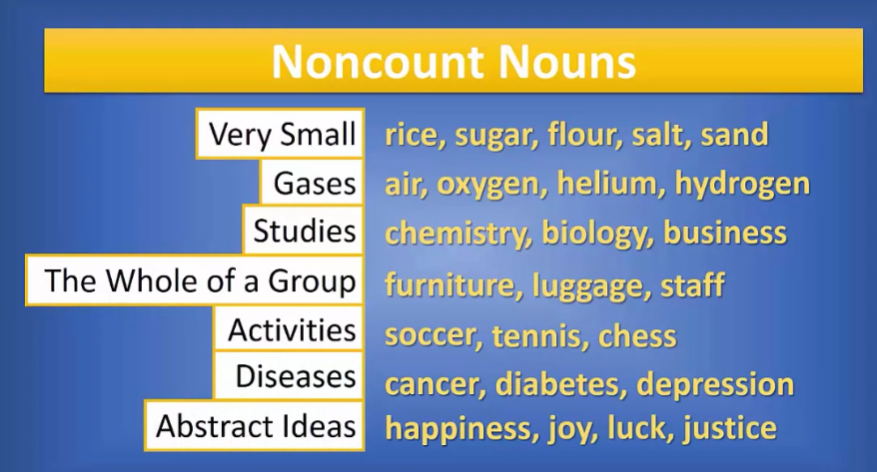
But how do you know if a noun
is countable or uncountable? The best way is to check
an English-English dictionary. Nowadays you can find
several free ones online. When you look at the dictionary,
next to the listing for noun you should see a note about
whether or not the noun is countable. The reason knowing whether
a noun is countable or not is important is because it
can affect which verb you choose. The subject, which is often a noun,
needs to agree with the verb. What that means is when you
have a singular subject, it must agree with a singular verb. When you have a plural subject,
you must use a plural verb.
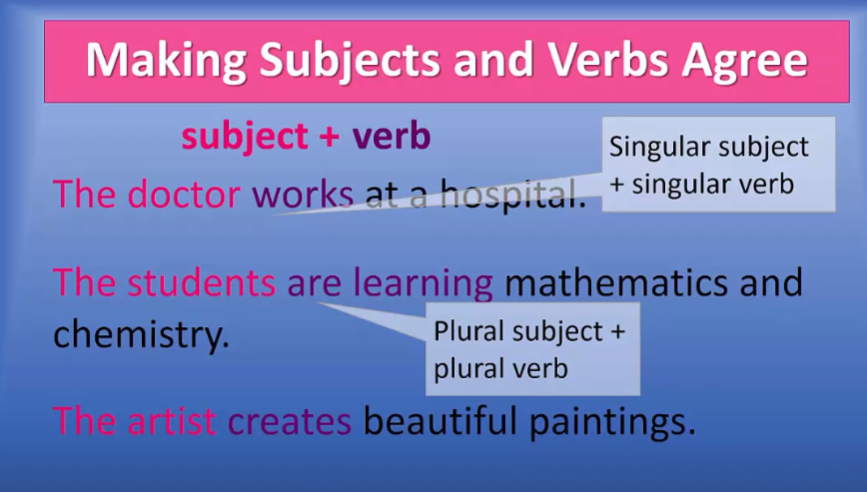
What that means is for
single count nouns as well as noncount nouns we need to use singular verbs. With plural count nouns, use plural verbs. But because noncount nouns
don’t have a plural form, we can’t use the plural
verb with noncount nouns. In this lesson we reviewed the main
rules for count and noncount noun use.
Count and Noncount Noun Mistakes Lecture
What’s wrong with these sentences? If you’ve made these types of mistakes
with nouns in English, no one would stop and correct you because in the big
picture, they are minor mistakes. But native English speakers
will quickly recognize you as a non native user of English,
if you make these types of mistakes. Each of these sentences is wrong, because
of a misunderstanding about the nouns. You see them underlined in green. In this lesson, we’ll learn how to
avoid common mistakes with count and noncount nouns. Let’s look at the first sentence. I found informations on the Internet. This error is misusing noncount
nouns with plural forms. Because noncount nouns are singular only,
do not take a plural S or ES form. These nouns are not countable, which means we cannot use S or
ES on the end to make the word plural. So to correct the sentence,
take off the plural s from informations, so we have,
I found information on the internet.
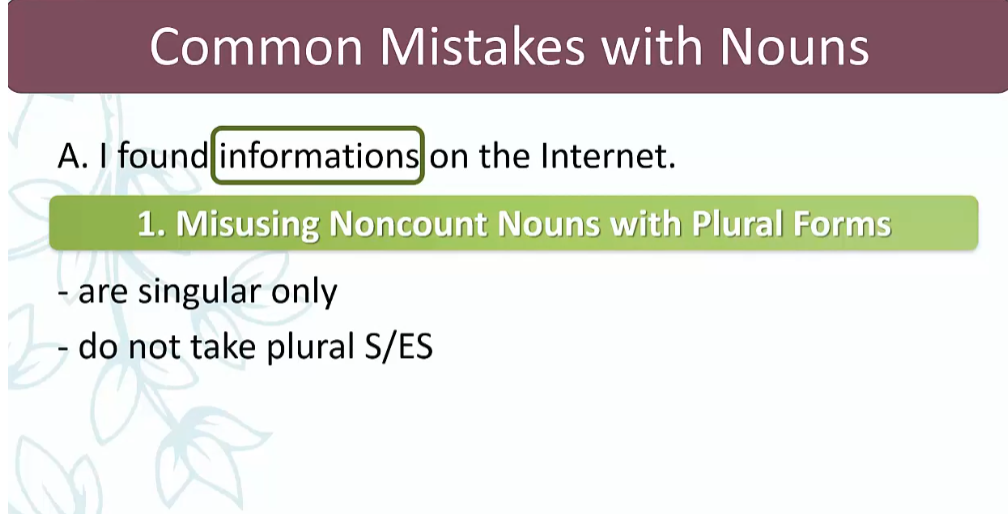
In the sentence,
we need a new luggage before the trip, there’s a problem with
luggage being used with a. We cannot use A or AN with noncount nouns. A and AN mean one, but
noncount nouns cannot be counted. With these noncount nouns,
we cannot use numbers in front of them.
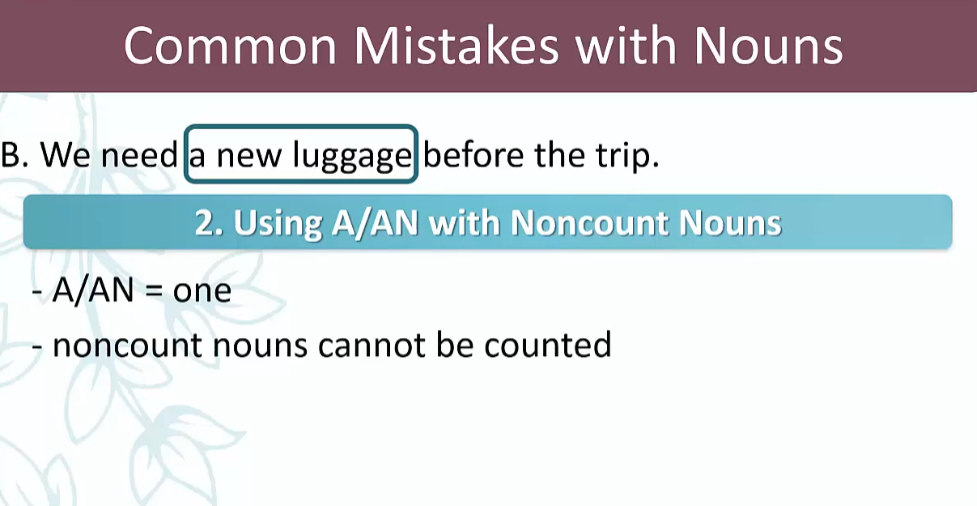
We also cannot use A or
AN in front of them. To correct the original sentence, remove a so we have we need new luggage before the trip. In the next sentence,
where is the scissors, we have incorrect subject verb
agreement in paired nouns. Subject verb agreement means the subject
and verb must both be singular or plural. Paired nouns, however have two parts and that makes them plural nouns
that need plural verbs.

We have several words like this
in English for example, scissors, binoculars, tongs,
glasses also called spectacles, and words that go along with us being
able to walk on two legs like shoes, pants, which includes jeans and shorts. To correct this type of mistake replace
the singular verb with the plural verb. In this case, we need are instead of is.
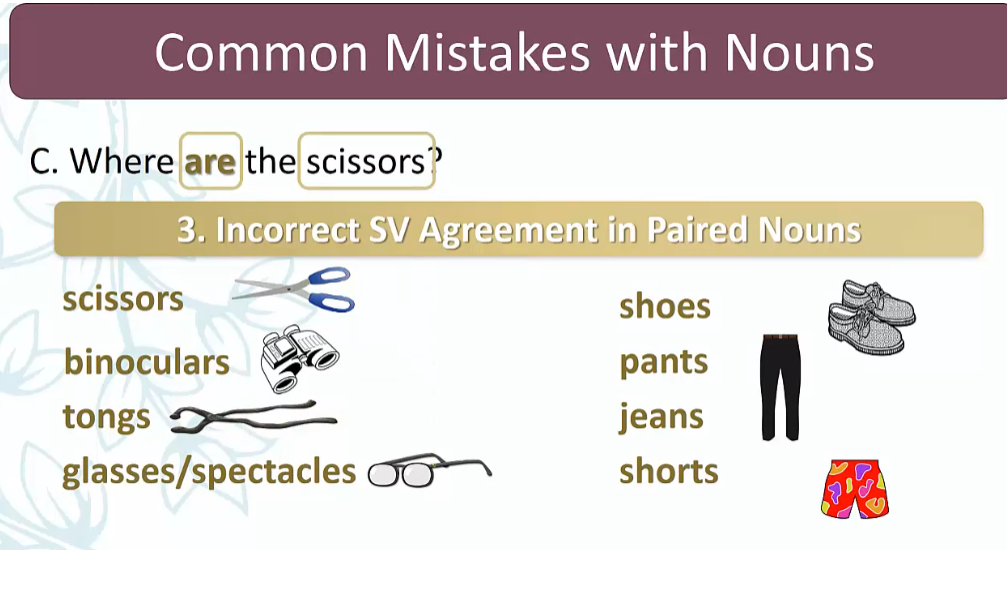
Another error is seen in this sentence. John doesn’t have monies. Money is in the plural. Monies is a special use of
a usually noncount noun. Some noncount nouns can
be used in plural form. But they often have a special
meaning in the plural. Here are some usually noncount nouns,
money and currency, that can be used in the plural but with
a very different and specific meaning. If you work in international business,
finance, or accounting you might use these words
in the plural when you’re talking about international markets and
trading international currencies. But if you don’t work in
those kinds of businesses you wouldn’t use these in the plural.
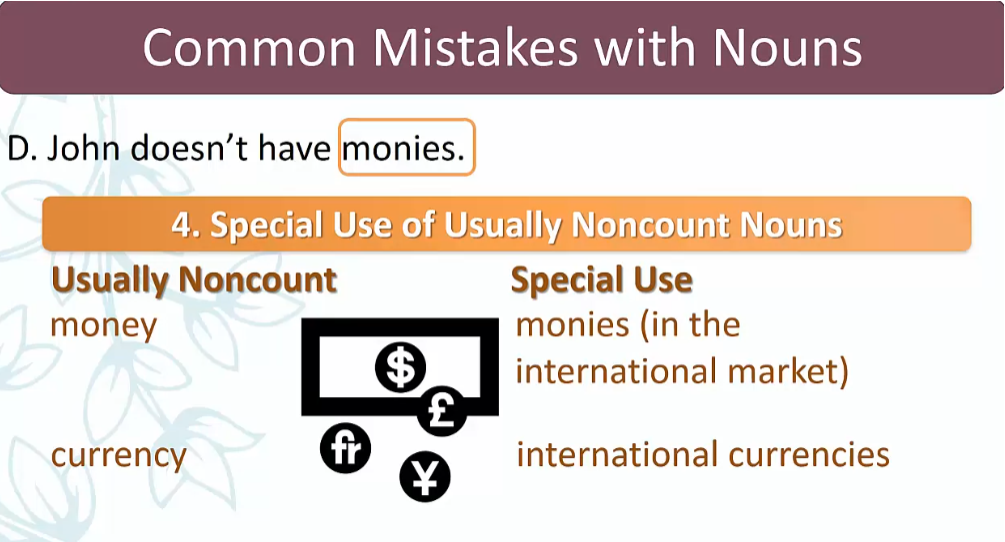
Some other normally noncount nouns might
be heard in the plural in conversations. For example, coffee and water. You might hear I want a coffee or
can we have three waters please? Especially in restaurants
when people are ordering.
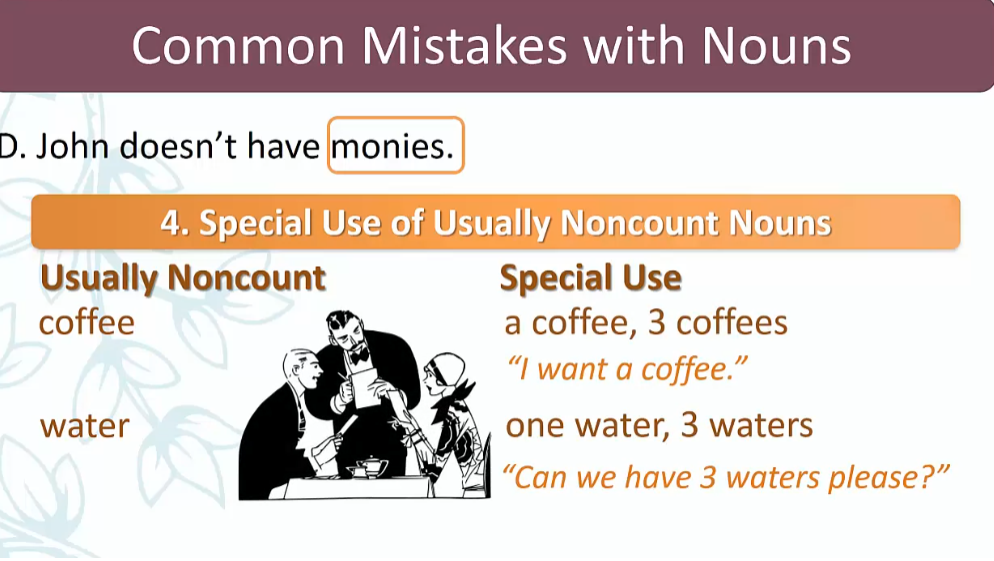
But what the speaker really means
is I want a cup of coffee and can we have three glasses of water? In formal situations and especially in
writing, it is best to include cup of or glasses of, and
use these words as noncount nouns. We see similar special use with
noncount nouns in the words food, cuisine, and wine. You might sometimes hear or see them
as plural, meaning a kind or type of. For example,
I enjoy different foods from all over. Or northern California is known for
its many wines.
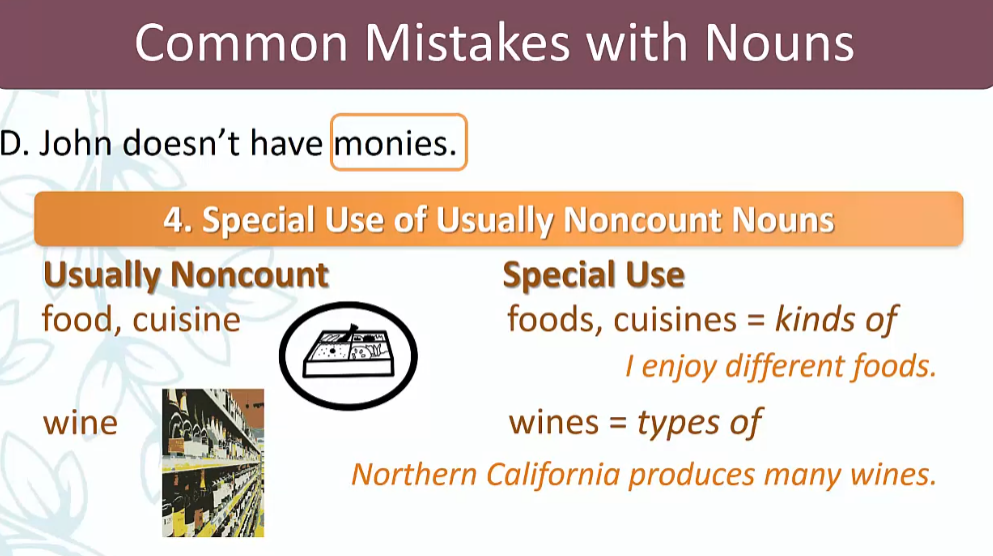
But what the speaker really means is,
I enjoy different kinds of food from all over and northern California
is known for its many types of wine. Again, the more formal form is to
include kinds of or types of, and use these words as noncount nouns. Some other noncount nouns used in
a similar way include candy and candies, fruit and fruits, meat and
meats, cheese and cheeses. So to correct our sentence we need
to take out the plural, monies. And use the singular noncount form
money because John isn’t trading in international currencies,
he is simply broke.
In this sentence world news
are important to know, there is a mistake with noncount
noun endings that use S. There are some noncount nouns that
have S at the end, but aren’t plural. Here are some other examples. News as in daily events and information,
school subjects like physics, mathematics, statistics, customs
meaning a department of immigration. They’re the ones who ask you do
you have anything to declare when you arrive in a new country. Billiards is a type of ball
game you play on a table. Several illnesses end in s like measles,
mumps, and AIDS.
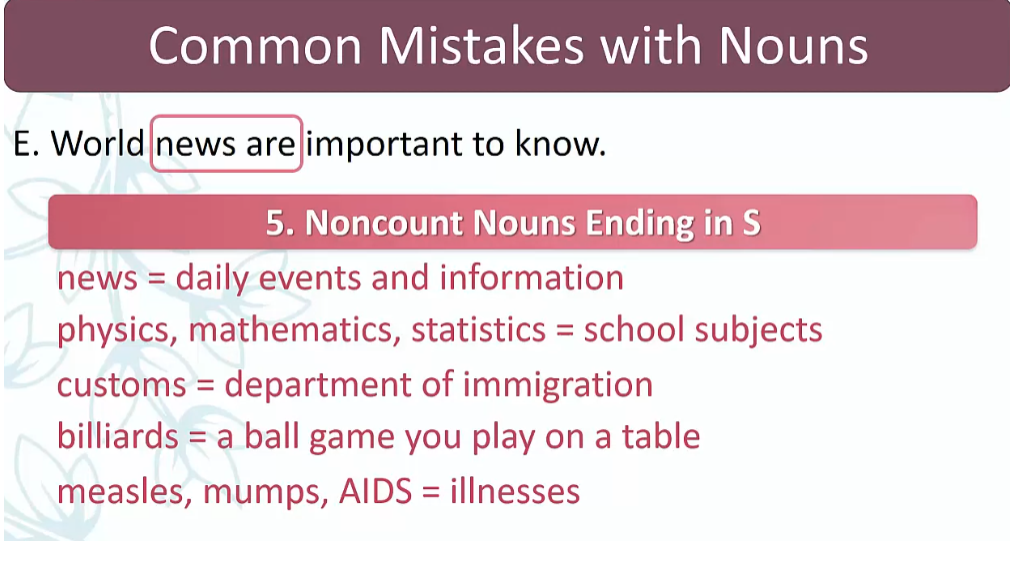
Each of these words is noncountable and therefore needs a singular
verb following it. For example, news is happening every day. Physics is a difficult subject. Customs requires you to declare money and
goods. Billiards appears confusing to me. Measles kills people every year. To correct the mistake, replace are with is in
our original example.

For this sentence the data is important,
we have the opposite problem. Irregular plural count nouns need
to have subject verb agreement. But some countdowns have irregular plural
forms that do not follow the usual pattern of S endings. In English we have some nouns with very
different plural forms like datum data, criterion criteria, and
phenomenon and phenomena. Then we have some nouns
that don’t change at all, like sheep, shrimp, and fish.
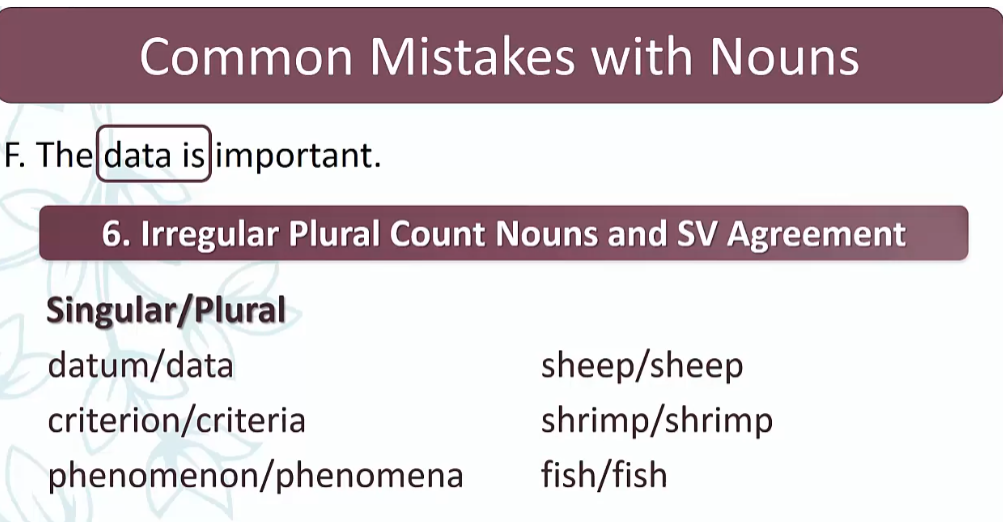
So for instance, the datum is
important and the data are important. The criterion has a purpose and
the criteria have a purpose. A strange phenomenon occurs every June,
and strange phenomena occur every June. When we use these words the singular
form needs a singular verb and the plural form needs a plural verb.
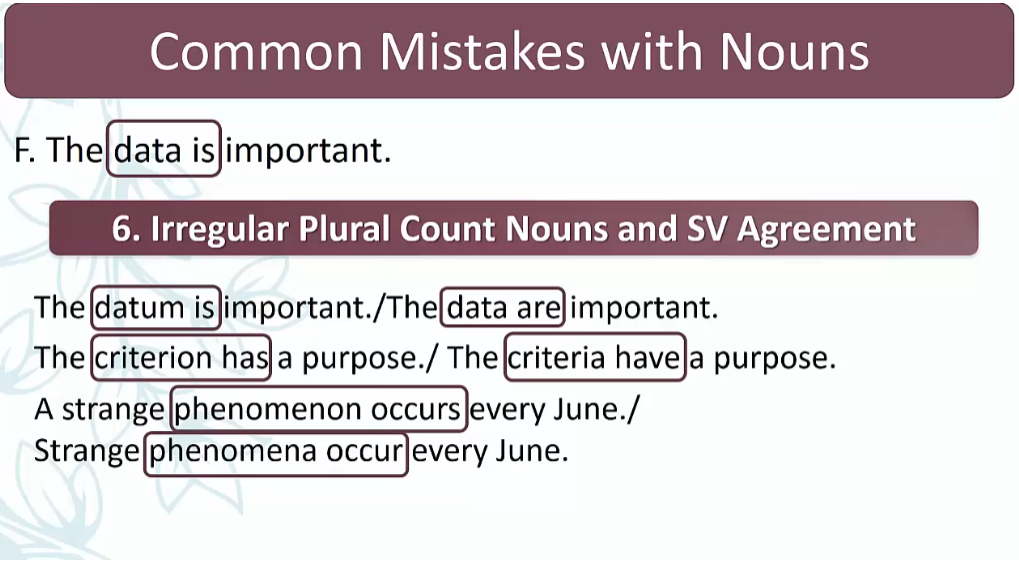
Here are some examples with sheep,
shrimp, and fish. Because the singular and
plural forms are the same, the verb will tell us if we’re
talking about one or many. A sheep is sleeping. The sheep are sleeping. There is a shrimp on the floor. There are shrimp on the floor. I bought a new fish for my fish tank. I bought new fish for my fish tank. Also remember to use A or
AN for singular forms only.
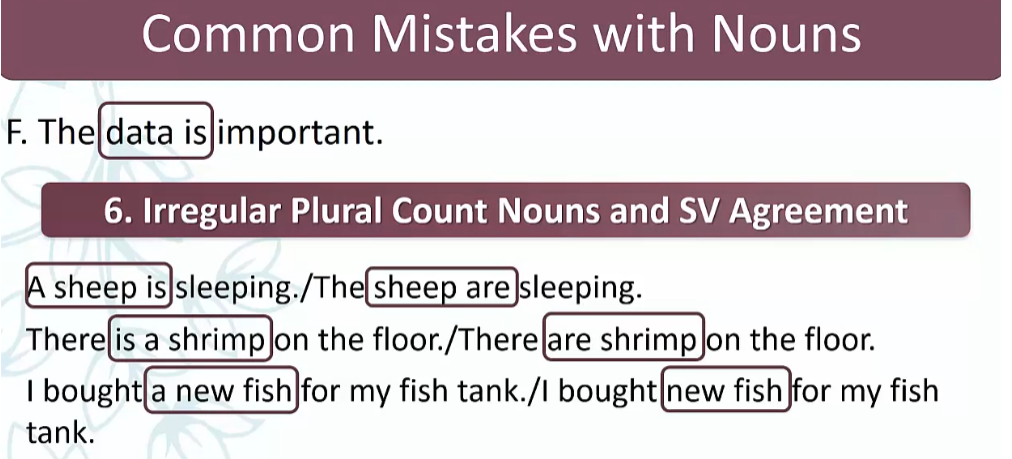
Now here are the corrected sentences
from the start of our lesson. The underlined parts of the sentences
show where we made changes. So remember, try to avoid these
common noun mistakes, and you will be more confident using English.
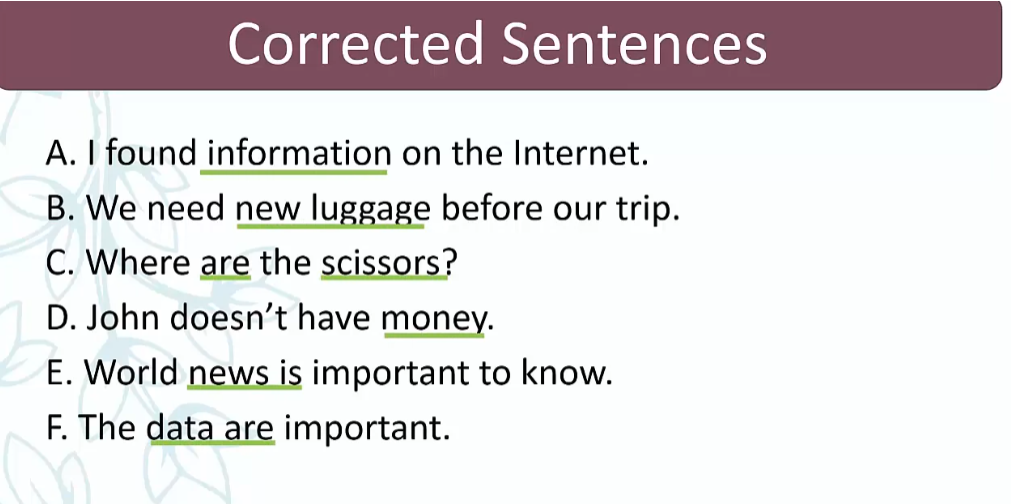
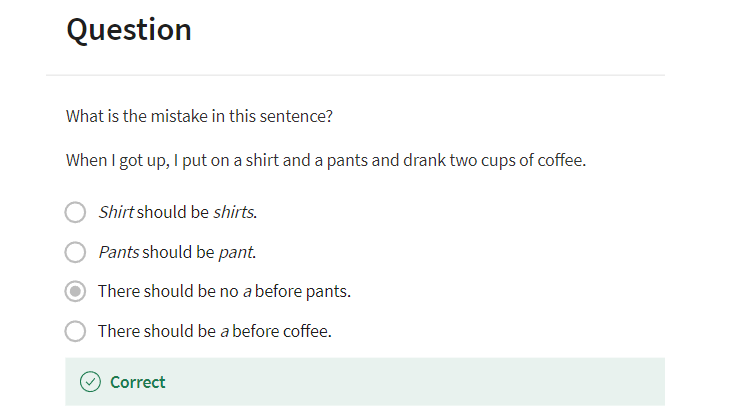
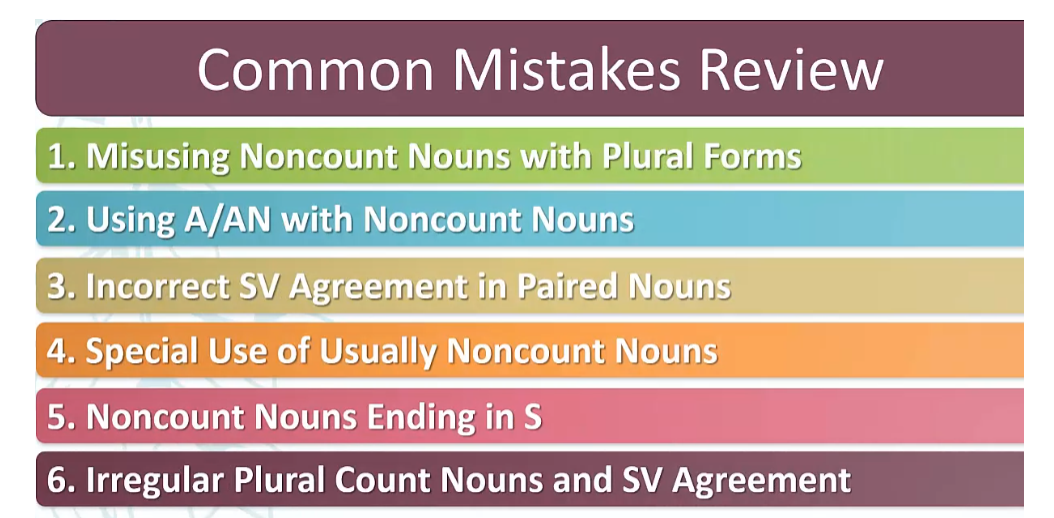
Count and Non-Count Noun Practice Quiz
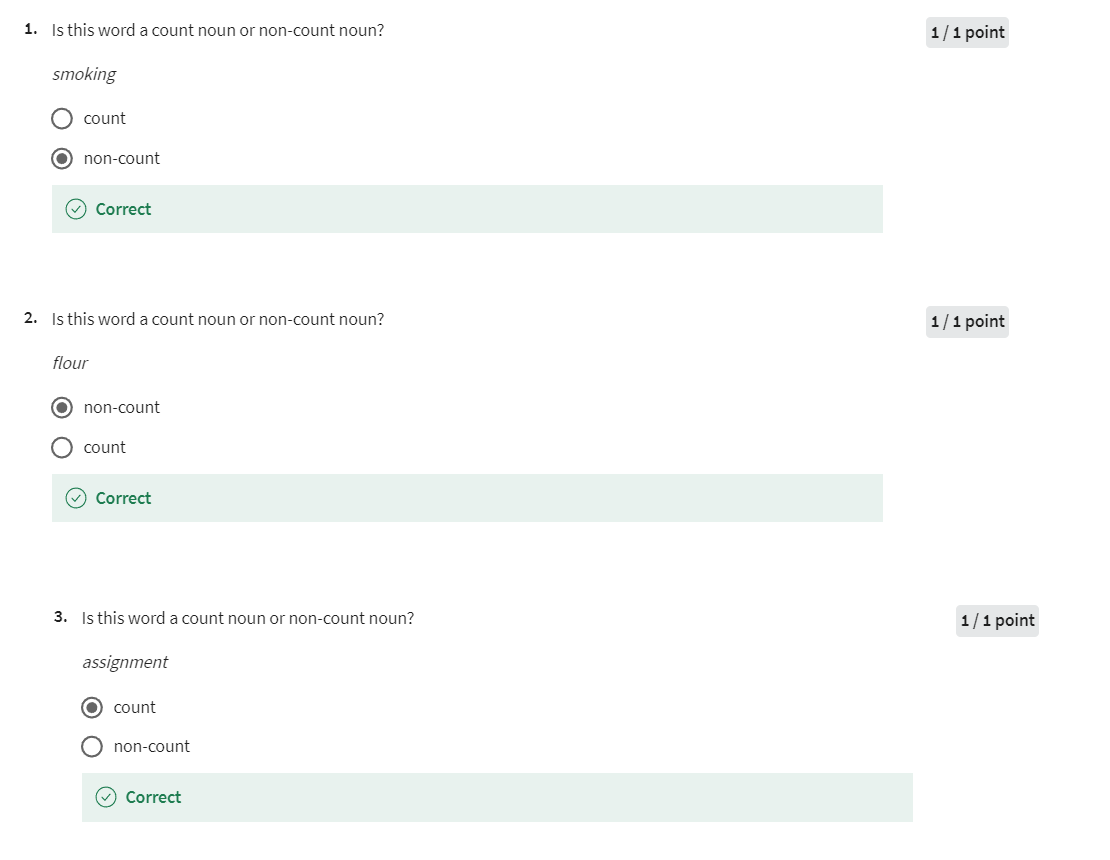

Count and Non-Count Nouns Practice
Practice
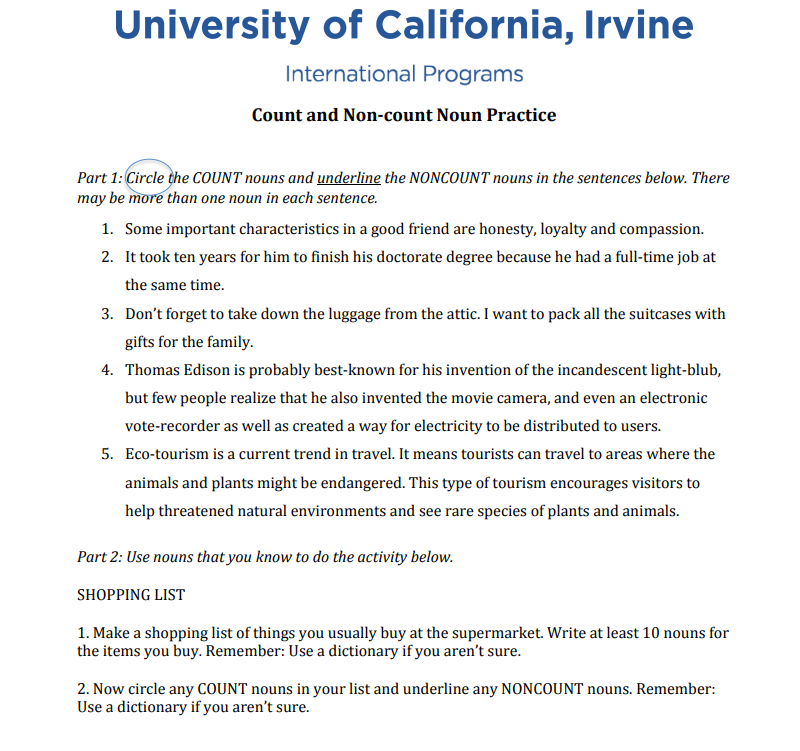
Key
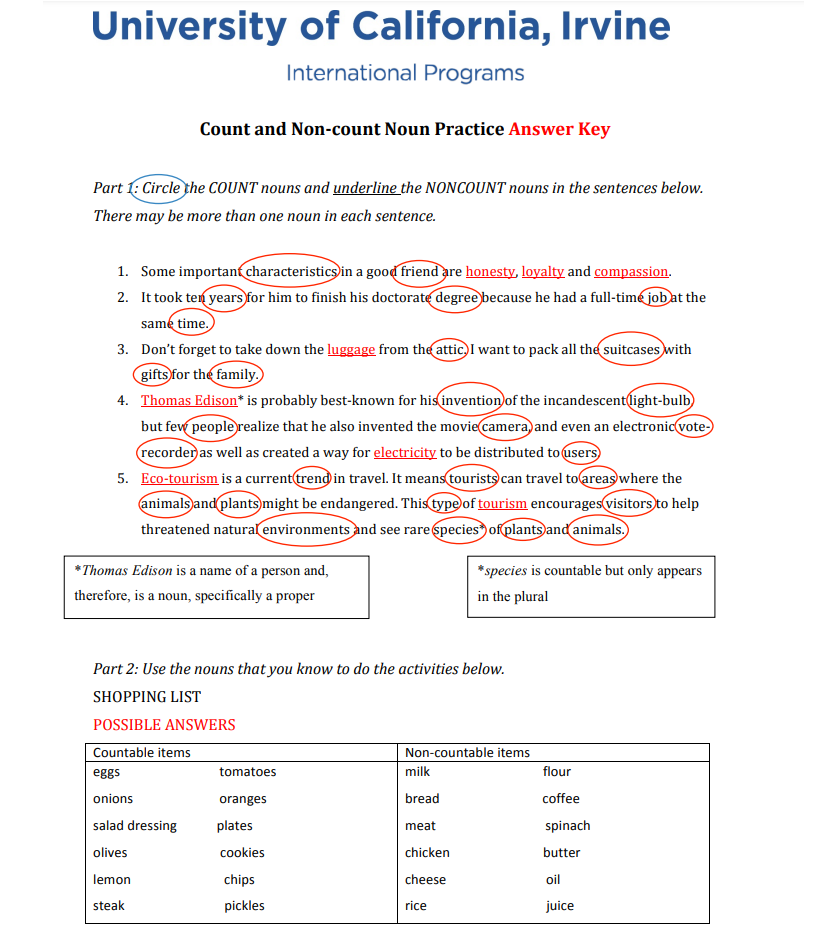
Articles Review Part 1 Lecture
A and an, what’s the difference? A and an are called indefinite articles. I will explain how to use
them in another lesson. But for this lesson, we’ll talk about
the difference between the two. Well, it depends on
the word that comes after. Actually, it’s not just the word,
it’s the first letter of the word. Do you remember consonants and vowels? A vowel is A, E, I, O, U. The dark letters in the right box. Consonants are the other letters,
which are not vowels. Look at the dark letters in the left box. If the words starts with a consonant sound
like b, c, d, then you should use a. For example, bookmark b, /b/ is a consonant sound so
it should be a bookmark. Also, telephone, t, /t/ is a consonant
sound, so it should be a telephone. If the word starts with a vowel sound A,
E, I, O, U, then you should use an. Application has the /a/ vowel sound,
so it should be an application. Also, eraser, e is a vowel sound,
so it’s an eraser. Be careful. Focus on the sound of the first letter,
not the spelling.
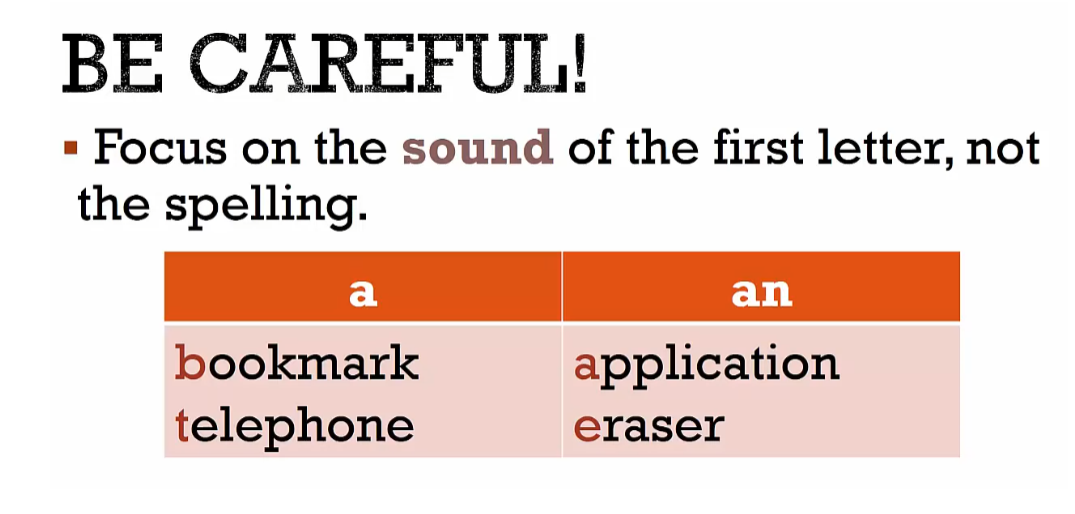
There are some special cases of words
that start with a vowel letter, but have a consonant sound. Here are some examples, eulogy, university, uniform, utensil, utopia. All of these words start with
a vowel when you spell it, so maybe you think that it should be an.
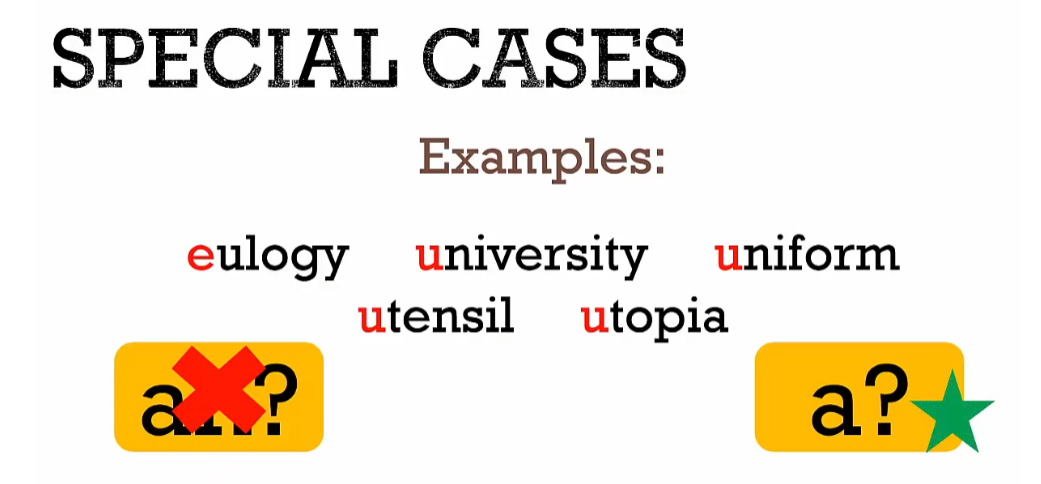
But actually, it’s a. Why?
It’s because when you actually say it, you notice that you are saying you. In this case the first sound is
a /yuh/ sound, which is a consonant. That’s why you use a not an. This happens to a lot of words that start
with the spelling of eu, uni, or ut.

This situation happens to words
that start with consonants too. Mainly, with the silent h. With words like hour or honor. The h is silent, and
you hear a vowel sound at the beginning. You do not hear the ha, h sound. That’s why people say an hour or an honor.
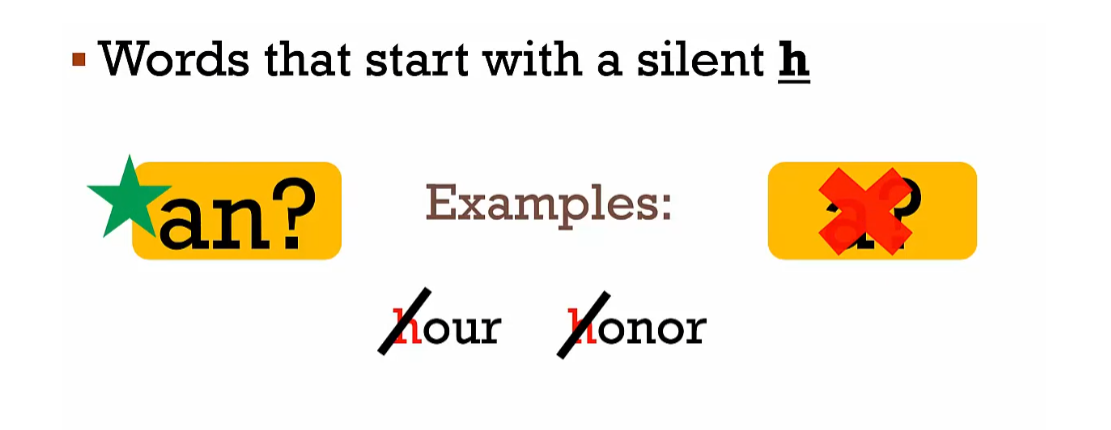
Don’t get confused. Always check the first sound. A word like head has a /hu/ h sound so we use a head or hippo is a hippo. That was pretty easy to understand right? Good job.
Articles Practice Quiz
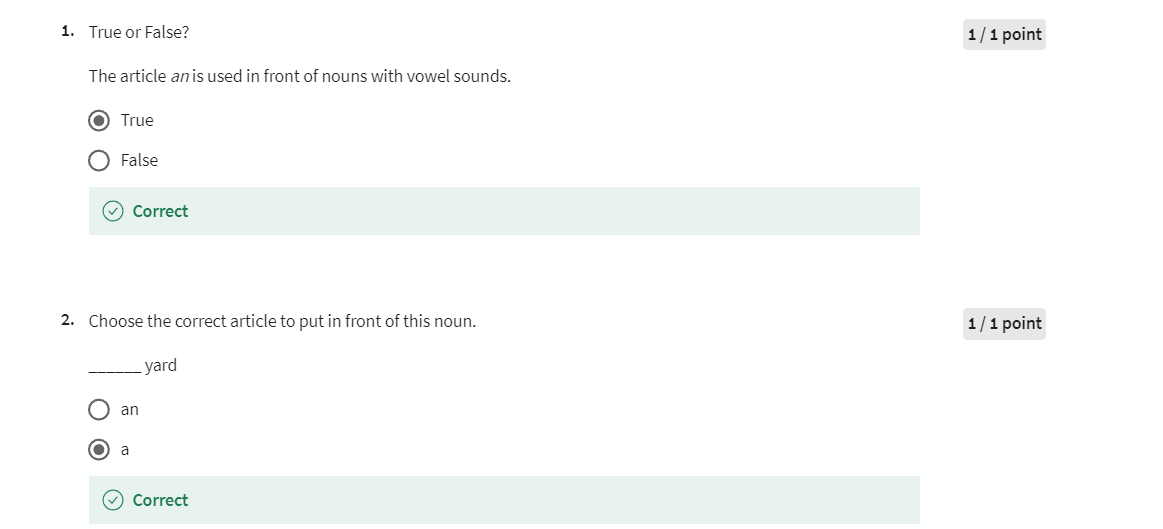
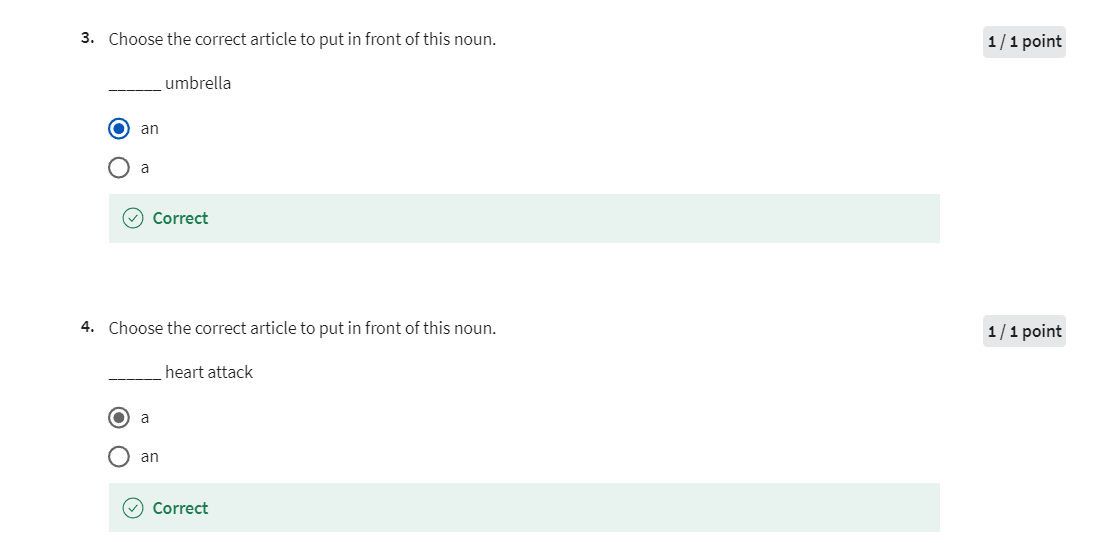
Articles Review Part 2 Lecture
A & An: How to Use Them. Before starting this video, please watch the lessons on A versus An,
and Count and Non-Count Nouns. If you have watched A versus An, you know
that they are called indefinite articles. You also know that you use a with words
that start with consonant sounds, and an with words that
start with vowel sounds.
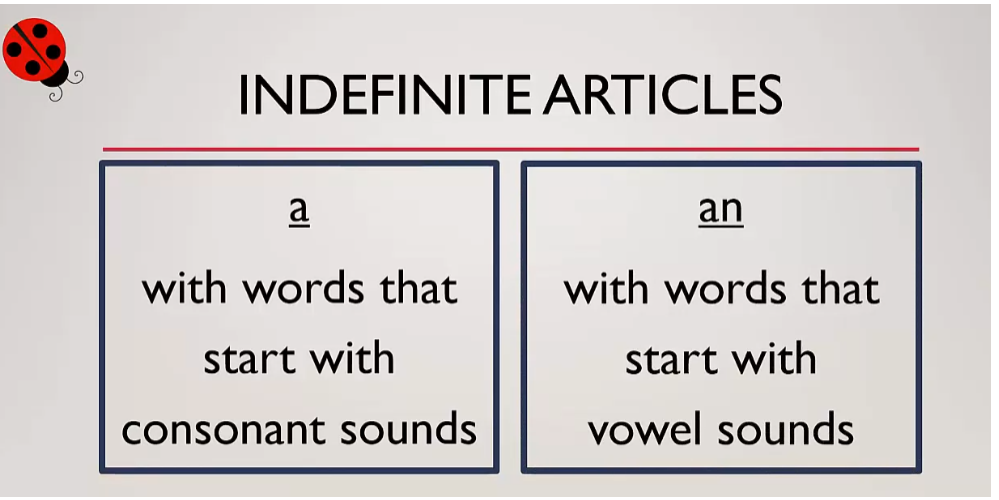
So, how do we use them? First, they go with singular count nouns,
for example, computer and elephant. They are countable and they are singular. Therefore, I can say a computer and
an elephant.

The indefinite article, a and an, and the singular count noun,
act like a two-person team. On a side note,
the two-person team can grow bigger. This means that you can add
more members into the team. An adjective, or an adverb plus adjective. These words go between the a and
an, and a singular count noun. For example,
I add the adjective old to a computer. I also add the adverb and
adjective very small to an elephant. Do you notice something strange? I hope so. Old starts with the vowel sound, o. That means that you need to
change a to an, an old computer. Then very starts with a consonant sound v,
v. Here, you need to change an to a. A very small elephant. Second, they are used when
the speaker wants to give general facts about a thing or a person. Let’s look at the following sentences. A computer is much faster now
compared to 20 years ago. An elephant has very big ears. Here, I am giving facts on all
computers and all elephants.
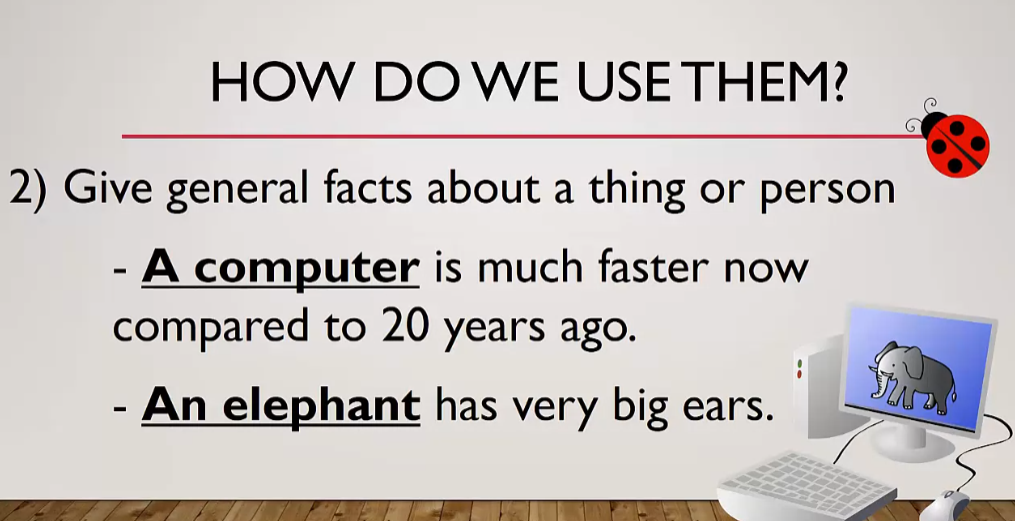
Third, I can use indefinite articles to
talk about things that aren’t specific. For example, you can use
a computer to write your report. Here, it doesn’t matter
which computer you use. You can use this one, or this one, or
this one, any one of them is okay.
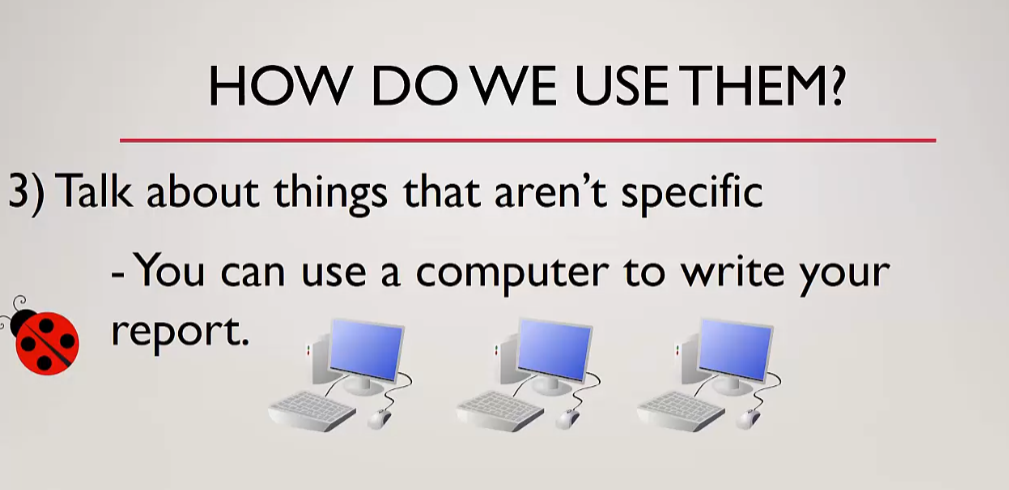
The next example, when I went on a safari,
I saw an elephant. Since the listener did not
go on the safari, she or he doesn’t know the elephant that I saw. In his or her mind, the image of
the elephant is not the same as mine. But that doesn’t matter,
because I am just saying that I saw one. Fourth, I use indefinite articles to
introduce something for the first time. For example, I am talking to my friend
about a bottle that I designed. I say to her, today,
I designed a bottle in class. My friend has not heard me
talk about the bottle before. She is hearing about it for
the first time.
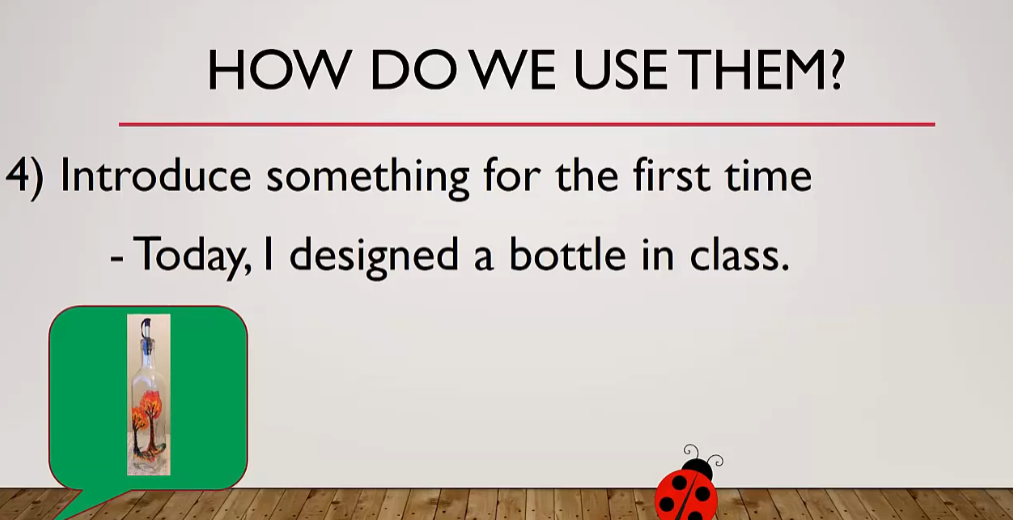
Let’s do a quick review. Indefinite articles are used with singular
count nouns to give general facts, to talk about about non-specific things, and
to introduce something for the first time.
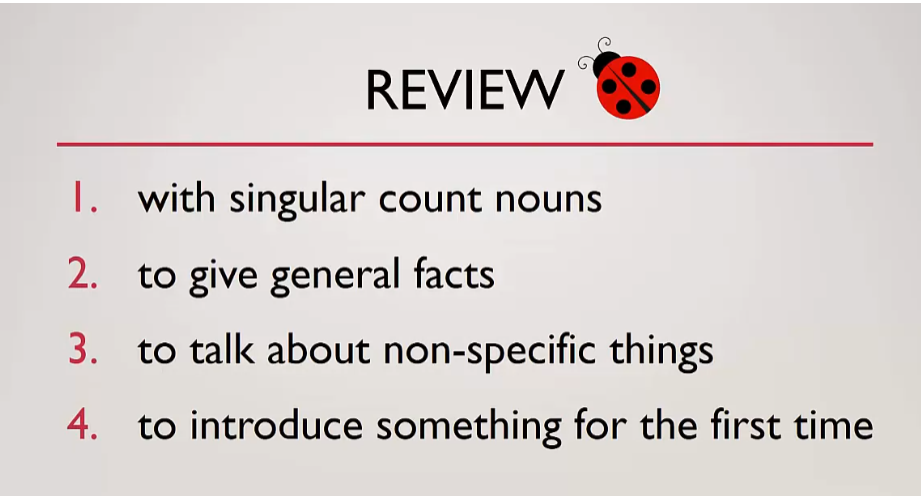
I would like to add a couple of reminders. First, remember to check
the word immediately after a and an to decide which one to use,
like a book versus an old book. Next, remember to keep the original
team of a and an with noun together. Yes, you can put words like adverbs and
adjectives between them, but the indefinite article and
noun are the original members. They must stay together. You cannot say, I have an old,
or I have a very small. You must have a singular noun after. Now, you are ready to move
on to the next lesson and learn about other types of articles.
Articles Review Part 3 Lecture
This is a continuation lesson on articles. So far, you have already learned about
the indefinite articles a and an. Let’s look at those rules again. A and an are used, one,
with singular count nouns, two, to give general facts, three,
to talk about things that aren’t specific, and four to introduce something for
the first time. Let’s highlight Rule Number Two,
Giving General Facts. What is another way to give general facts? From the previous video,
I gave the following two examples. A computer is much faster now
compared to 20 years ago. An elephant has very big ears. It’s possible to take away the indefinite
article which means there is no article. The zero with a line through it is
called zero article or null article. Both are correct names. Then change the noun to plural form. In other words, the example would become, computers are much faster now
compared to 20 years ago. Elephants have very big ears. Again, making the noun plural
is a way to give facts. Going on to Rule Number Three,
we know that we can use a and an with nonspecific singular count nouns. But is it possible to talk about
non-specific plural nouns? Yes.
I may be making a fruit salad with my friend and I ask her hey,
do you have bananas? Do you have apples? As you can see, there are no
articles before bananas or apples. I’m not asking for
specific bananas or apples.
What happens if you want to
talk about something specific? You can use the. The is what is called
the definite article. For example, let’s use the same
sentence from the previous video. You can use a computer
to write your report. But let’s change a to the. To make it easier to understand,
let’s listen to a dialogue between a mother and daughter using
that sentence to give a better context. >> What homework do you have? >> I have to write a report
on the State of California. >> That will take a long time to write. You can use the computer
to write your report. >> Okay. ]BLANK_AUDIO].
In this conversation the use of
the indicates that both the mother and daughter are thinking about
the same computer and most likely there is only
one computer in their home. Perhaps you may wonder if the can
be used with plural nouns. Yes, you can. For example,
How is your report going? >> It’s okay. Can you help me Mom? Can you go to my room and
get the books that are next to my bed? >> All right, all right. >> Thanks.
Here you see that the is used with the plural count noun, books. The daughter wanted specific
books from her room. Not the books on the bookshelf or
the books on the chair. She wants the ones next to her bed.
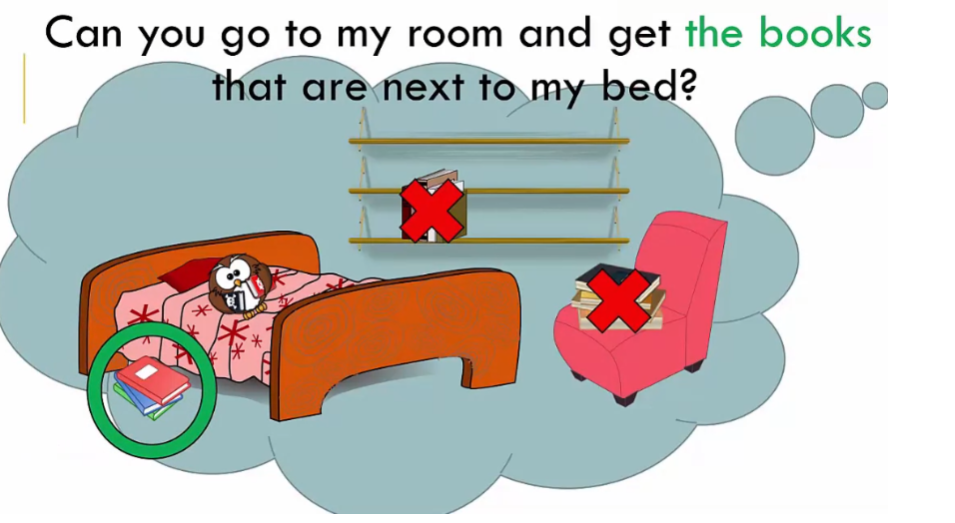
While we are talking about types of nouns,
let’s think about non-count nouns. Can we use articles with non-count nouns? Here are a couple of non-count nouns. Milk and cheese. A and an do not work with non-count nouns. But, how about the definite article the? Let’s continue the conversation
between the mother and daughter. >> Mom, I’m really thirsty. >> Well, what do you want to drink? Do we still have the chocolate
milk from yesterday? >> I think so,
do you want anything to eat? >> Yeah,
how about the cheese that grandma gave us? >> Ok
As you heard, it is possible to use
the with non-count nouns. From what I said before,
the chocolate milk and the cheese are specific ones that both
the mother and daughter know about.
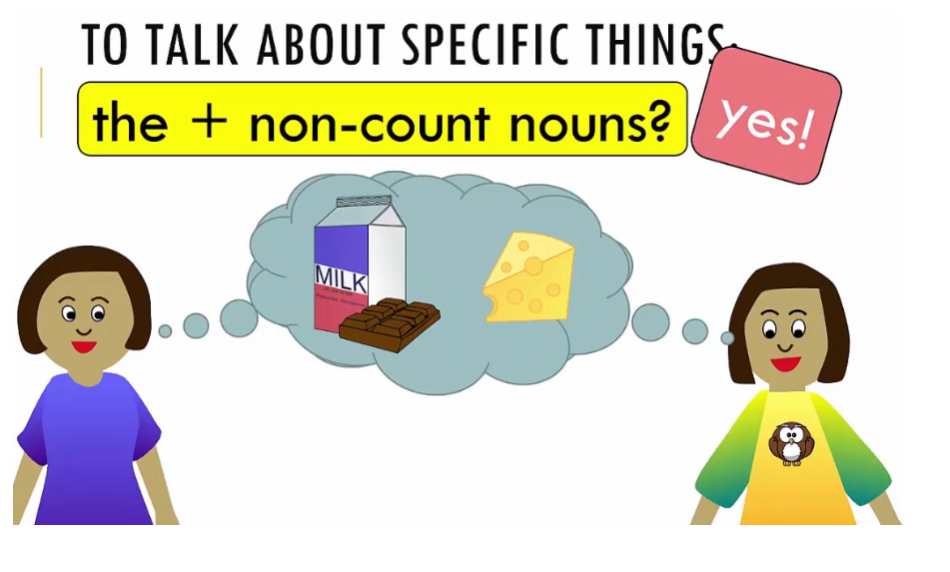
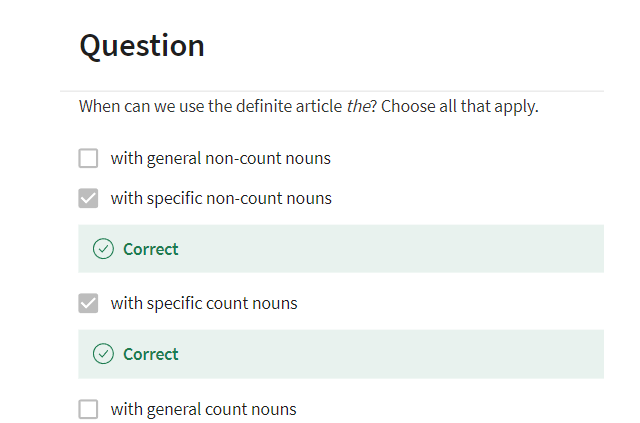
Okay, one more point related to this. What if I just want to talk about milk and
cheese in general? With count nouns we can either use a and an or make the noun plural
as I mentioned earlier. However with non-count nouns
you cannot use a or an. Also you cannot make milk or
cheese plural. Instead, you just keep
it in the same form. In other words, there is no article. Here are two sentences that give
general information about both things. Milk contains a lot of calcium and
is good for your bones. Cheese is often found in western salads. There is a zero before both nouns,
to remind you that there are no articles.
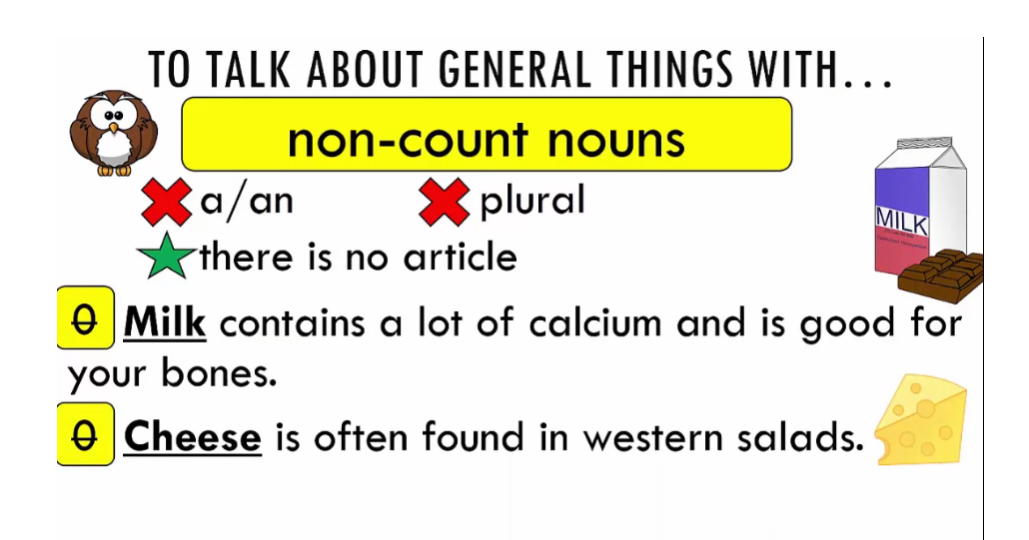
Okay, we are ready to
move onto the last rule. We often use a and an, when we
introduce something for the first time. Something that the listener
is not familiar with. After we have introduced it,
what should we do? Can you guess? I will give you a hint. After we have mentioned it,
that means the thing becomes specific. Yes, you use the. In the last video you might remember
the conversation about the speaker seeing an elephant on a safari. I had said that the listener doesn’t have
the same image of the elephant that I, the speaker, have. But it doesn’t matter since
the elephant is not specific. However, after I have talked
about the elephant for the first time,
I don’t need to use a anymore. I can use the. Let’s take a look at my safari trip again
but this time with more information.
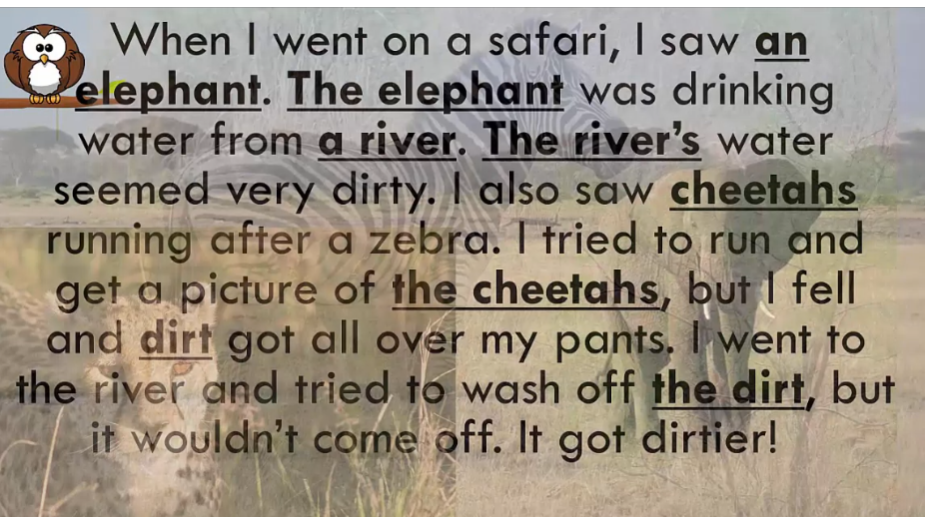
When I went on a safari I saw an elephant. The elephant was drinking
water from a river. The river’s water seemed very dirty. I also say cheetahs running after a zebra. I tried to run and
get a picture of the cheetahs, but I fell and dirt got all over my pants. I went to the river and tried to wash
off the dirt, but it wouldn’t come off. It got dirtier. Since you already heard about the elephant
in the first sentence, I used the in the second sentence because it is
now referring to a specific elephant. The elephant that I just told you about. I also introduced river in the second
sentence so, I used a river. But when I continue to talk about
the river after, I use the. In the example, elephant and
river are singular count nouns. I also used a plural count noun,
cheetahs, and a non-count noun, dirt. For both there are no articles. However, with second mention,
I still add the. Whew, that was a lot of information,
but you did it. Please review the articles
chart handout carefully. Remembering when to use a and an the and
no article takes a lot of practice. But don’t give up.
Mistakes with Articles Part 1 Lecture
Tricky Articles,
Confusing Special Cases Part 1. In the previous video, a continuation of
articles, I provided a set of guidelines to help you understand some basic rules
about the indefinite article a and an. Definite article the and 0 article. However, there are a lot of
special cases that are confusing, especially concerning when to use The and
when to use 0 article. As a result, many English
language learners will use “the” when it is not necessary or
forgot to add “the” when it is necessary.
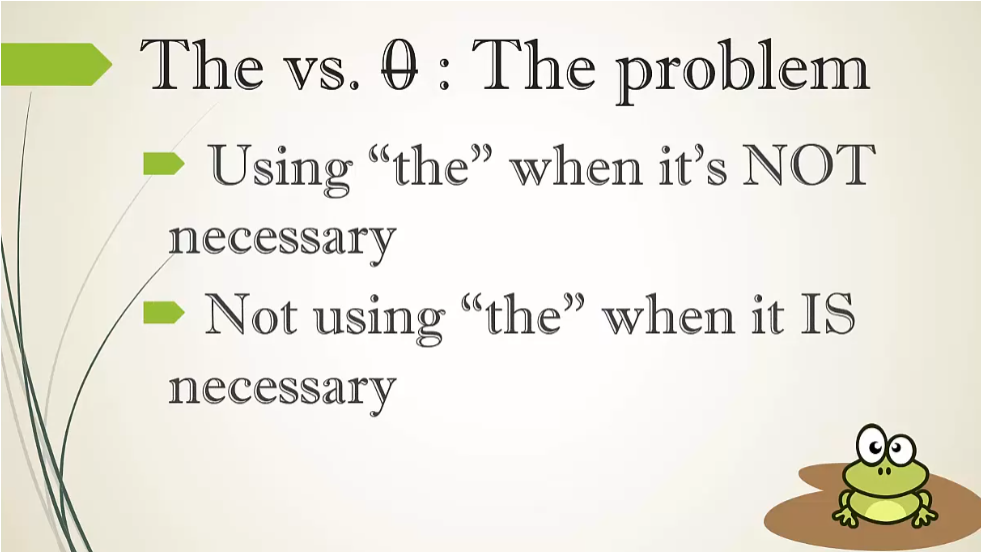
I separated the tricky
cases into four groups. For part one, I will focus on Unique
things and Country-Related things. Keep in mind that there
are more special cases that this lesson will only
focus on these four areas.
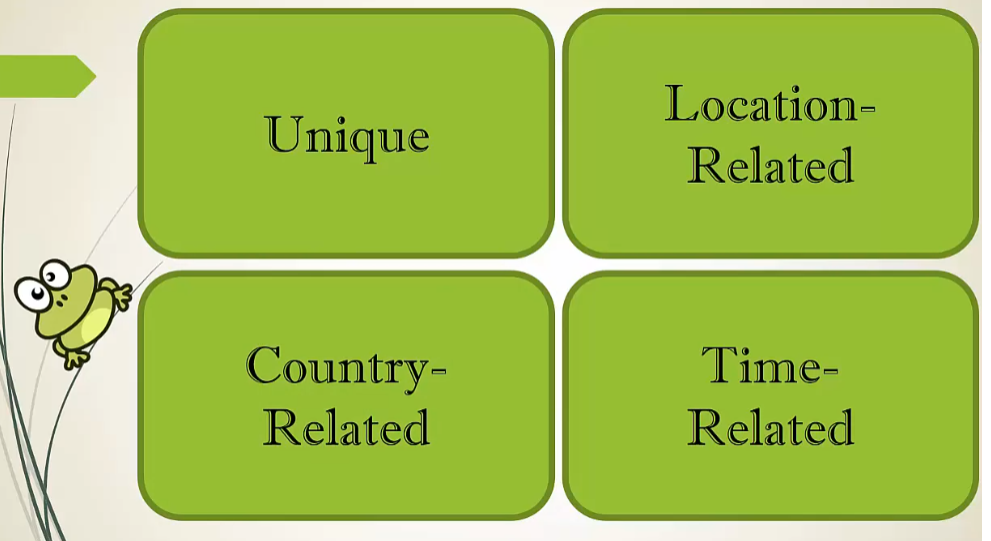
Let’s start with group one. There are some nouns that are considered
unique, meaning that if the speaker says this noun, the listener already
knows what the speaker is referring to. Because it is common knowledge. Look at the following sentences. The sun is shining brightly. I can’t see the moon tonight. Scientists have been searching for
other life forms in the universe. In a forest, the air is much cleaner.
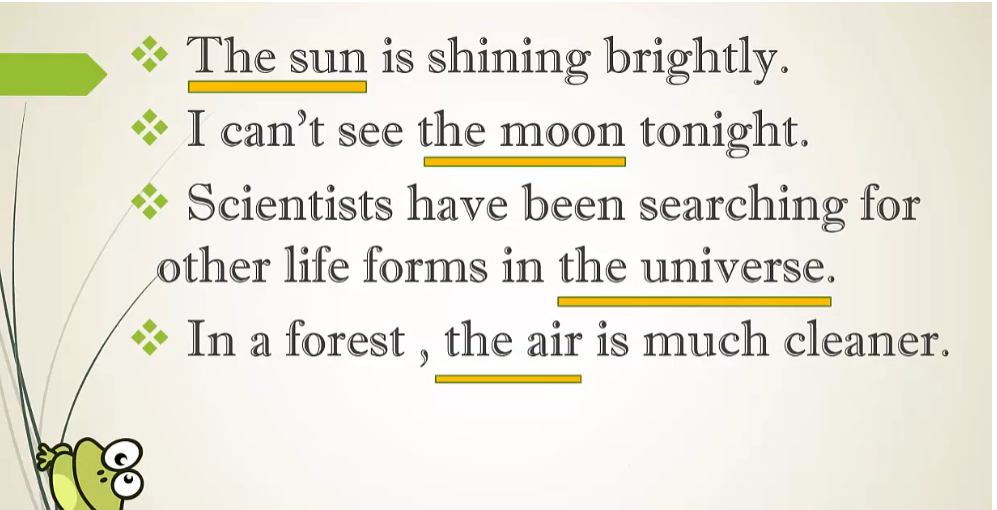
Look at the sky! It’s so blue! Please don’t sit on the ground. It’s dirty. It’s hot. Let’s stand in the shade. Let’s make the world a better place.
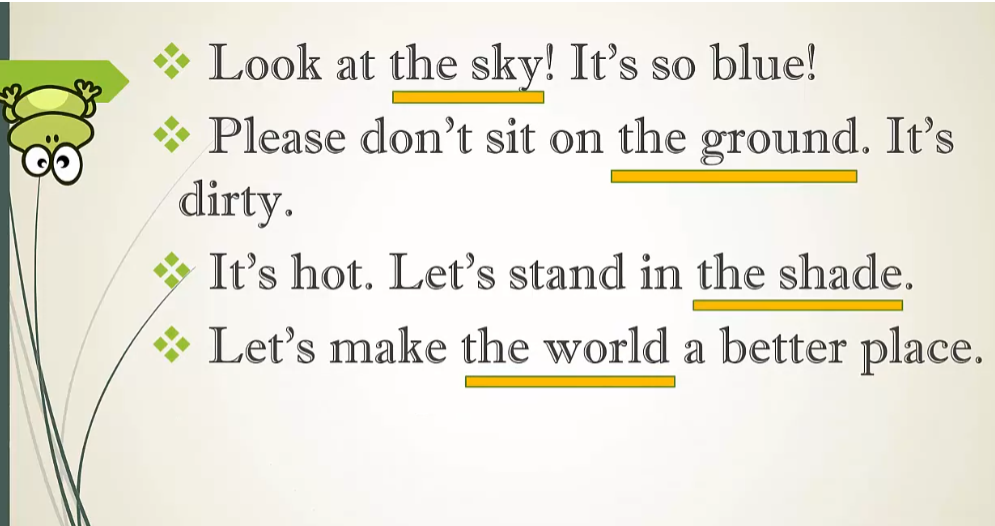
If I said these sentences to you, you would understand what
I was referring to, right? For most people in the world,
they know that there is one sun, one moon, one universe,
one sky and so, on. Yes, it’s possible that there
are more universe’s, world’s, sun’s, or moon’s out there but for
most of us when we talk, we are generally referring to
things in our own universe. There are two unique nouns that
I want to explain a little more. The first one is shade. If my friend and I were standing
outside under the sun and I said, "Let’s stand in the shade. It’s possible that there
are many area of shade near us. Here, here or here. However, in this case, it doesn’t
matter which shaded area we choose. Anywhere is fine, as long as it has shade. We don’t use a sentence like There is
a shade, even though it is not specific. The other noun I want
to talk about is world. World is a tricky one in many cases,
the article is the. Native english speakers often
use in the world in sentences. For example, Russia is
the biggest country in the world. You might also hear a sentence
that starts with the world is. For example,
The world is changing rapidly. These sentences show us talking about
things in the place we are living in.
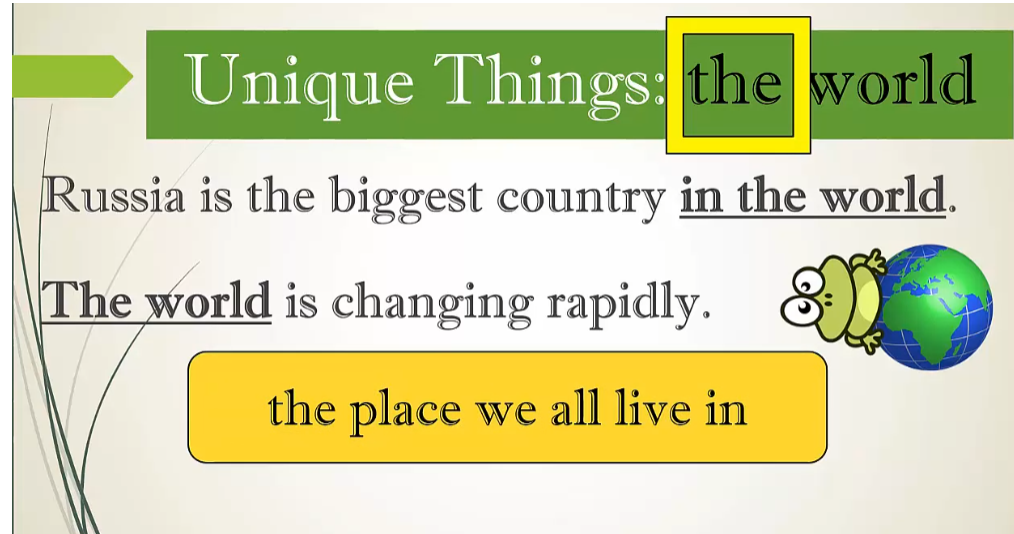
However, it is possible
to hear a world too. In a perfect world, we wouldn’t
have to worry about war or disease. Or, We want to create a better world for
the next generation. For these two sentences,
there is a feeling of more than one world. We are not talking about
the world we live in now. We are talking about a place or
environment that we dream about. In that case, it is appropriate to use a.

In the second group,
we have Country-Related Things. I will review the names of countries,
currency, and language. For most countries, there is no article
before the name of the country. There are, however, some countries that
require The before it, The United States, The United Kingdom, The Philippines, The Netherlands, The United Arab Emirates
and the Czech Republic.
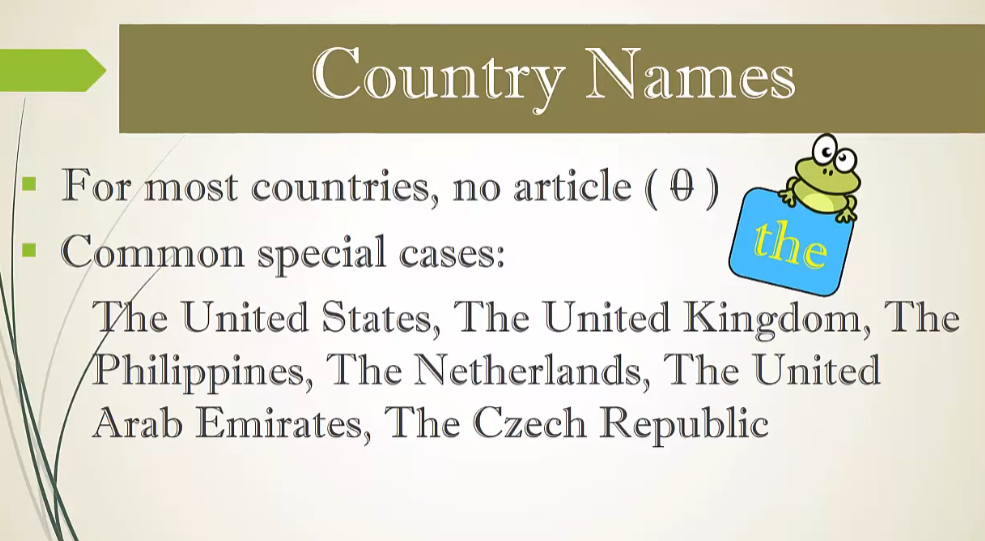
Next, when you are referring
to a country’s currency or money, also use the before
the name of the currency. For example, the dollar,
the yen, the euro, the pound, the won, the yuan, the real,
the riyal, the peso.
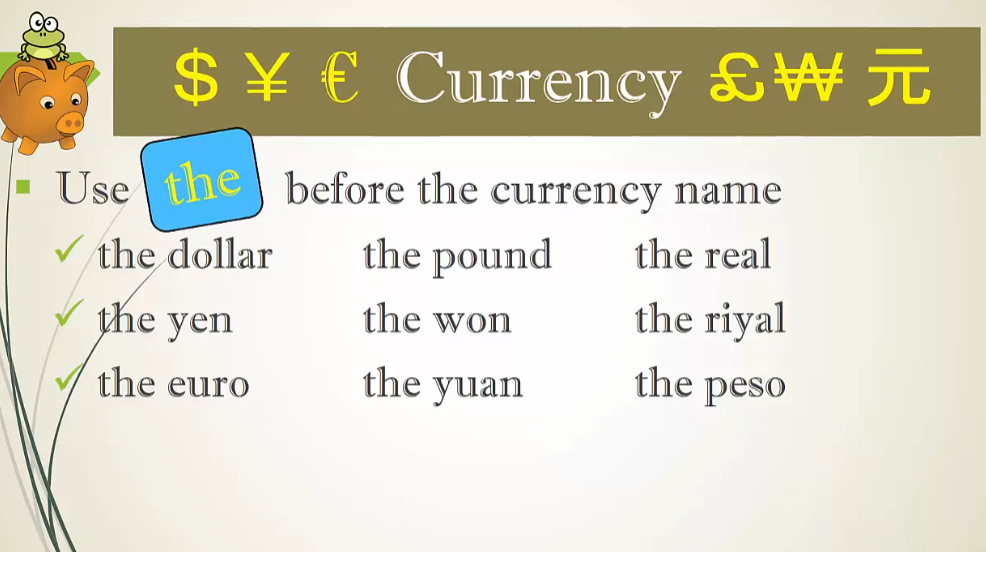
Now let’s look at Language. When you are referring to
the name of a language, you do not need to use an article. In other words, there is a zero article. This boy speaks Portuguese. This girl speaks German. This woman speaks Korean. Notice the 0 article.
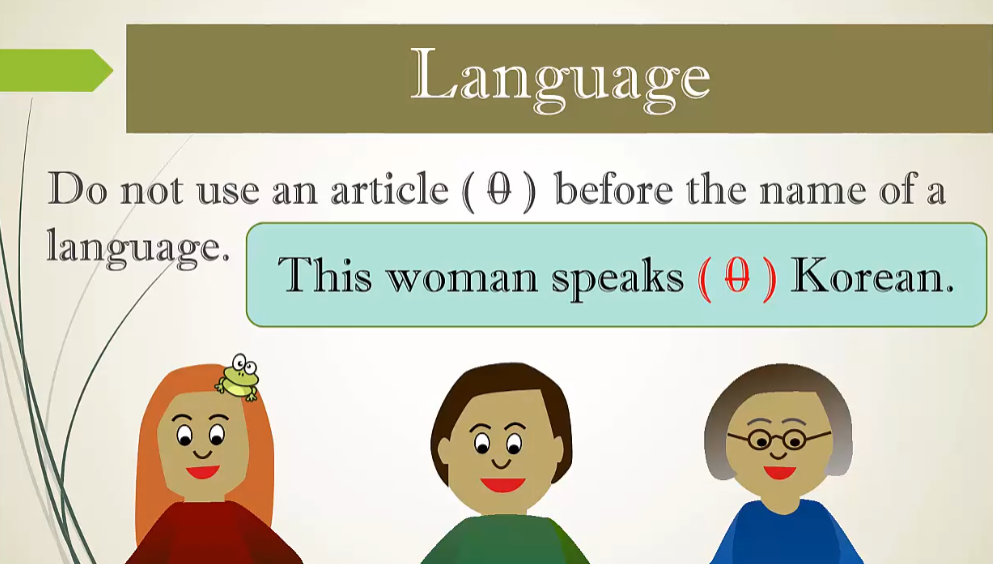
Portuguese, German, and
Korean are nouns here. However, the rules change if
you add the word language after the name of the language. Like the pattern in the box. If you use this pattern,
you must add “the” before. The Portuguese language, the Korean
language, and the German language. Notice here, Portuguese, Korean,
and German act as adjectives. Please continue to Part 2.
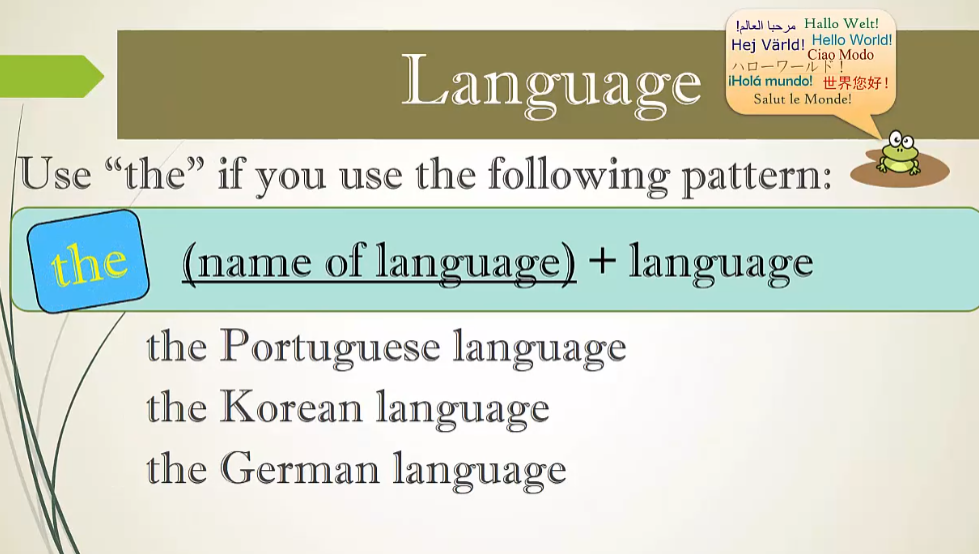
Mistakes with Articles Part 2 Lecture
Tricky articles,
confusing special cases part two. In part one I focused on unique things and
country-related things. In part two I will talk about
location-related things and time-related things. In location-related nouns,
some of them use the, while some don’t. Let’s compare which ones start with
the and which ones have no articles. Number one, names of oceans,
seas, and rivers come after the. The Pacific Ocean, the Caspian Sea,
and the Amazon River. On the other hand, lakes and waterfalls
generally do not have the before it. Lake Lugano and Niagara Falls.
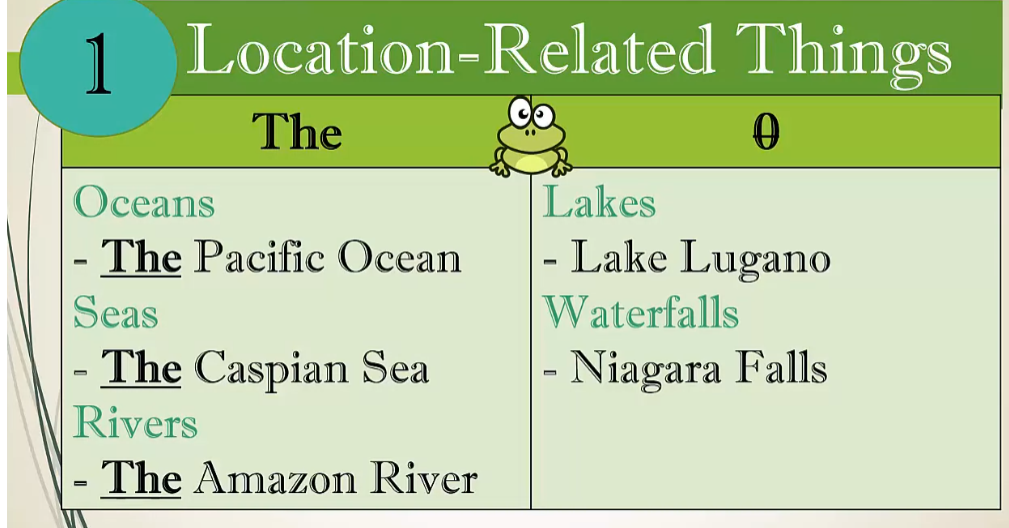
Number two, mountain ranges use the. The Alps or the Canadian Rockies. Notice that I said mountain ranges and
not a mountain. If it is just one mountain,
like Mount Everest or Mount Kilimanjaro,
there is no article before.
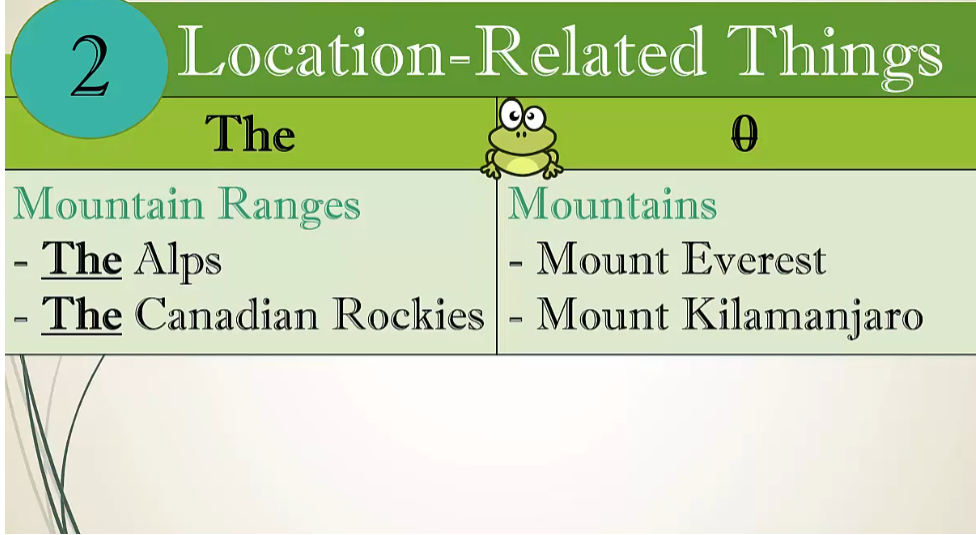
Number three, deserts. Deserts use the. The Sahara Desert, the Gobi Desert.
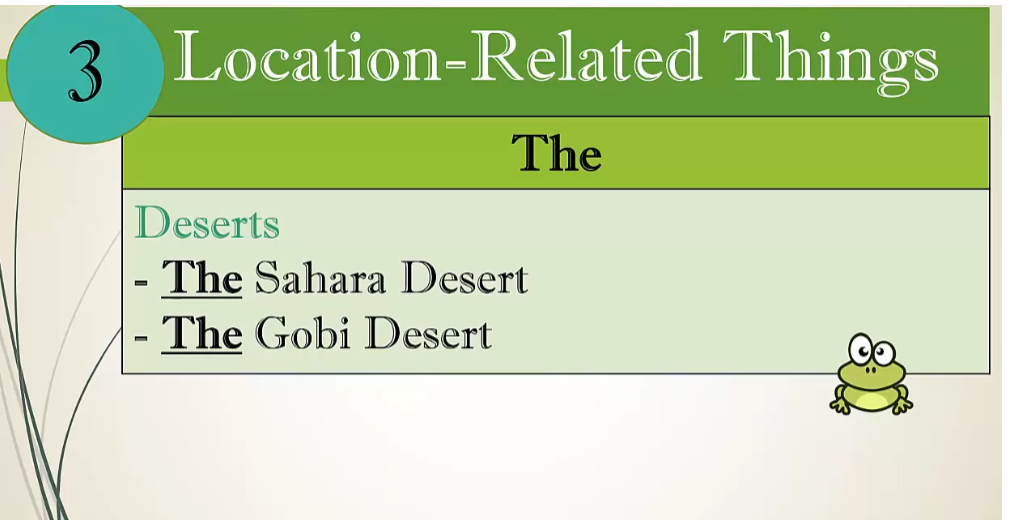
Number four,
specific regions often use the. The Middle East, the Balkans. Actually, within the United States, there
are specific areas where you use the. The Northwest, the West Coast, the South.
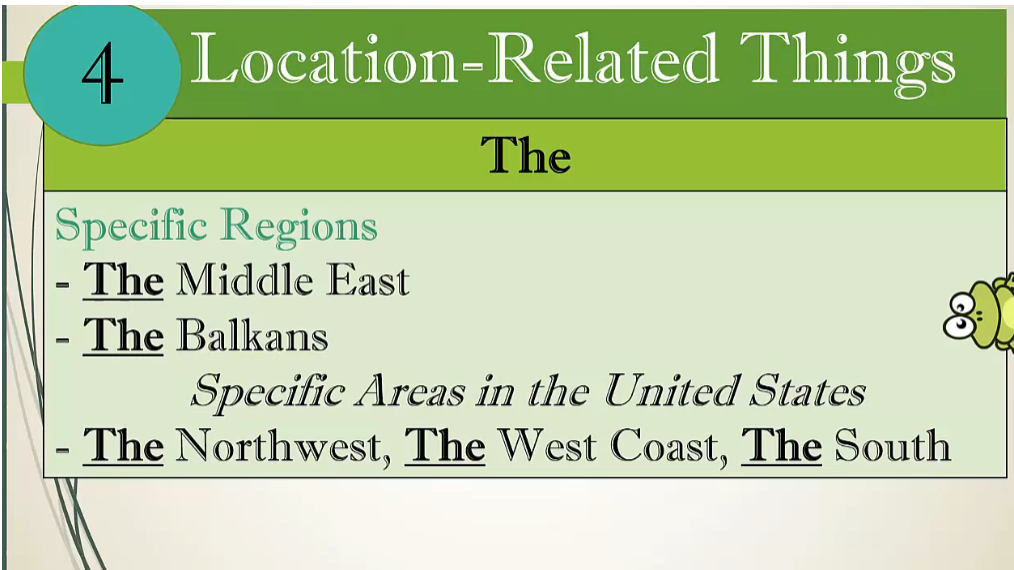
Now here’s a little challenge. What’s the difference between
saying I am going to the South versus I am going south? In the first sentence it has the, which emphasizes a specific
area in southern United States. However, in the second sentence, I am just saying that I am going
in the direction of south. It is not a specific area. In the second sentence there
is no article before south.
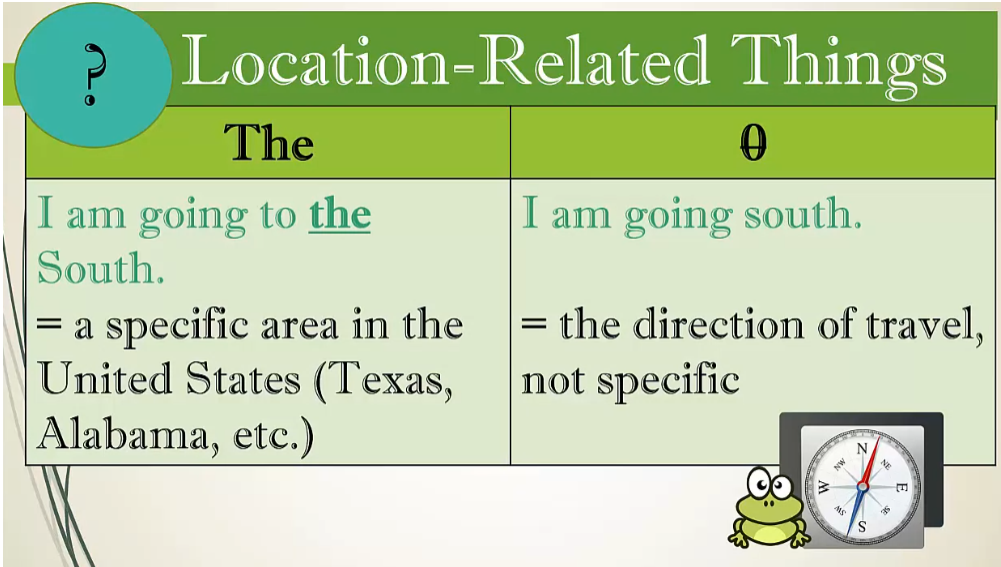
In the last group we’ll talk
about time-related events. I want to highlight how to use or
not use articles related to holidays, time periods, and dates.
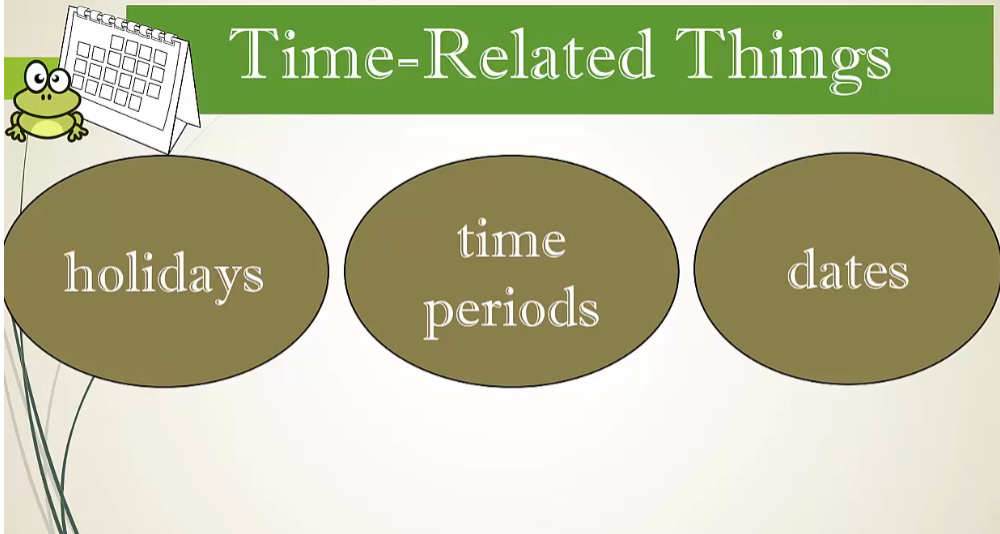
To do this, let me share with you
about one of my favorite holidays. I love Chinese New Year. When I was growing up in the 1980s, I often went to Chinatown
to see the lion dances. Every year the start date changes
because of the lunar calendar. One year it was on February 14th. This past year,
it was on the 8th of February. I hope it is never on Friday the 13th. That’s an unlucky day.
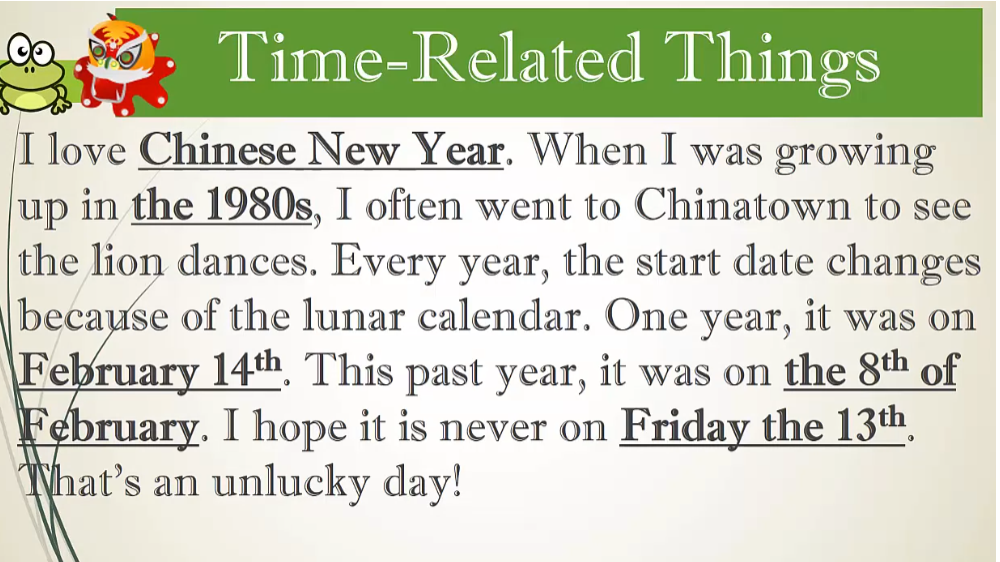
First, let’s look at holidays. Do not use an article before
the name of a holiday. In other words, I shouldn’t say,
I love the Chinese New Year. It’s wrong.
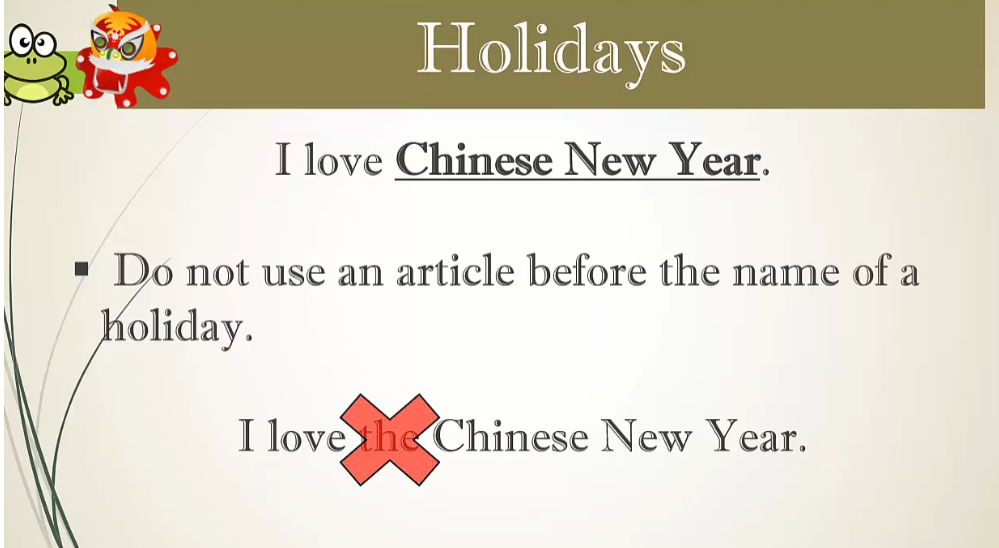
Next is time periods. When you’re talking about
a period of time like a decade or a specific time of importance, add the. The 1960s, the 1980s, the 90s, or the Renaissance Period,
the Middle Ages, the Information Age.
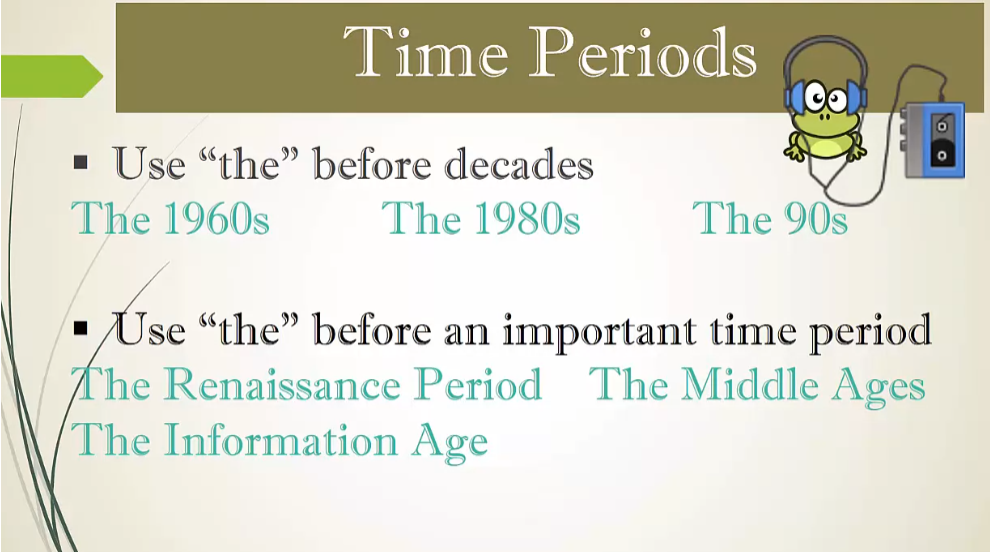
Lastly, let’s talk about dates. There are three sentences
related to dates. One year, it was on February 14th. This past year,
it was on the 8th of February. I hope it is never on Friday the 13th. We have months, we have day of the week. Finally, we have ordinal numbers. As you noticed, two sentences include
the before the ordinal number, one sentence doesn’t.

Unfortunately there is not really
an easy way to learn the pattern. So take the time to study
the patterns in the chart. In the first sentence,
if you have month plus ordinal number, like February 14th,
there is no the article.
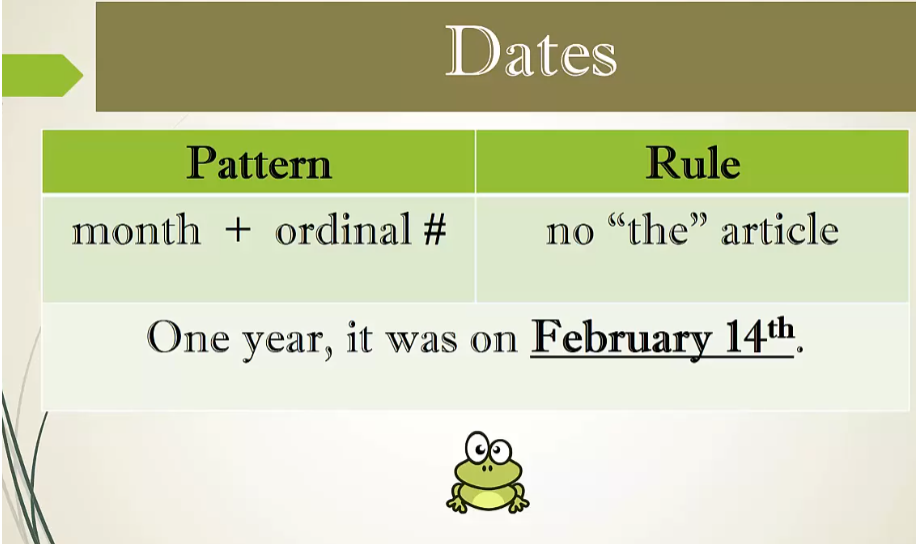
If you have ordinal number
plus of plus month, like 8th of February,
use the before ordinal number. The 8th of February.

If you have day of the week
plus ordinal number, Friday and 13th, use the between the day
of the week and ordinal number. Friday the 13th.
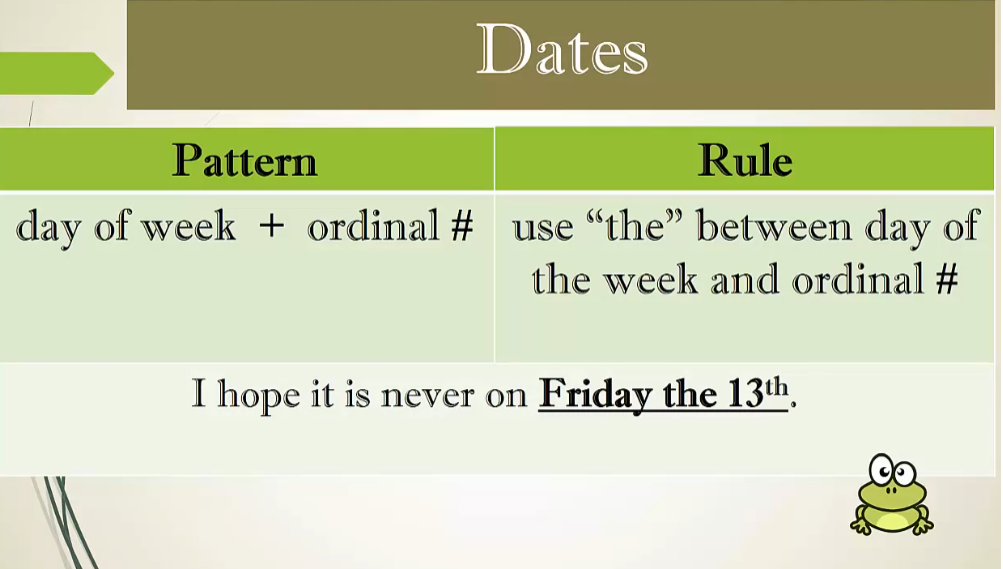
Now that we are finished, you are probably
thinking, there are so many rules. This is true, and that’s why you
need to review and practice often so that you can memorize them more naturally. Good luck.

Articles Practice
Practice
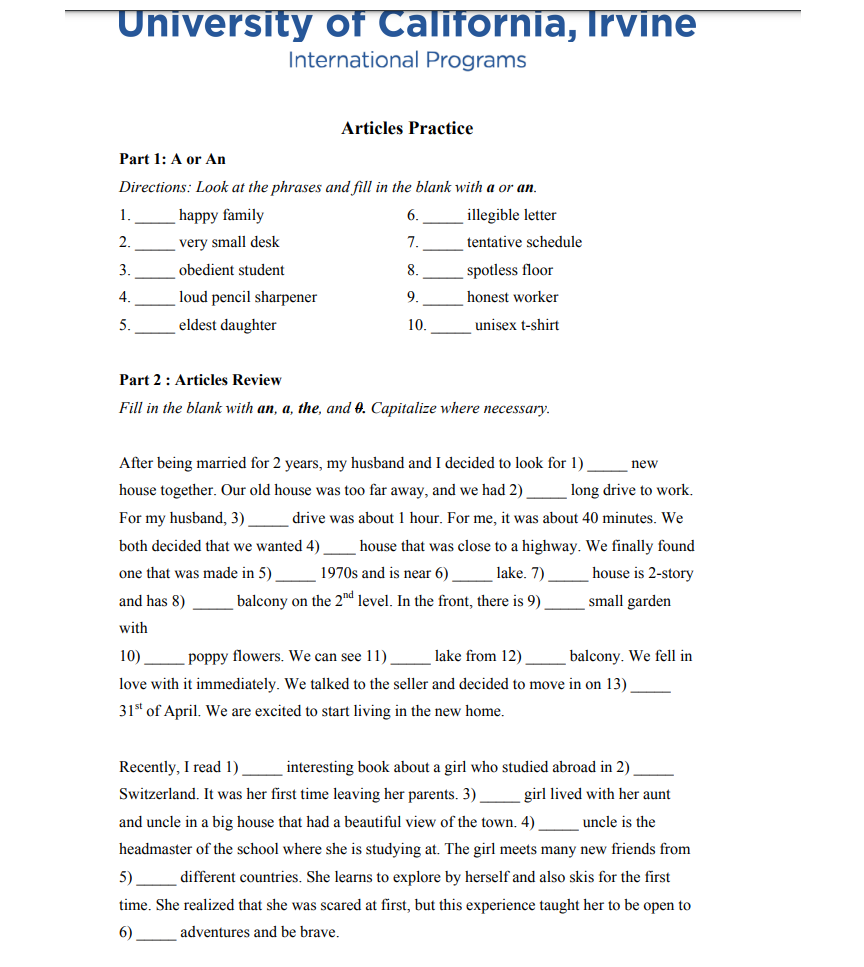
Practice 2
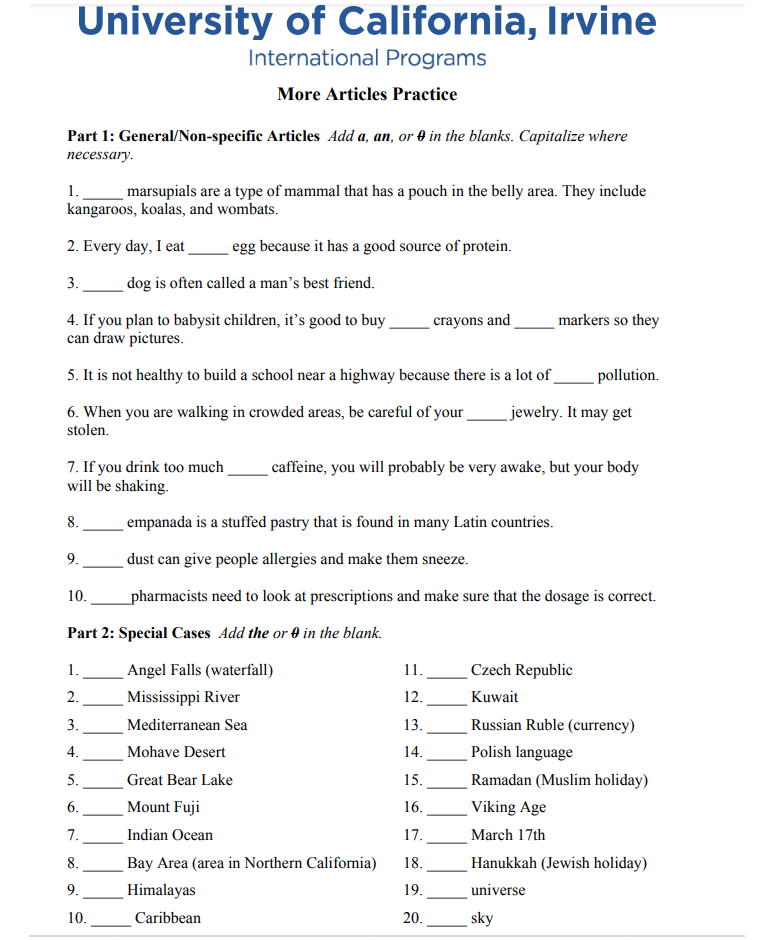
Practice key 1
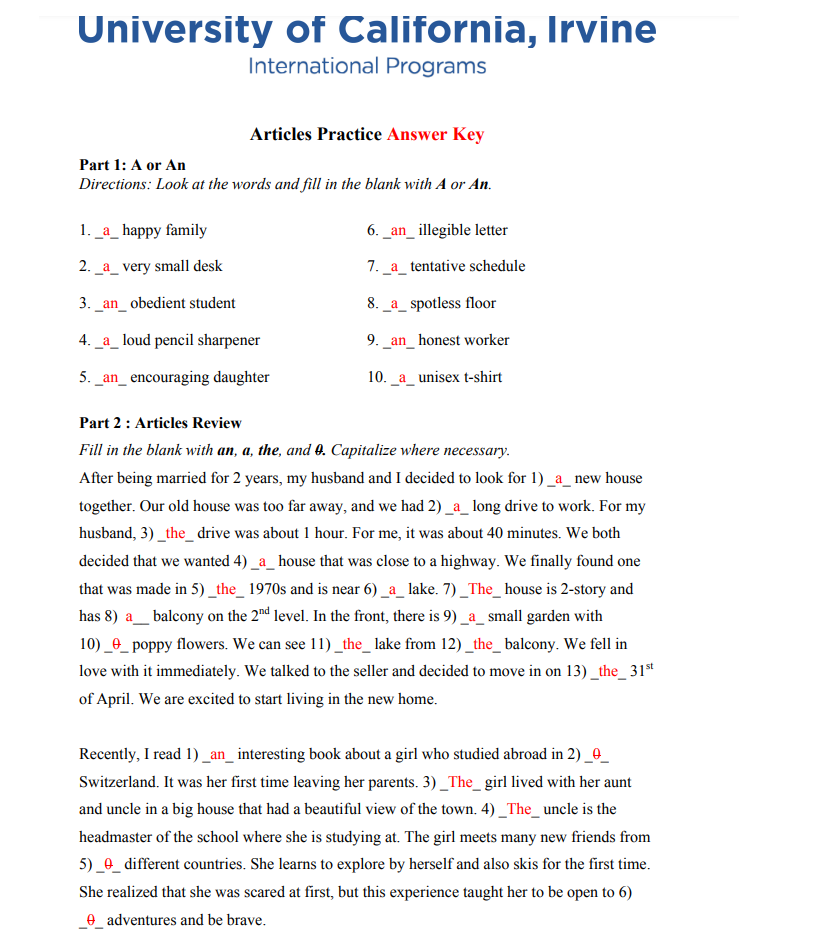
Practice key 2

Quantifiers Part 1 Lecture
Quantifiers, part one. Let’s begin our discussion of quantifiers
by defining what quantifiers are. Quantifiers are a type of noun
marker that expresses quantity, meaning they answer the questions
how much or how many. Numbers express exact quantities, right? However, quantifiers
express inexact quantities. Inexact meaning not exact.
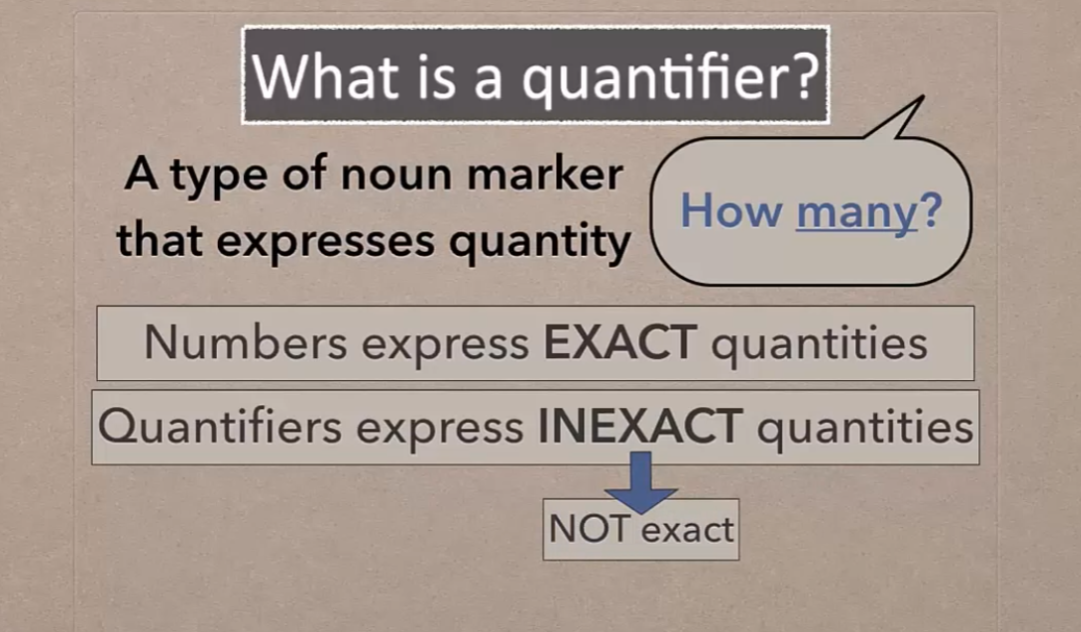
Let’s take a look at an example. When I visited my aunt’s farm,
I saw one cow, two goats, several horses,
and many chickens. The words one and
two gives us exact quantities. However, the words several and
many give us some idea of the quantities,
but they’re inexact. These are examples of
what we call quantifiers.
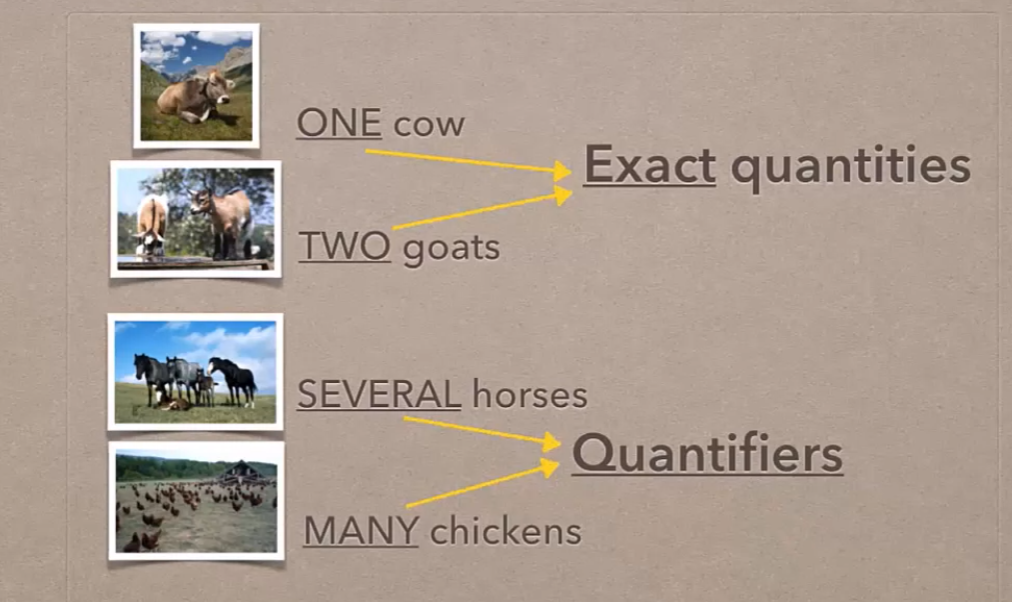
Now you may be wondering,
where do quantifiers go in a sentence? Quantifiers go before nouns,
before the nouns that they mark. Here’s an example sentence. My aunt also had some pigs. Some is the quantifier, pigs is the noun. Here’s another example. In the house,
she also kept a couple of dogs. Let’s keep going. She has a great deal of land for
all of the animals.
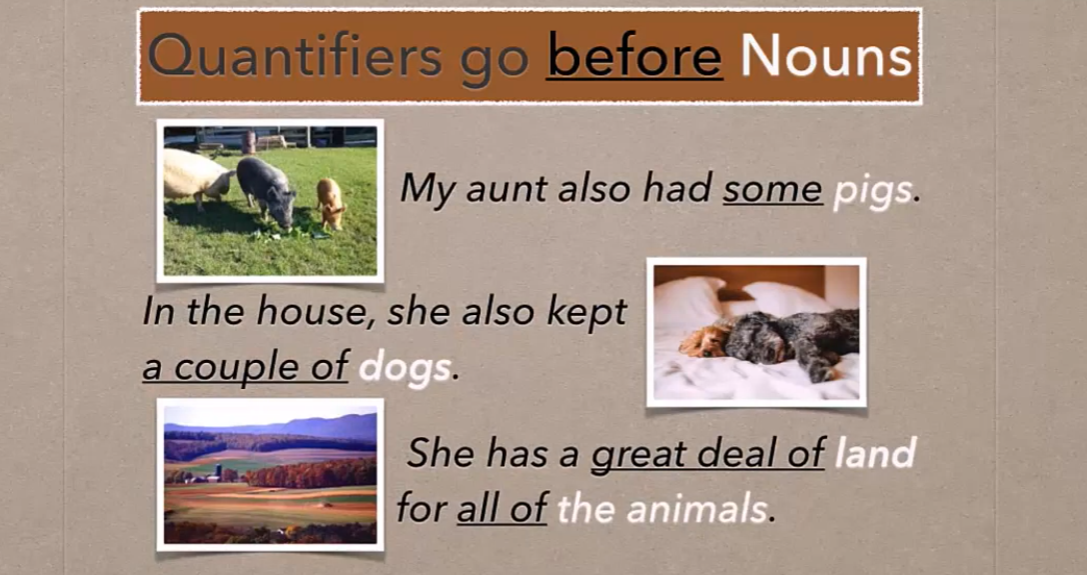
Usually, my aunt doesn’t
have much time to relax. Maintaining a farm definitely
requires a lot of work.
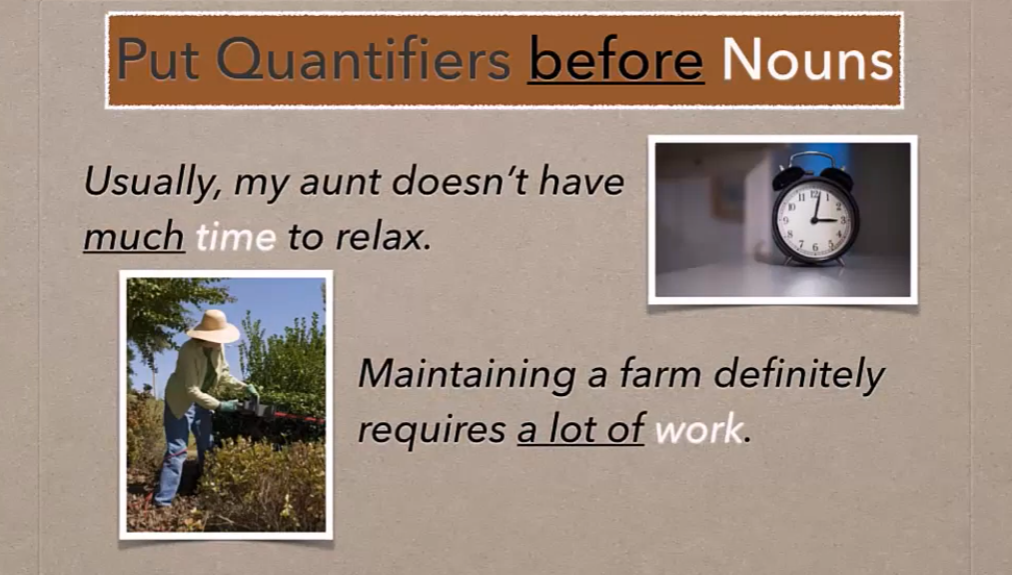
Okay, now we’ve seen different examples. I want you to know though that there
are different types of quantifiers, and we can categorize them as those that
are used with only count nouns, the examples were several,
many, and a couple of, and those that can be used
with only non-count nouns. The examples we saw were
a great deal of and much. And the last type of quantifier
can be used with both, count nouns and non-count nouns. And the examples we saw were some,
all of, and a lot of. In the next video we’re going to
talk more about this last type, so make sure to watch part two. I’ll see you soon in the next video.
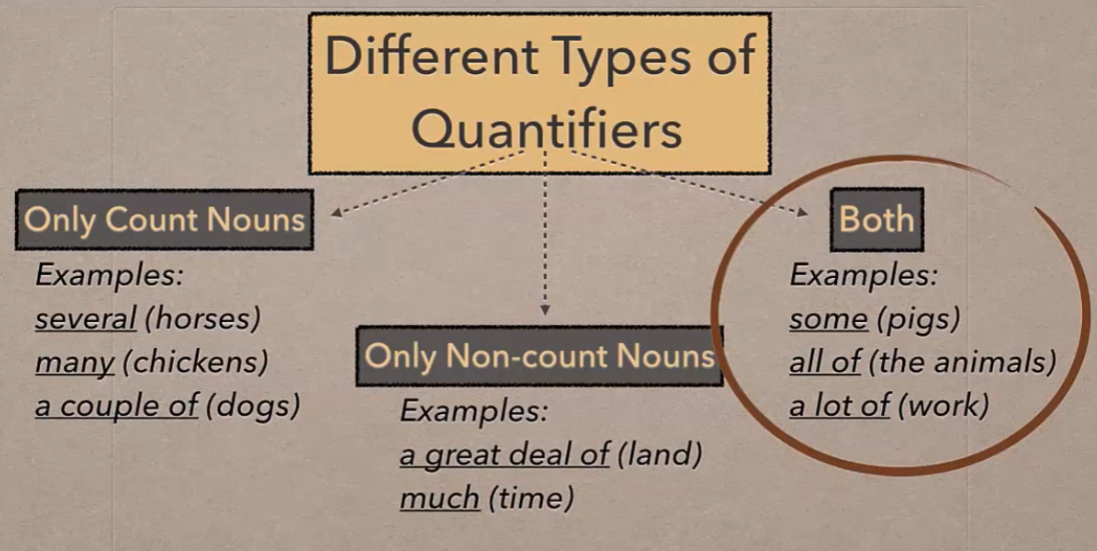
Quantifiers Part 2 Lecture
Quantifiers, part two. Now in this video, I would like to talk about quantifiers for
both count nouns, such as, cookies. And non-count nouns, such as milk. Take a look at this chart. This chart shows some of
the most common quantifiers. For large quantities,
we have a lot of, lots of, plenty of. For small quantities, some. And other quantities no, any, all, most, and enough. Now, notice some of the quantifiers
are one word quantifiers. Like no or some, and others are phrases such as a lot of and plenty of. Now, all of these quantifiers are really
great to know because they always work. Even if you don’t know if
a noun is a count noun or non-count noun,
they’re going to work fine.
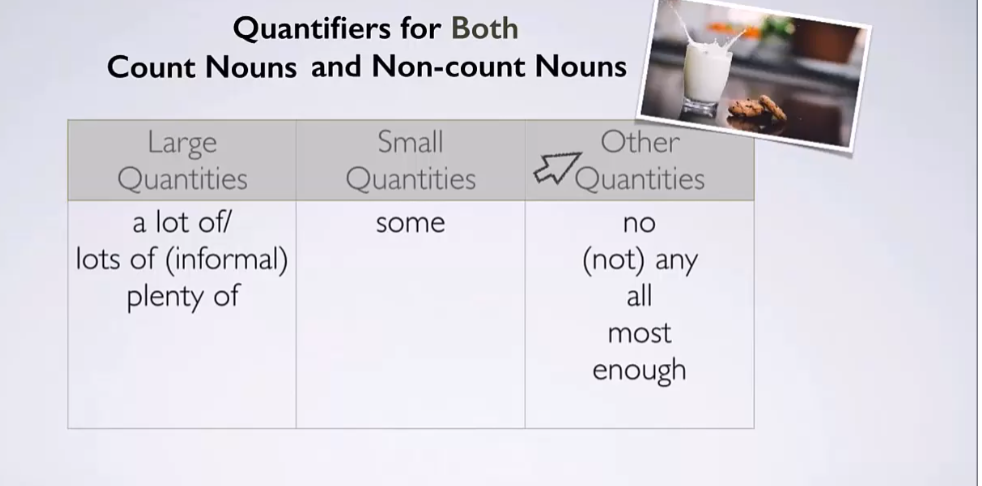
Now, let’s talk about each of
the quantifiers in the chart starting with large quantities. A lot of. Here’s an example. Stanley won a lot of money. When you use this phrase,
don’t forget the a, a lot of. That’s a common mistake. He plans to do lots of
traveling from now on. Lots of is the plural form. But keep in mind,
lots of is more informal than a lot of.
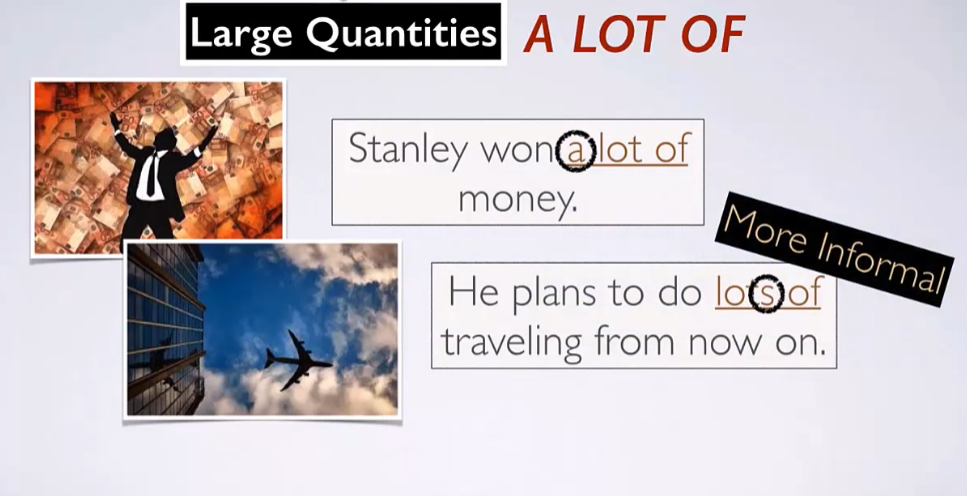
Now, let’s talk about plenty of. Plenty of also expresses large quantities. There is plenty of meat here for
one person. Plenty of means more than necessary. Here’s another example. There are plenty of colors to choose from. Yeah, I think so.
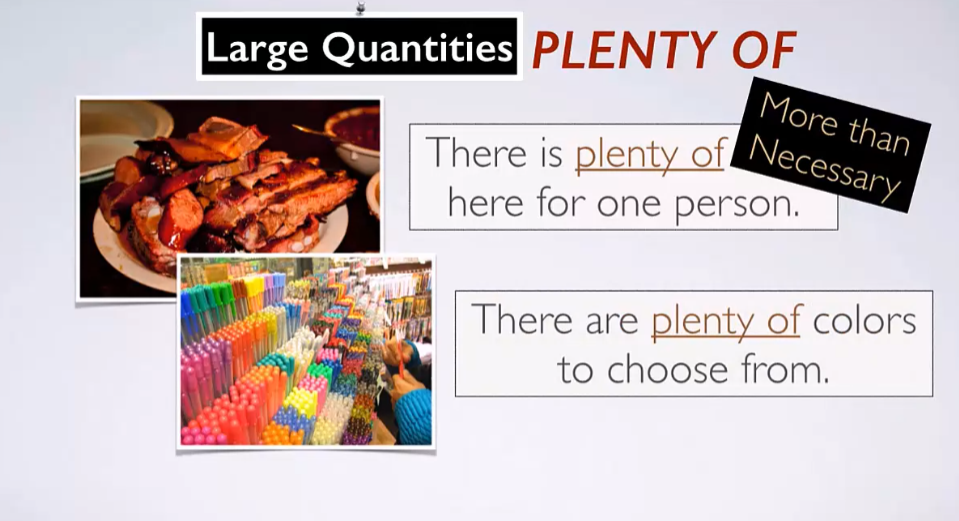
Small quantities can be
expressed using some. Take a look at this photo. I could say, wow,
there are some dogs in that car. Or if I’m felling like this, I might say,
I could really use some coffee. Some is a very useful quantifier.
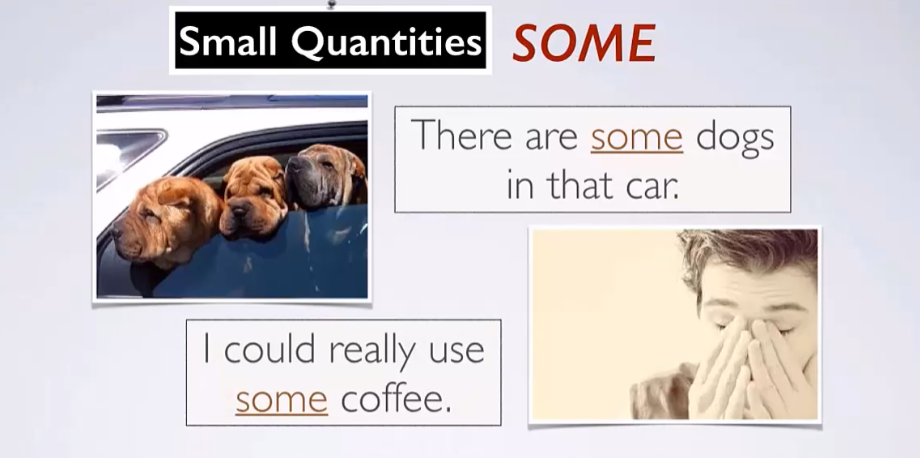
Then there are other quantifiers,
such as no. There is no traffic right now. Look at that sign. No animals are allowed
inside this restaurant.
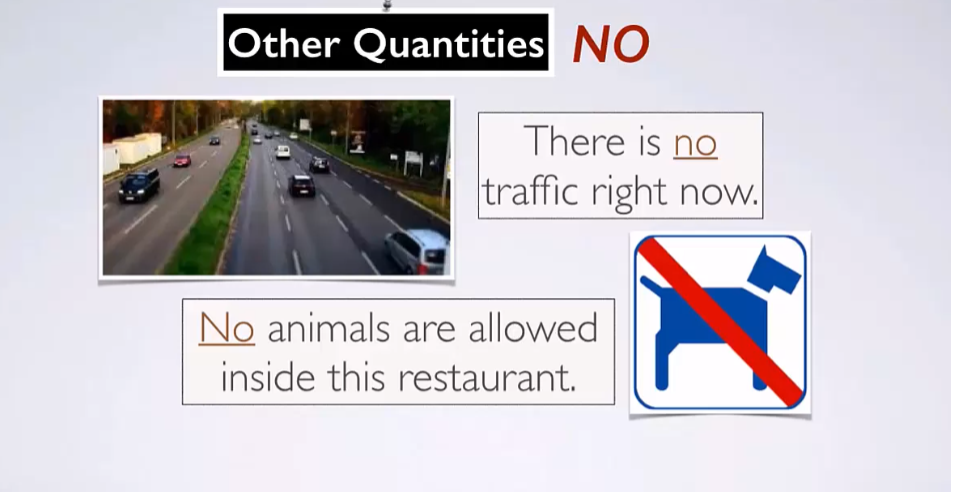
Any is another very common quantifier,
but it’s a little more difficult to use. Remember to use it in negative
statements or question form. Let’s look at an example. I do not have any furniture yet. Notice that the not makes
this statement negative. Let’s take a look at a question. Will you get any curtains for
your windows? I might answer no, I’m not planning on getting any curtains
since the trees give enough privacy"
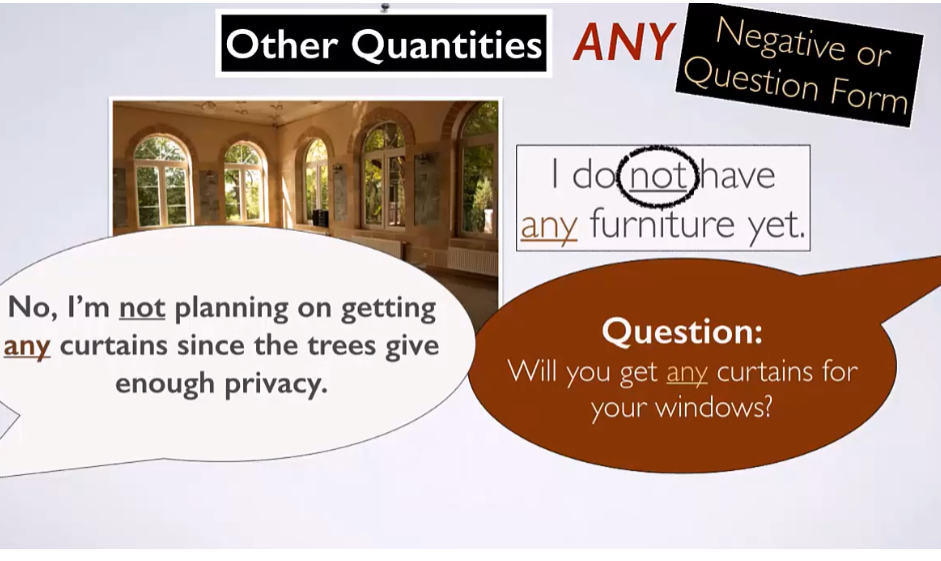
Any actually can be used
in some affirmative statements if it is used correctly, meaning you add the correct words
barely or hardly before any. There is barely or
hardly any room on this train. Here is another example. What could you say here? Well, you could say there is,
that’s right. Barely, or hardly, any fuel left. Meaning, almost no fuel.

Another quantity is all. Like all babies are beautiful, and
almost all of the windows are closed. Obviously, almost all
is not the same as all. But what it means is close to all.
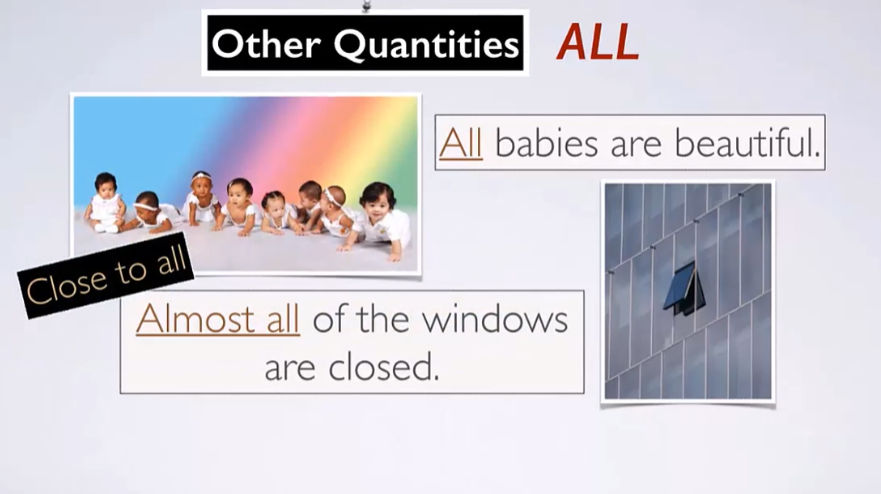
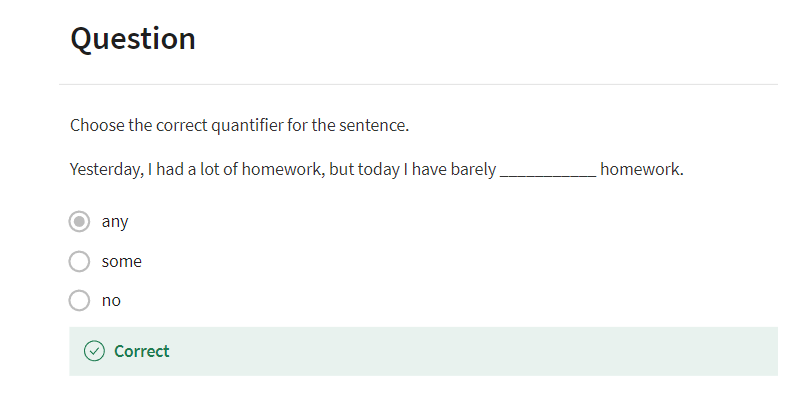
Most. Most Americans have a college education. Close to 60% have attended a university or
two-year college. Most just means more than 50%.

Enough. I have enough cash to pay. Enough just means that you
have the amount that you need.
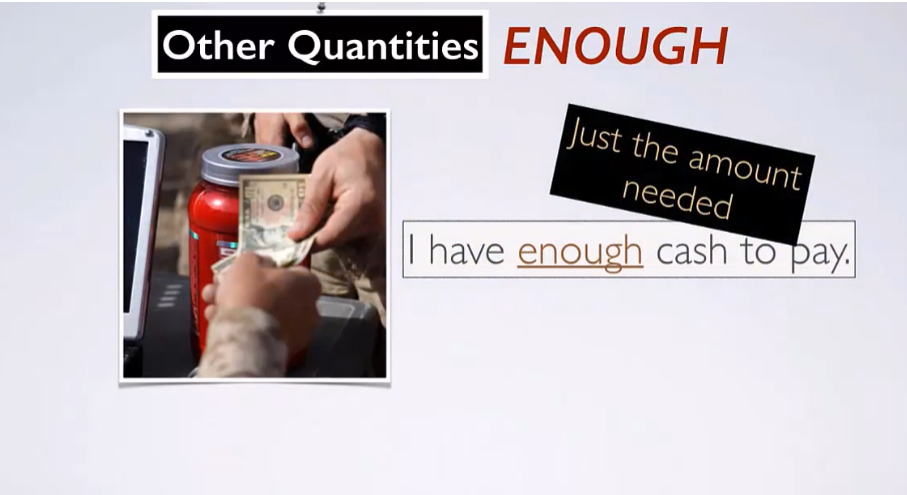
Now, we’ve looked at a lot of
different quantifiers that can be used with both count nouns and
non-count nouns. Make sure to watch part three for a discussion on the quantifiers that
can be used with only count nouns, and quantifiers that can be
used with only non-count nouns. All right. I’ll see you soon.
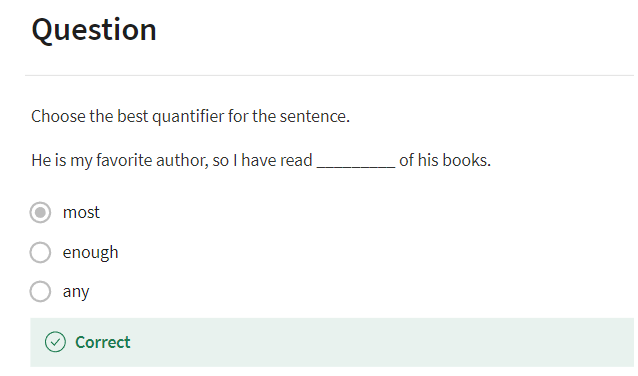
Quantifiers Part 3 Lecture
Quantifiers part 3. Do you remember this graph? Well, in this video, we’re going
to be focusing on quantifiers for only count nouns and only non count nouns. Take a look at all of these quantifiers. Which of these quantifiers
can be used with count nouns? An example of a count noun is bicycles. Well, you would be left with these. Many, a couple of, a few,
several, and a number of.
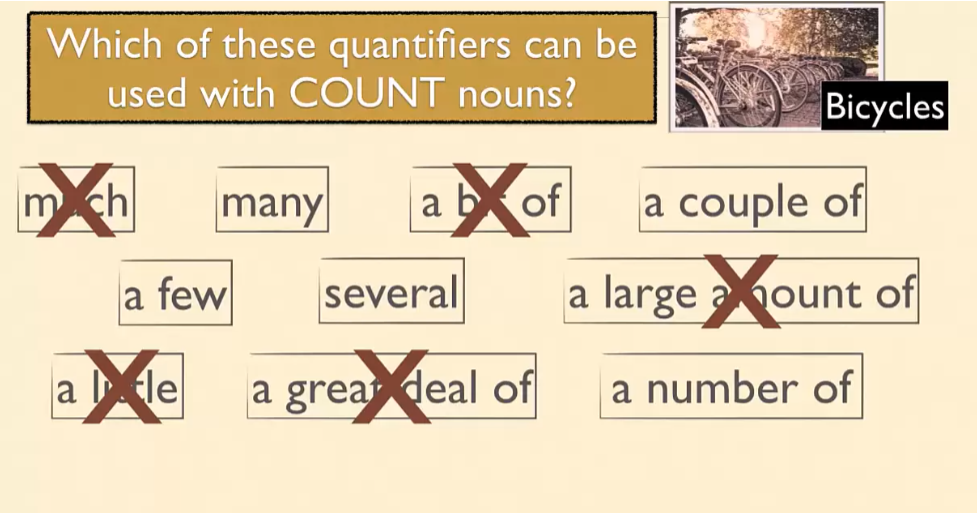
Let’s put these words into two categories,
large quantities and small quantities. Many is the most commonly used for large quantities, while a few,
a couple of, a number of, which means the same as
several are the most common. A number of, can actually be used for
both quantities. If you say a small number of,
well that means small quantities, and if you say a great number of or a large number of, then of course,
you mean large quantities.
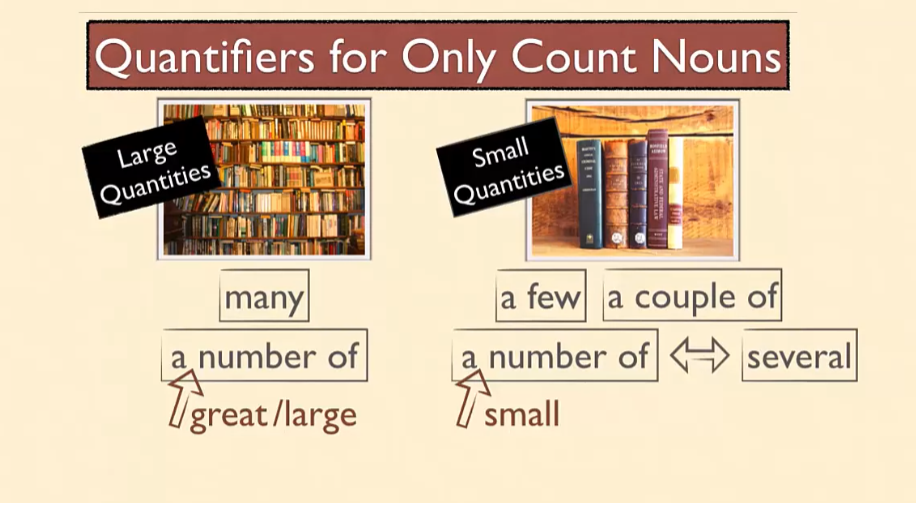
Other quantifiers for
only count nouns include each and every. And both refer to singular
nouns as members of a group. Each emphasizes the individual,
often focusing on differences. Here’s some examples. Each book tells a very different story. Each cover is a different color. Every, focuses on the group and
similarities in the group. Every book is enjoyable to read. Every book has a hard leather cover.
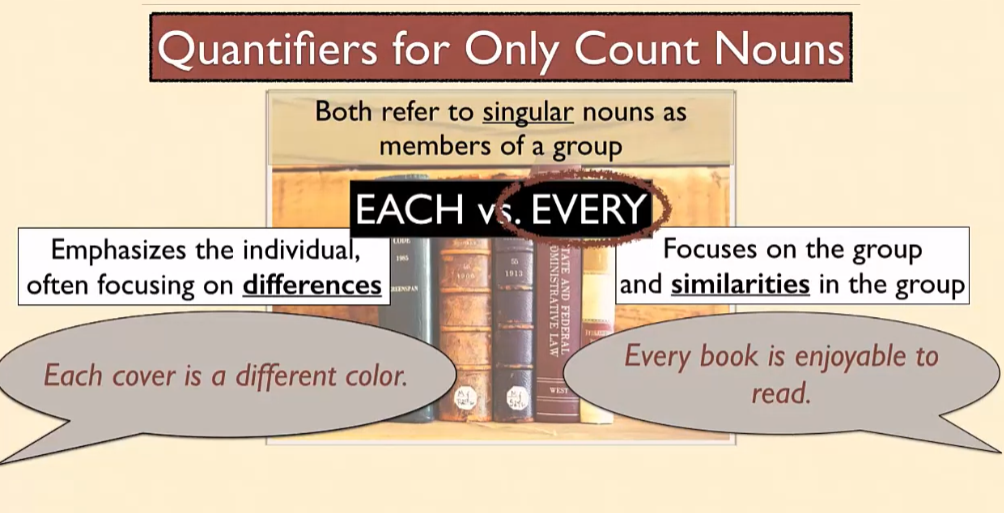
Now let’s take a look
at these words again. Which of these quantifiers can
be used with non-count nouns? An example of a non-count noun is sand. Well, here we are. Much, a bit of, a large amount of,
a little, a great deal of.
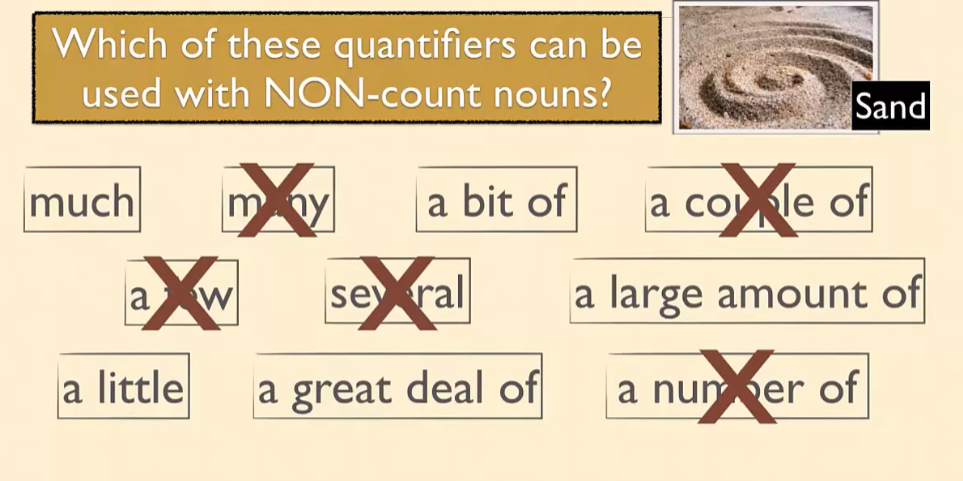
Now lets put these into
categories as well. Categories for only non-count nouns. Large quantities and small quantities. For large quantities you can use much, a great deal of and a large amount of. And for small quantities a little,
a bit of, or even a little bit of, and
then of course, a small amount of.

Let’s try a quick exercise. Fill in the blank with a quantifier. Make sure to look at the pictures,
and remember glass is a count noun. Well, here’s the answer. A couple of the glasses had wine in them,
but many of the glasses were empty.

Let’s try another one. Fill in the blank with a quantifier. And remember, heat is a noncount noun. Did you get this right? You would say a candle can
provide a little bit of heat, but a campfire can provide
a great deal of heat.
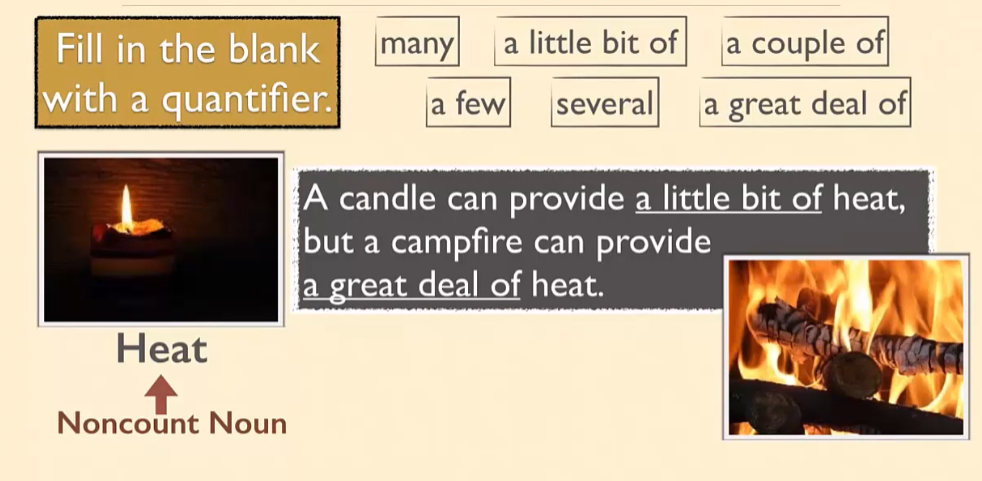
Great job. Let’s do one more. Hm. Relying on this picture we would say, this
store carries a large amount of jewelry. Jewelry remember is non count noun. Manhattan is famous for
having a great number of towers. Towers is a count noun. All right. I think we’re ready to
move on to part four. In part four, we will be discussing
common mistakes using quantifiers. See you soon.
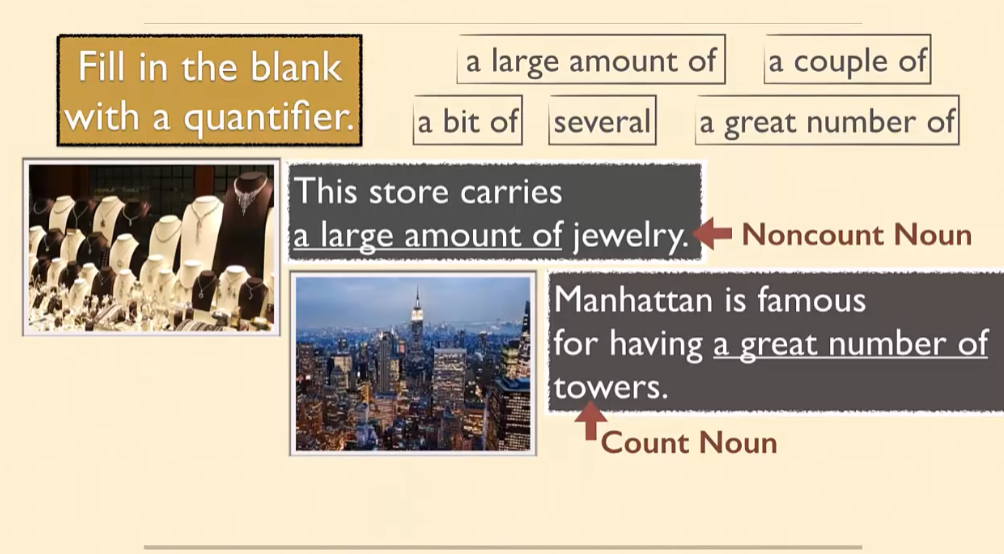
Quantifiers Practice Quiz

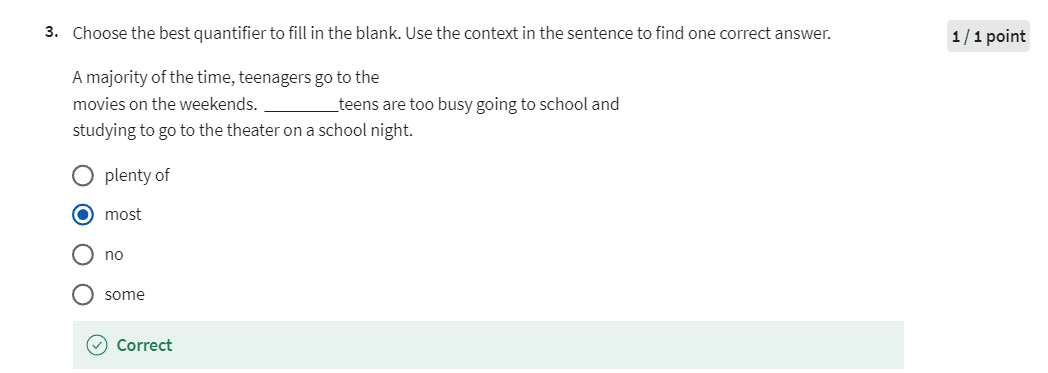
Quantifiers Part 4 Lecture
Quantifiers Part 4. In this video, I’d like to focus on common mistakes
that are made when using quantifiers. Let’s begin with a quick exercise. See if you can identify the mistakes
in the following statements. How many sleep did you get last night? My little sister got
much candy on Halloween. I will have some of rice. Let’s talk. I have little time. Can you see where the mistakes are?
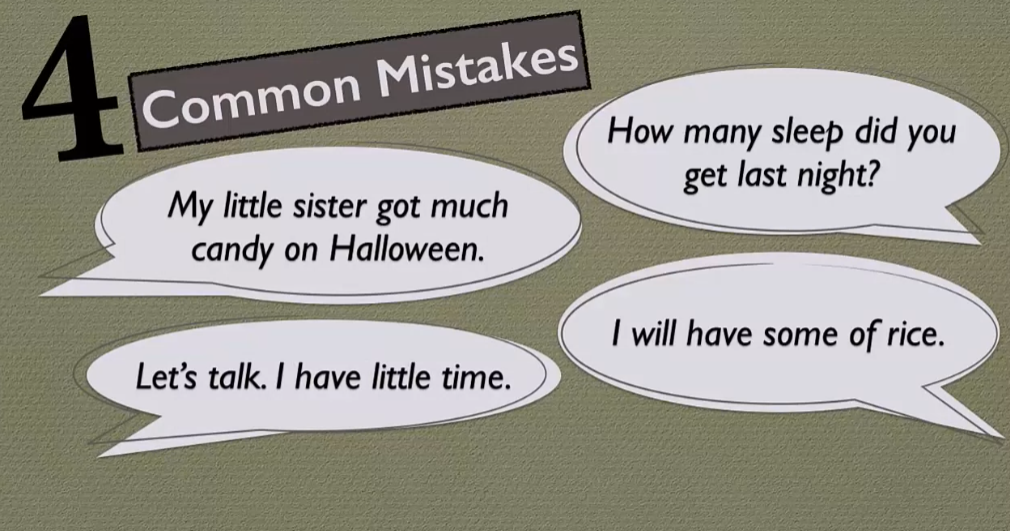
All right, let’s discuss each one and
let’s begin with this statement. How many sleep did you get last night? Well, sleep is a non-count noun. So many cannot be used with sleep. What you would say is,
how much sleep did you get last night?
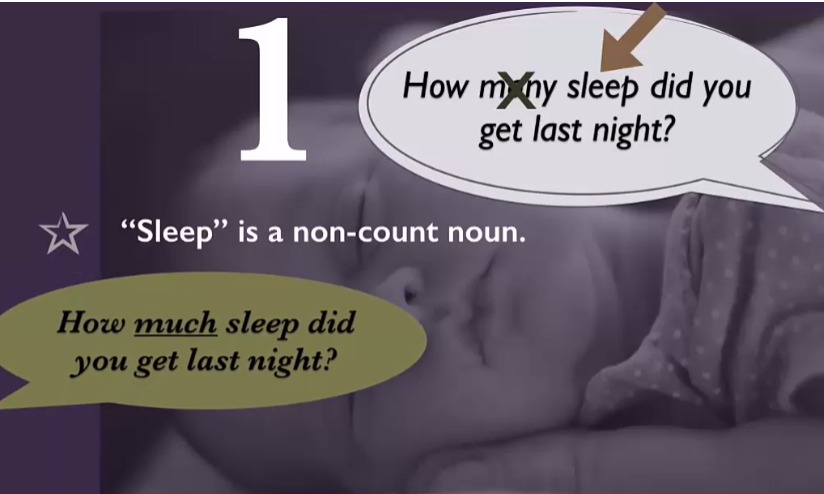
The other option is to keep many and to
make sleep countable by adding hours of. How many hours of sleep
did you get last night? Okay, so the key thing is to remember
to study which nouns are count and non-count so you’ll know which
quantifiers to use with them and you won’t make this kind of mistake.

Let’s look at another example before
we move on to mistake number two. Come to the birthday party with me, Alex! In response, Alex wants to say
that he can’t go to the party because his teacher gave him
a large quantity of homework. Would it be okay for Alex to say, I can’t,
my teacher gave us many homework? Well, remember,
homework is a non-count noun. So actually, no,
he can’t use many with homework. Many is used with count nouns. So you can say, I can’t, my teacher
gave us many homework assignments. This would be correct because
assignments is a count noun and in this statement,
homework is now an adjective.

Okay, let’s move on to mistake number two. My little sister got
much candy on Halloween. You maybe thinking, well,
candy is a non-count noun and much is used with non-count nouns,
so what’s the problem? The issue is,
used in affirmative statements, much sounds very formal. In everyday conversations,
you can use a lot of instead of much. My little sister got a lot
of candy on Halloween. Okay, so try to remember that much sounds
natural in negative statements and questions, but
not in affirmative statements.
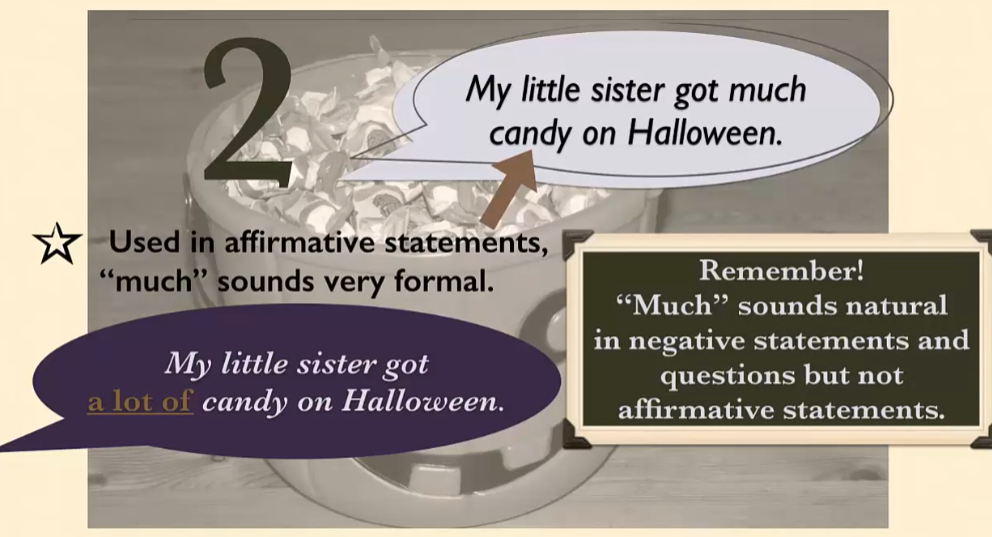
Let’s look at this example again. Remember, much in affirmative
statements sounds too formal, so it wouldn’t be ok for Alex to say,
I can’t, my teacher gave us much homework. Much can be used in forming,
as I said, questions like, how much research do you have to do, or negative statements like,
I do not have much research to do. But in affirmative statements, it’s
better to use a lot of instead of much. So Alex could say, I can’t,
my teacher gave us a lot of homework.
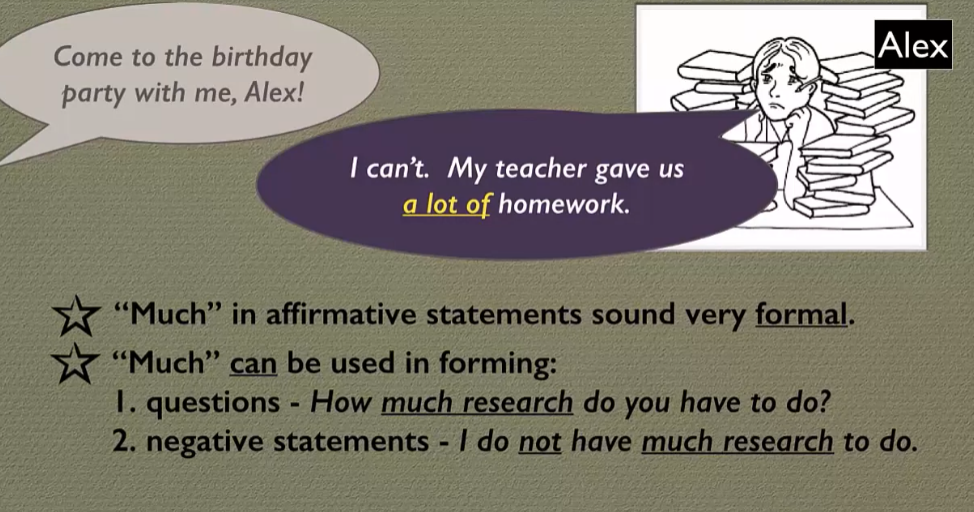
The third type of mistake can
be shown in this statement. I will have some of rice. Perhaps you’re thinking
there’s an extra word here. I will have some rice. Good! But now let’s talk about why
it’s incorrect to have of here. Well, it actually depends on whether the
noun is being used as a non-specific or specific noun. If the noun is non-specific,
then of needs to be taken out. However, if the noun is a specific noun, then you must add “of” with
a determiner after it. Commonly, we use the. I will have some of the rice. But there are other
determiners you can use, such as possessive nouns and
pronouns, such as mom’s or her. I will have some of her rice. You can also use demonstrative
pronouns such as this or that. I will have some of that rice. So again, remember to put
these determiners after of. And remember that determiners
show the noun is a specific noun.
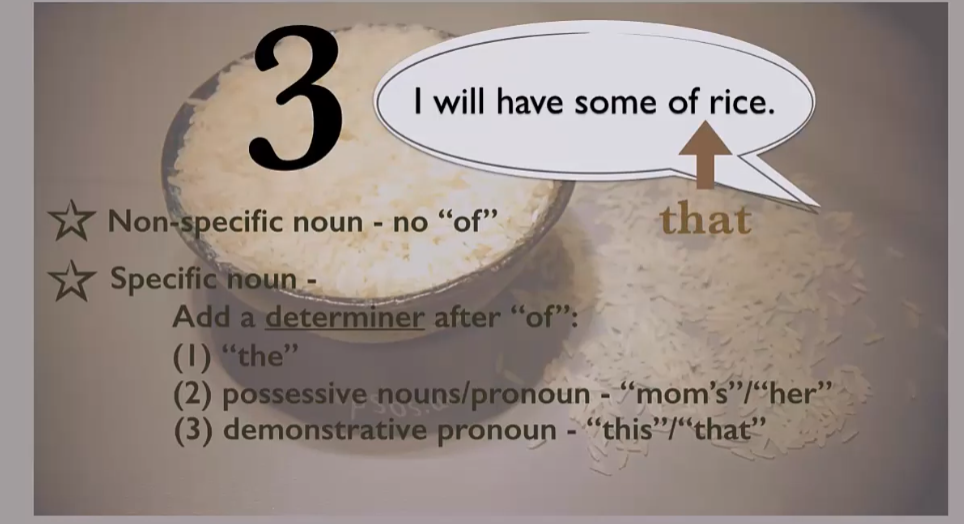
Okay, but you need to be careful
because some quantifiers always use of. These are set phrases such as a lot of,
lots of, and plenty of, which can be use with both count nouns and
non-count nouns. A couple of and a number of,
which can be used with only count nouns. A bit of, a small amount of,
and a great deal of, which can be used with
only noncount nouns. These phrases can be used
with non-specific nouns or with specific nouns
following a determiner. Let’s look at some examples. We need a lot of volunteers to help us. Notice that volunteers comes right
after the set phrase a lot of, because volunteers here
is a non-specific noun. Versus, we need a lot of the volunteers
that helped us last time. Let’s use a bit of. A bit of motivation can keep me going. Versus, a bit of the motivation
my mother gave me kept me going. Again, if you’re using a specific noun, make sure to use a determiner after the
set phrase and before the specific noun.
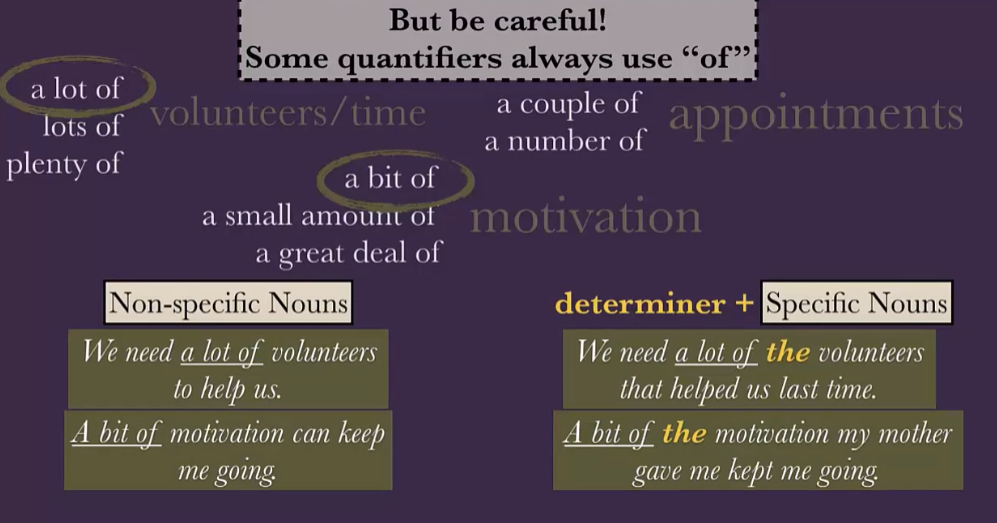
Now, with these other quantifiers
that are not part of set phrases, you would have to add
of plus the determiner. Let’s look at an example. First, with a non-specific noun,
then a specific noun. Sarah has traveled to many countries. Versus, Sarah has traveled to many of the
countries her grandfather told her about. Great, so remember, some quantifiers need
of plus a determiner with specific nouns.
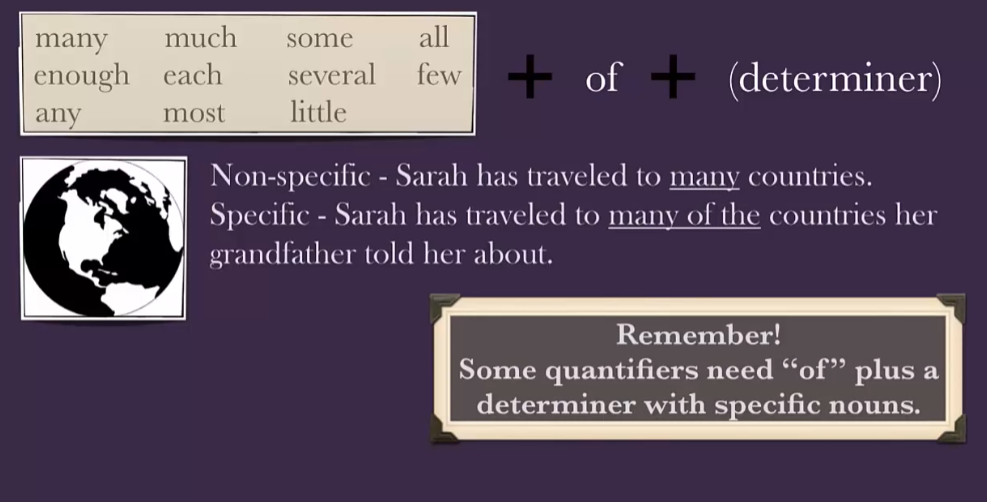
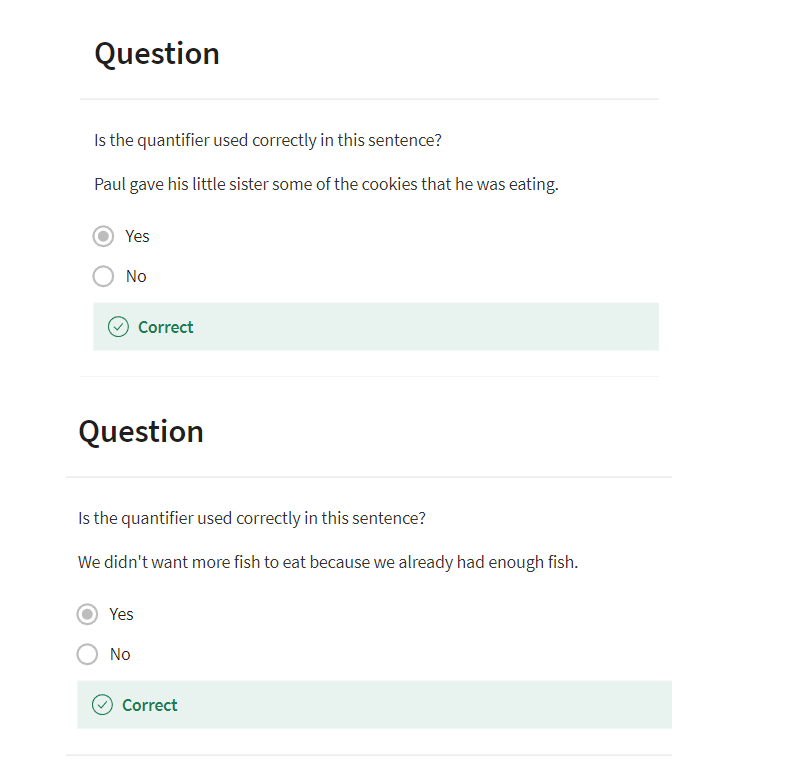
Now let’s talk about the last
type of common mistake. Here’s a statement. Let’s talk. I have little time. This statement doesn’t make sense. You would need to say,
let’s talk, I have a little time. Because there’s a huge difference
between using little and a little. And remember,
these words are used with non-count nouns. Okay, so without a,
this statement emphasizes not many. Whereas with a,
the statement emphasizes having some. Here’s an example. I have little time. Well, let’s talk later. If you just use little without a, that means that you really
don’t have much time. Whereas when you use a and
say, let’s talk, I have a little time, that means
that you have some time to talk. Few versus a few is similar,
except few and a few are used with count nouns.
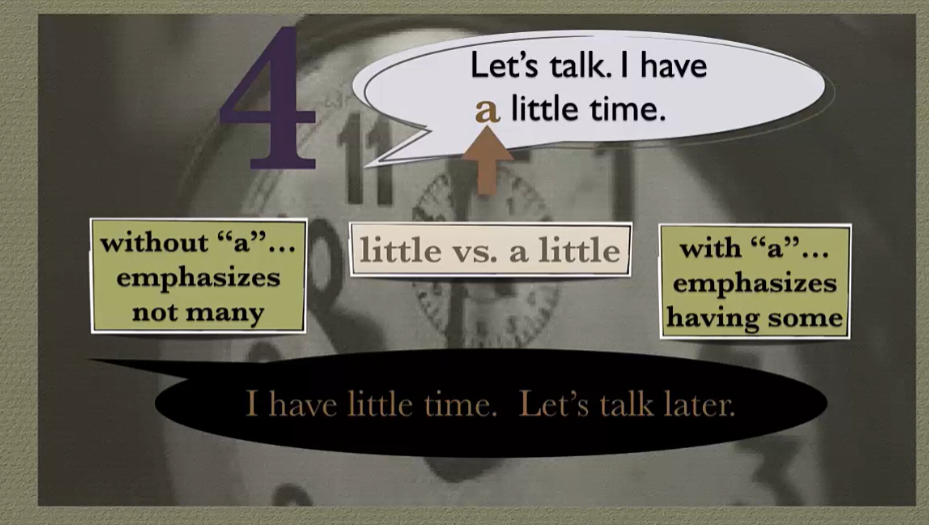
Now let’s look at this
in a different context. Hi Tim! How’s the job hunt going? Not good. There are few job openings
I’m qualified for. Good! There are a few job
openings I’m qualified for. Do you see the difference? Of course, when Tim says, not good, there are few job openings,
he is saying that there are not many. Versus, when he says, good,
there are a few job openings, which means that there are some. He’s being positive here. Okay, so remember,
a little and little, a few and few, actually have opposite meaning. Well, it’s been fun. You’ve learned a lot about quantifiers
in these last four videos. Keep practicing and thanks for watching.

Quantifiers Practice
Practice
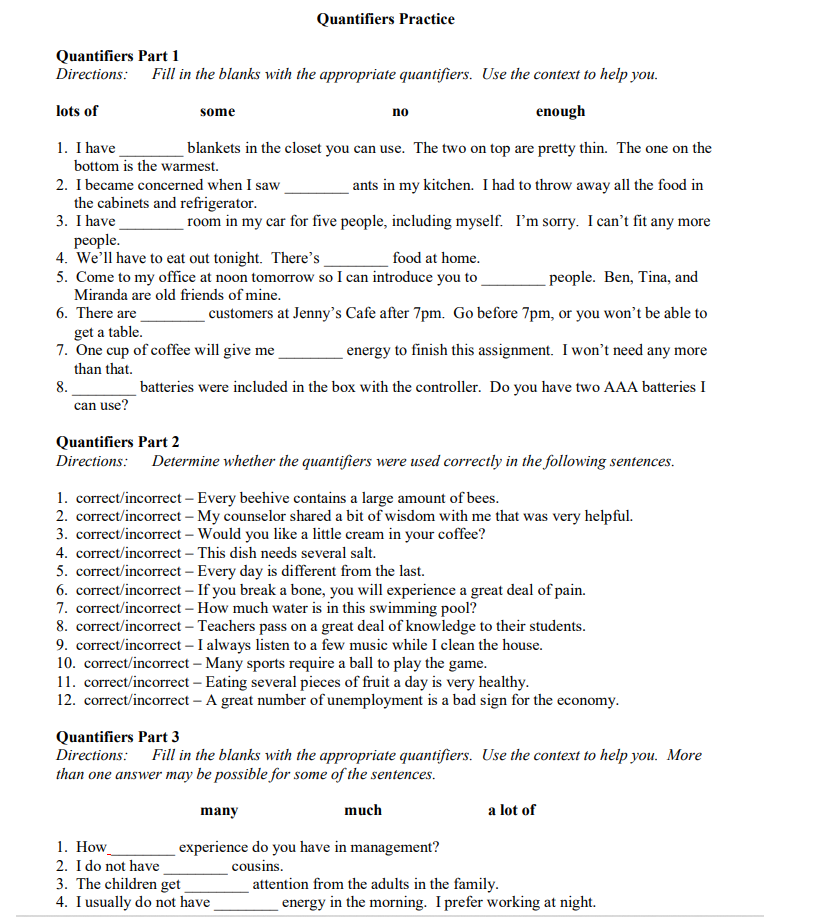
Practice key
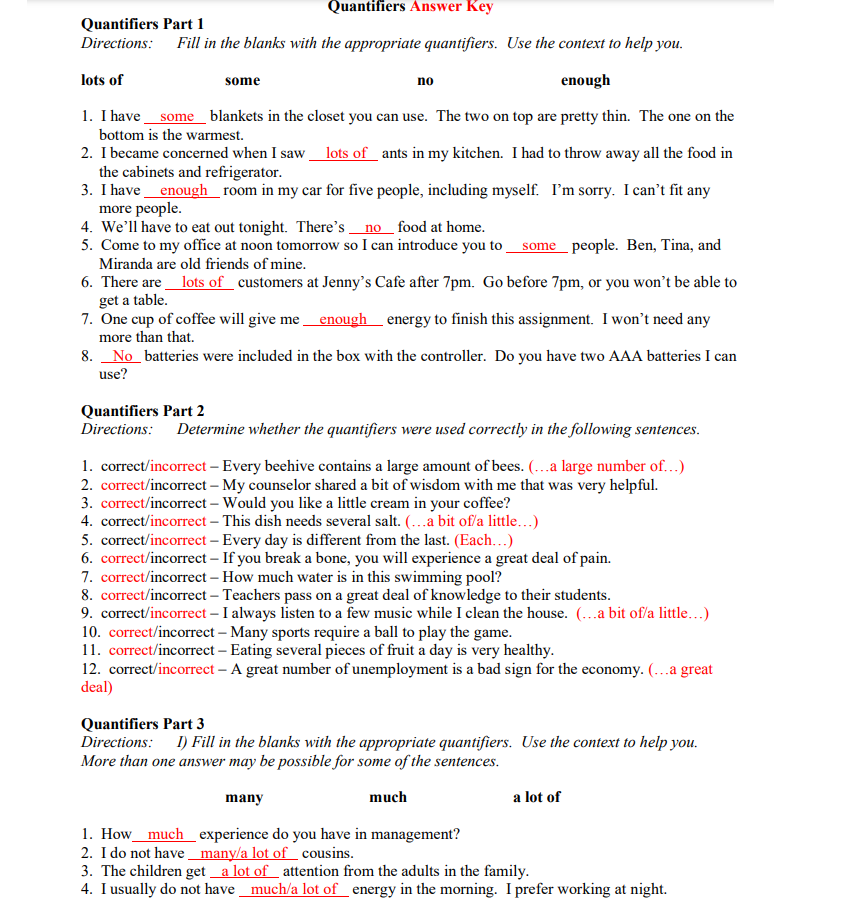
Graded Assignment: Nouns, Articles, and Quanifiers Assignment
Write a short paragraph using lots of count and non-count nouns with correct articles and quantifiers. Use a minimum of 10 nouns.
Example:
We went to McDonald’s for lunch today and ate a lot of food. My friend, Mark, got a hamburger and some french fries. The fries were hot, salty, and delicious. He needed a large Coke to wash it all down. Then Mark got a small milkshake and an ice-cream cone for dessert. Our other friend, Jenny, had a large order of chicken nuggets and a few fries. She couldn’t finish her lunch because there were too many chicken nuggets. I had a salad and an iced tea, but after I ate the salad, I was still hungry, so I got some fries and an apple pie. I even ate some of Jenny’s nuggets. It was all tasty, and we felt satisfied when we left.
My try
Yesterday, my family and I went to the grocery store to buy some groceries. We needed a lot of items for the week. We picked up a dozen eggs, a loaf of bread, and a gallon of milk. We also bought some fresh fruits, including apples, bananas, and oranges. In the produce section, we grabbed a head of lettuce, a bunch of carrots, and a bag of potatoes. For dinner, we planned to make spaghetti, so we got a pound of pasta and a jar of tomato sauce. Additionally, we bought a package of ground beef and some Parmesan cheese for the sauce. At the checkout, we realized we forgot to get a carton of yogurt and a container of butter, so we quickly grabbed those too. After loading everything into the car, we felt relieved to have everything we needed for the week ahead.
Graded Quiz
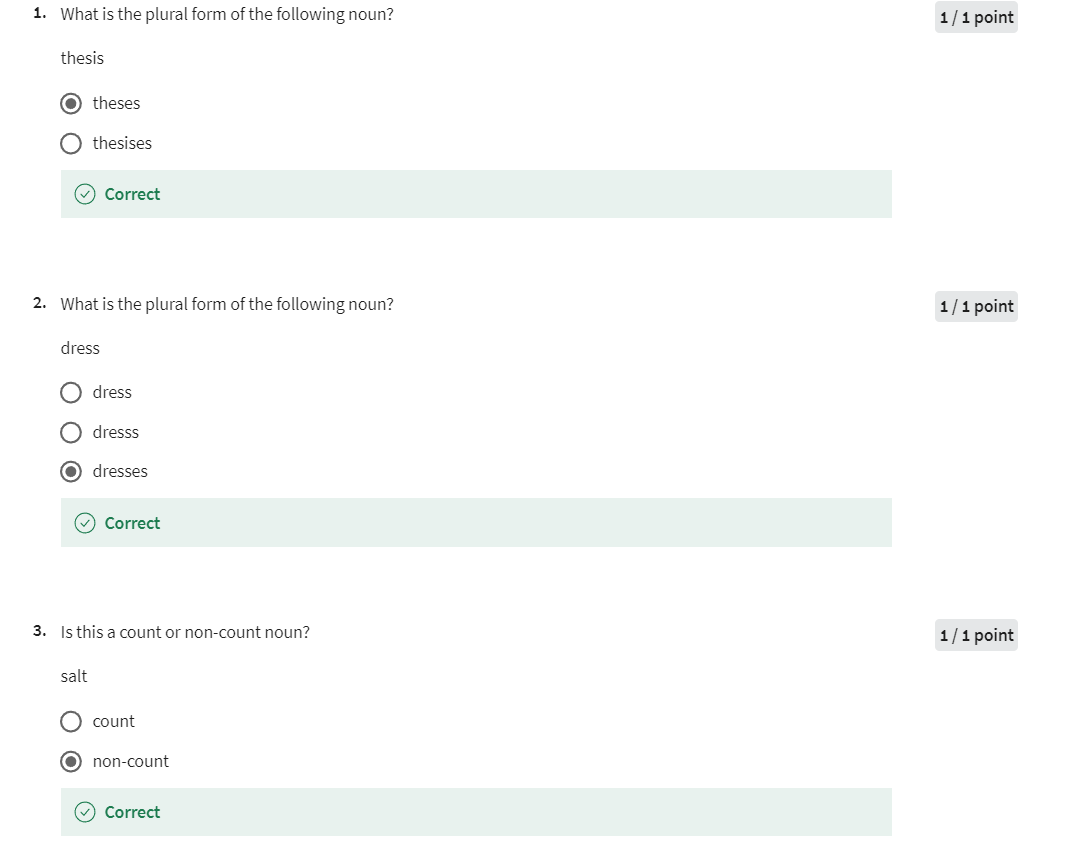
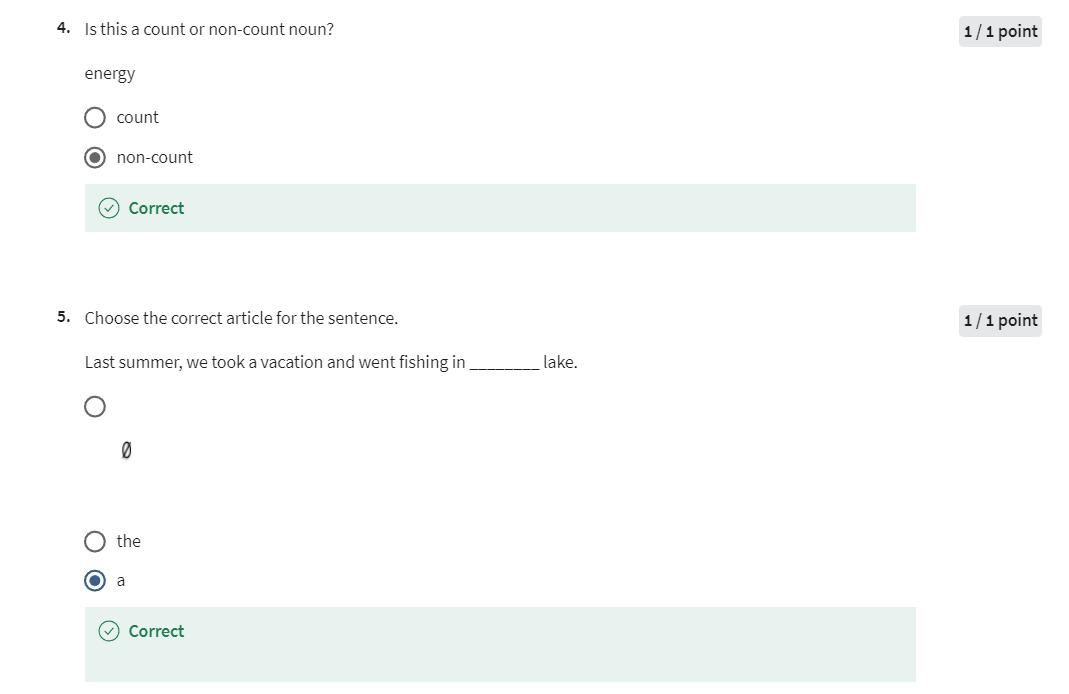
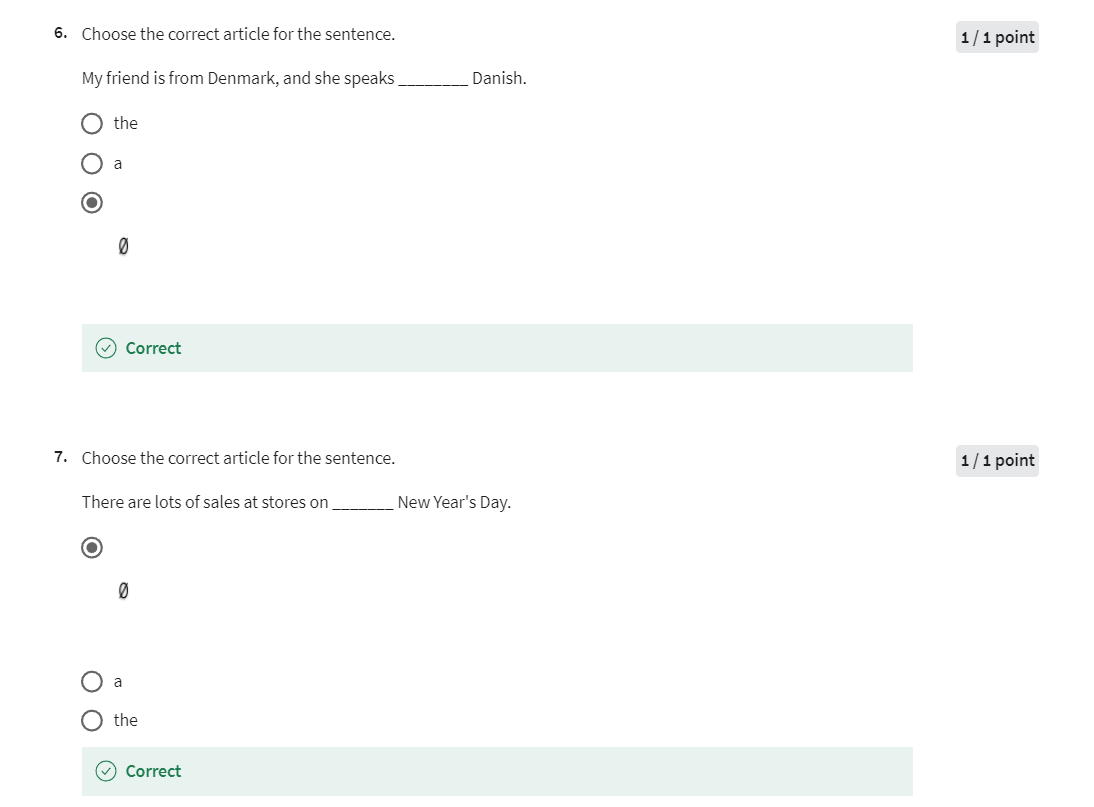
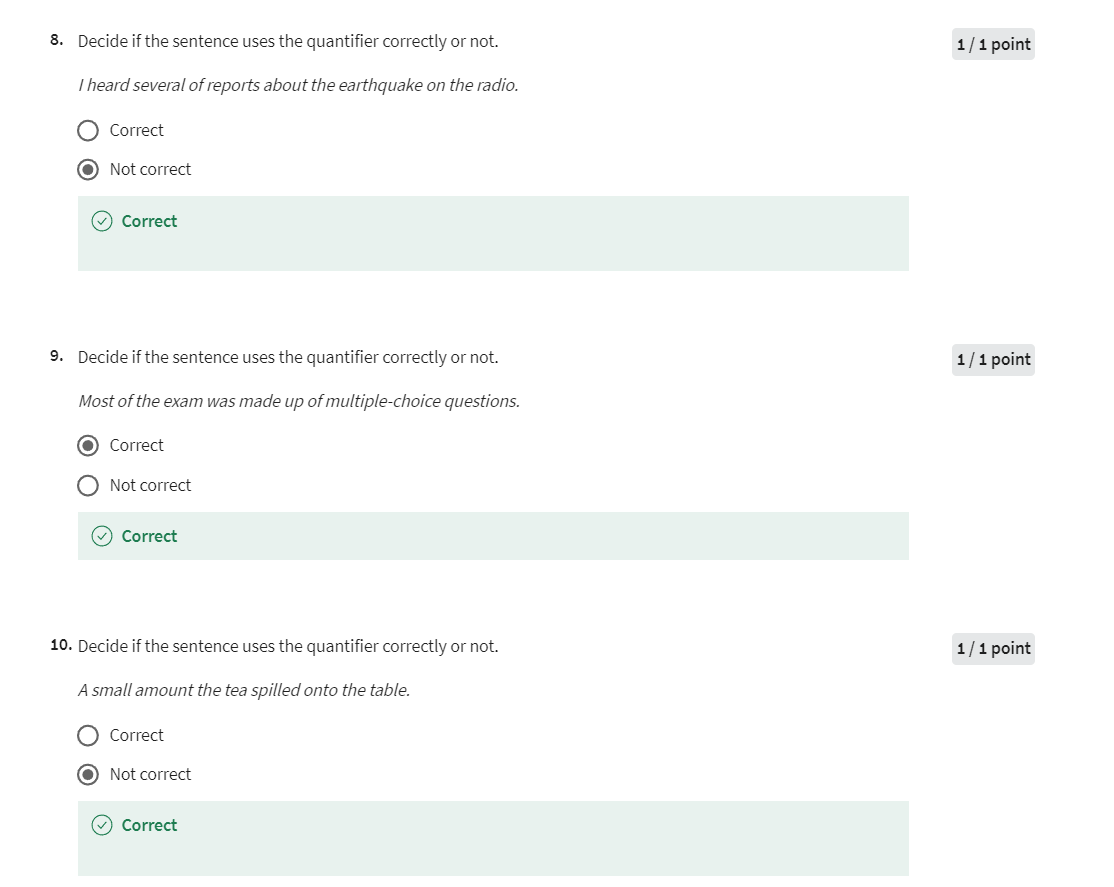
Week 02: Gerunds, Infinitives, and Requests and Permission
This week will not be as intense as last week was, but you will still have the chance to learn about some tricky grammar. First, you’ll learn about using gerunds and infinitives correctly. Then you’ll learn about making requests and asking for permission, something that English learners often misuse.
Learning Objectives
- • identify which verbs require gerunds or infinitives after them
- • use gerunds and infinitives correctly most of the time
- • use several different correct ways to ask other people to do something for you
- • use several different correct ways to ask for permission to do something
Gerunds and Infinitives Part 1 Lecture
In this video, we’re going to do a basic
review of gerunds and infinitives, and listen to an example of gerunds and
infinitives in use. Now let’s start with a basic review
of what gerunds and infinitives are. Gerunds are words that look like
verbs ending in ing, eating, dancing, studying, but they do not
express a tense, and are used like nouns. They can be the subject or
object of a sentence.

For example,
we enjoy laughing with our friends. Notice that enjoy is the verb and
laughing is the gerund. Laughing is the object of enjoy. We enjoy dinner with our friends. Notice how laughing in the first
sentence is like a noun and can be replaced with a noun like dinner. Infinitives, on the other hand, look like the base form of a verb,
drink, see, believe. But they are not used as the main
verb of a sentence, and so they also do not express
the tense in a sentence. Commonly infinitives follow to,
to drink, to see, to believe.
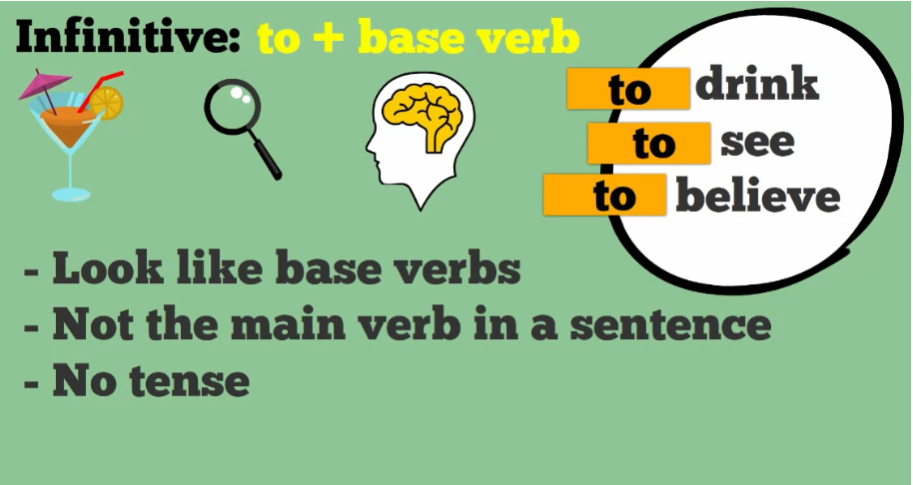
Example, I want to ask
the teacher a question. Notice that want is the main verb and
to ask is the infinitive. Now, let’s look to an example of how
someone might use both gerunds and infinitives in a real life situation. The speaker is Angela,
who has a very important event to plan. Listen to her give instructions to
several of the people helping her plan an awards dinner. As you listen,
see if you can catch how many gerunds and how many infinitives are used. Okay everyone, attention. I hate to tell you this, but we only
have five hours to prepare this room for our event tonight. To place the podium center
stage would be best. Hanna, please put all the medals and prizes right behind the speaker to
make it easy for him to reach them. Unfortunately, we must postpone
setting up the microphone. We don’t have all the equipment yet. We’ll need to quickly hook
up the microphone later. And I know Linda wants
to arrange the flowers. Linda, you’re good at decorating. Would you also consider setting
the silverware and napkins on the tables? But I can do it if you
don’t have enough time. Jackson, please tell the band to set up
by the dance floor, not on the stage. And would you mind showing
the caterers where the kitchen is? Planning this event would
not be possible without you. I love working with you guys. Now let’s get to work.
Okay, how many gerunds and
infinitives did you count? Did you count 6 gerunds and 7 infinitives? Well done. Please continue to Part 2, where you’ll
about the different uses of infinitives and gerunds,
as well as common mistakes with them.
Gerunds and Infinitives Part 2 Lecture
Gerunds and infinitives, part 2. Hello class, welcome to the second
video on gerunds and infinitives. In this video you’re going to learn
about the tricky ways that gerunds and infinitives are sometimes
used in sentences. We’ll look at some examples
from the first video and also take a look at some new examples. So, let’s begin. In the first video you saw lots of
examples of gerunds and infinitives and this was the most common form. A verb plus a gerund. Let’s look at the examples again. Unfortunately, we must postpone
setting up the microphone. Would you also consider setting
the silverware and napkins on the tables? And would you also mind showing
the caterers where the kitchen is? I love working with you guys. Notice that in all of these sentences
you have a verb plus a gerund. And remember a gerund is a verb in
the ing form but that acts as a noun.
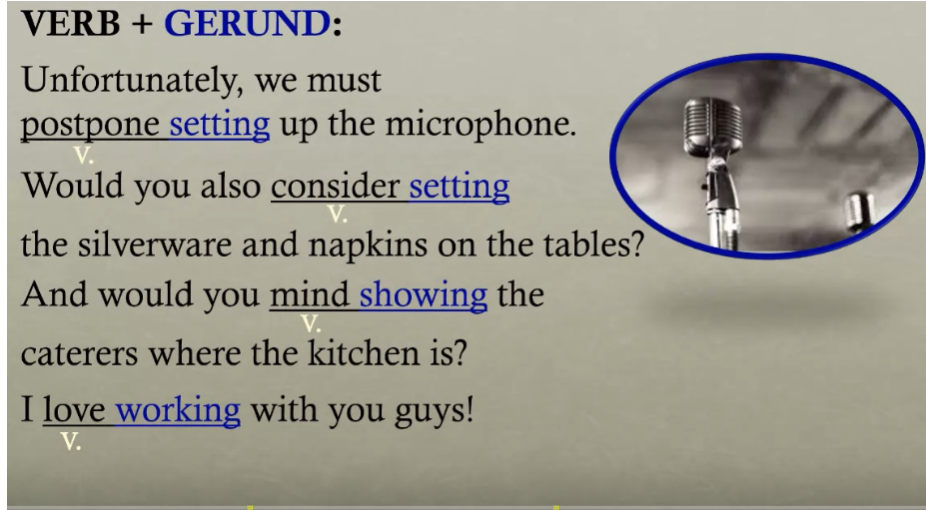
We also saw this form. A verb plus an infinitive. I hate to tell you this. And I know Linda wants
to arrange the flowers. Again, here we see a verb
plus the infinitive. To plus the base form of a verb.
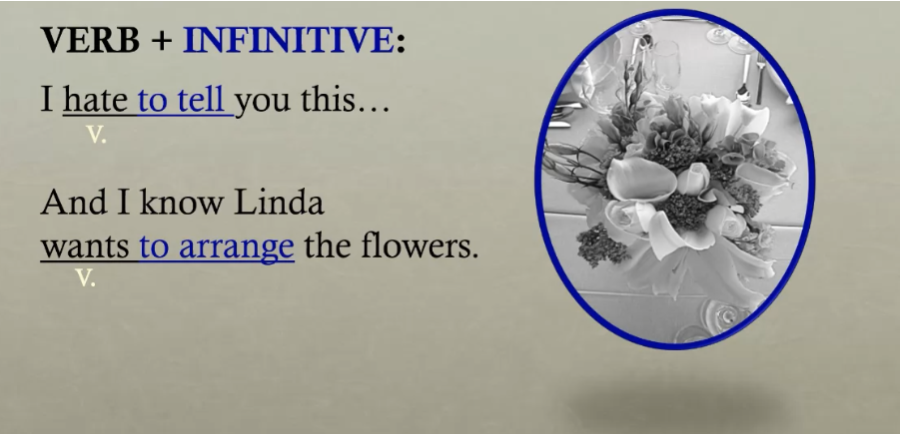
Now let’s talk about some of the ways
that you can avoid making mistakes. Starting with number one. Use the correct verb with the gerund or
infinitive. Take a look at this example. I dislike to go to the mall alone. Is it correct to use dislike
followed by an infinitive form? No, it should be going, the gerund form. I dislike going to the mall alone. How about this sentence: Jerry
promised meeting me at 4 pm. Can a gerund be used with promise? No it needs to be in infinitive form. Jerry promised to meet me at 4 pm. But what about this sentence:
The plane began to fly. This looks correct. Began followed by the infinitive to fly. But this also looks correct,
The plane began flying. Began can be followed by a gerund as well.
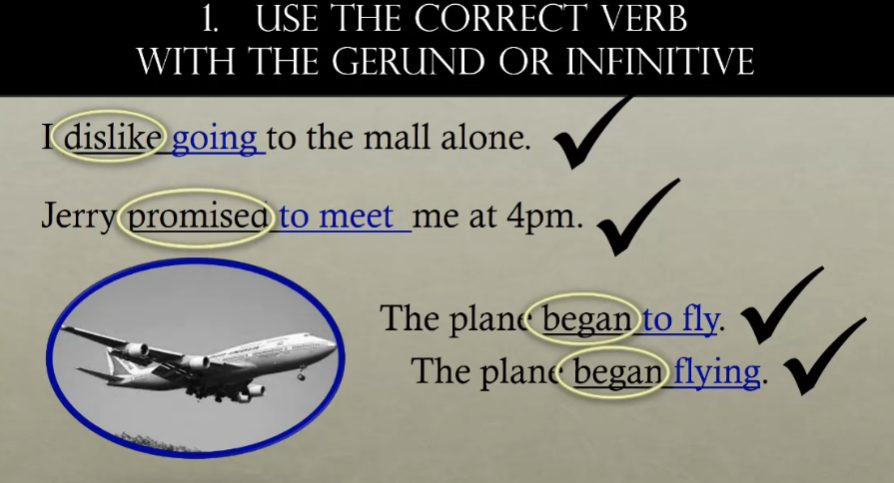
Now why are these both correct? Unfortunately there really
isn’t a simple rule to help you with all of the different verbs. But here’s a chart that you can study.
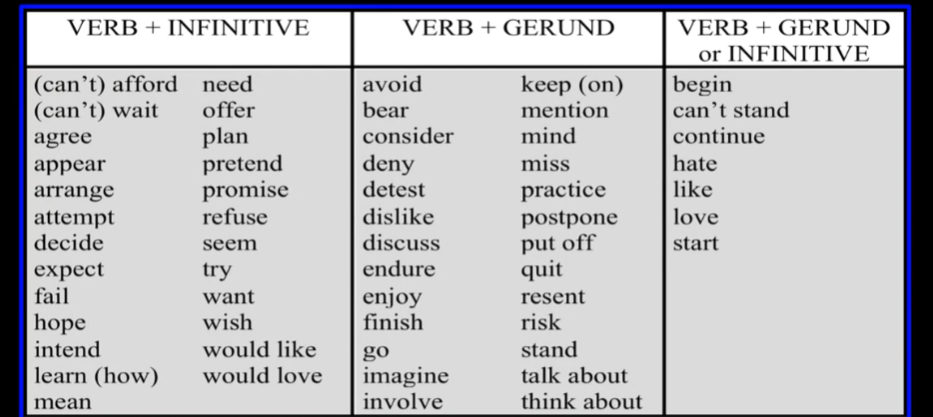
In the first column are verbs that can
be used only with infinitive forms, in the second column verbs that
can be used with gerunds, and in the third column, verbs that can be
used with both gerunds and infinitives. Now it can be difficult remembering
all of these different verbs, but it will get easier if you practice. Now let’s keep going.
Number two, make sure to use
gerunds after prepositions. Here’s the example from previous video. Linda, you’re good at decorating. At is a preposition and
it’s followed by a gerund. Now what do you think of this sentence? Timmy is happy about win first place. Well, about should not be followed by win. Timmy is happy about winning
first place is a correct way to form this sentence where
a gerund follows a preposition.
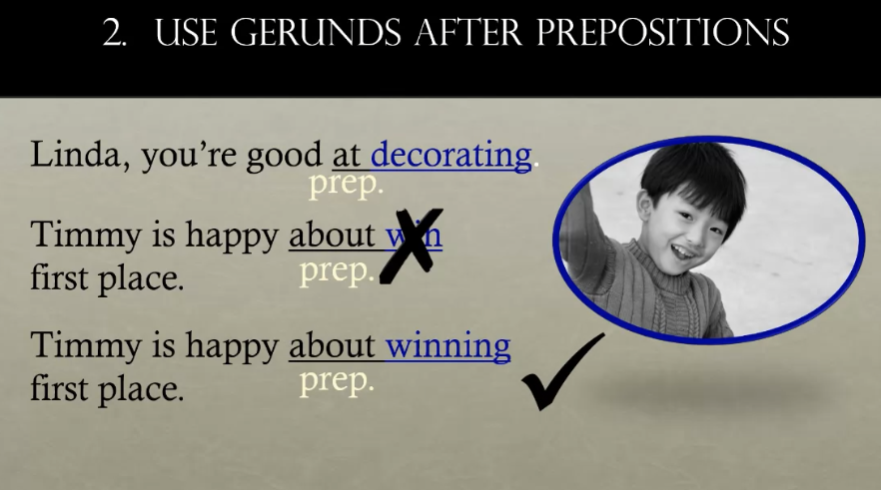
Number 3. Place the infinitive after
the verb object combination. In other words, if there is a verb
plus object combination make sure the infinitive goes after the object,
not after the verb. Here are some examples
from the previous video. But we only have five hours to prepare
this room for our event tonight. Have is a verb plus the object, and
to prepare comes after this combination. Jackson, please tell the band to set up
by the dance floor, not on the stage. Here we also have a verb plus object
combination followed by to setup.
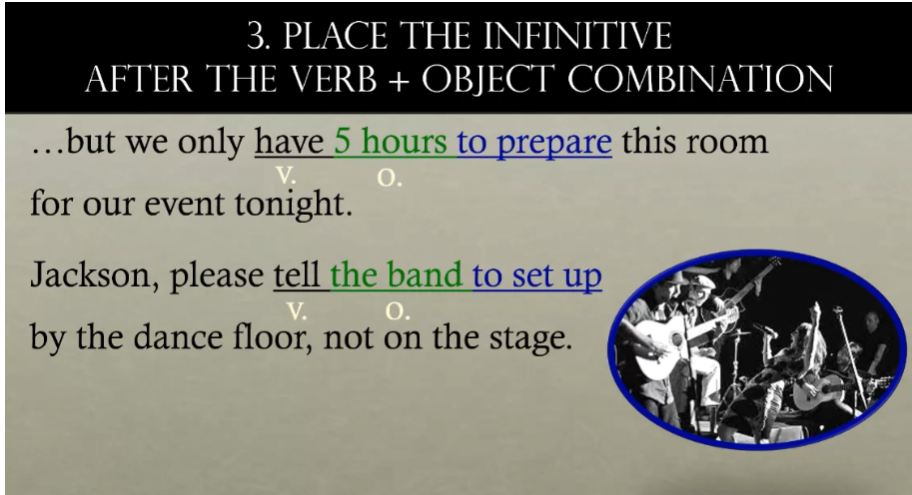
Let’s look at some more examples. Our boss told to finish
the project by next week. Do you see a problem in this sentence? Yes, we have ‘to finish’
without an object. Our boss told to finish us
the project by next week. Now, here we have an object,
but it’s in the wrong place. This is the correct sentence. Our boss told us to finish
the project by next week. Here is a verb object combination
plus ‘to finish’ are infinitive form.
Great, the forth thing to
remember is to use gerunds and infinitives in subject
positions correctly. So far we’ve only seen examples of gerunds
and infinitives coming after verbs. But they can also be used
as subjects of sentences. Like here, planning this event
would not be possible without you. Planning is a gerund, and
it’s the subject of the sentence. Take a look at this sentence. Do you think it’s correct? Swimming my favorite form of exercise. Well, it’s actually missing a verb. Swimming is my favorite form of exercise. Swimming is a subject. It needs a verb. So don’t forget to add a verb.
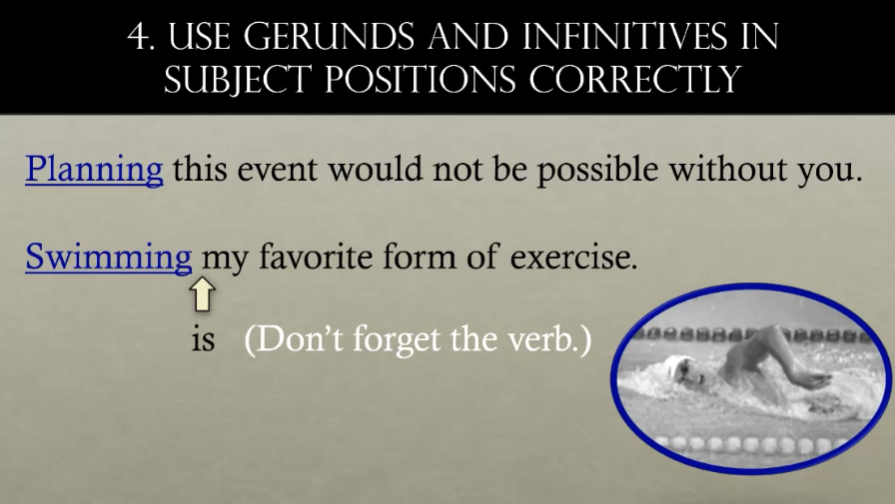
Now let’s talk about how infinitives
can be subjects in sentences. Remember this one? To place the podium center
stage would be best. Here’s another example. To leave now is foolish. Both of these sentences are correct,
but they do sound very formal. To use a more common form
use it as the subject, and move the infinitive to
the end of the sentence. It is foolish to leave now. This is a much more common form. Now I’d like for you to try. Take a look at this sentence again, to place the podium center
stage would be best. I’d like for you to think of how this
could be said in a more common form. Here we go.
It would best to place the podium center stage. Great job.
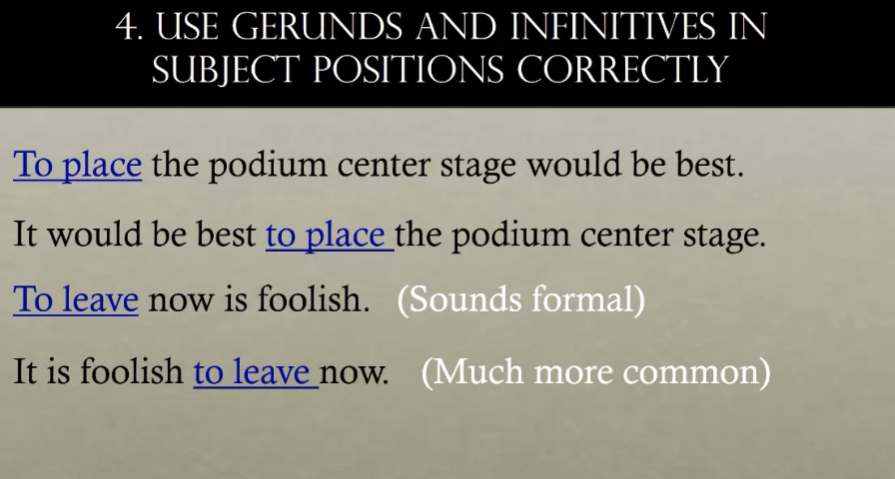
Let’s move on to number five. Remember, infinitives can
be used to show purpose. Infinitives can be used to
show purpose like “because”. Here’s an example from part one. Hanna, please put all the medals and prizes right behind the speaker to
make it easy for him to reach them. To make is the same as
saying because it will make.
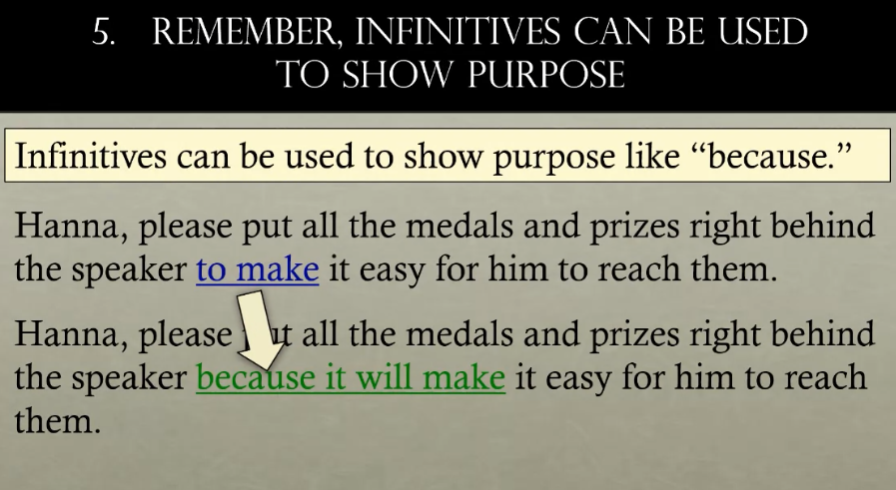
Let’s take a look at another example. Jimmy wears a suit because he
wants to look professional. Because he wants to look shows purpose. Let’s try changing this to a infinitive. Make sure to use look. Jimmy wears a suit to look professional. These two sentences
are saying the same thing. To look shows purpose.
The last thing you need to remember Is
that adverbs can split infinitives. With an infinitive like, to hook up,
you can add an adverb such as quickly. To quickly hook up. This example comes from the past video. We’ll need to quickly hook
up the microphone later. The adverb is added after to.
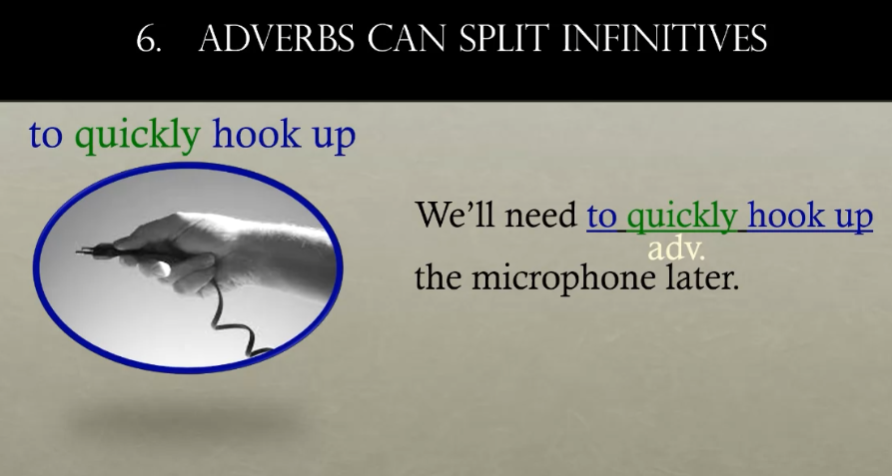
Let’s take a look at another example. They seem to like each other. Hm.
We can add an adverb right here between the to and
like. Such as, really. They seem to really like each other. It is important to efficiently study for
the final. We had efficiently as the adverb,
splitting to study. We could also say,
thoroughly or diligently. To diligently study. So that’s all I have for
you on gerunds and infinitives. I know it was a lot of information so
make make sure to move on to the practice exercises so that you can really
solidify all that you’ve learned. Thanks for watching and
I’ll see you again soon.
Gerunds and Infinitives Practice
Practice
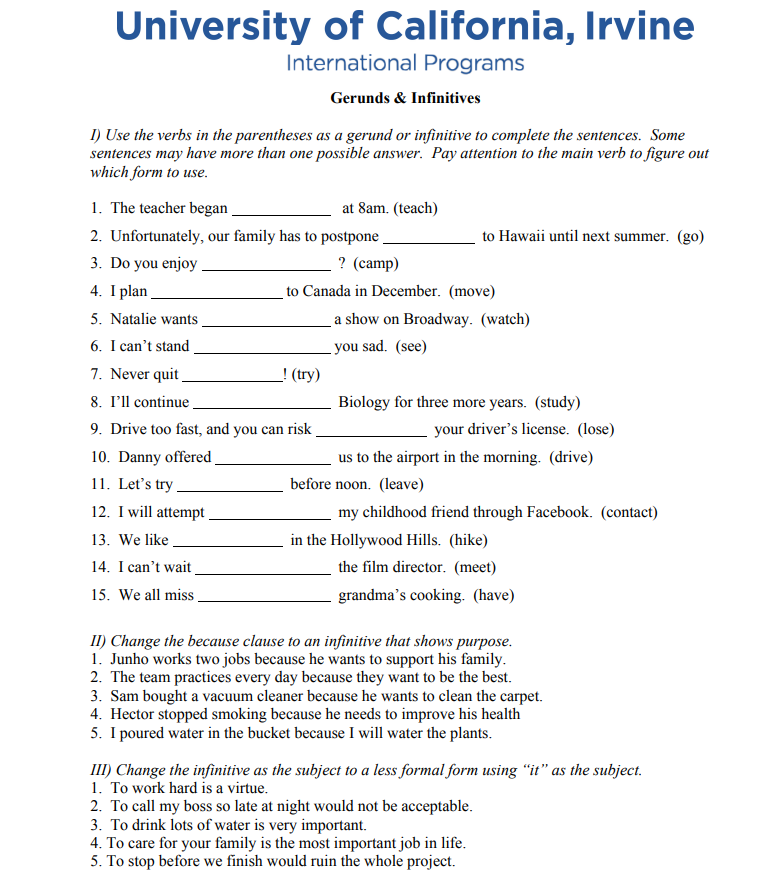
practice key
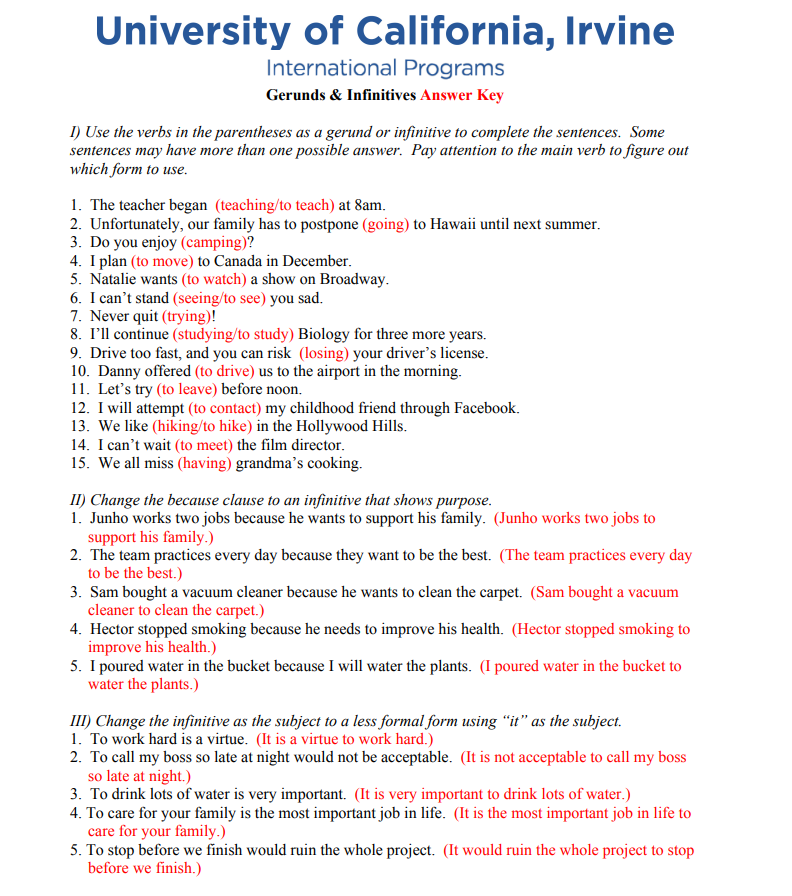
Gerunds and Infinitives Practice Quiz
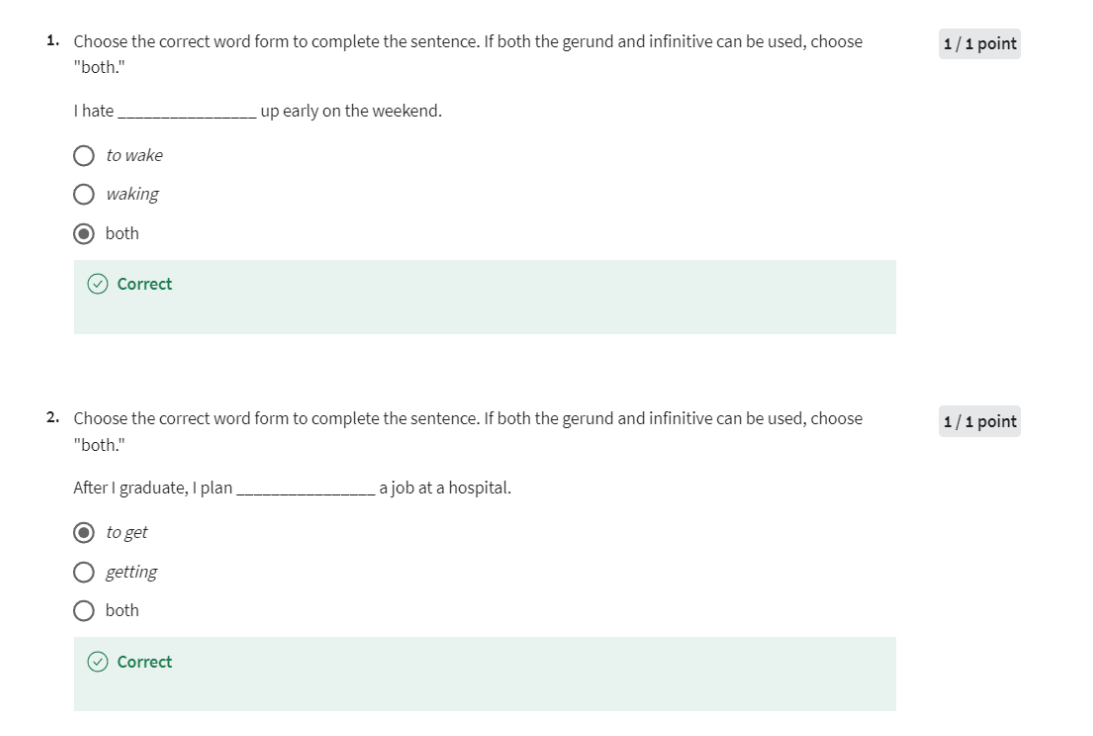
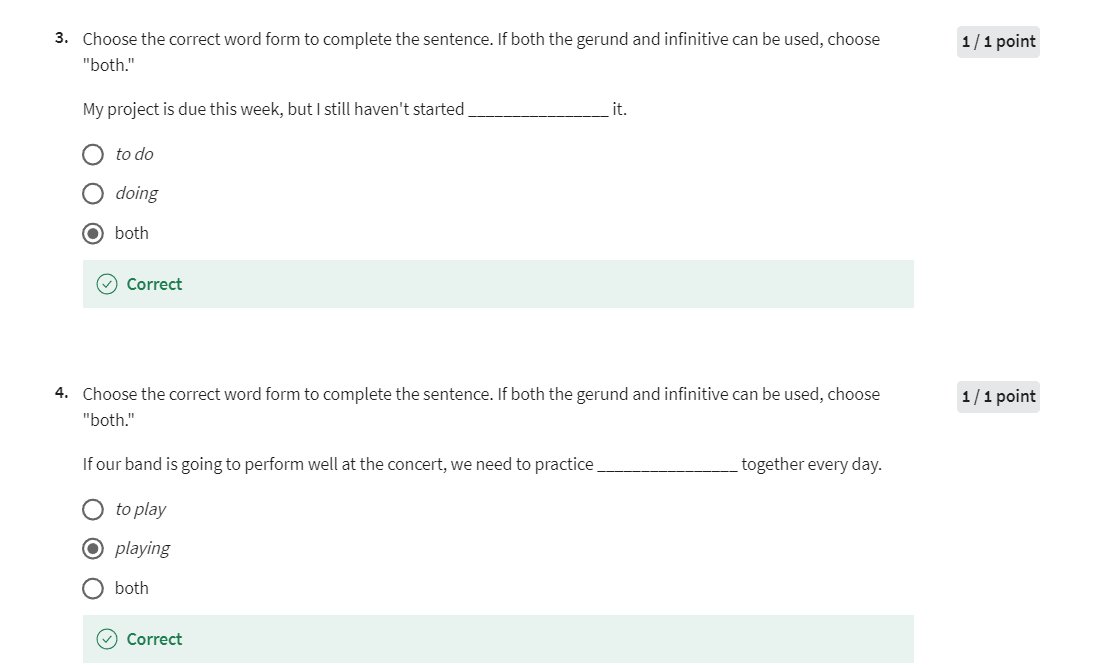
Requests and Permission Lecture
Welcome, and in this lesson, you will learn how to politely
make a request and ask permission. When making requests, you might say, would you close the door, or
would you mind closing the door? In these situations, the speaker wants
you to do something for him or her. When asking permission to do something, you might say may I borrow a pen,
or would you mind if I left early. In these situations,
the speaker wants to do something but is asking you to say okay or not.
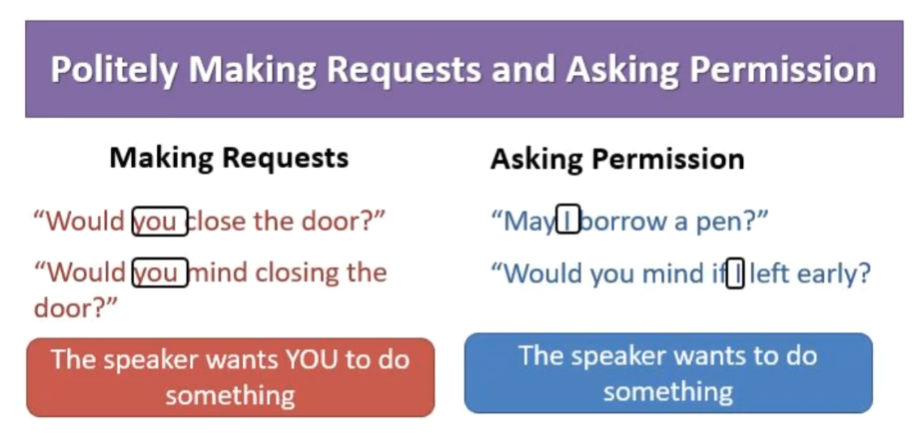
Let’s look at some other forms that
are also making request from you. Will you tell me your name? And could you spell that for me? When making request, you can use would
you, will you, could you, and can you. Then we add the main verb in
the simple form which means it doesn’t have S or ES,
ED, or ING on the end. Then add the object with
a question mark at the end that is how to make a polite request.
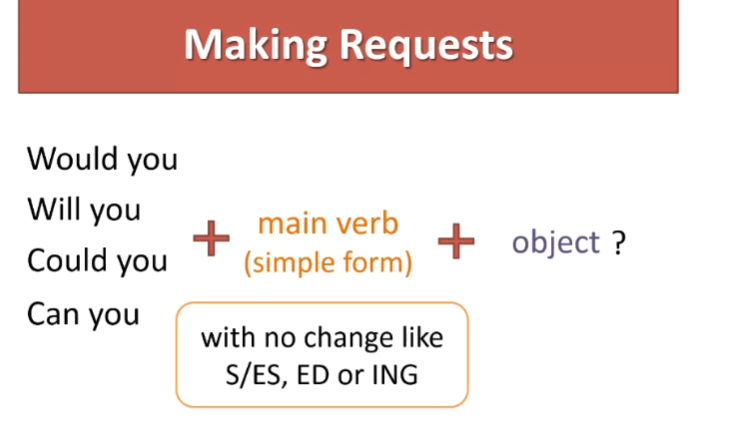
In these examples, the verbs are in the
simple form, close, tell, pass, and spell. Notice the verbs do not end with S,
ED, or ING. Then we need the object, what gets the
action of the verb and the question mark. The most polite question forms used
will be, would you, and will you. This is how you might request something
from a stranger, boss, or teacher. The less polite forms use could you and
can you. These forms you would use with friends and
family. You can also add please at
the end of your question.
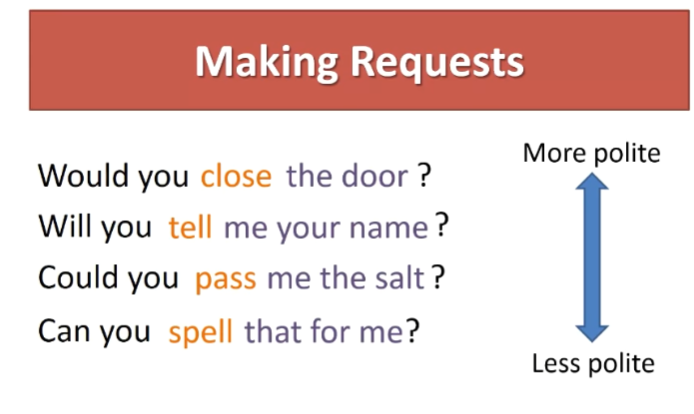
Please makes the question even more
polite, but it is not needed since would you, will you, could you, and
can you already make the question polite. Let’s look at possible answers to
these kinds of polite requests. If someone asks you, would you close
the door, you could answer, certainly. I’d be happy to. Of course. Sure, no problem. Less formally,
you could answer here you go. Or simply yes. If you refuse a request,
we often don’t simply say no, because it is considered rude and
impolite. Since we were asked politely,
we want to answer politely. So we can’t use no,
without more information. So, if you say no to a request,
follow it with I’m sorry or even better give a reason for
your refusal like no, I’m sorry but I can’t reach it. Or just a reason such
as I can’t right now. Another way to make a request is using
would you mind followed by the main verb in present participle, which is made
by adding ing to the end of the verb. And then the object of the verb and
the question mark.
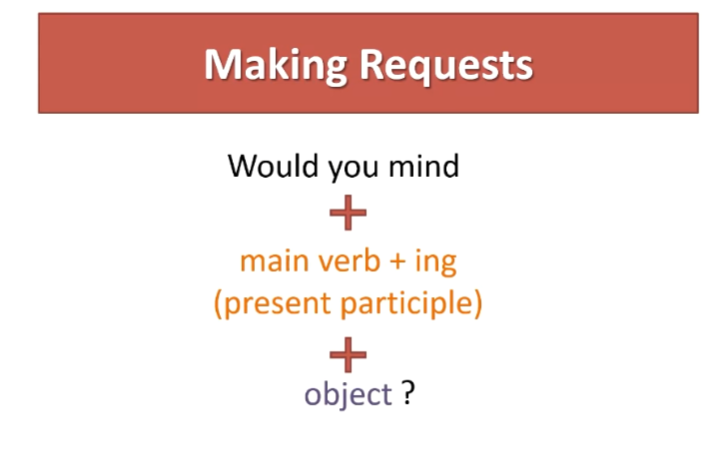
So for example, you could ask,
would you mind closing the door? And the possible answer is, certainly. Or, would you mind telling me your name,
could be answered with, I’d be happy to.
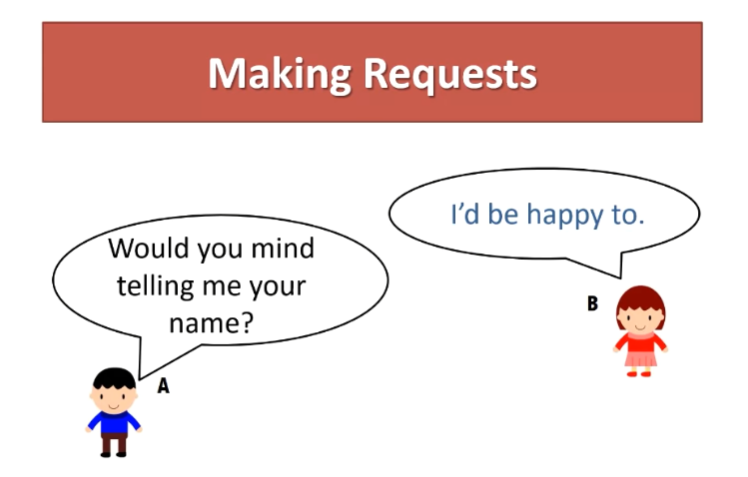
Or you could ask,
would you mind passing me the salt? And be refused for
instance, no, I’m sorry. Or would you mind spelling that for me? And be refused with, sorry, I can’t.
Now, let’s look again at the polite
way for asking permission. When politely asking for
permission we use these forms, may I, could I, can I, with the main
verb in the simple form again, followed by the object and
the question mark.
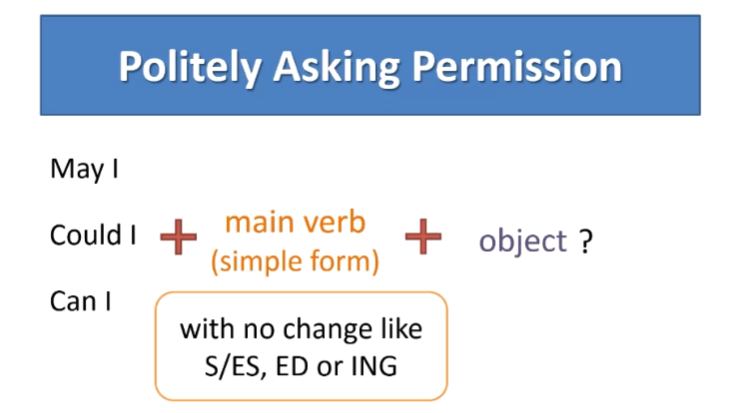
In these examples, the verbs in the simple
form are borrow, have, and open. Notice that the verbs do not end in s,
ed, or ing. Then we have the object what gets the
action of the verb and the question mark. The most polite question
forms are may I and could I. The less polite form is can I.
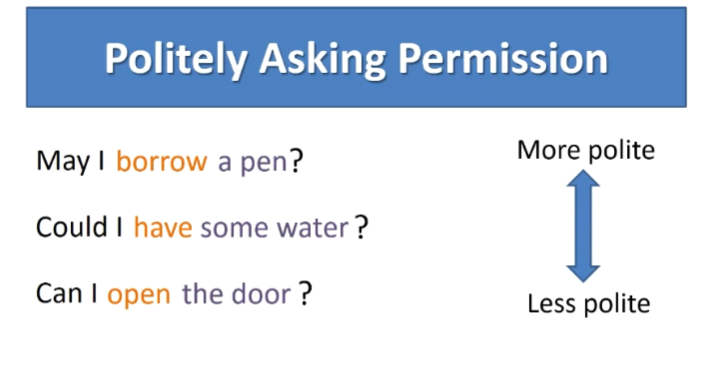
So for any of these requests for permission we could answer
positively by saying certainly. Or of course. Also, sure, no problem. And here you go, or a simple yes, but again if you are refusing your permission,
then no is considered rude and impolite. So we like to say, no, I’m sorry. Or not right now, sorry. Or give a reason why we cannot help. Such as, I don’t have one.
Another way we could ask permission
is by using, would you mind if. Followed by the main verb in the simple
past form either with ed ending or irregular past form,
followed by the object and question mark.
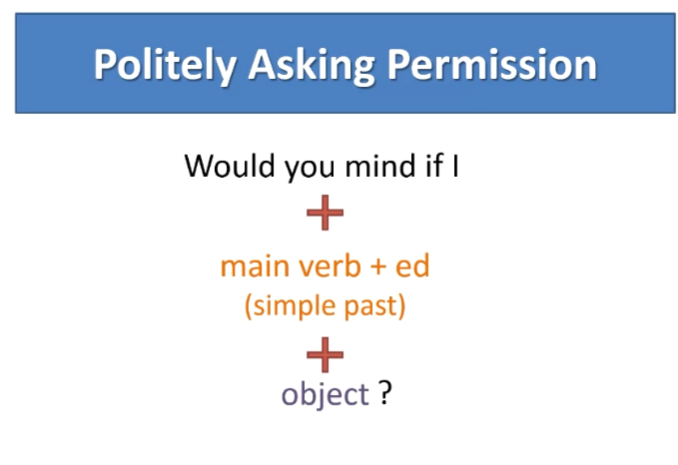
If you asked,
would you mind if I left early, you might get a response such as,
not at all.
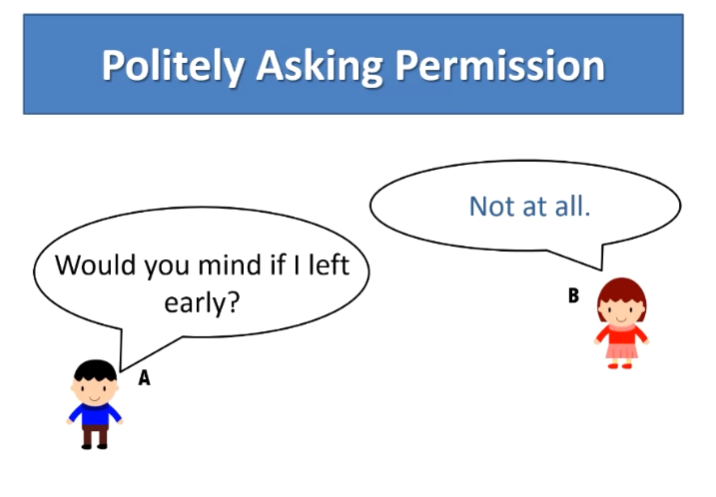
Or would you mind if I made a call? And here, no, of course not.
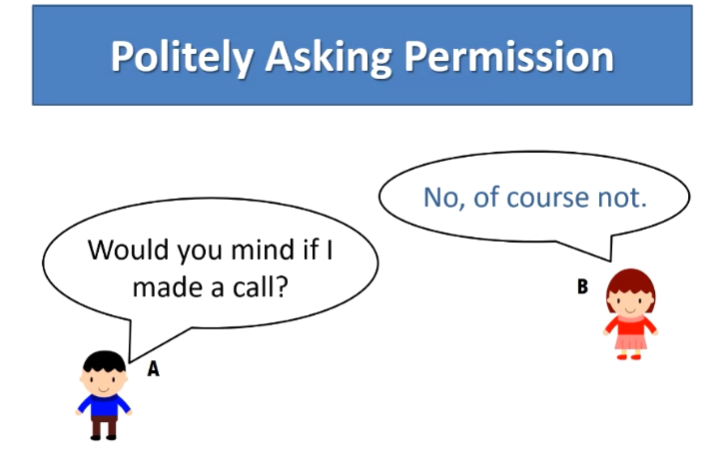
Would you mind if I asked a question might
be answered with no, that would be fine.
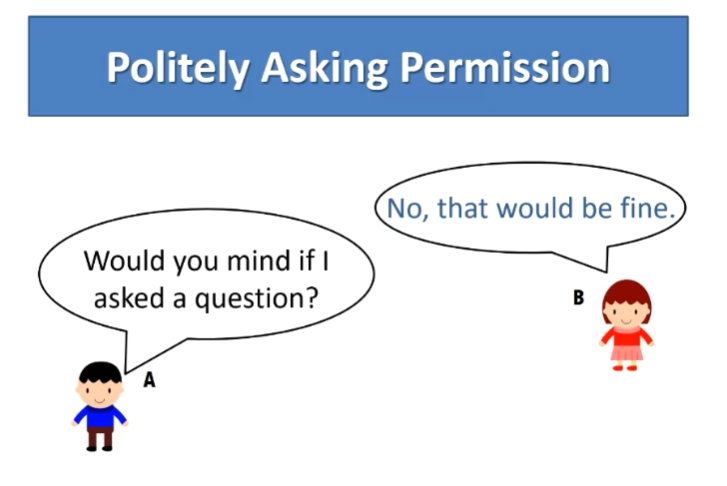
But if you ask would you
mind if I closed the door? And someone doesn’t want you to, you might
get the answer I would prefer you didn’t.
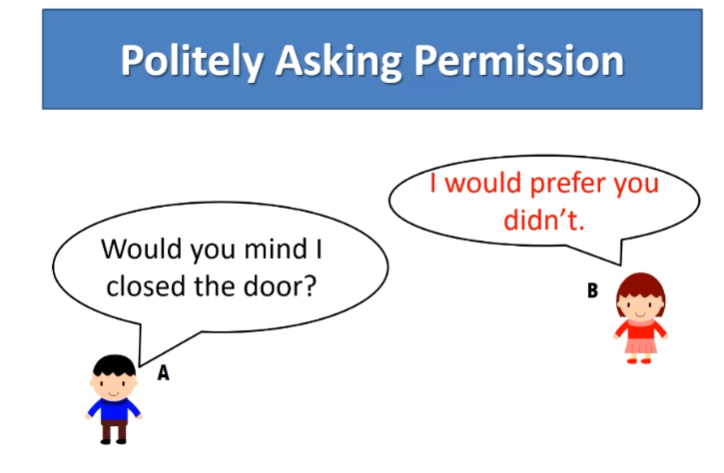
Or would you mind if I
borrowed your phone? But the person you’re asking refuses,
he or she may answer, I would rather you didn’t. But if you ask,
would you mind if I turned off the light? And answer such as yes, I do,
is to direct and considered impolite. So we don’t like to use it.
Here is a special note about
answering would you mind questions. The answer often confuses
learners of English, but remember would you mind means
does it bother or annoy you? So if you answer positively, your
answer means no, it doesn’t bother me. But if you answer negatively,
it means yes, it bothers me. In this lesson, you learned how
to politely make a request and ask permission.
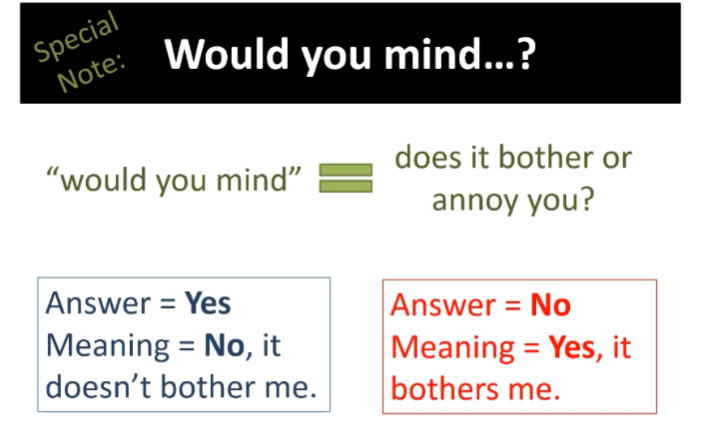
Requests and Permission Practice Quiz
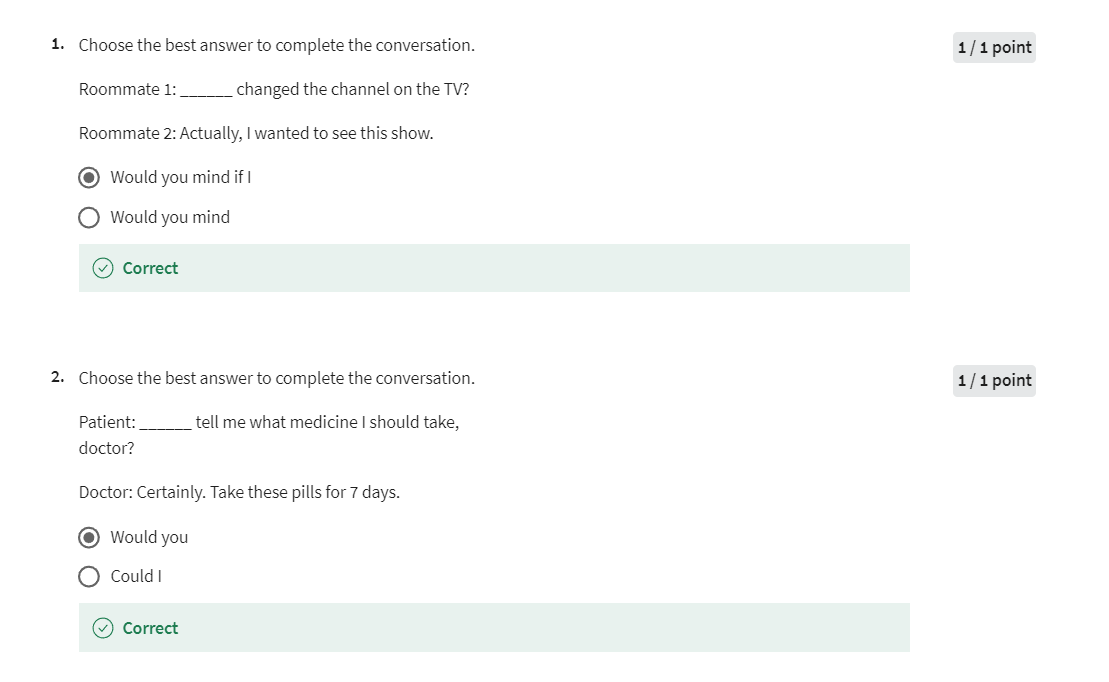
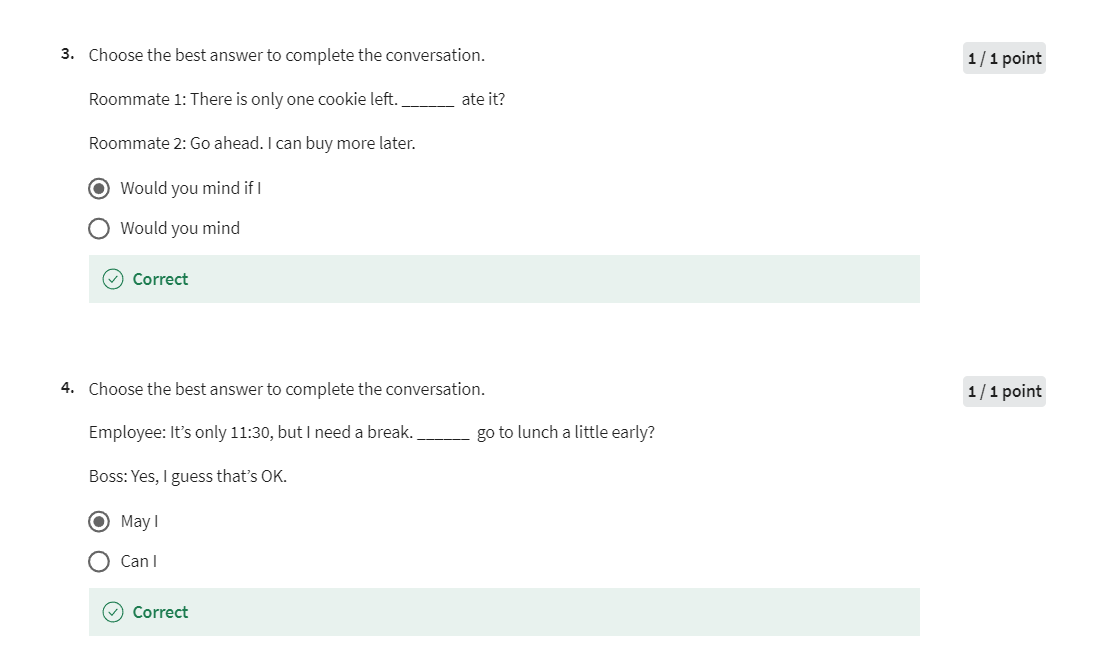
Requests and Permission Practice
Practice
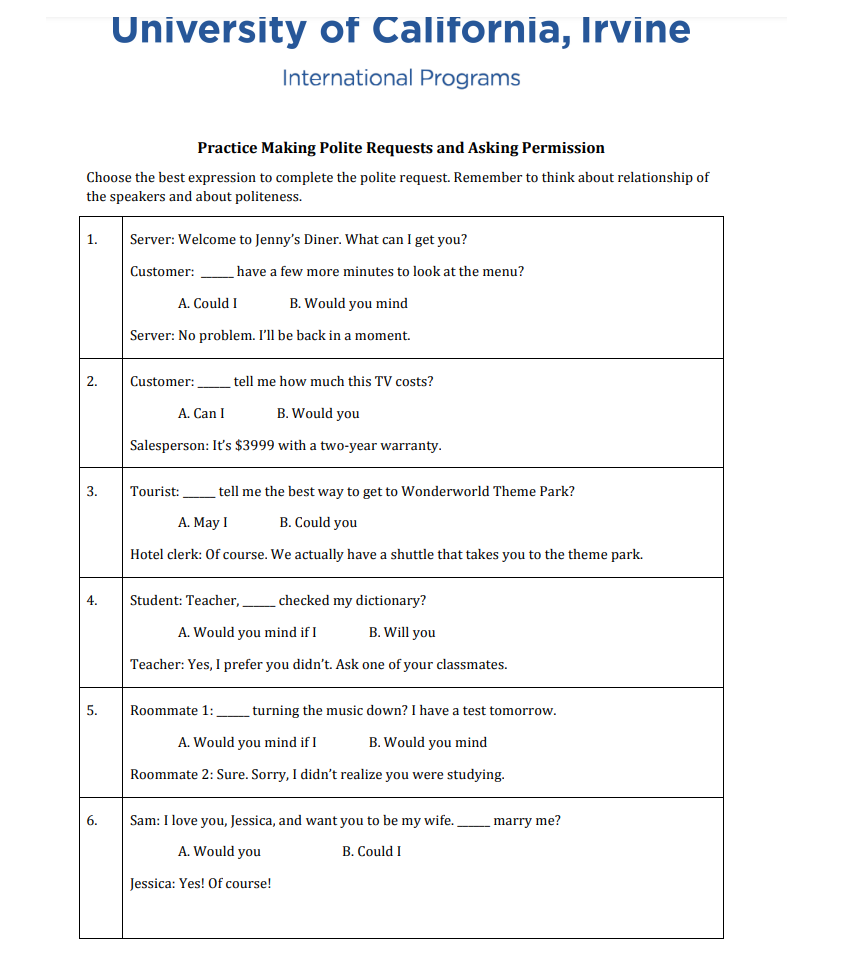
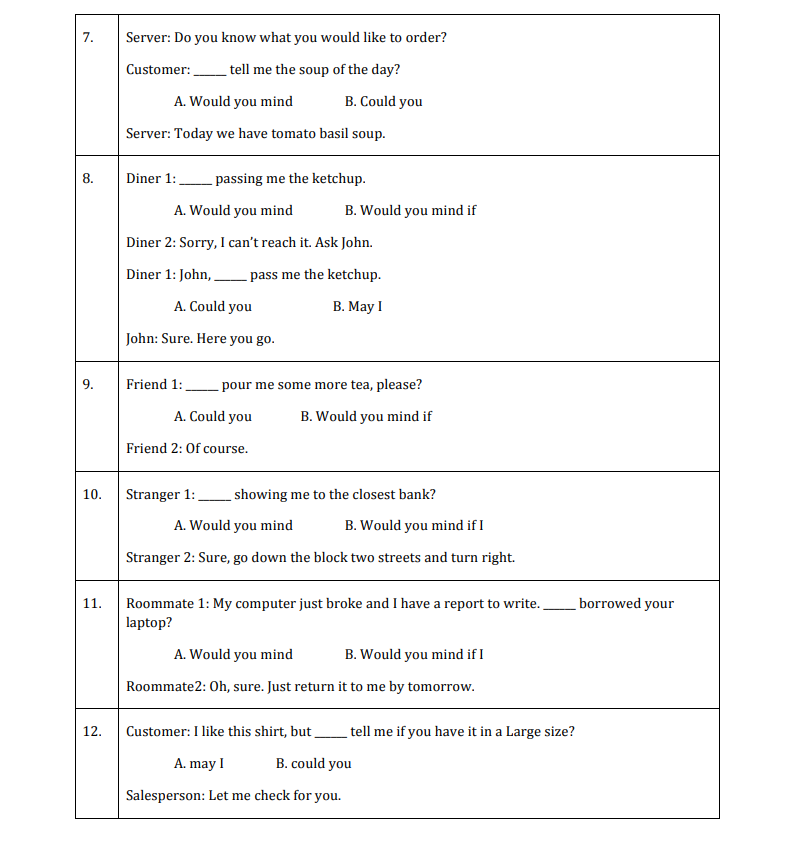
Practice key
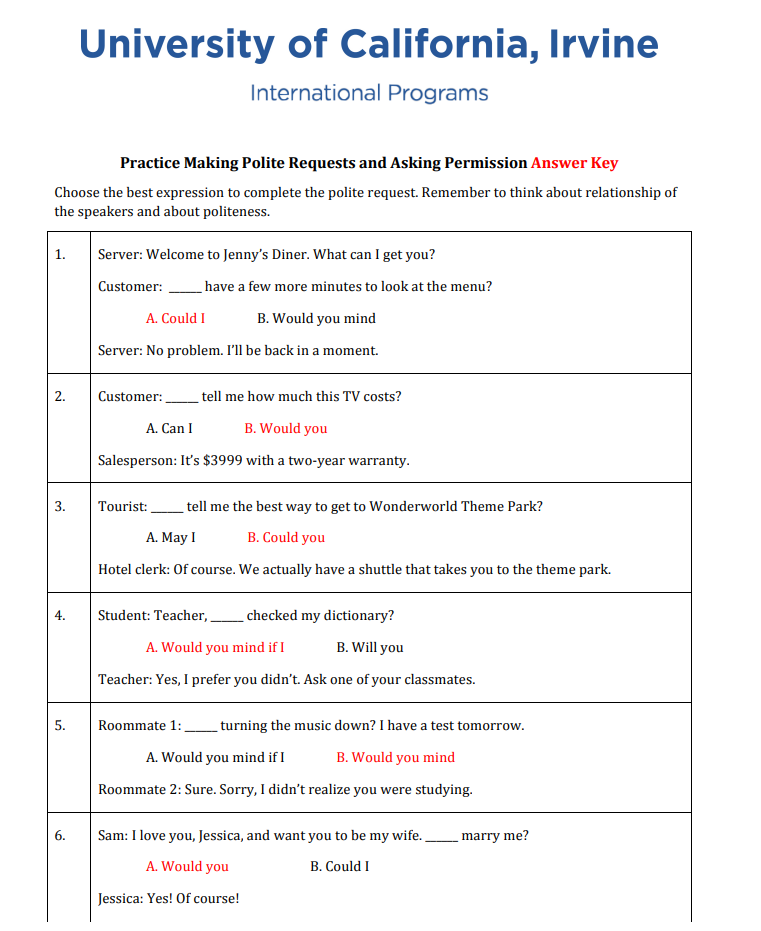
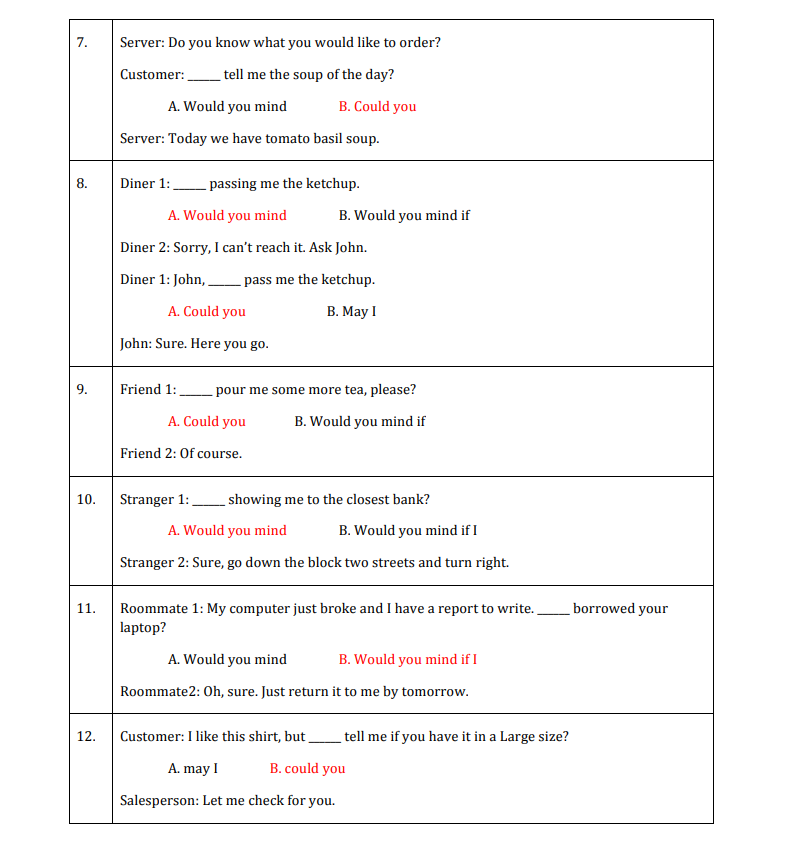
Graded Assignment: Gerunds, Infinitives, Requests, and Permission Assignment
Write a dialogue using lots of gerunds and infinitives. Include several requests or questions asking for permission. Use a minimum of 3 gerunds, 3 infinitives, and 3 requests or questions asking permission.
Example:
Paul: My dad wants me to mow the lawn, but doing chores does not sound fun to me.
Adam: Mowing the lawn isn’t bad. My dad needs me to help clean the garage.
Paul: Maybe we should do something fun when we get finished. Can I stop by your house when I’m finished mowing?
Adam: Yes, I’ll be there, but the cleaning may still be going on. If it is, would you keep me company?
Paul: Of course. I can even help you. Could you tell me how to get to your house again?
Adam: Sure. You can just take the #5 bus to get to my place. Taking the bus is the easiest way to get there.
Paul: Remember, I am going camping next weekend. Can I borrow your tent?
Adam: Yes, definitely.
My try
Emma: I’m thinking about going hiking this weekend. Do you want to come along?
Jake: Hiking sounds like fun, but I need to finish writing my essay for English class. Would you mind waiting until I finish?
Emma: No problem. While you’re writing, I’ll be watching a movie. Would you like to join me when you’re done?
Jake: Thanks for the invite. I’d love to watch a movie with you. Can I bring some snacks?
Emma: Absolutely! Bringing snacks is always a good idea. Could you also bring your laptop so we can stream the movie?
Jake: Sure thing. I’ll grab my laptop, and we can decide on a movie together. Should we watch a comedy or a thriller?
Emma: Hmm, let’s go with a comedy. Laughing is the best way to unwind after a long day. Would you mind checking if the movie we want to watch is available online?
Jake: Not at all. Checking the availability online will only take a minute.
Graded Quiz
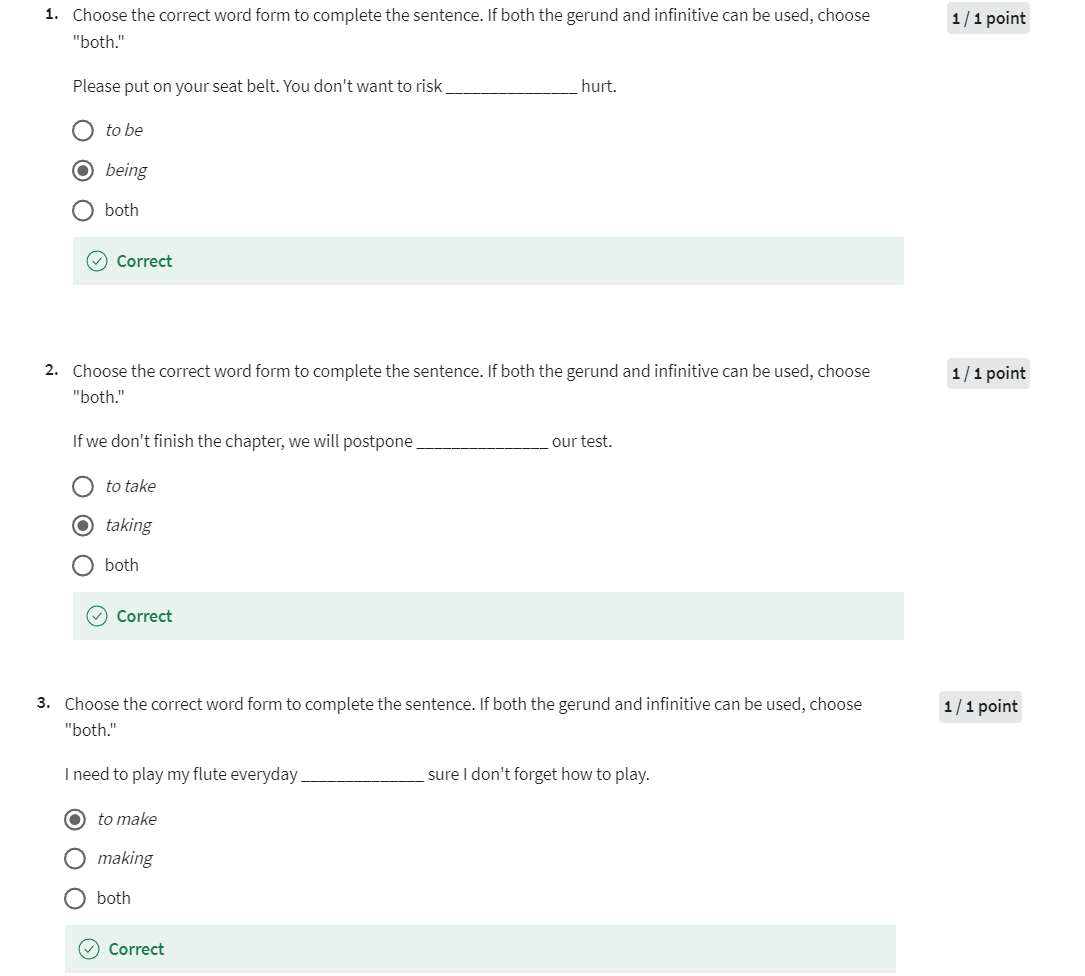
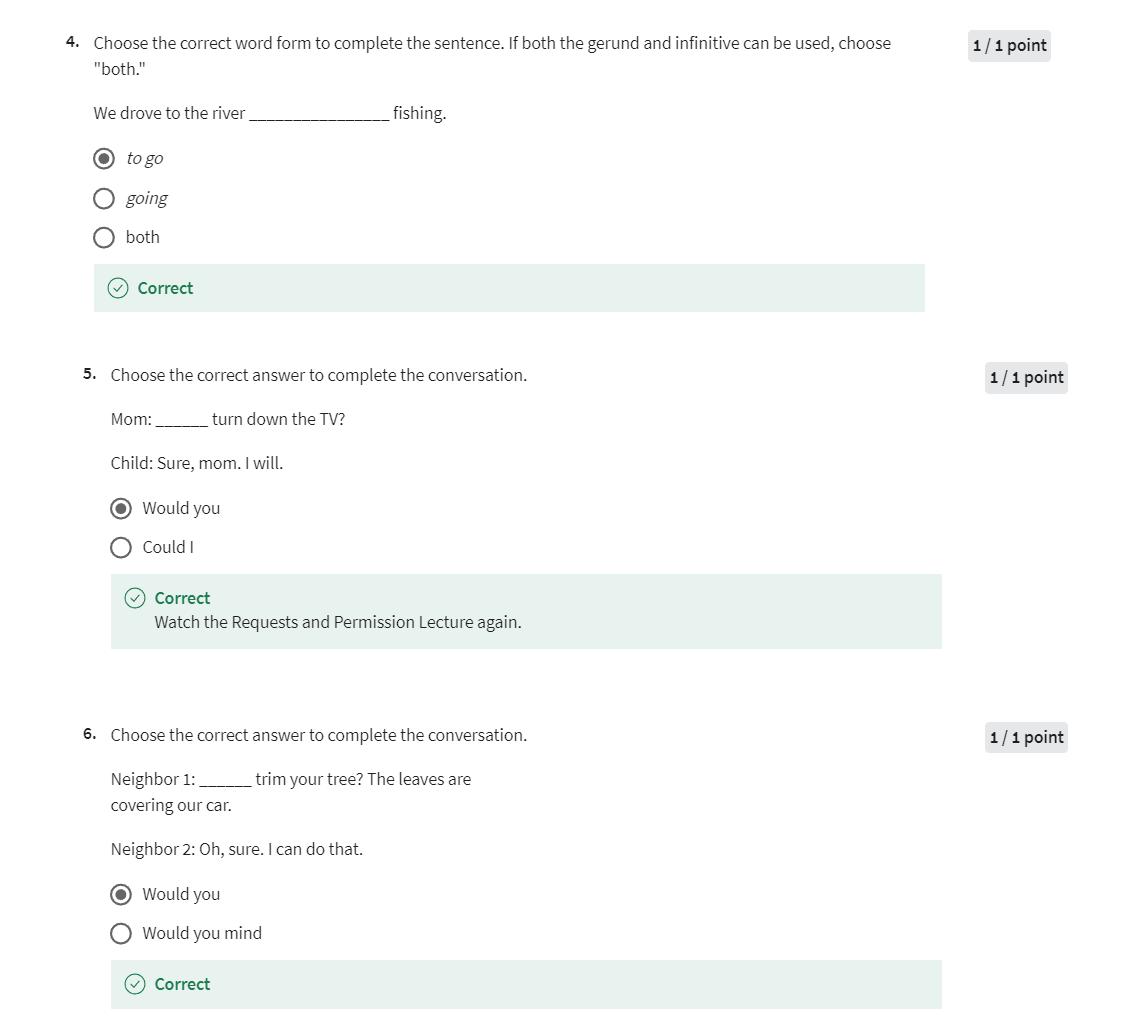
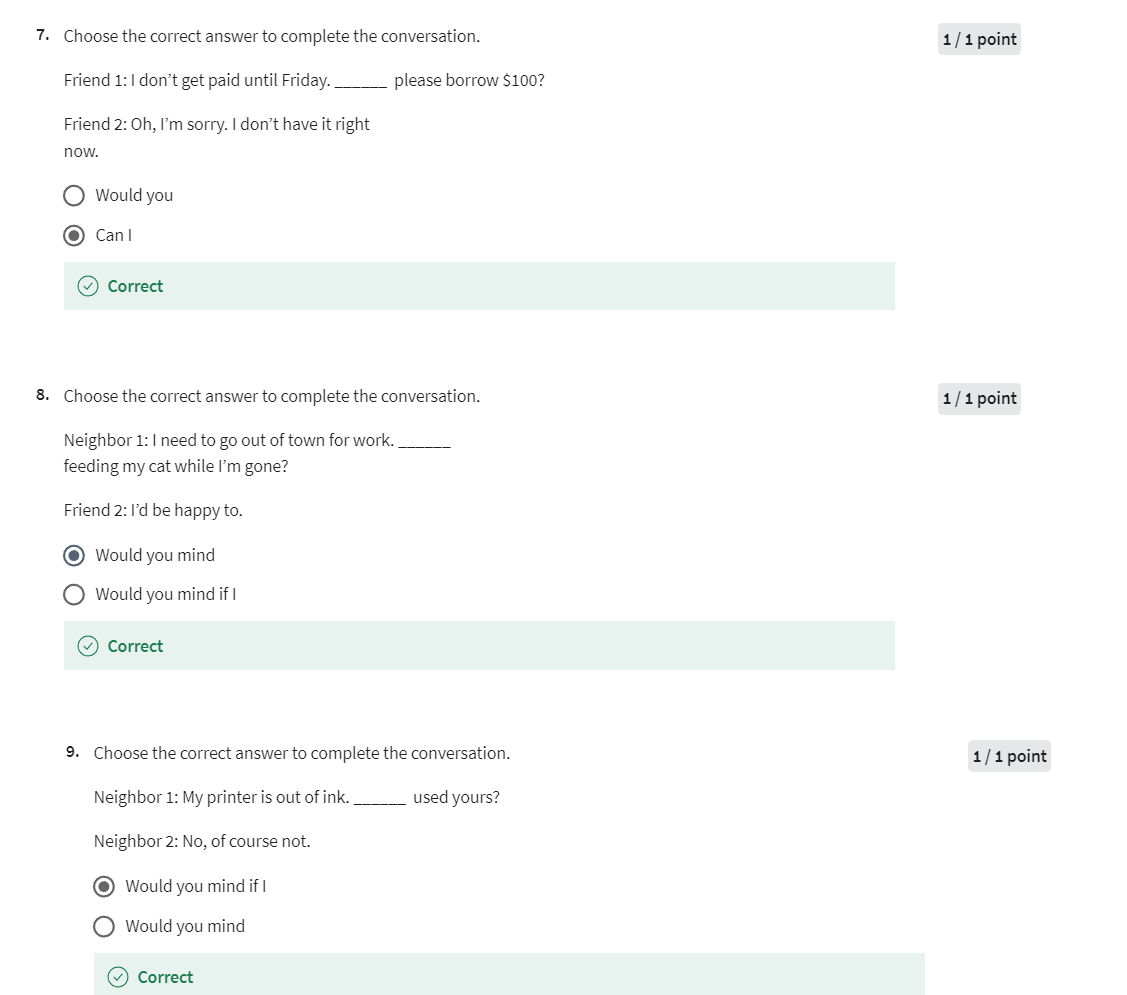
Week 03: Confusing Word Forms
You’ve learned about some tricky grammar, but there are other things that make English hard to learn. This week, you’ll learn about some word forms that cause confusion. You’ll soon understand the difference between some pairs of words that always seem tricky.
Learning Objectives
- • put multiple pronouns in the correct order
- • use possessive pronouns correctly
- • use reflexive pronouns correctly
- • use indefinite pronouns correctly
- • use some confusing adjectives and adverbs correctly
- • use several pairs of confusing nouns and verbs correctly
- • use some tricky prepositions correctly in sentences
- • put prepositional phrases in the correct places in sentences
Confusing Pronouns Lecture
Confusing Pronouns. What are pronouns? Pronouns are words that replace or
refer to nouns. For instance, we can say,
Maria is a veterinarian. Maria is an animal doctor. But instead of saying Maria twice,
which is repetitive, we can say She. She is an animal doctor and
she refers to Maria. This is just one type of pronoun.
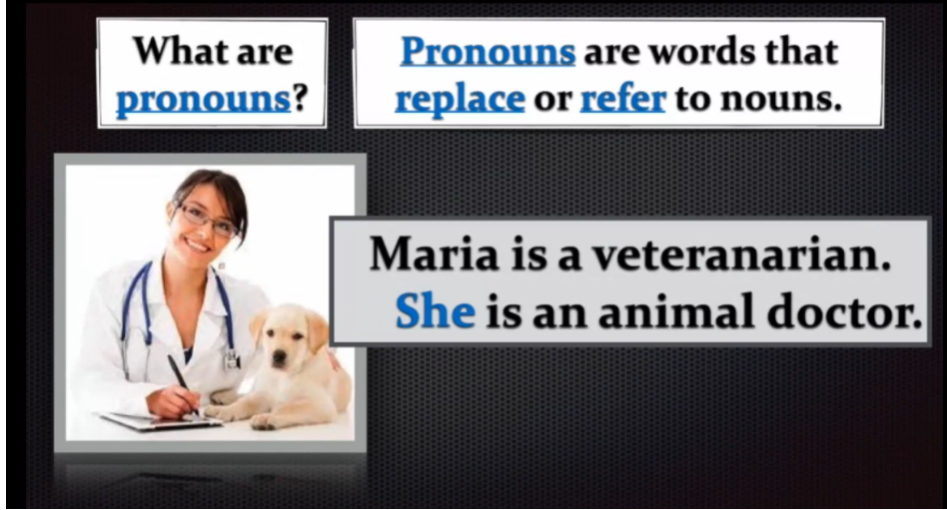
There are many different types of
pronouns that you’ve learned or will continue to learn. But in this video,
let’s focus on four of them. Beginning with personal pronouns. You can have subject or
object Personal Pronouns. These are pronouns you’re probably
familiar with already, but they can be a little tricky to
use when you have compound or combined use of pronouns with other nouns. Such as I with Ann or me with Ann. Let’s look at some examples. Which sentences are correct? I and Ann are good friends. Ann and and I are good friends. You know Ann and me. You know me and Ann. Ann and I is the correct order,
not I and Ann. Also, Ann and me, not me and Ann. This is easy to remember. It’s more polite to put
yourself after others.
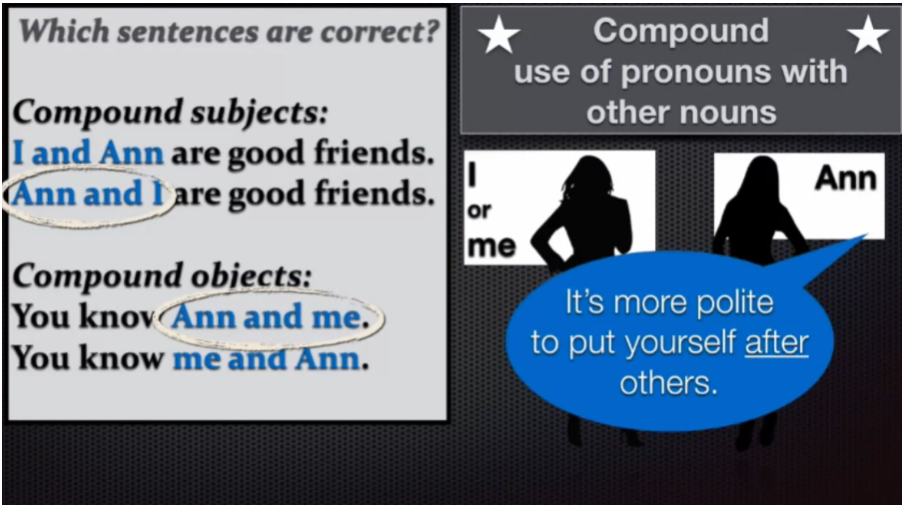
Also, if you have more nouns,
it’s the same thing. You would say, Thomas, Ann, and I are good friends, and you know,
Thomas, Ann, and me. Now let’s move on to Possessive
adjectives and Possessive Pronouns. You know all of these words, I’m sure, but
do you know the difference between using the adjective form and pronouns such
as the difference between my and mine? Let’s look at an example. This is my company. My is an adjective form,
it describes company. This company is mine. Mine is a pronoun, so it replaces a noun. It acts as the noun.
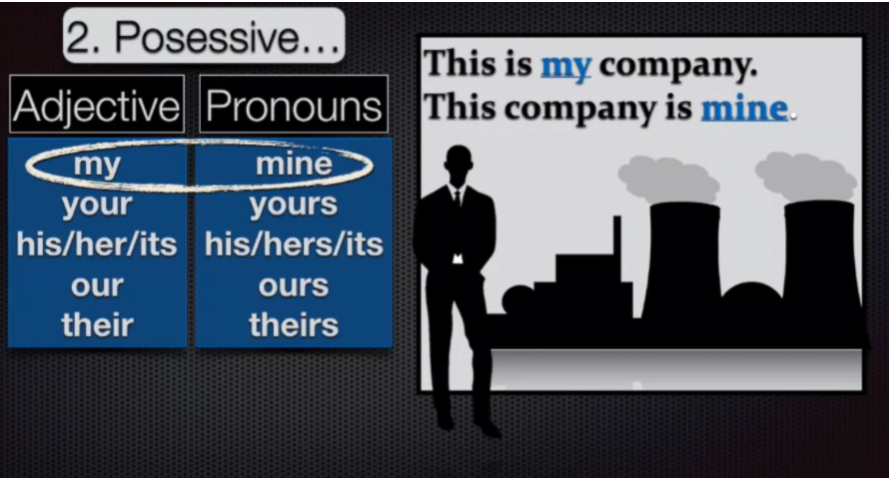
In this list are words that can be
easily confused with contractions. Those include your, its, and their. You must be very careful with these words
but let’s practice, starting with your. We’re going to fill in
these sentences using your, the Possessive Adjective, and you’re
the contraction which means you are for the first sentence,
you want to use the Possessive Adjective. Your flight leaves at 3PM. For the second sentence,
you want to use the contraction. You’re leaving at 3PM
which means the same as, you are leaving at 3PM.
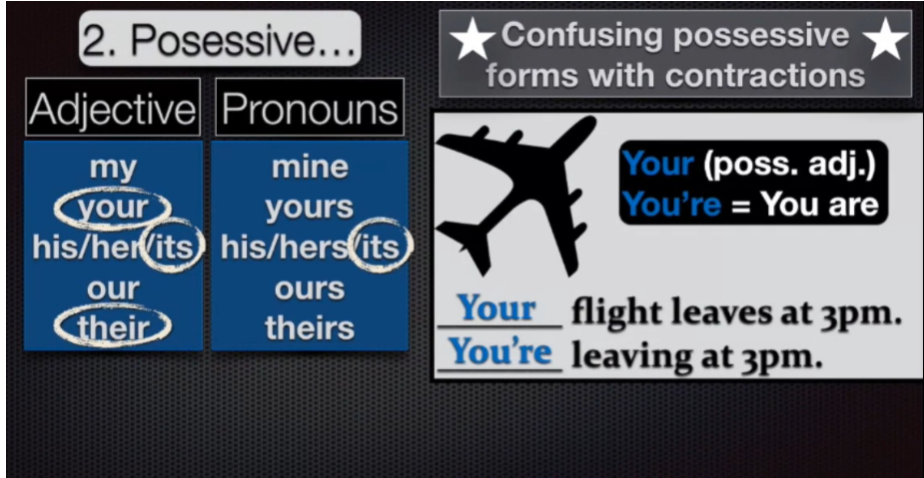
Now let’s practice using its. Here are two sentences
about the Eiffel Tower. Use it’s the possessive adjective or
pronoun and it’s the contraction, which means it is. For the first sentence,
we want to use the contraction. It’s called the Eiffel Tower,
which means the same as it is called. The Eiffel Tower. For the second sentence,
we want to use the possessive adjective. Its total height is 1063 feet, great!
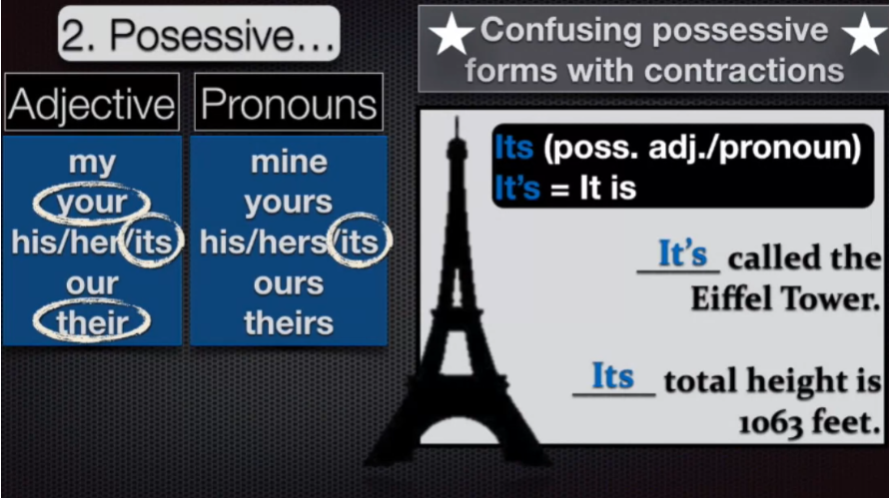
Now the third word is their. Their as a possessive adjective
Is pronounced the same way as the contraction they are,
as well as the adverb their. See, if you can finish these
sentences using the correct forms. For the first sentence,
you would use the adverb. There are some cats outside. For the second sentence,
we need a subject and verb. They’re Mrs. Porter’s cats. They are Mrs.Porter’s cats. For the third sentence,
we need to use the Possessive Adjective. Their owner is Mrs. Porter. Nice job.
Let’s move on to talk
about Reflexive Pronouns. Reflexive Pronouns end in self and
selves, and they refer back to
the subject of a sentence. The Reflexive Pronouns are sometimes
incorrectly used as subjects. Let’s look at some examples
of how they can be used and how they should not be used. He helped himself to the drinks. In the first sentence, himself is
the direct object of the verb helped and himself refers back to he, the subject. In the second sentence,
himself is the indirect object. Drink is the direct object and
himself refers back to the subject he. In the third sentence, himself is
a part of a prepositional phrase. For himself. He made a drink for himself. And again,
himself refers back to the subject he. In the last sentence,
himself is used incorrectly. You may not say himself made a drink. Instead, simply use the pronoun he. He made a drink, great!
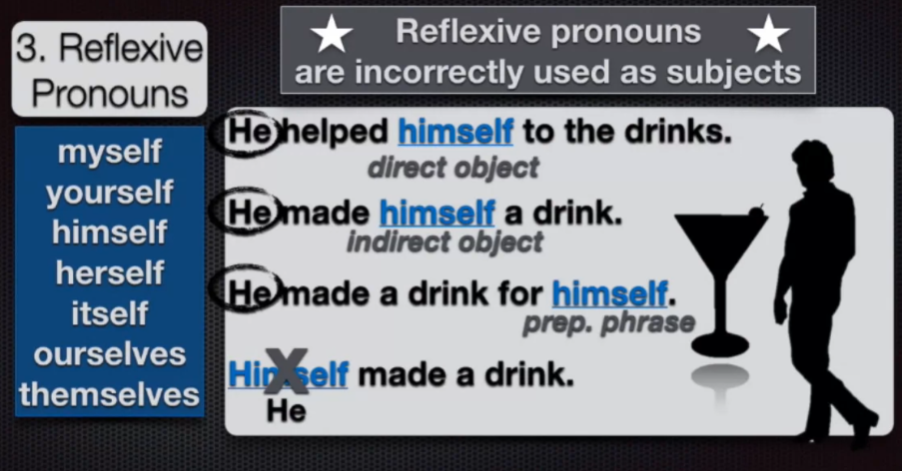
Let’s look at one more example. Cindy taught how to play guitar. Cindy taught whom? Well, Cindy taught herself
how to play guitar. You would add the reflexive
pronoun after the verb because herself is being used as
the direct object of the sentence. This sentence tells us that Cindy
taught herself, no one else taught her.
Okay, now let’s move
onto Indefinite Pronouns. Indefinite Pronouns do not
refer to a specific thing. Here’s some examples. These words can be difficult to use, if you do not know whether
they are singular or plural. Another, everyone, somebody, and anything
are singular and definite pronouns. Another is preferred. Everyone is here now. Somebody is at the door. Anything is okay. Many Is a plural indefinite pronoun. You would say, many are late. And none is a special pronoun because
it can be singular or plural. You can say none is ready or
none are ready
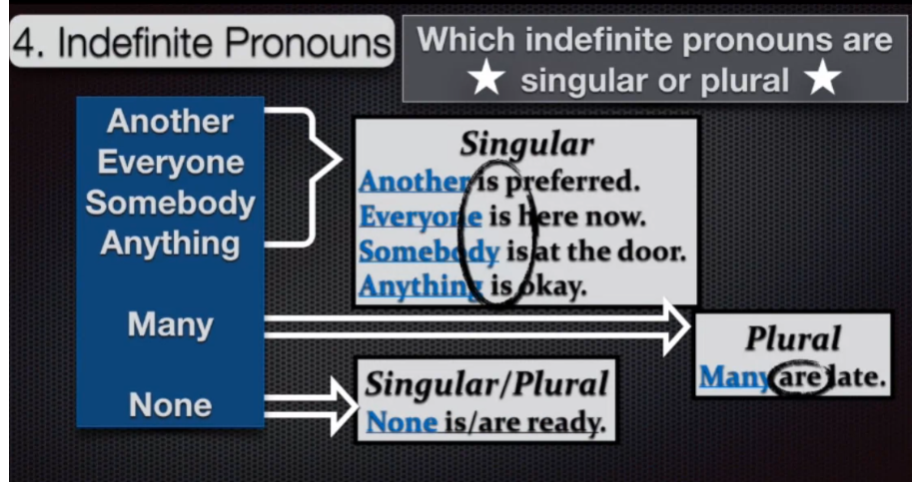
Here’s some more indefinite pronouns. These are all singular pronouns. And here is a shorter
list of plural pronouns. I want to focus on three words either,
neither, and both. These words can only be used
when describing two things. For instance either is perfect for
sailing. Neither is good for fishing. Both are great for sailing.
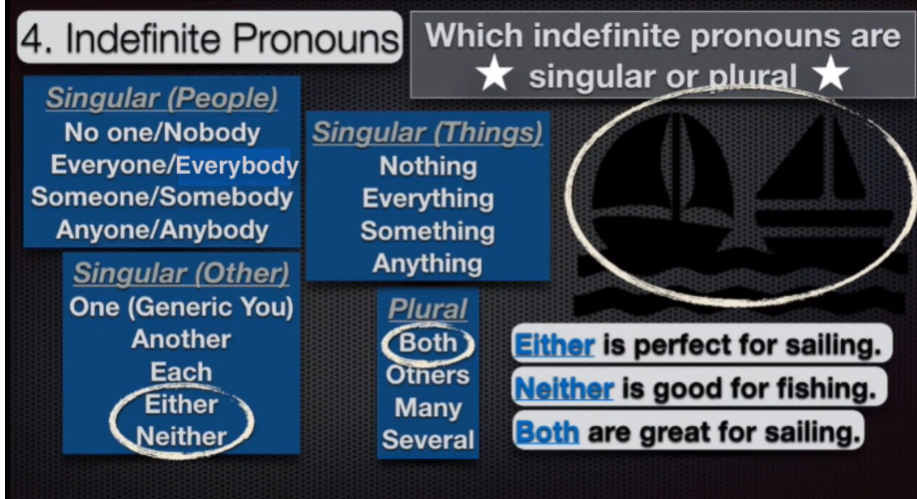
Now let’s talk about those
special indefinite pronouns that can be used as either singular or
plural pronouns. We’ve looked at none,
now let’s look at some. Some are ready to hatch,
when referring to a count noun, like eggs, you would use are. Some are ready to hatch. But in the case of tea,
which is a non-count noun, then it would be appropriate to use is. Some is being brewed, great! We’ve looked at lots of
different types of pronouns. The best thing to do now
is to keep practicing. Thanks for watching.
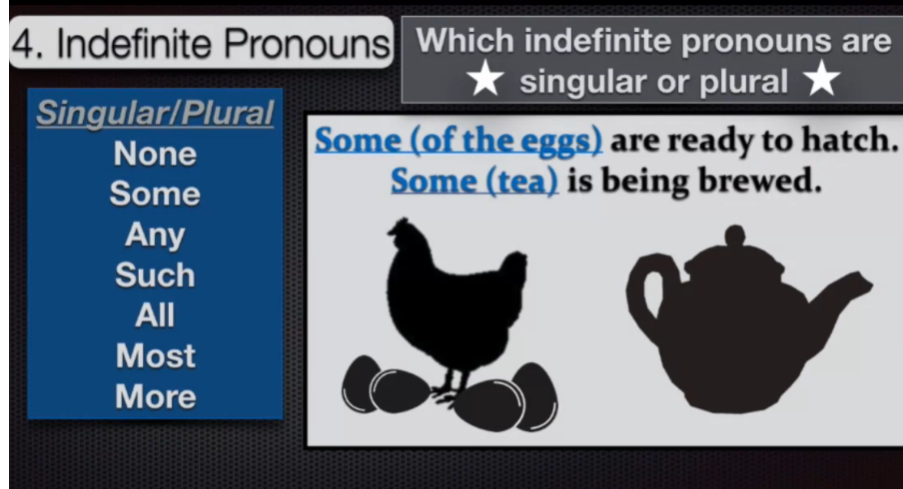
Confusing Pronouns Practice Quiz
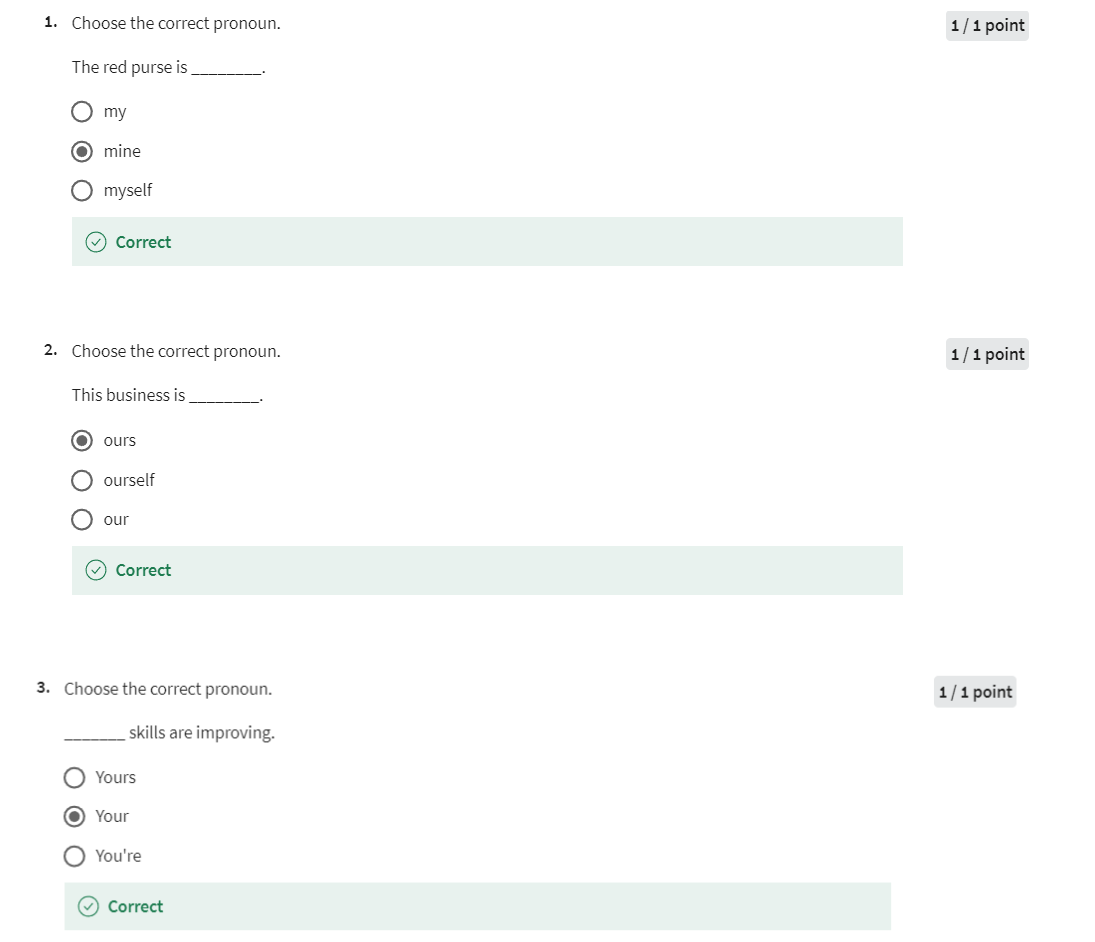
Confusing Pronouns Practice
Practice
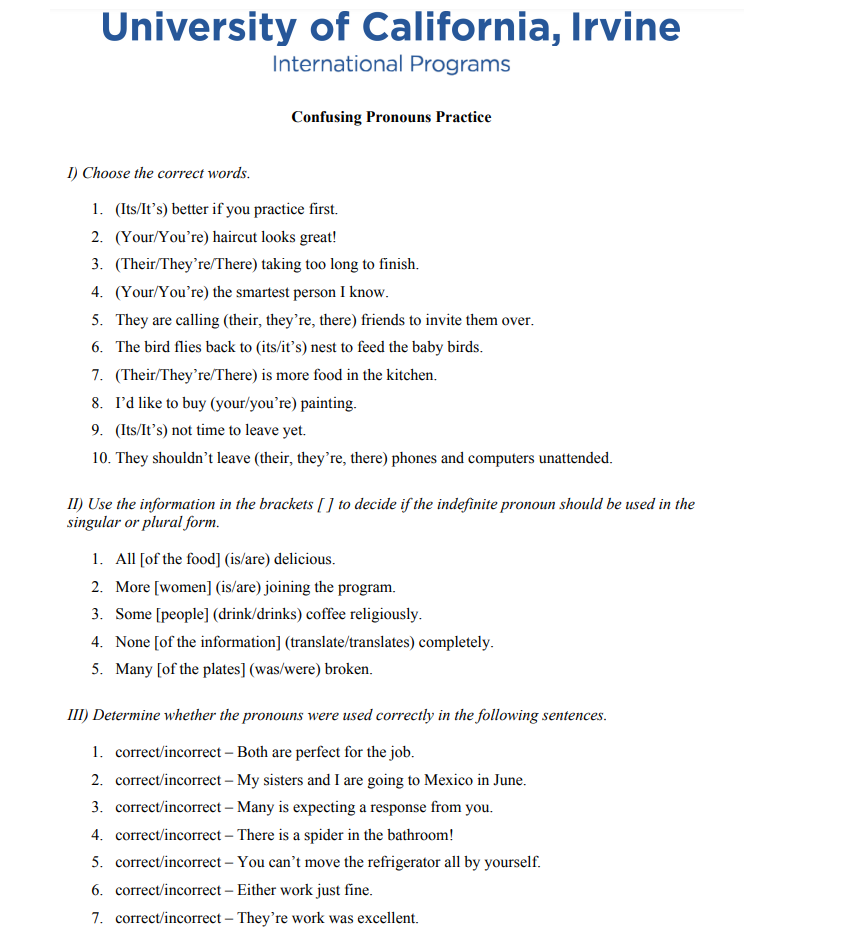
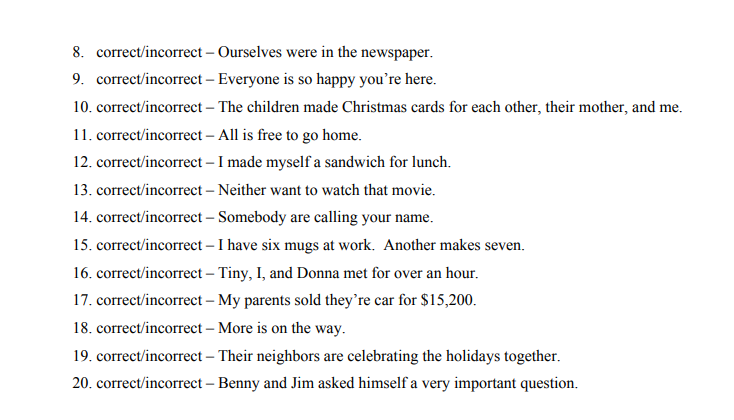
Practice Key
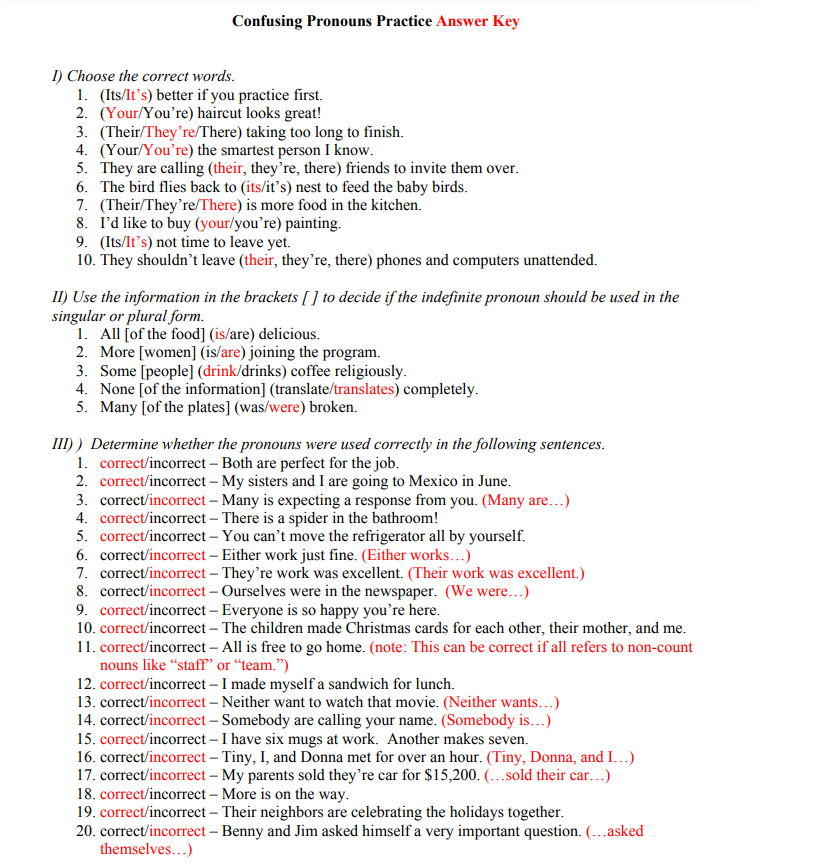
Confusing Adjectives and Adverbs Part 1 Lecture
Hi and welcome to confusing adjectives and
adverbs. In this lesson, we will discuss adjectives
and adverbs that are similar in meaning. So let’s look at some adjectives and
adverbs that are similar in meaning, but are used differently in English.
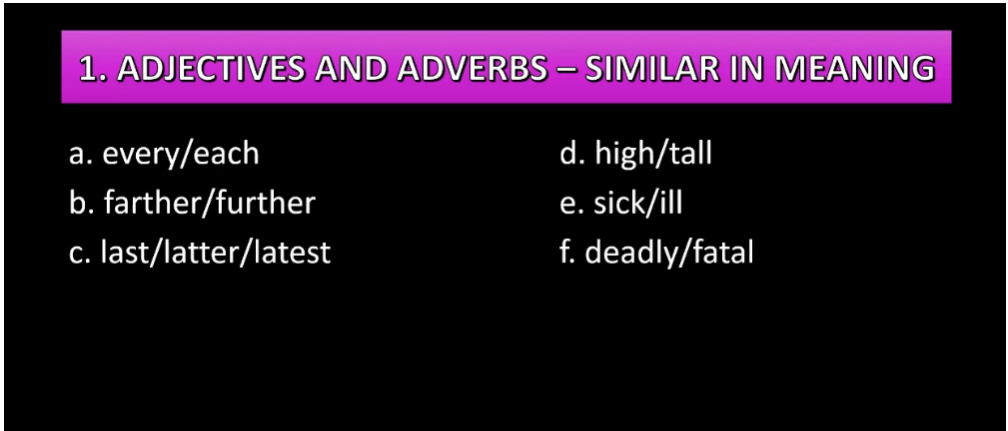
So first, let’s look at every and each. Every is an adjective used when
the focus is on the larger group while each is actually a determiner
that focuses on individual items or people, both words go single
count nouns and singular verbs.
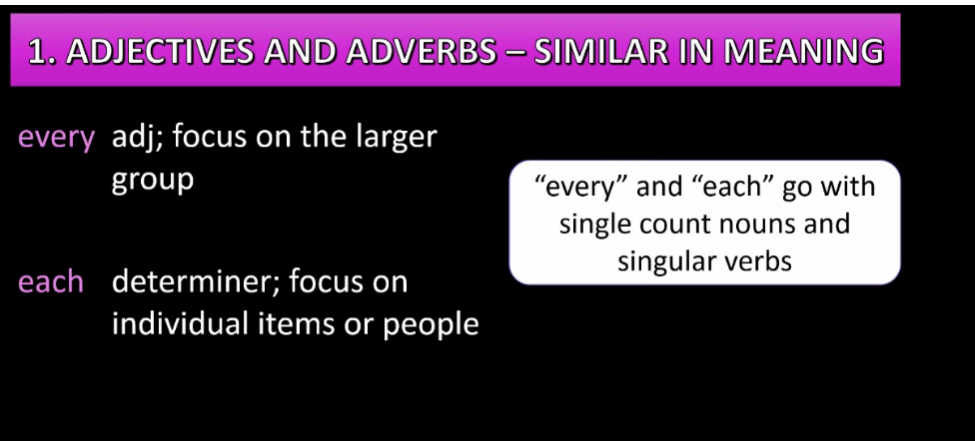
So for example, every student purchased
a textbook focuses on the whole class of students purchased a textbook. With each, we could say, it is important to read each
question on the test carefully. Emphasizing each single question must be
read carefully none should be skipped. So, what do you want to focus on? The group or the individual? That is up to you when you are speaking or
writing, just keep in mind that every emphasizes the whole group and
each emphasizes the individual. Also remember that when you use each and
every, you need to follow it with a singular
count noun and singular verb.
Farther and further are another
pair of confusing adverbs. Farther comes from the word far meaning
a long distance, but further relates to non-physical distance, either metaphorical
or figurative type of language.
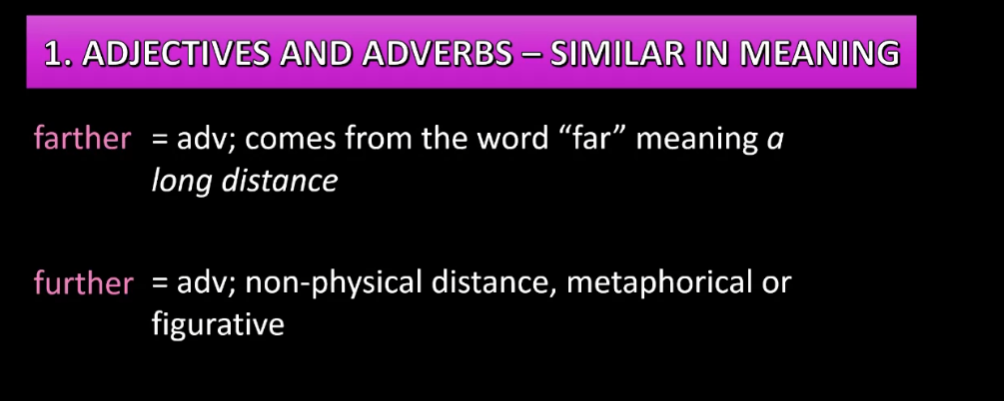
With farther, we can have a sentence
a plane can travel farther than a car. Meaning, a plane travels more
distance than a car can. But with further as in if
you have further questions, email them to me is more figurative. Meaning, more questions
not physical distance. So, which one do you use if you
aren’t sure whether you are talking about distance or not?
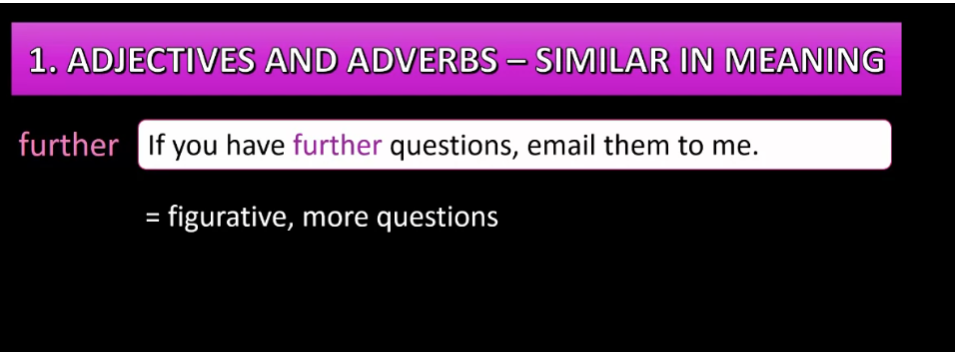
In this sentence, my friend is
farther along in the book than I am. We need to ask ourselves can we use
distance to describe the pages in a book? Or is it, my friend is further
along in the book than I am. We ask, do we mean the number
of pages in a figurative sense? When you aren’t sure,
further is safer to use in these cases.
Here are three adjectives that
are related, but are different in meaning. Last means most recent in the past or
could mean the opposite of first when there
are several things happening, but latter means the opposite
of former when you have a choice between things and
latest means recent or newest.
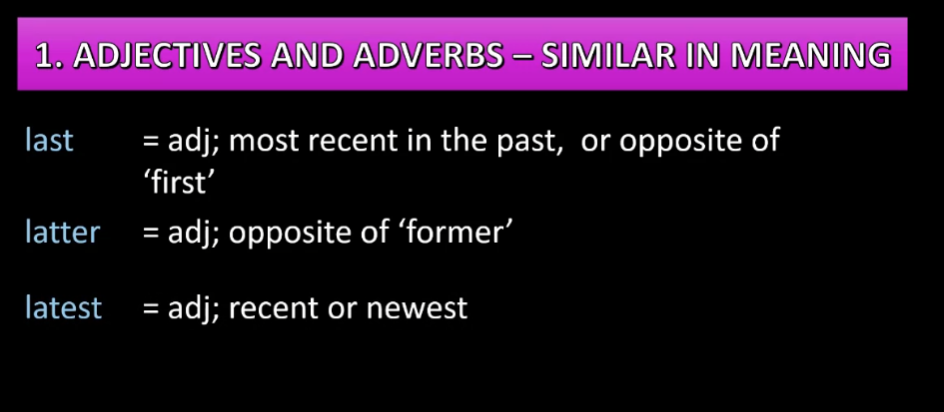
With last, we can say,
last night I went to an interesting lecture about the future of biotechnology. Meaning, the most recent past night or
when we have a list of things. First, I need to go to the store. Then, I have to to pick
up my dry cleaning. Last, I have to pick up
my children from school. Last is the final action
in a series of events.

But with latter, we need a choice
between two or more things. For instance, person A says, we can go see the new super hero movie or
a romantic comedy. And person B could respond, well,
I want to see the former, but you probably want to see the latter. The former means the first choice and the
latter means the second or last choice.
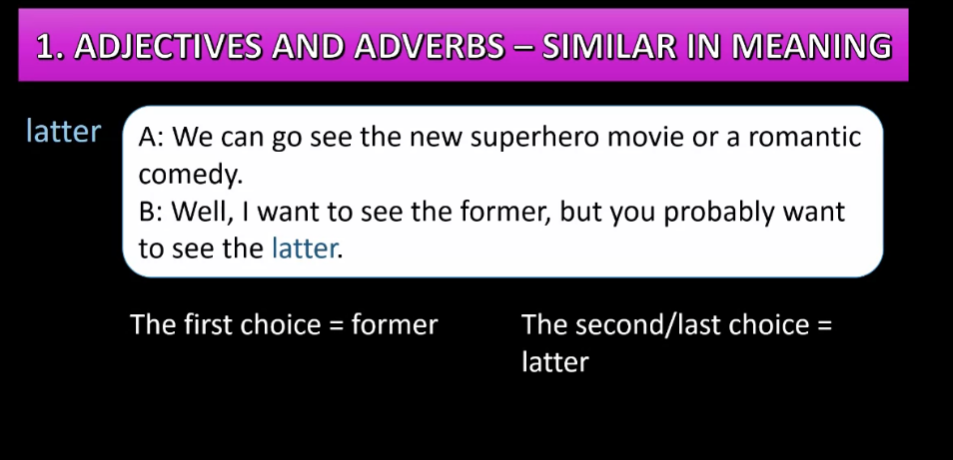
With latest, you may have heard for
the latest news and traffic, turn to channel, on television. This means the information is recent.
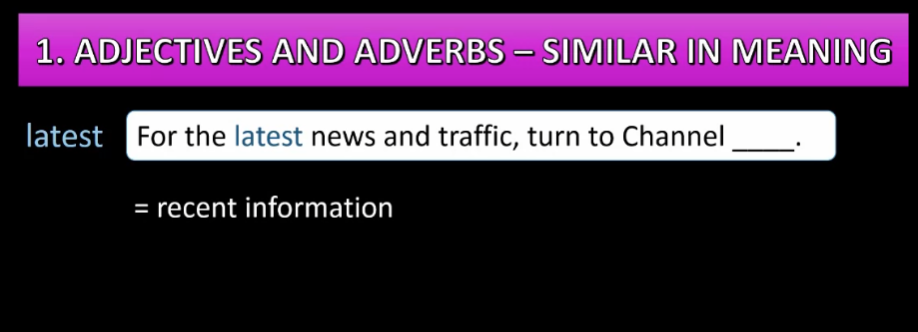
High and tall are both adjectives, but
high means distance from the ground, usually wide items and can not be items
and cannot be used for people or animals. But tall is a measure of height for
narrow vertical items and can be used for people and animals.

So for example, we could say,
planes travel high above the ground, so they can go fast not
tall above the ground. But we need to say, Burj Khalifa Tower is
a very tall hotel in Dubai not high hotel.
Ill is an adjective that refers to
especially long-term physical or mental disease, or meaning bad. It’s rarely followed by a noun
such as with ill health. Most often, you will see it followed
by an adjective such as ill prepared or ill advised or after a linking
verb such as the girl is ill. Sick is an adjective that refers to
a physical illness, usually short-term.
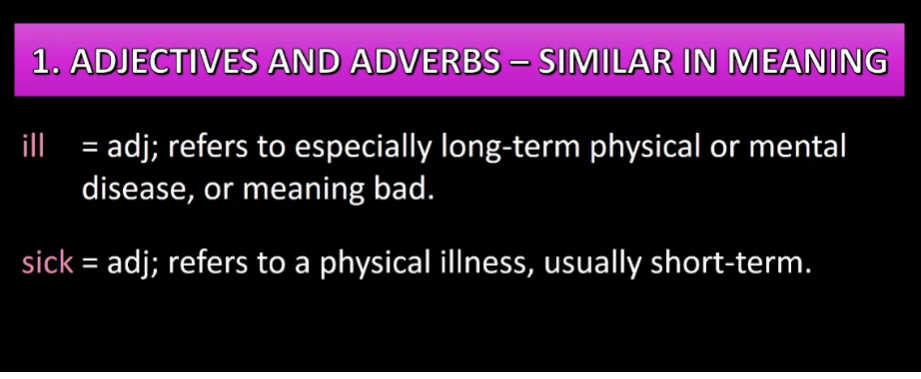
So we can say, Margo has been ill for
several years. Meaning, long-term physical disease. But with sick we can say, John had to
stay home today with his sick child. Meaning that the illness is temporary. We expect John’s child to recover soon.
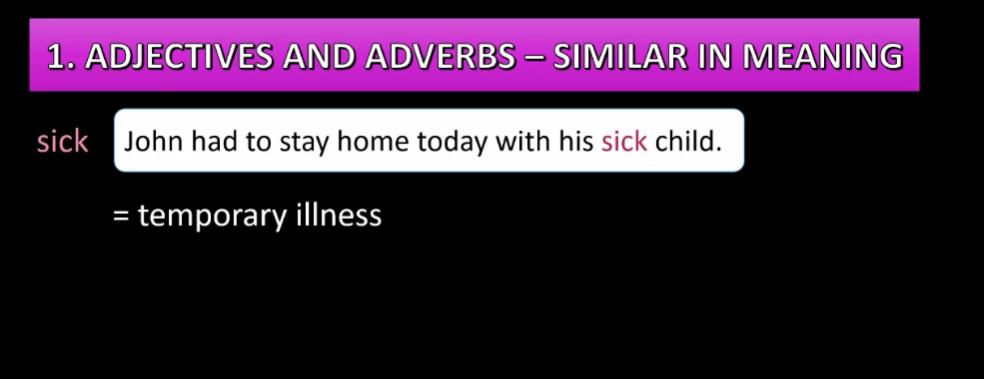
Deadly and fatally can be confusing,
but deadly is an adjective. Meaning, to cause death. And as with most adjectives,
it can be followed by a noun, but fatally is an adverb. Meaning, to cause death and
needs to be next to a verb. The adjective form is fatal.
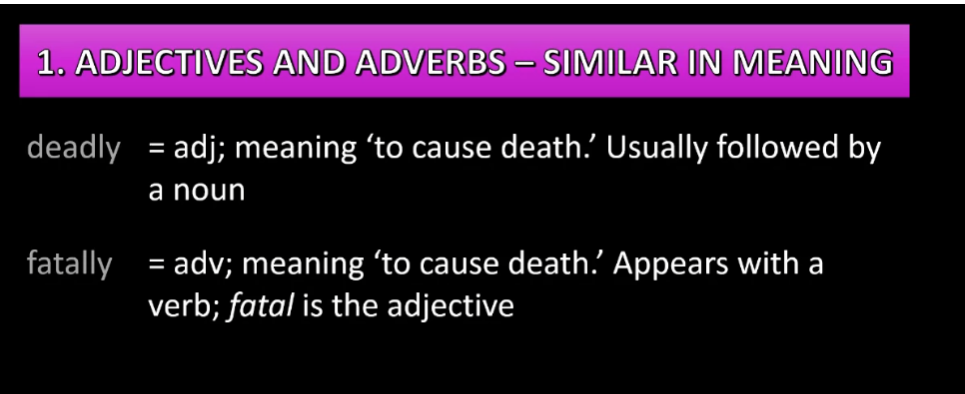
In the sentence, a deadly crash
closed all lanes of the freeway. Means the crash, a noun, caused deaths. But the owner was fatally
shot during a robbery. Means the act of being shot,
a verb is what caused the death. But we cannot say,
deadly shot with the same meaning. But there are also some adjectives and
adverbs that are similar in form, but are very different in use.
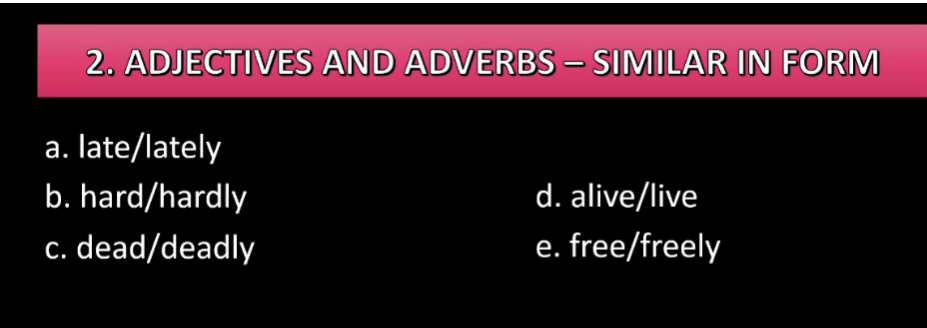
Confusing Adjectives and Adverbs Part 2 Lecture
Hi, and welcome to
Confusing Adjectives and Adverbs. In this lesson,
we will discuss adjectives and adverbs that are similar in form,
and adverbs with unusual forms. There are also some adjectives and
adverbs that are similar in form but are very different in use.
Late and lately are commonly confused but
are very different in meaning. Late is an adjective and
means arriving after a specific time. But lately is a synonym for
recently, meaning near in time.
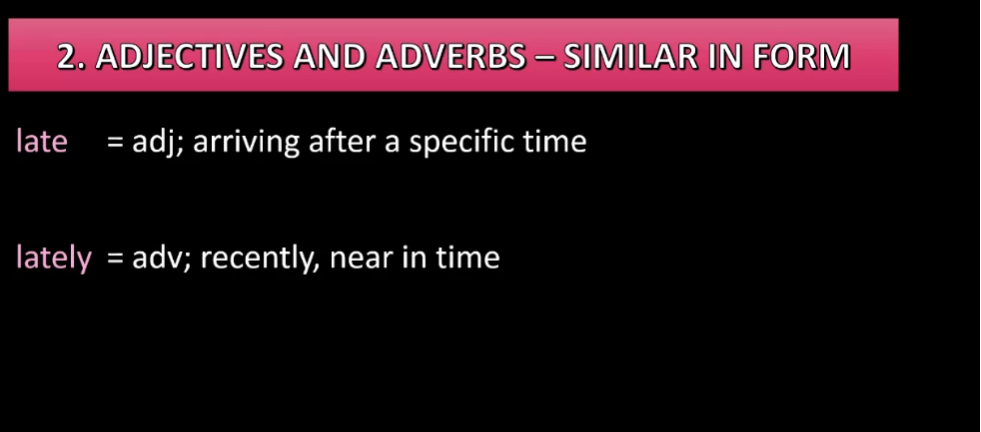
So in a sentence, the meeting
was supposed to start at 9, but it started at 9:15 because John was late. Means 9 was the start time, but
the meeting started after that time. But with lately, as in Jane must be busy. I haven’t seen her lately. I mean to say that in recent days,
weeks, or months, I haven’t seen her.
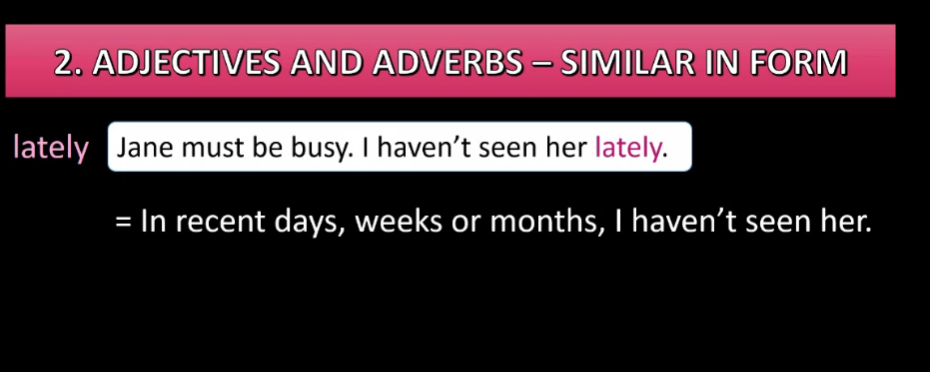
With hard and hardly,
there are actually forms of hard. One is an adjective and one is an adverb. The adjective hard means difficult,
or it could mean solid. The adverb hard means productive,
or with force. Hardly is a negative
adverb meaning almost not.

For example, learning English is hard uses
hard as an adjective meaning difficult. But in the example, glass is liquid when
hot, but when it cools becomes hard, means a solid or non-liquid state. With hard as an adverb meaning productive, we can say Walter worked
hard in the garden. With the meaning of with force,
we could say the door sticks closed. Sometimes you have to push hard. In the sentence using hardly,
I’ve hardly seen my roommate all week. She’s been working on a big project for
class. Means I have seen her almost not at all.
Dead and deadly are both adjectives,
but dead means no longer living and is the opposite of alive. But deadly means might cause death.
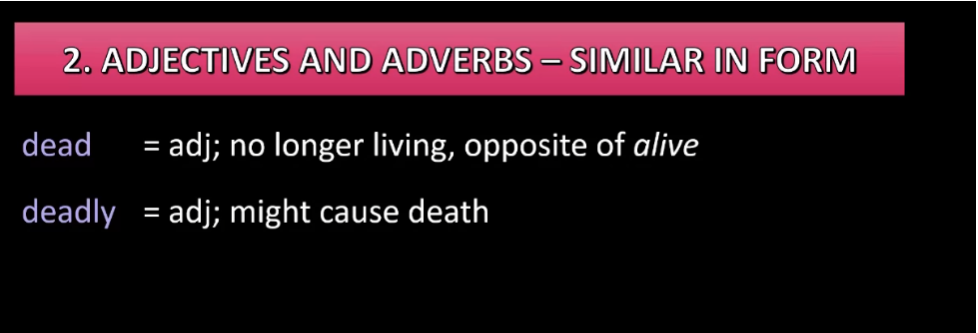
In the sentence, a dead body was found in
the car, describes the body as not living. But in the sentence,
Cobras have deadly venom in their fangs, describes venom, and
the venom could cause death. We often describe things that can
cause death in expressions such as deadly weapon, deadly poison,
deadly crash, and deadly accident.
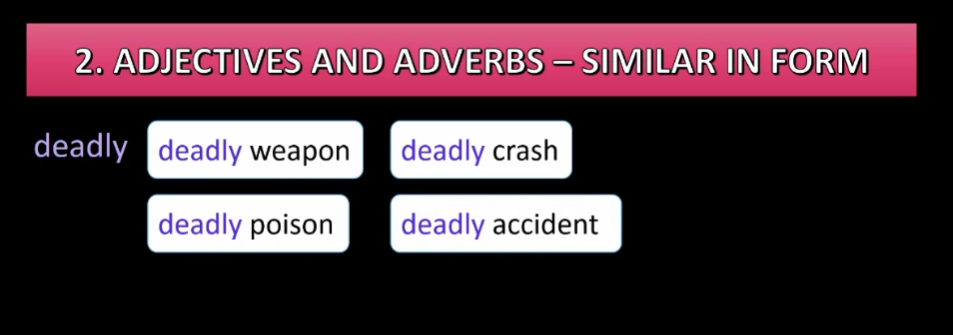
Similarly alive and
live are both adjectives. But alive means still living or
energetic, the opposite of dead. And live means not artificial,
or currently active.
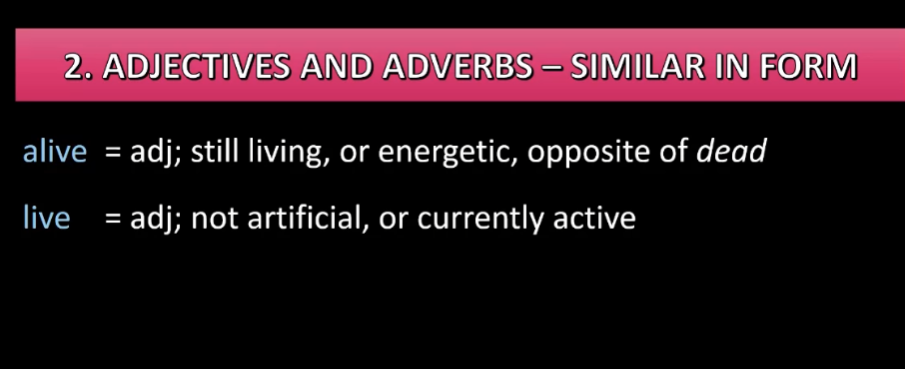
In the sentence,
both my grandparents are still alive and well in Florida,
means that my grandparents aren’t dead. But we wanted to say both my grandparents
are still live and well in Florida.
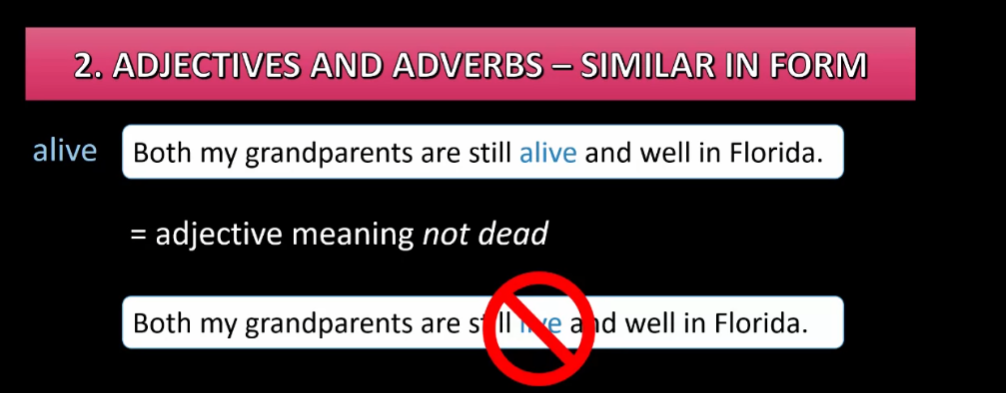
In the sentence, this product
was not tested on live animals, means the animals are actively living. We wouldn’t use the sentence, this
product was not tested on alive animals.
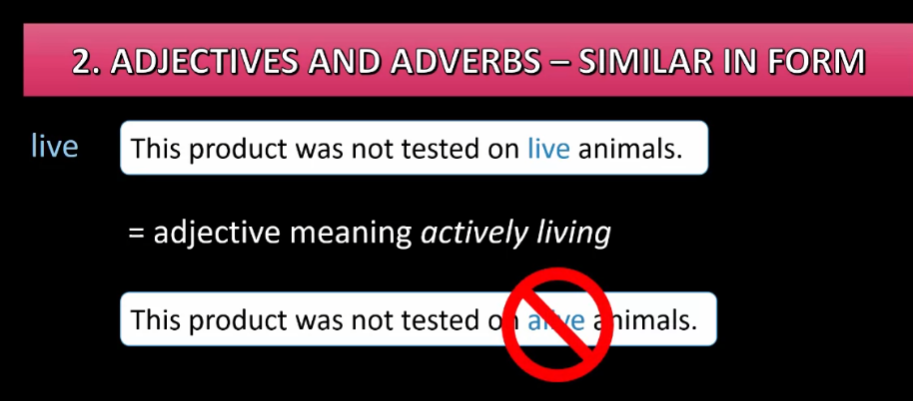
Now free is an adjective
meaning not costing money, and freely is an adverb, but
it means without limit.
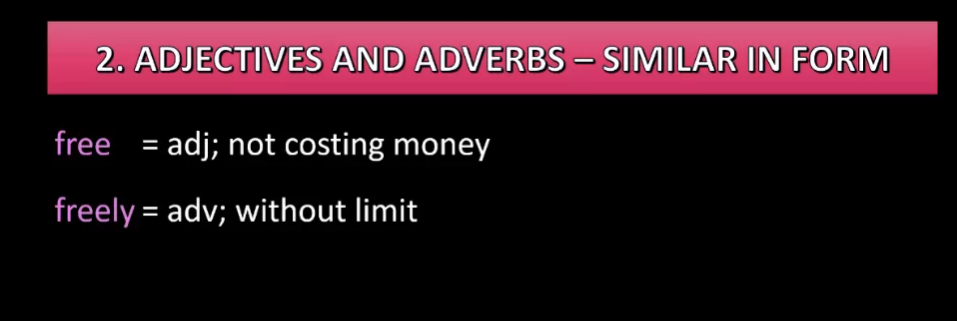
So sometimes you might hear in
advertising, when you buy two, you get the third one free. Meaning you do not have to pay for
the third item. But in the sentence, in the United States, you can travel freely from one state
to another using the interstate freeway system means you can move
easily across state borders.
Lastly, adverbs often end with LY. Here are some examples. However, there are several frequently used
adverbs that don’t follow this pattern. For instance, several adverbs of
frequency, such as always, often, et cetera,
do not follow the usual -ly pattern. Also, words like no, not, never, nowhere, are negative adverbs
without the -ly ending A lot of the transitions
used in writing are adverbs, such as furthermore, also, next etc.

Other adverbs don’t follow any kind of
pattern, like very, well, far, and others. So those are only some of the adjectives
and adverbs that you might find confusing. We discussed adjectives and adverbs that
are similar in meaning, adjectives and adverbs that are similar in form,
and adverbs with unusual forms. Thanks for listening!
Confusing Adjectives and Adverbs Practice Quiz
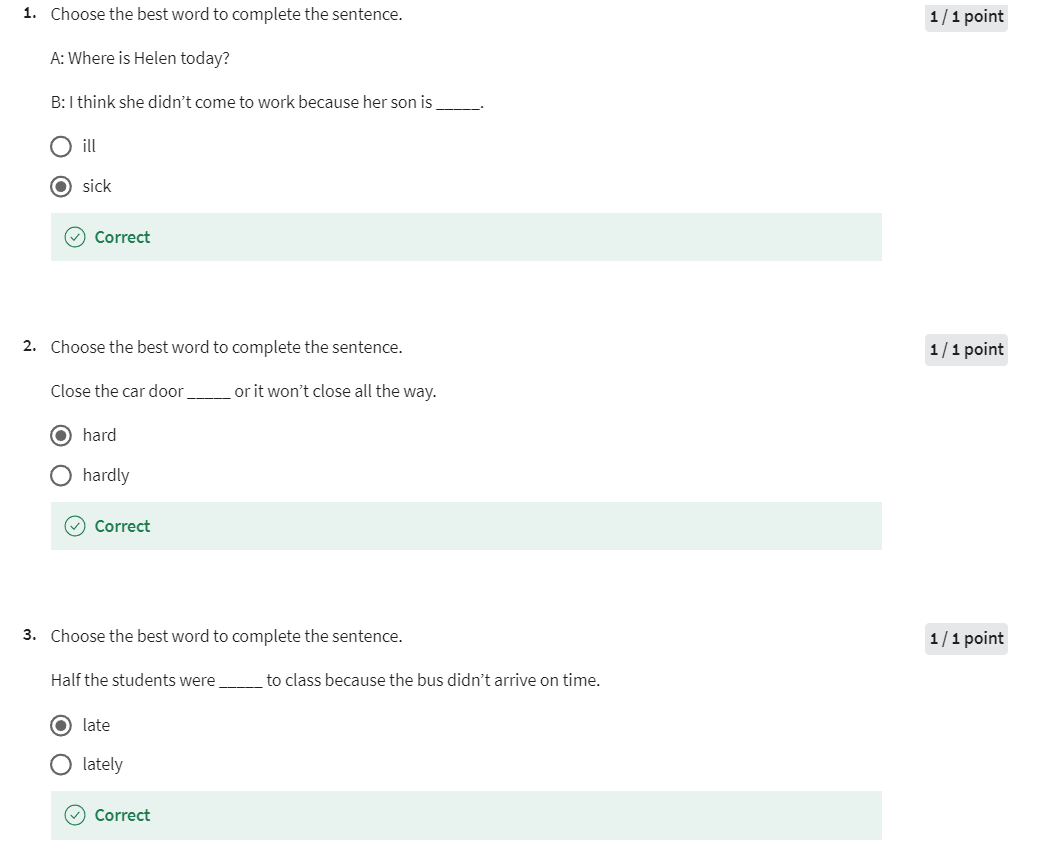

Confusing Adjectives and Adverbs Practice
Practice
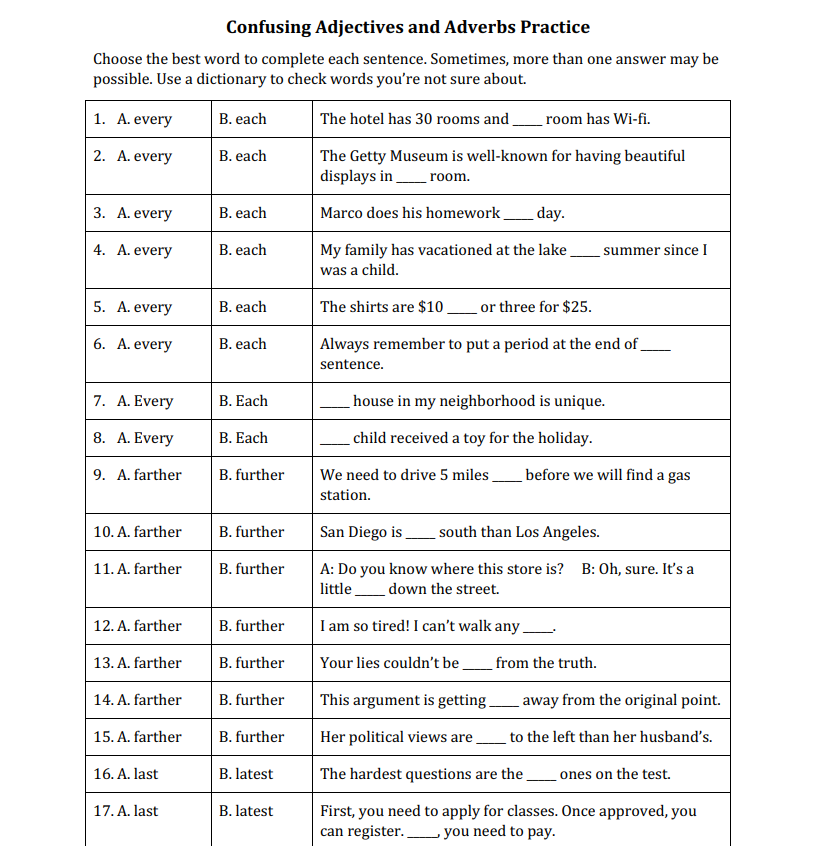
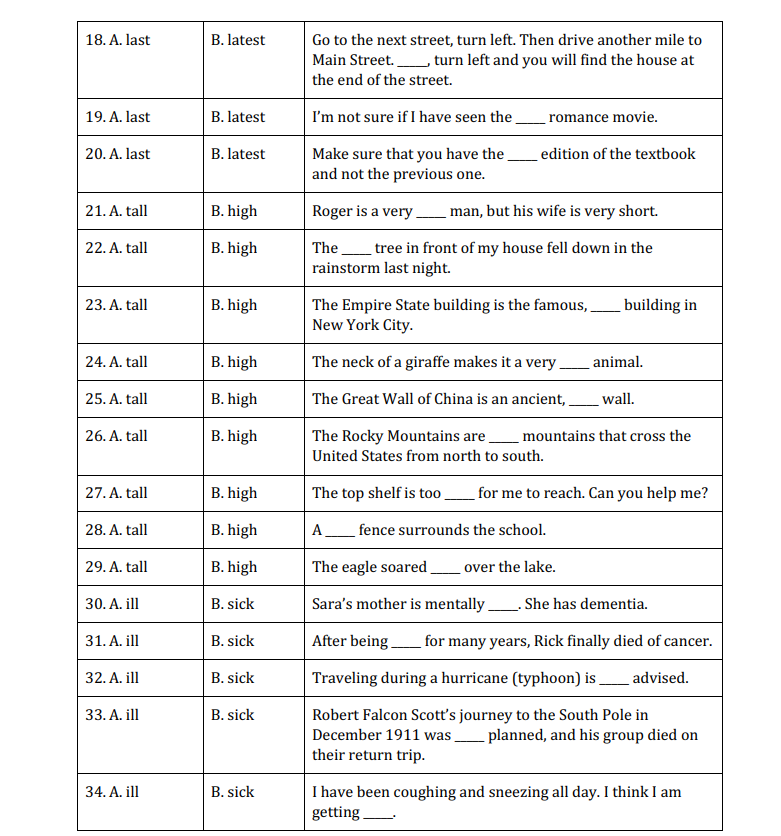
Practice key
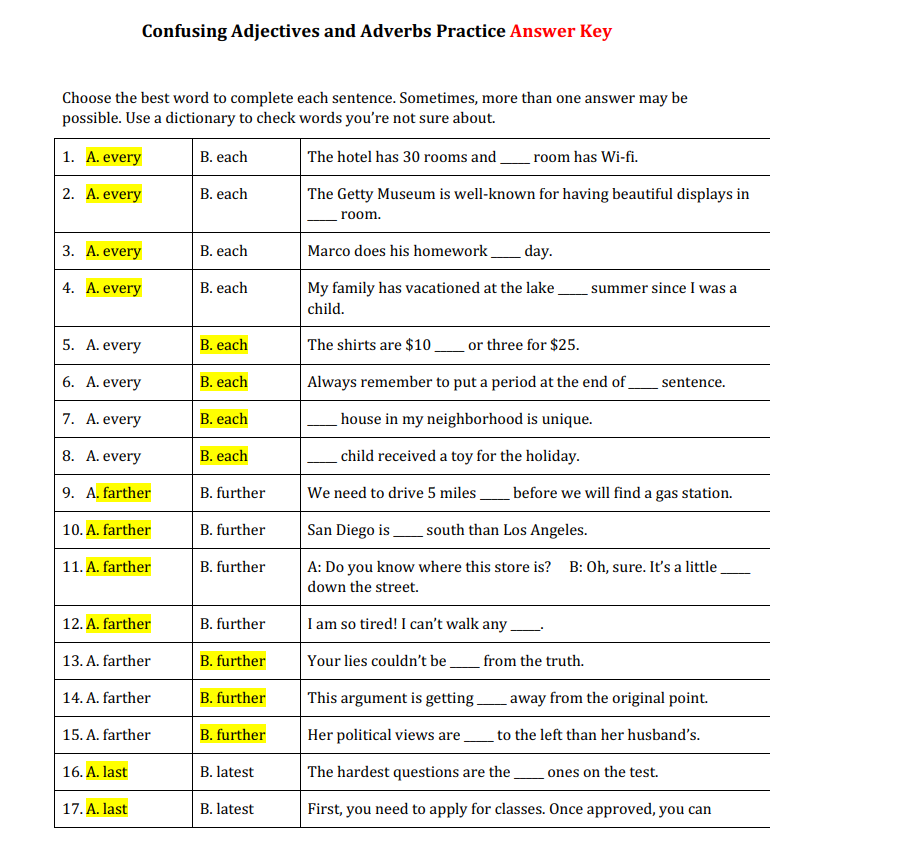
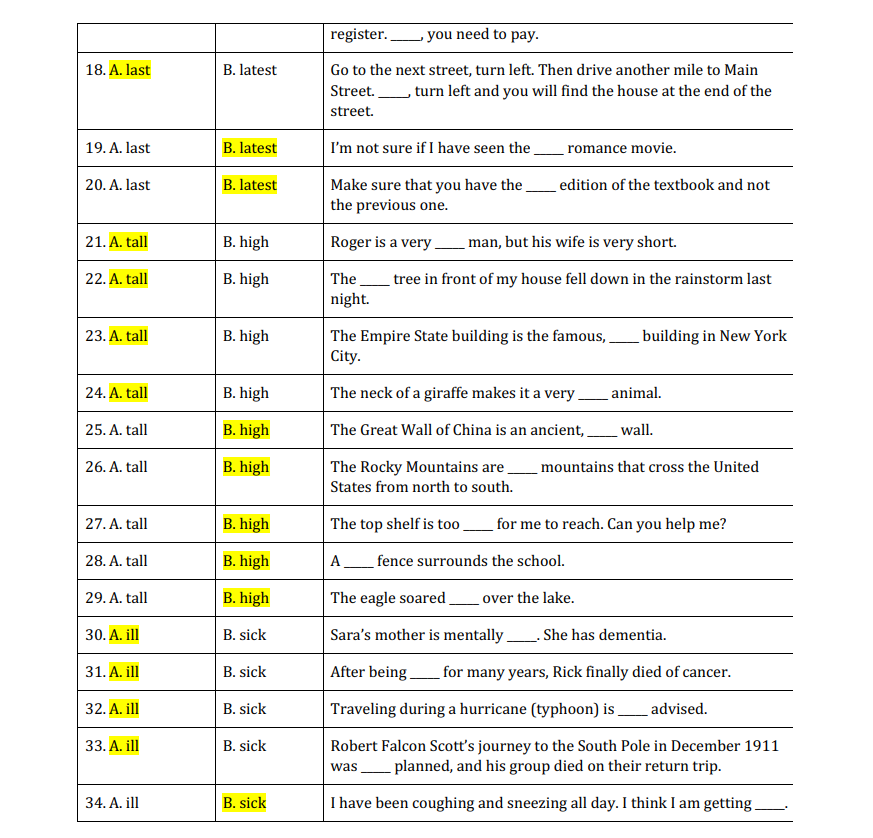
Confusing Nouns and Verbs Part 1 Lecture
Confusing nouns and verbs, Part 1. In these lessons, in Parts 1 and
2, we’ll be looking at nouns and verbs that are confusing even for
native speakers sometimes. In Part 1, we’ll look at three pairs
of nouns and three pairs of verbs. And in part 2, we’ll look at four
pairs of noun/verb combinations. But let’s start with a quick review. What is a noun? A noun is a person, place, thing, or idea. An idea is something that’s abstract. And what is a verb? A verb, well, it’s an action or a state. So let’s start with confusing nouns. Here are the pairs of
nouns we’ll be looking at. Do you know all of these words?
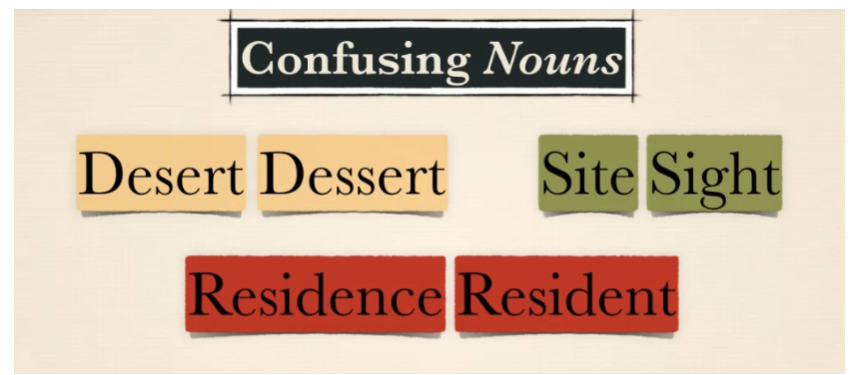
Well, let’s begin with desert and
dessert, yum. Notice that desert has one S,
while dessert has two Ss. How can you remember which is which? We’ll go ahead and finish this sentence. I would like some more dessert, right? Well, just remember, you want more
dessert and dessert has more s’s.
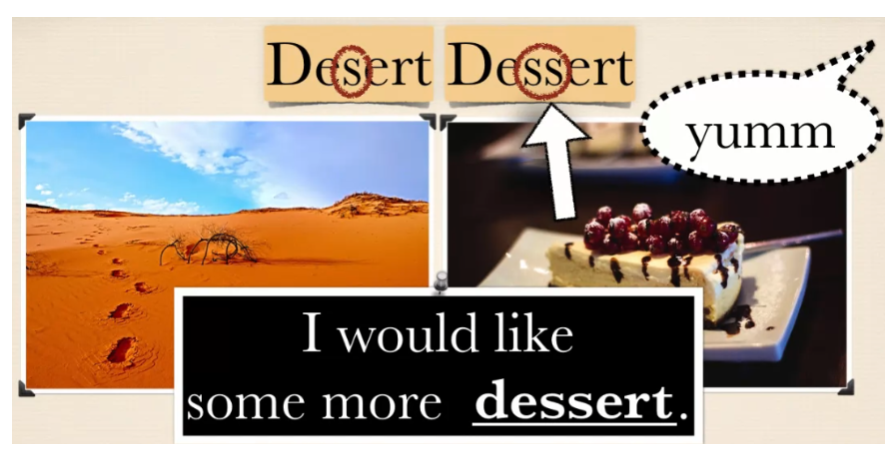
Now let’s talk about site and sight. Hm, well, these words are pronounced
the same way, but as you can see, they’re spelled differently and
they also mean very different things. See if you can finish this
sentence based on the photograph. This is a construction. That’s right, site! S-I-T-E. Site here means a place or location. You know what a website is, don’t you? Well, a website is a place on the web, so, site in website is
also spelled S-I-T-E.
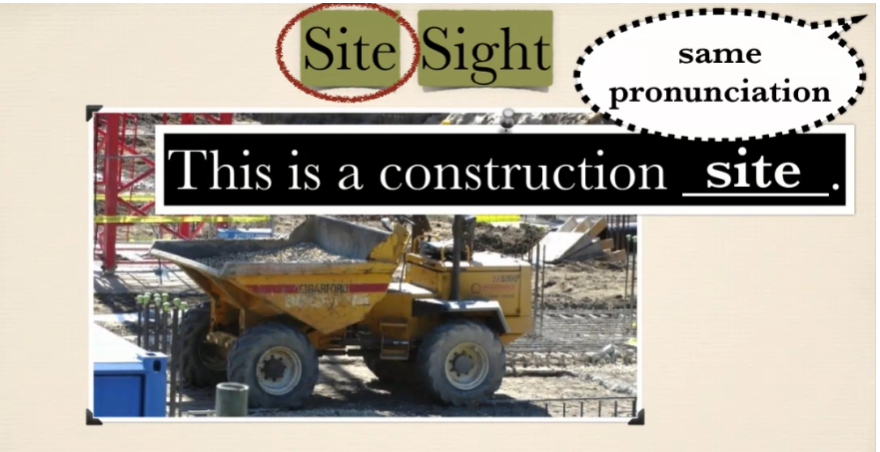
Well, S-I-G-H-T means
something totally different. There is no one sight. Sight here, has to do with vision or
something that you can see. So it makes sense to say owls
have excellent eyesight.
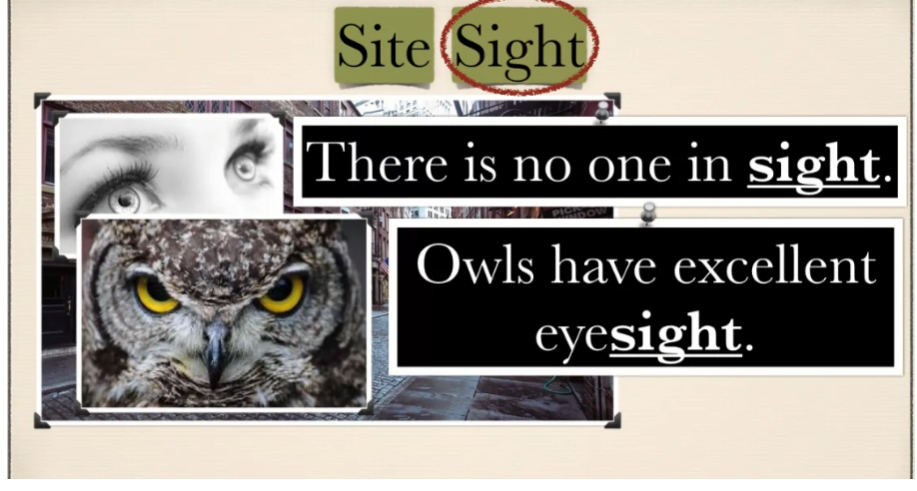
What about residence and resident? Well both of these words have
to do with where you live. Complete this sentence. Is this your place of residence? Great. Residence has to do with the location,
the place where someone lives.
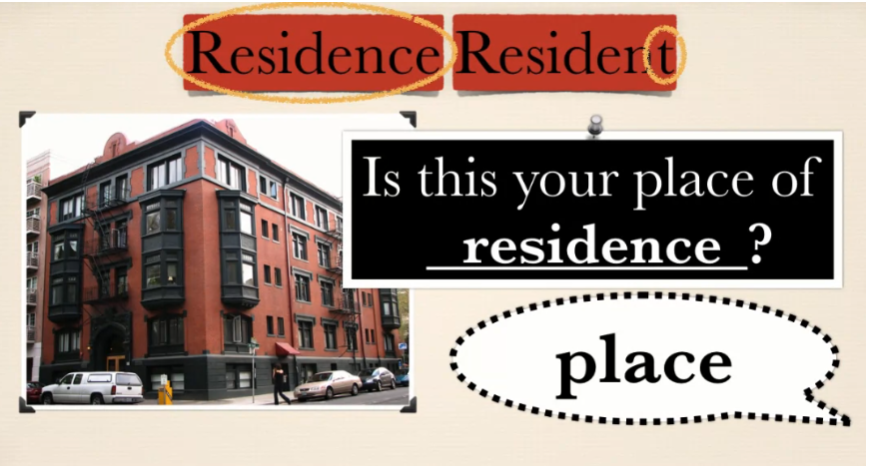
The residents of this city mostly walk. Residents Refers to the people,
the people who live in a certain place.
Now let’s talk about confusing verbs. Here are the pairs of verbs
that we’ll be looking at. Do you know all of these words?
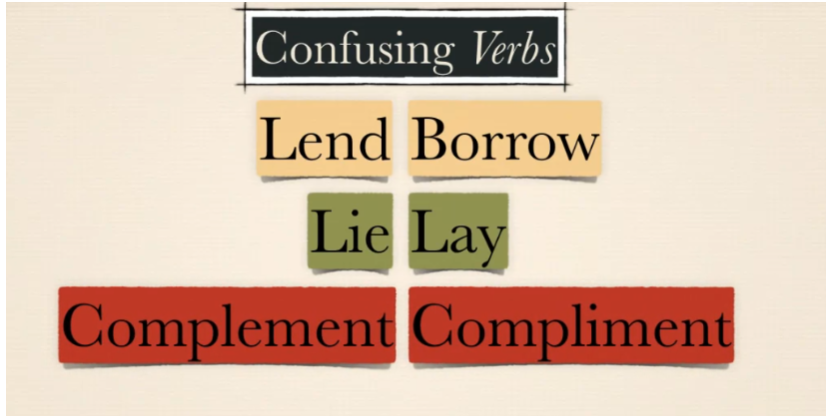
Let’s begin with lend and borrow. Lend basically means to give while borrow
means to take, but only temporarily. Let’s use the library as an example. How would you finish this sentence? You can, good,
borrow books from the library. Notice the subject is you. You would be doing
the action of borrowing. But what about the library. The library will lend, that’s right. The library will lend books to you.
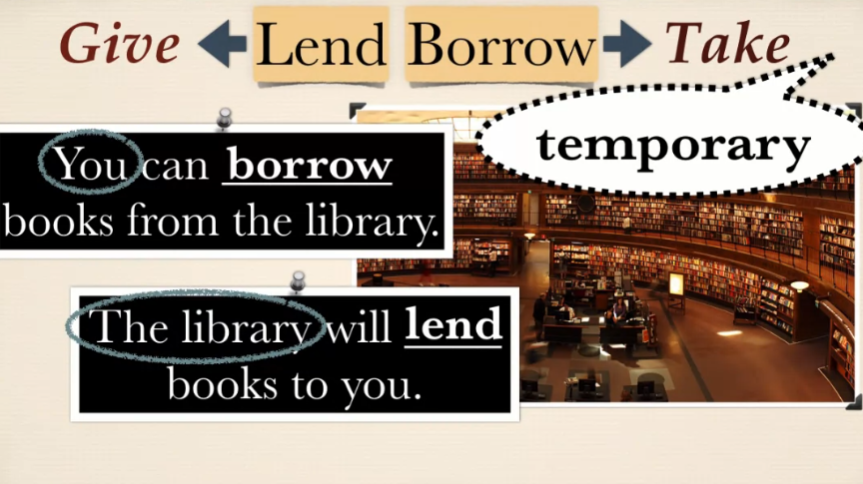
Let’s try one more example. Some people can blank money from banks. Pay attention to the subject to help you. Some people can borrow money from banks. Banks blank money in the form of loans. What do the banks do? They lend the money in the form of loans.

Great. Now let’s talk about the verbs lie and
lay. Well, these can be very confusing,
but just try to remember that lie does not take a direct object But
after lay, you must have a direct object. Here’s the chart reminding you of the ways
that these verbs change depending on the tense.
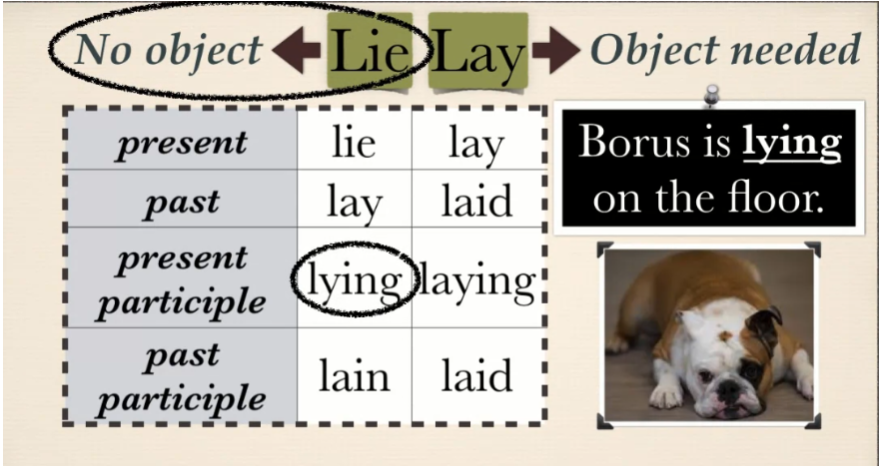
See if you can finish this sentence. Borus is blank on the floor. Borus is lying on the floor. Great. There’s no direct object after lie. On the floor is a prepositional phrase. Borus is lying on the floor. Try to complete the sentence
Using the photograph. They blank the wood floors yesterday. Good. They laid the wood floors yesterday. The direct object is wood floors.
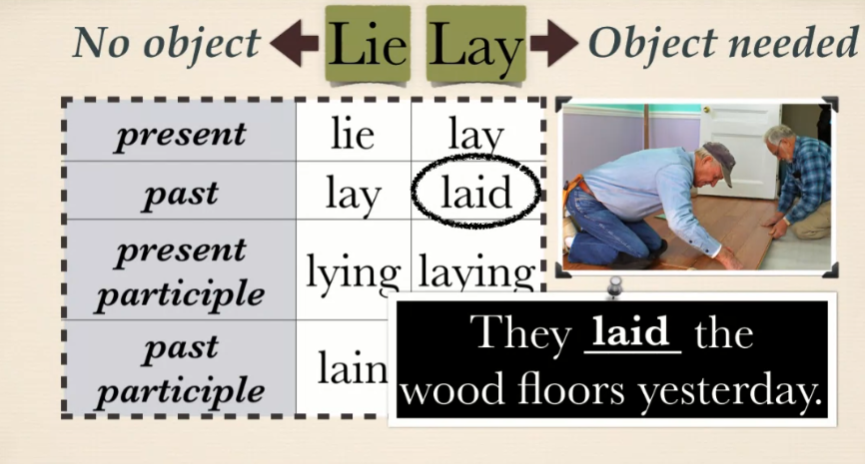
Let’s try one more example. Every night, mommy blank baby in the crib. [MUSIC] Lays, that’s right. Every night, mommy lays baby in the crib. You want to make sure to use lay
Because we have a direct object. Baby.
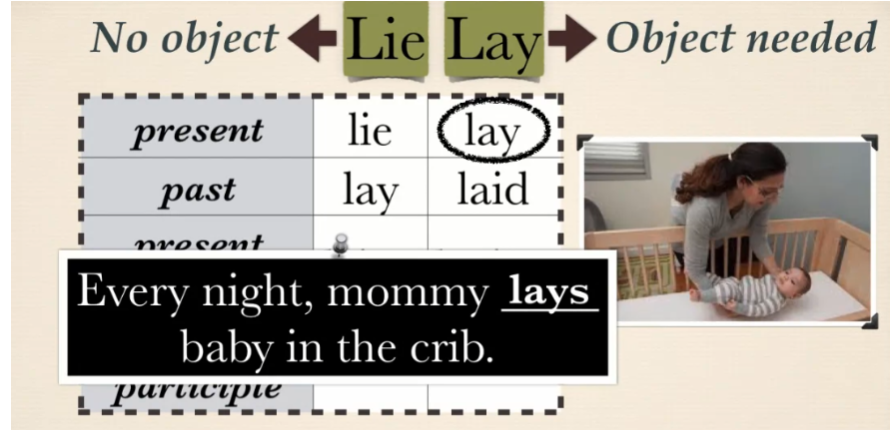
Now let’s talk about our last pair
of verbs.Complement and compliment. These two words are pronounced the same
way, but one is spelled with an e, and the other with an i. And they mean different things. We can say steak and
wine blank each other well. They compliment each other well, which basically means that they go well
together or they complete each other. And we can also talk
about people this way. Roxanne’s sweet personality
complements Kevin’s sensitive nature.

Now compliment with an i
means saying something that is really nice about another person. Do you like it when people tell
you you sing like a superstar, or when they say you’re the funniest
person I’ve ever met? Well these are examples of complements. I just want to point out that
complement with an e and compliment with an i Are both verbs but
actually they can also be nouns. Well thank you so much for
watching part one, we’re not done yet make sure to move on to watch part two.
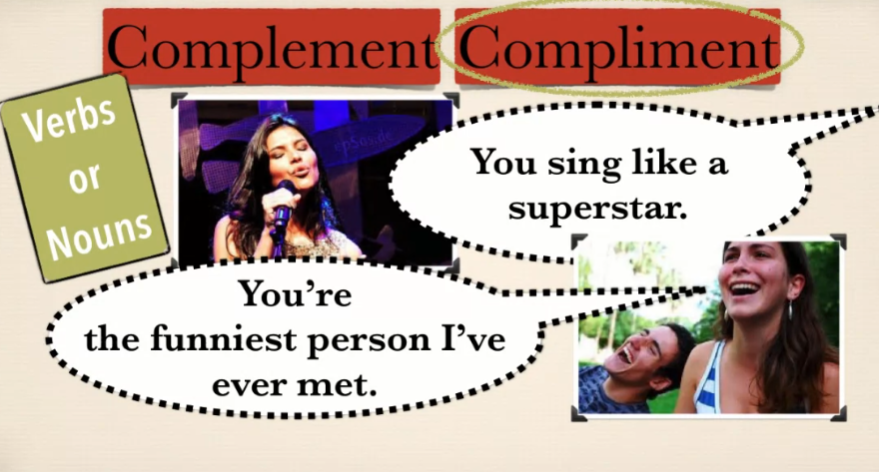
Confusing Nouns and Verbs Part 2 Lecture
Confusing nouns and verbs, Part 2. Now let’s continue talking
about confusing verbs, each of these pairs show a noun on
the left and a verb on the right.
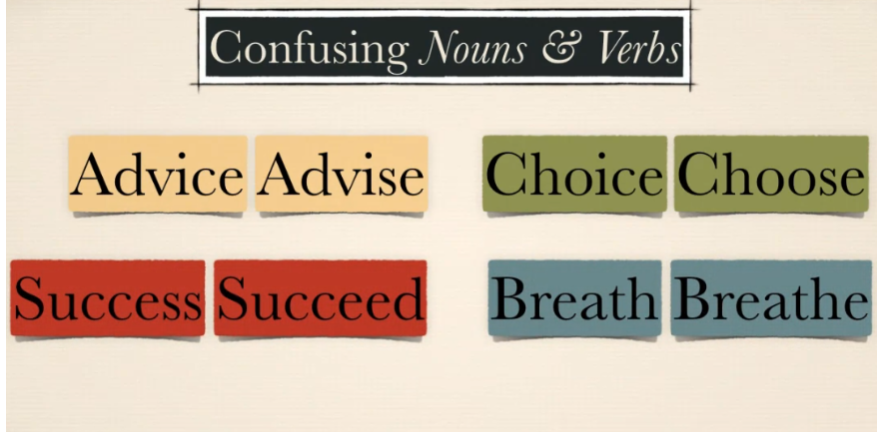
Let’s start with advice and advise. Advice with a c is a noun. Advise with an s is a verb. The s actually has a z sound. Advise. See if you can complete this sentence, make sure to think about whether
the blank spaces need a noun or a verb. When Pete goes to his friends for advice, they try to advise him the best they can,
good.
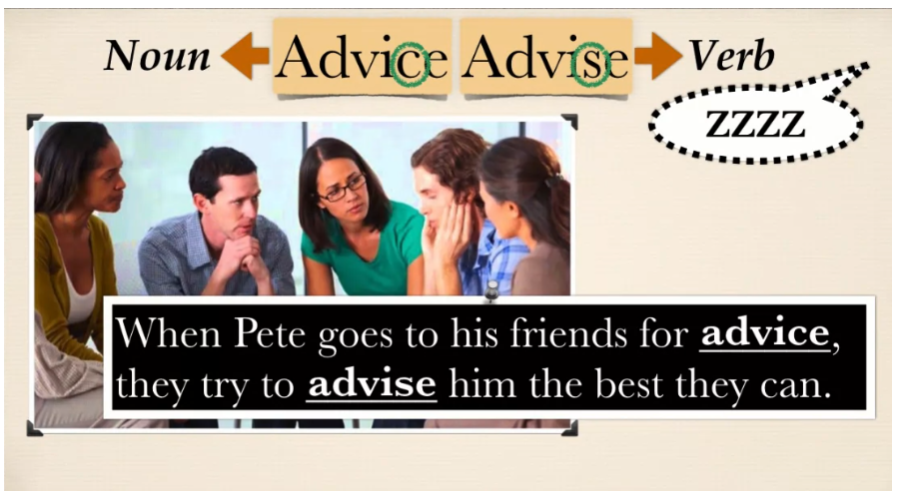
Now what about choice and choose? Choice is a noun, choose is a verb. Choose has a long o, choose. Complete this sentence. Blank carefully or
you may regret the blank you make. Choose carefully or
you may regret the choice you make. Great.

Success and succeed. Success is the noun, succeed is the verb. And succeed has a long e, succeed. What do you think about this sentence? How can we complete this one? When you finally succeed you will
taste the sweet taste of success. Great job.
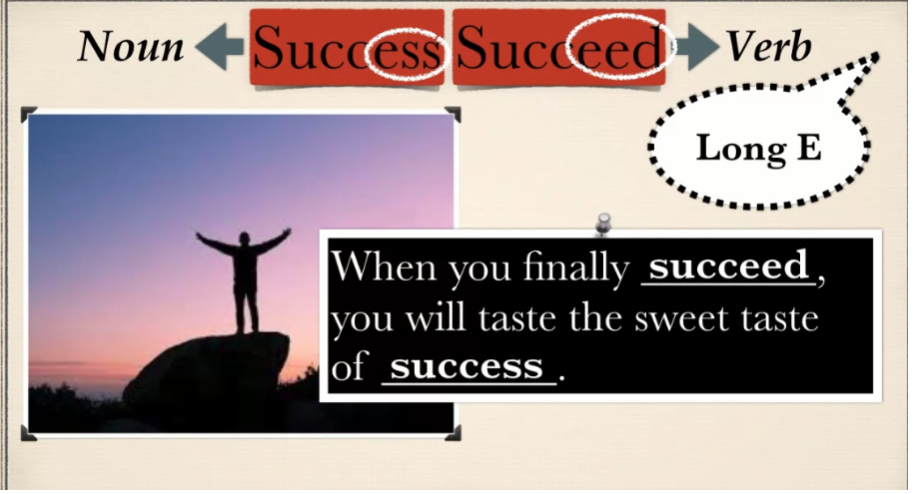
Now, let’s move onto the last pair. We have breath and breathe. Breath is a noun. Breathe is a verb. Notice that breathe has an e. That changes the pronunciation
to a long e sound. Breathe. Try completing this sentence. Breathe slowly, taking each breath in through your
nose and out through your mouth.
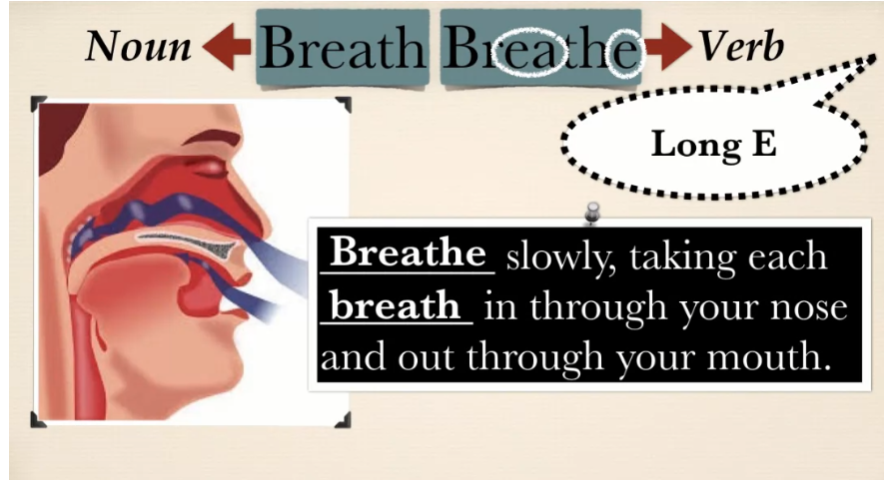
Great. Now before we end this video, I’d like for you to try to use each
of these words again. Go ahead and complete the sentences. Number 1, when I become very nervous,
it becomes difficult to breathe. Number 2, I need some advice
on which college to choose. And number 3, financial success
is not my ultimate goal in life. Nice work. Okay. So, the practice is not done. Please move on to the practice exercises. Thanks for watching
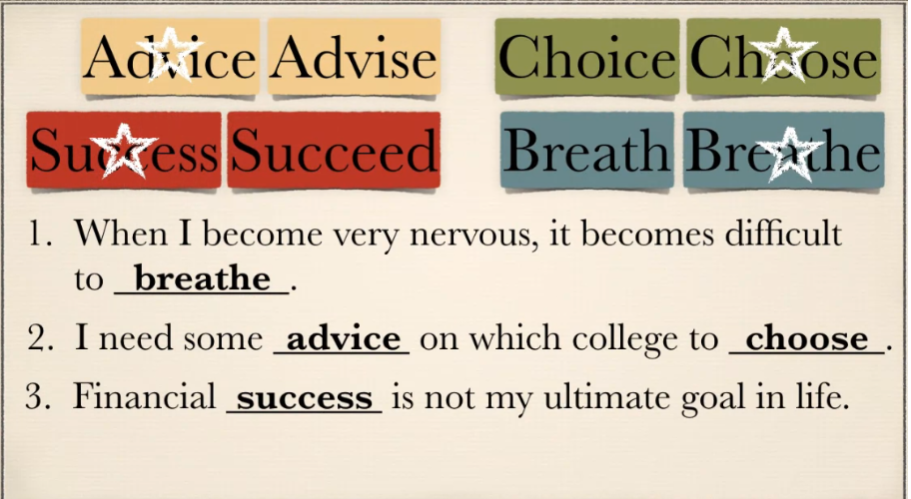
Confusing Nouns and Verbs Practice Quiz
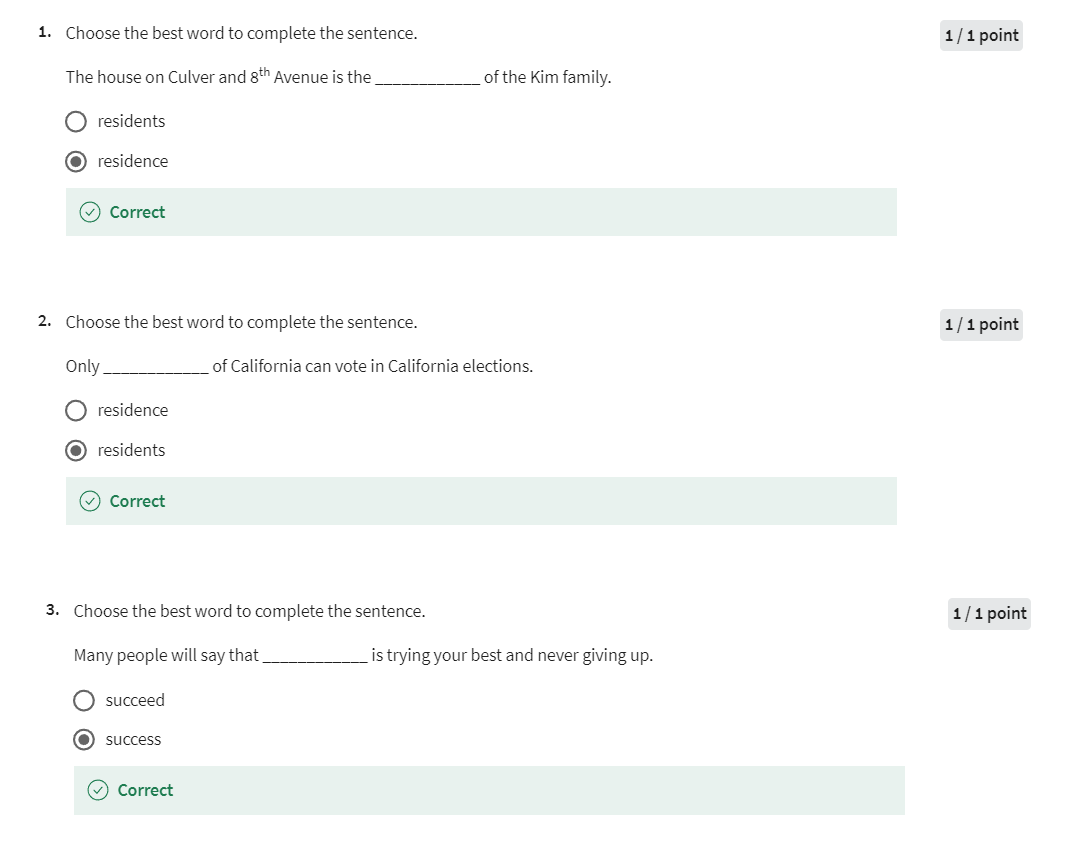

Confusing Nouns and Verbs Practice
Practice

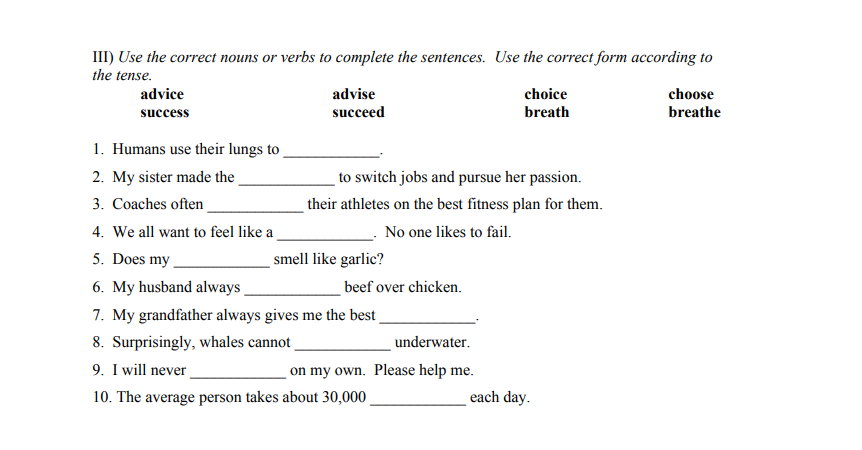
Practice key
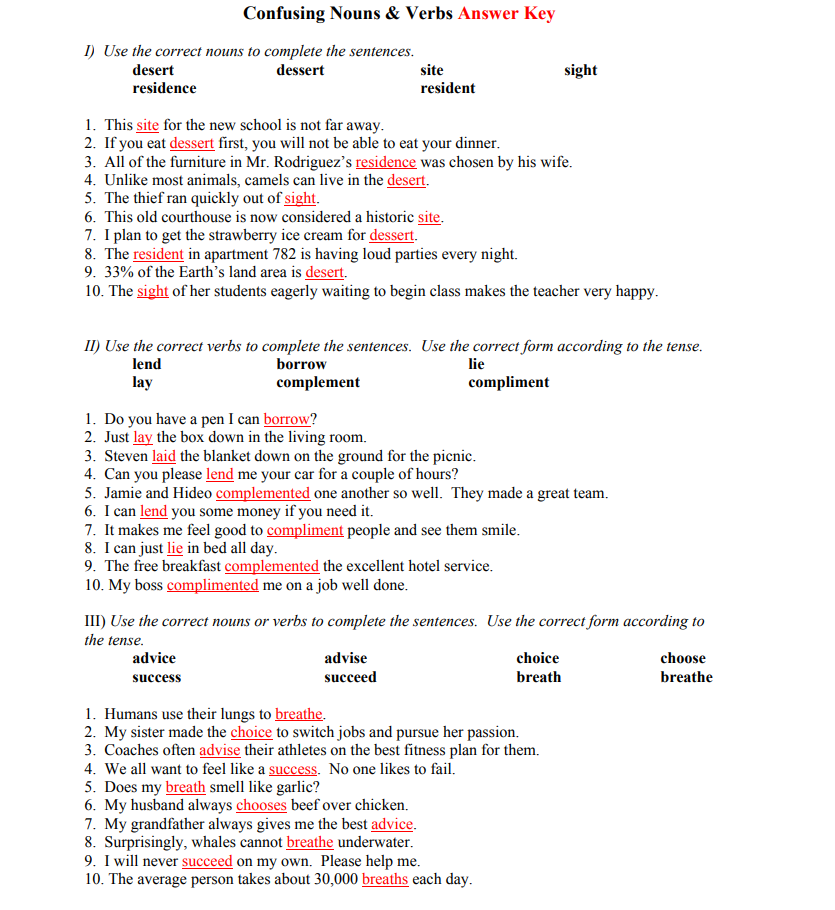
Confusing Prepositions Lecture
Hi, there and welcome to a new lesson
on problems with prepositions. In this lesson,
we’ll explore some common problems with English prepositions like
prepositions with transportation. Prepositions with units of time and
placement of prepositions in a sentence.

One big problem with prepositions
is between on and in, especially when talking
about transportation. Why do we say, I got on the bus,
but I got in a car? Well, there’s actually
a pretty simple explanation. With on, we use it with open spaces and
platforms. But with in, we use it for closed spaces.
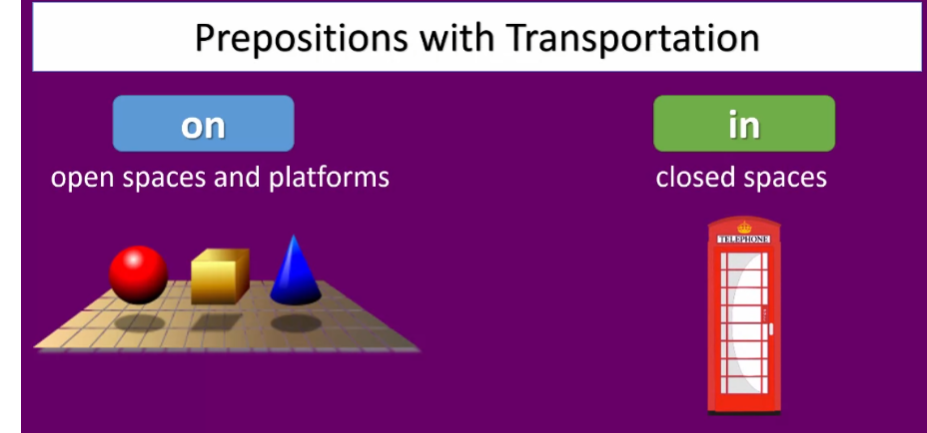
Using that logic, we can say, I traveled on a bus or on a plane. Meaning, a large jetliner or on a ship, even on a space shuttle, on a skateboard. On a horse or on a bike and on a moped.
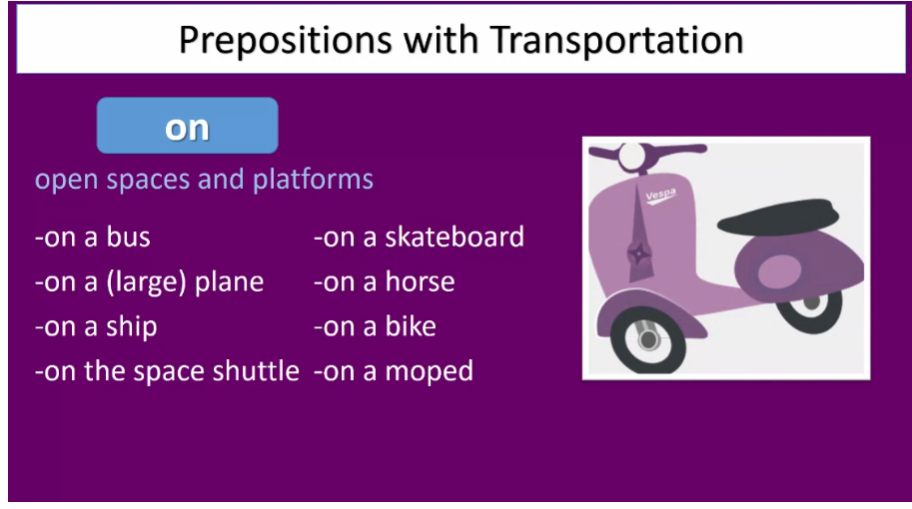
Now, let’s talk about in
using in closed spaces. We can say, in a car or in a taxi or in a van. In a rocket. In a small boat, smaller than a ship. In a hot air balloon. In a plane, like a small old
fashioned plan and in a helicopter.
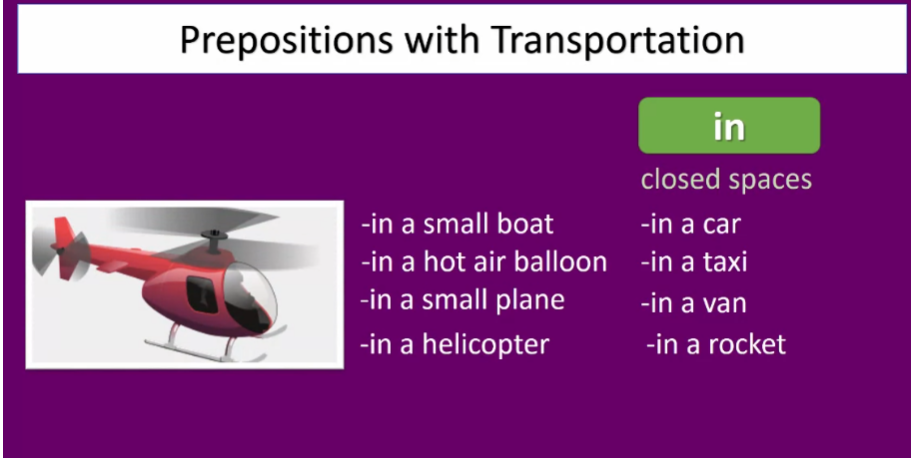
Another common problem learners face
is prepositions with units of time, especially at, on, and in. Here is an easy way to
remember which one to use. It’s called the ATONIN Pyramid. At is used with hours, on with days and
in with weeks, months, years and decades. Think of it as the small top
part of the pyramid uses at with the small unit of time. Meaning, hours here, then the middle
part is the larger unit of days. And the largest piece is the largest
unit of weeks, months and so on.
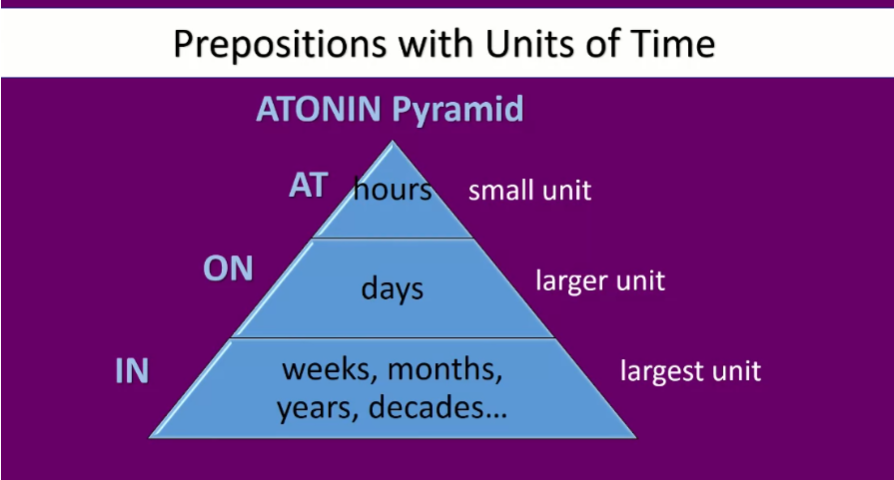
For example, we might say at 2 o’clock, at 5 PM, at noon and at midnight. Or on Tuesday, on my birthday, on Thanksgiving, On December 7th, 1941. And in four weeks, in June., in 2020 and in the 1800s.
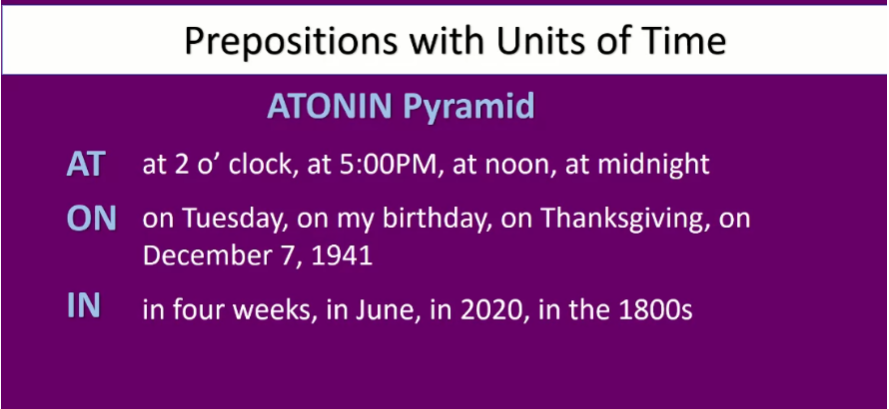
Here is another part of
prepositions that may be confusing. Placement of prepositional
phrases in a sentence. Prepositional phrases are prepositions
with the nouns that go with them. Prepositional phrases can be
adjectives describing a noun or an adverb describing a verb.
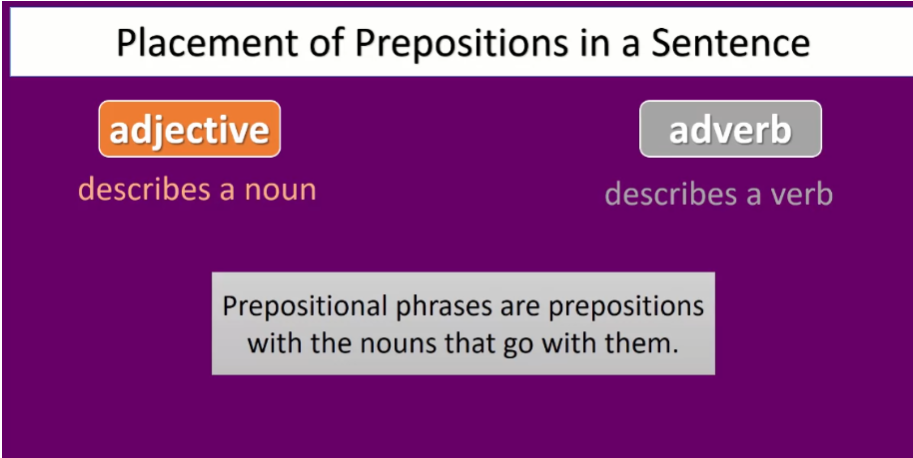
So lets say,
we have a simple sentence the girl walked, but we want to add some information to it. We can add in a red dress and
in the morning. We can add the phrases this way. In a red dress describes the girl and in the morning describes when she walked. To be clear, place the prepositional
phrase next to its noun or verb.
With adverb type prepositions,
you can have several in a sentence, but which order is the best
order to put them in? Prepositional phrase of manner
comes first, then place. And lastly, time. For example, we could use
the phrases with a quick step, across a bridge and in the morning.

And then we could add these phrases to
our basic sentence, so we get a sentence. The girl walked with a quick step
across a bridge in the morning.
Here is another example. We could say, I take a class on business
at Preston College on Wednesdays.
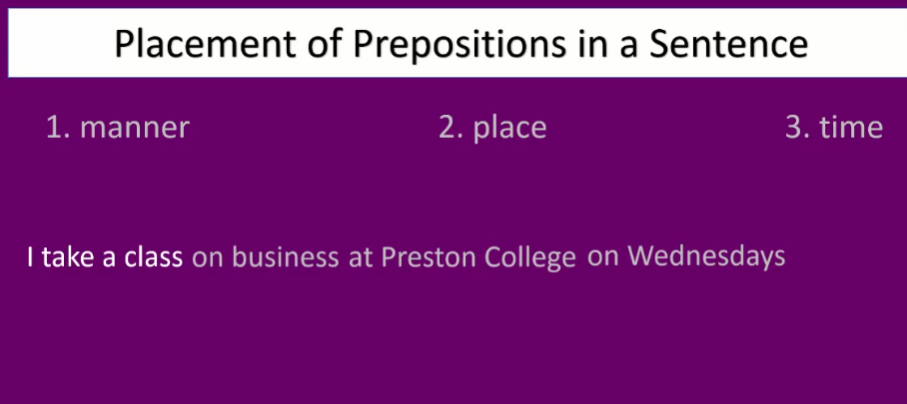
So, those are just some of
the problems with prepositions. In this lesson, we explored some
common problems with prepositions like prepositions with transportation. Prepositions with units of time and
placement of prepositions in a sentence.
Confusing Prepositions Practice Quiz
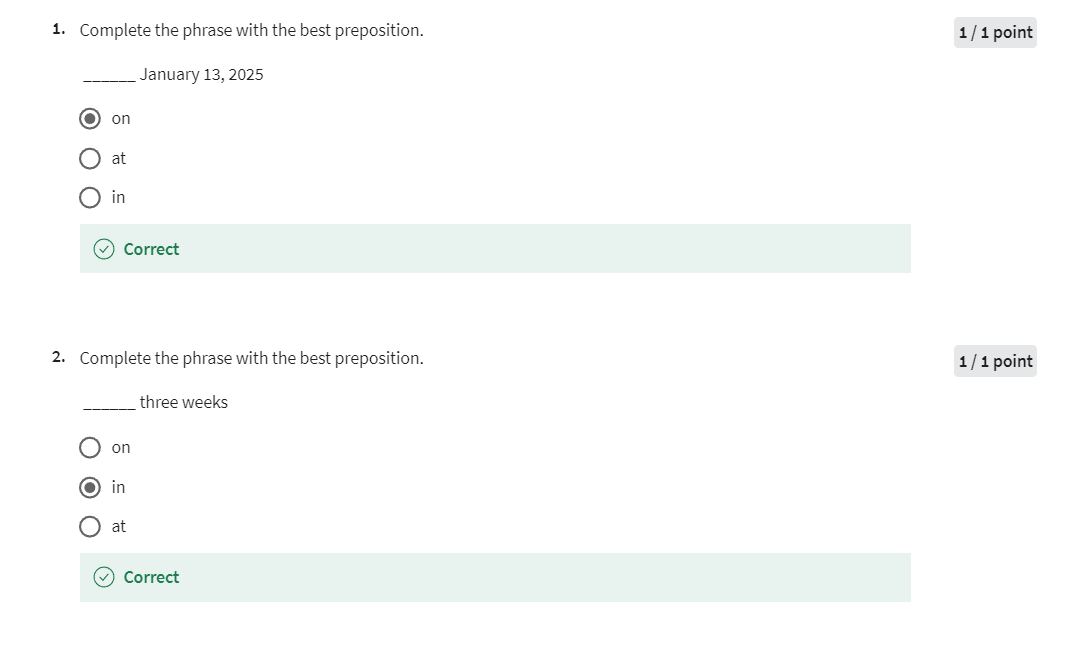
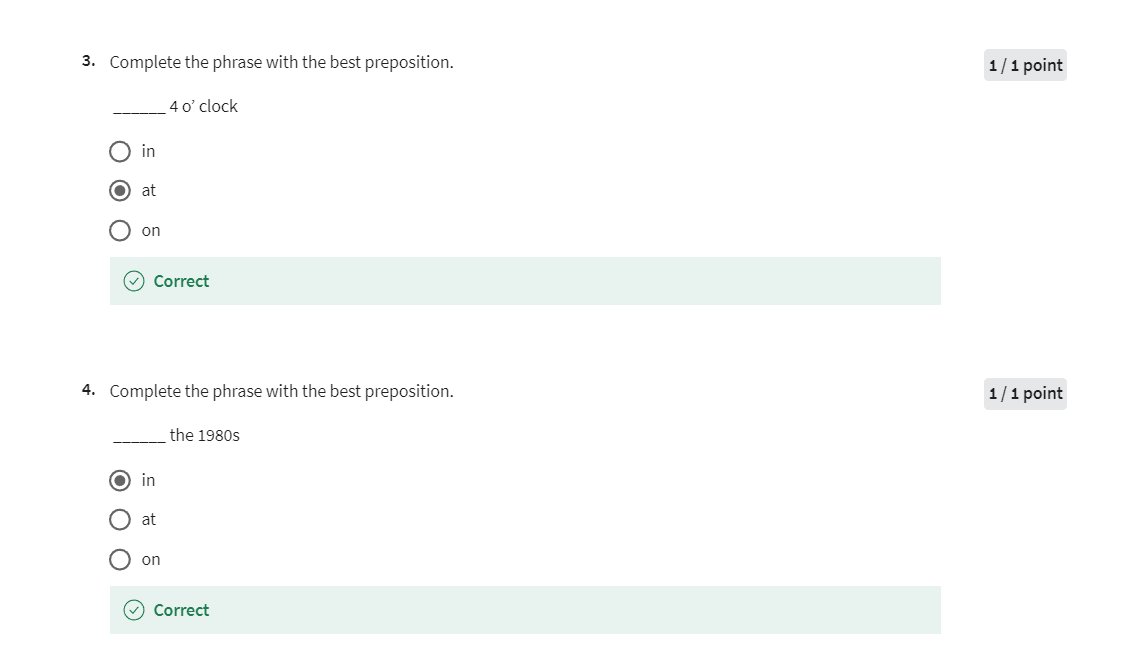
Confusing Prepositions Practice
Practice
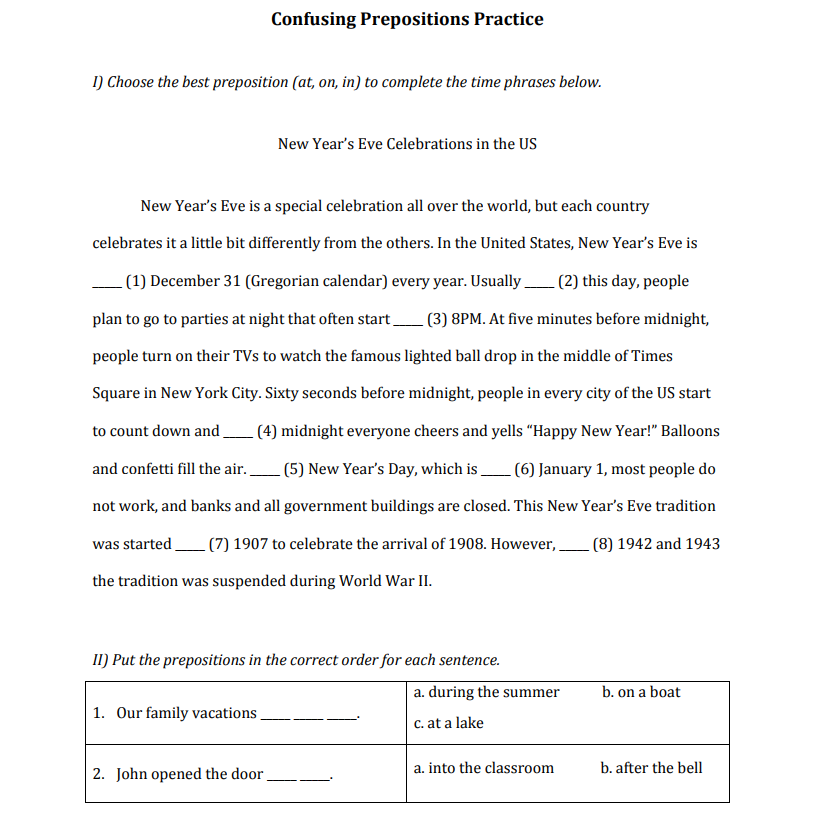
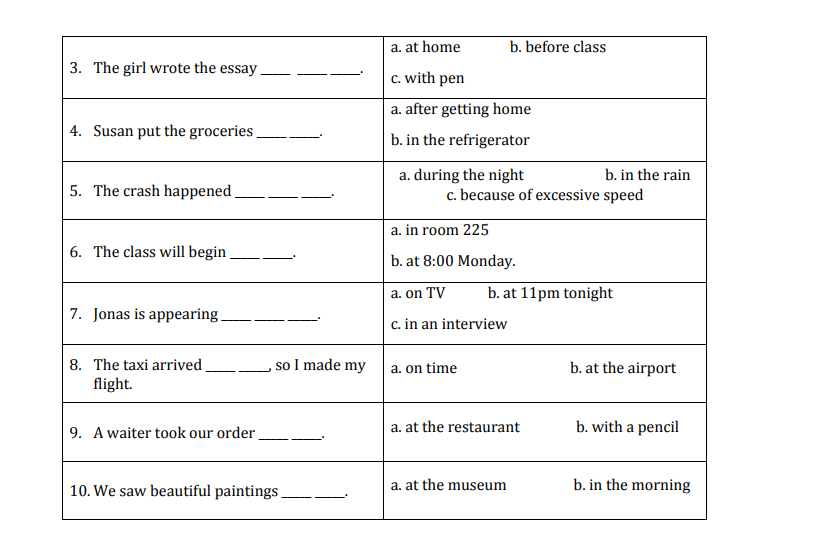
Practice Key

Graded Assignment: Confusing Word Forms Assignment
Write a short story about any subject you choose. You must correctly use 10 of the confusing words from this week’s lessons. Do not count repeated words unless they are different forms of the word. Underline or make bold your 10 words.
For example:
A man and his wife spent the day at the beach one Sunday afternoon. They lay on the sand and looked out at the ocean. It was a beautiful sight. The man was being kind to his wife and telling her how beautiful she was, but she was shy and felt embarrassed by his compliments. “What do you want me to do?” he asked, “Tell you a lie?” “Just talk about something else,” she said. He tried to think of something else to talk about.
They continued lying on the sand as the sun started to set. “Let’s go get some dinner,” the man suggested. “Ok,” said the woman, “How about that restaurant that has double-chocolate cake for dessert?” “Oh, yes,” the man shouted, “all of their desserts are delicious! Their steaks are good too.” “I advise you not to eat too much, dear. You have been putting on a little weight,” the wife replied. “How can you say that after I complimented you all afternoon?” She smiled at him, and he knew she was teasing. “You’re probably right,” he said, “I probably should choose salmon instead. Let me check their website to make sure they have that.” They stood up and dusted the sand off and headed for the restaurant.
使用 desert,dessert,site,sight,residence,resident,lend,borrow,lie,lay,complement,compliment写一个小故事。
Once upon a time, in a small desert town, there lived a friendly resident named Alice. Alice owned a quaint little residence on the outskirts of town, where she enjoyed the peaceful sights of the vast desert landscape. One day, Alice’s neighbor, Bob, approached her and asked if she could lend him a shovel to dig a hole in his backyard. Alice, always willing to help, agreed to lend him the shovel. As Bob returned the shovel the next day, he complimented Alice on the beautiful desert garden she had planted in her yard. Alice smiled and thanked Bob for his kind words. Later that evening, as the sun began to set, Alice laid out a delicious dessert spread for her friends who came to visit. The sweet treats perfectly complemented the warm desert evening, making it a delightful end to the day.
Graded Quiz
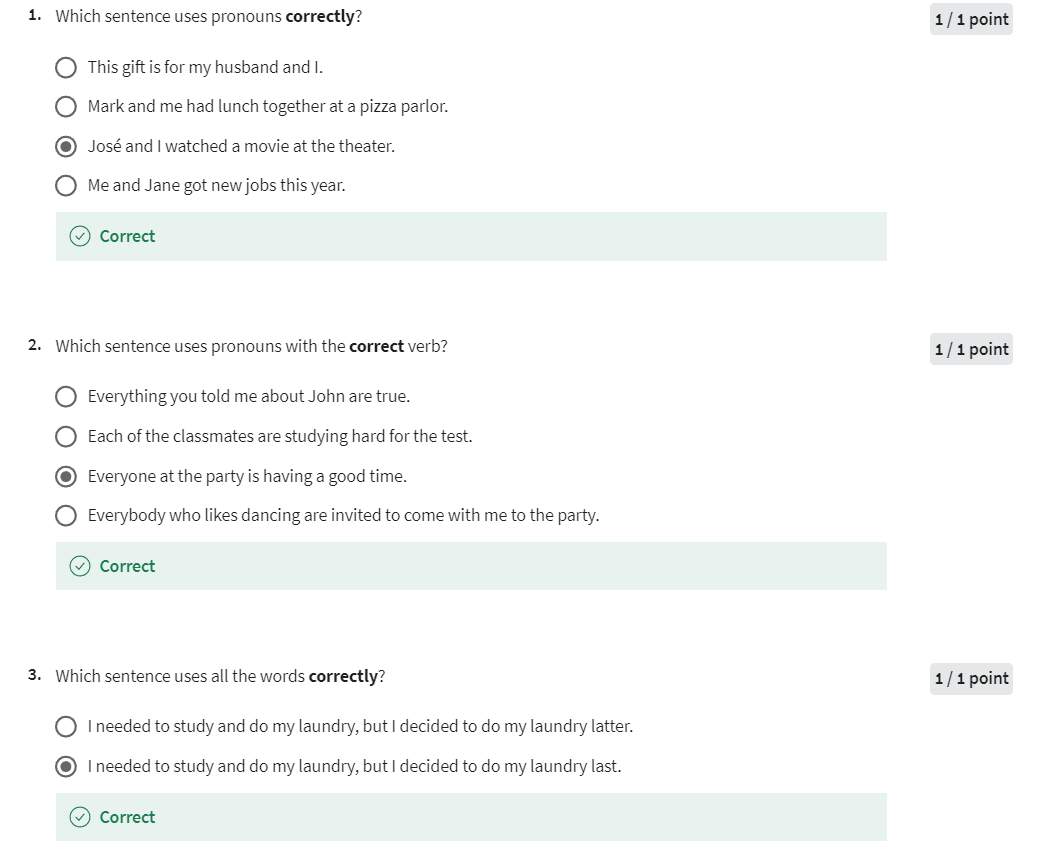
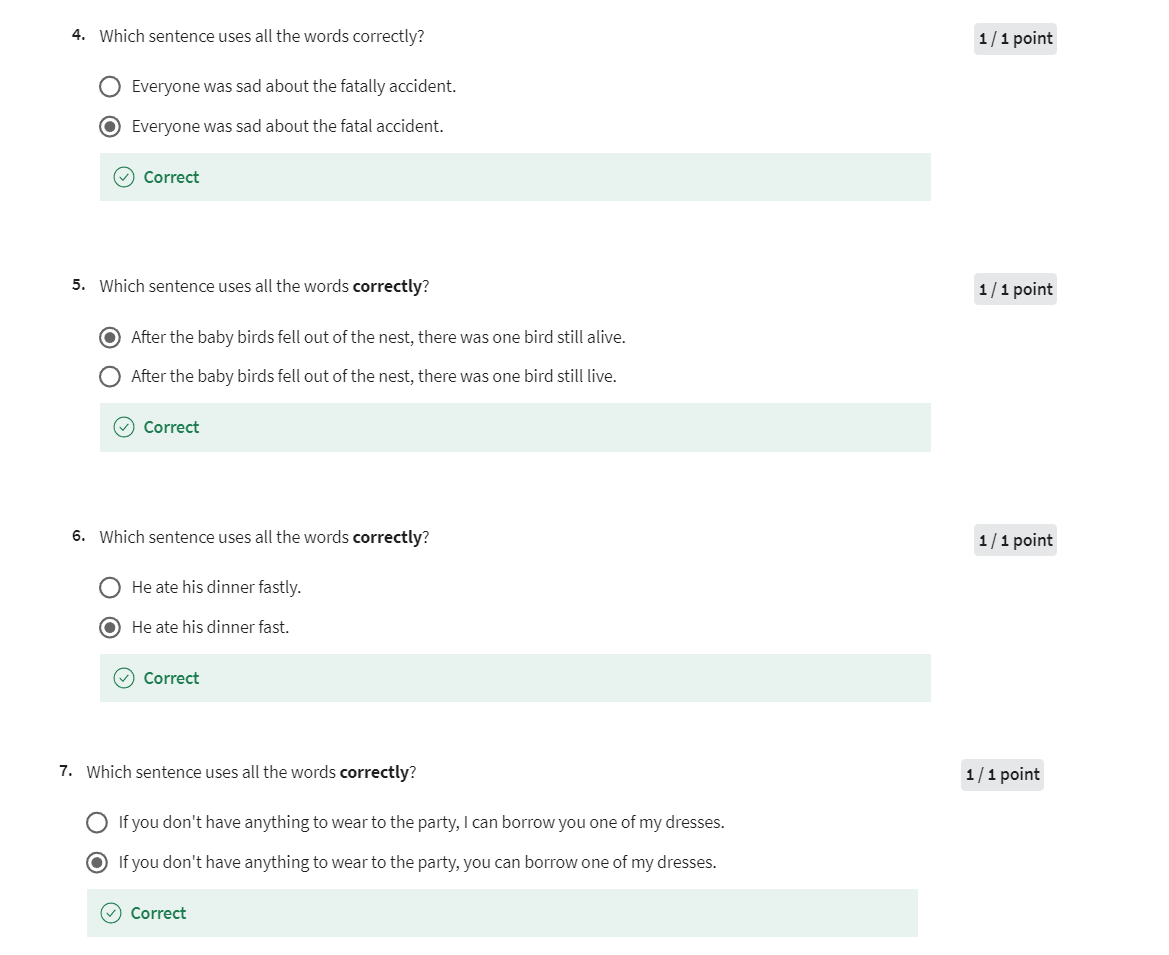
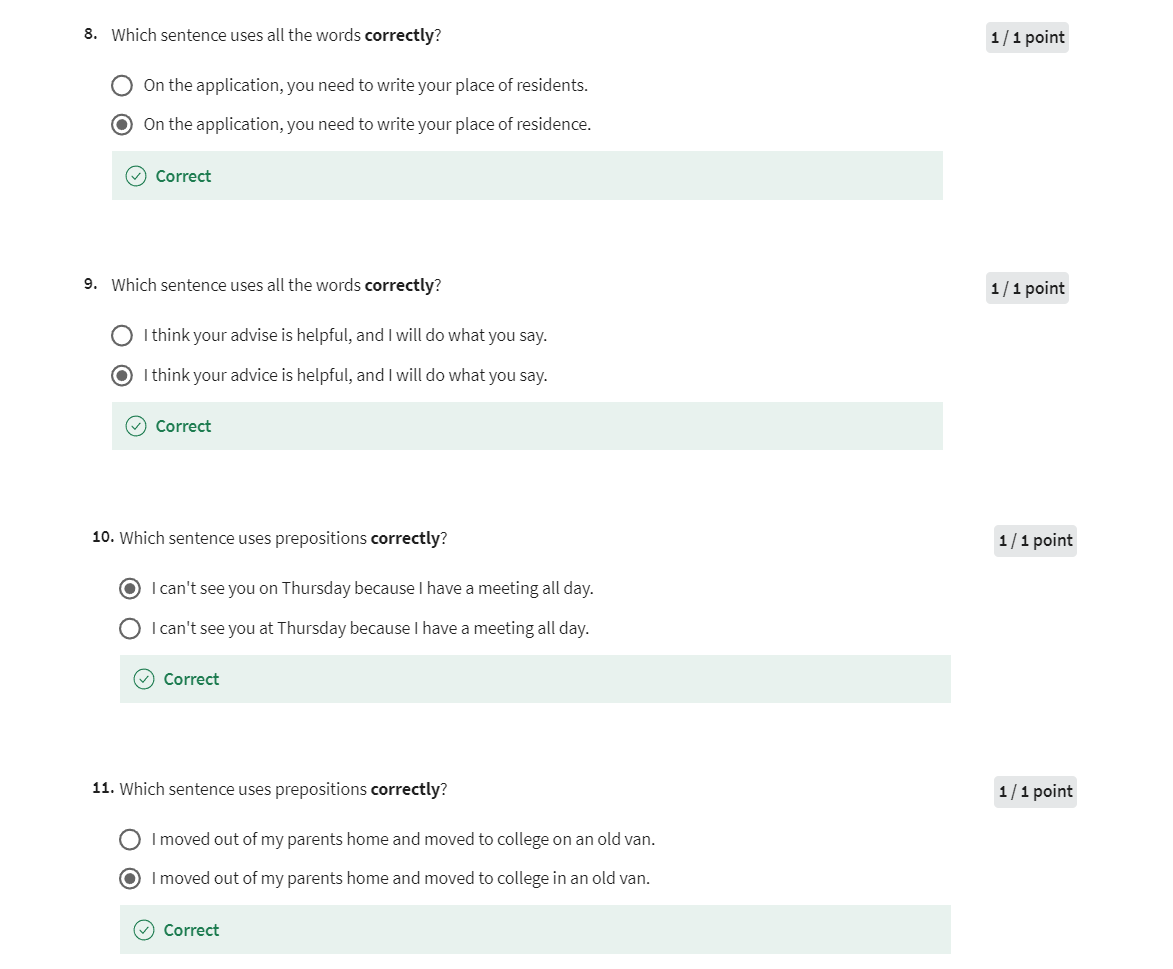
Week 04: Phrasal Verbs and Collocations
There are a few more tricky English points that we want you to learn. In the final week, you will learn about phrasal verbs and collocations. These are two big grammar points that often give language learners difficulty, but you will get lots of practice with them. Finally, you’ll have a review lesson of all of the tricky English grammar that you have learned in this course.
Learning Objectives
- • explain what transitive and intransitive phrasal verbs are
- • identify transitive and intransitive phrasal verbs
- • use transitive and intransitive phrasal verbs correctly
- • explain what collocations are
- • use some common collocations correctly
- • identify some common mistakes in sentences
- • correct some common mistakes in sentences
Phrasal Verbs Review Lecture
Welcome to Phrasal Verbs Review. Phrasal Verbs are combinations of
a verb and an adverb, like break away. Or, a verb plus a preposition,
like turn on. Here are some other
types of phrasal verbs.

Some phrasal verbs may
include three parts.
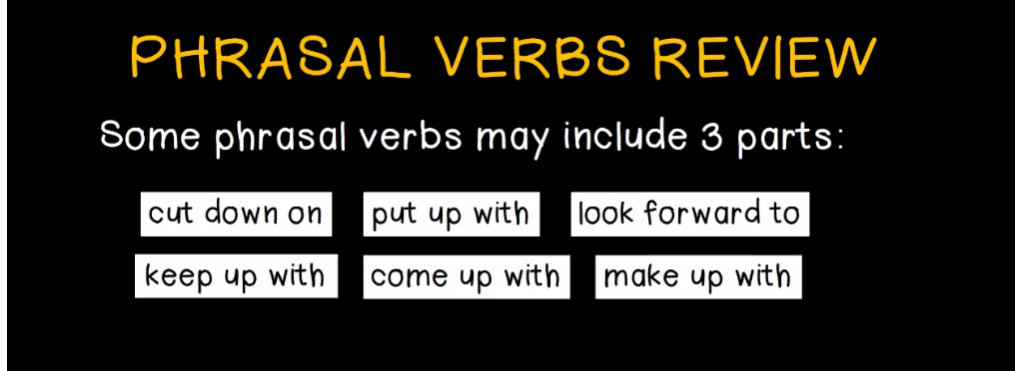
In this lesson we’ll look at
phrasal verbs in two parts. Part I- Types of Phrasal Verbs. And, Part II- Problems With Phrasal Verbs.
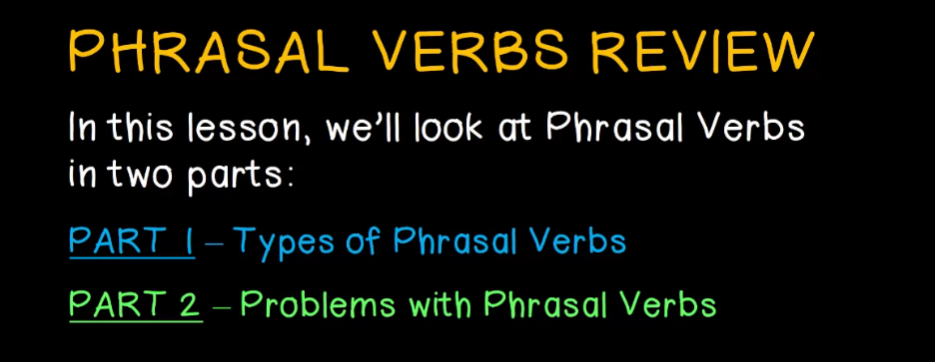
There are different types of
phrasal verbs, transitive and intransitive, and
separable and inseparable. First, let’s review what transitive and intransitive means when
talking about verbs. It means that after the verb
comes the adverb and preposition, what goes with the specific verb. And then the direct object, meaning,
the who or what receiving the action. The direct object must be included
with transitive phrasal verbs. Trans means to cross, so
the action of the verb, adverb or preposition combination,
needs to cross into a person or thing.
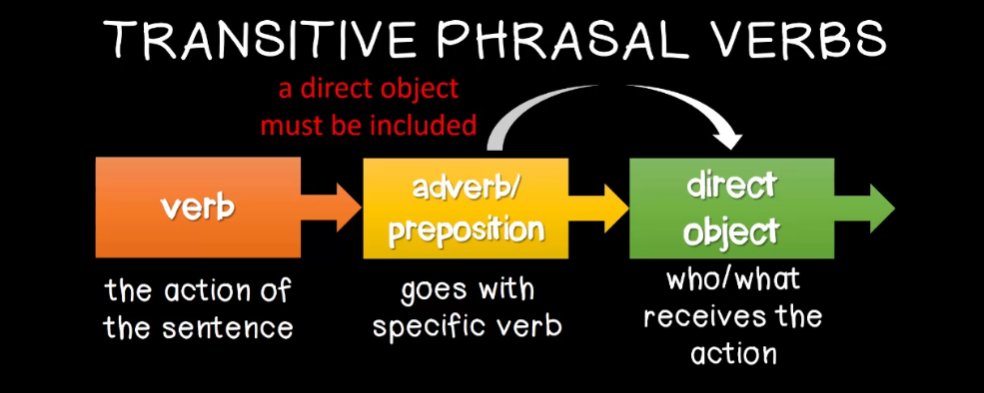
But with intransitive phrasal
verbs no direct object is needed.
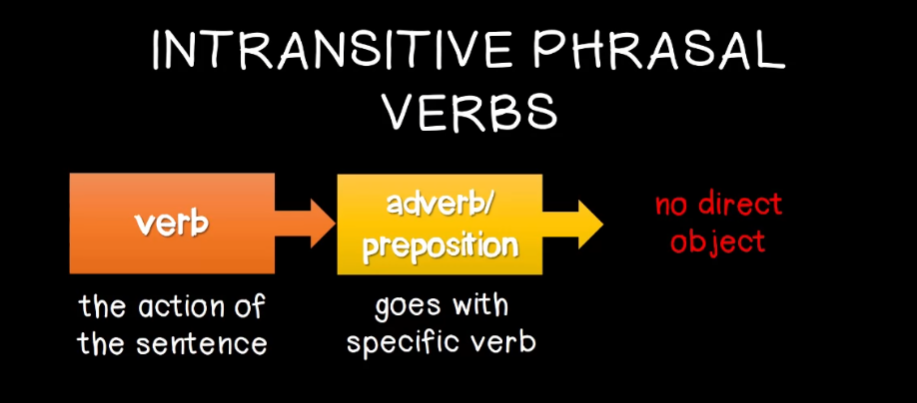
So let’s look at some examples of both
transitive and intransitive verbs. The teacher called on
the sleeping student. The sleeping student is the direct object. The police are looking into the the crime. The crime is the direct object. With intransitive, we often eat out. However, it does not have a direct object. He was too tired to get up,
also doesn’t need a direct object.

Be careful,
some phrasal verbs can be transitive and intransitive, but with different meanings. For instance, look up,
as a transitive verb can mean, check a dictionary for a word. As in, Stan looked up the new word. Or look up can be intransitive and
can mean improve. As in, Maria lost her job but
now things are looking up.
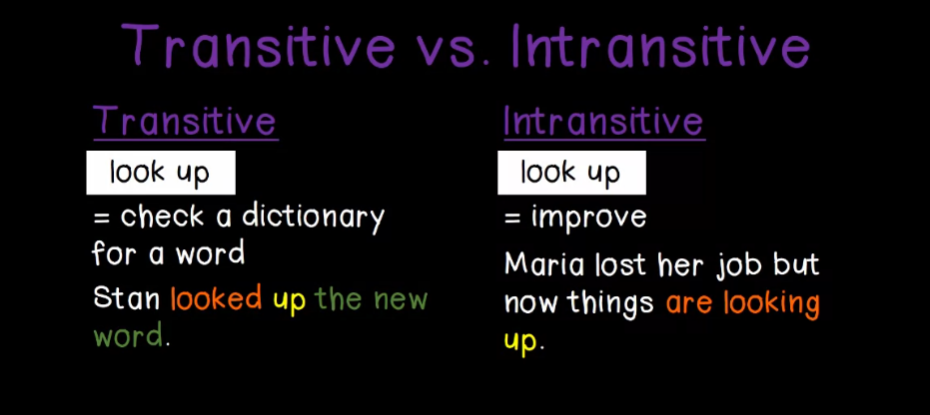
Here are some other examples
of transitive phrasal verbs. And some examples of
intransitive phrasal verbs.
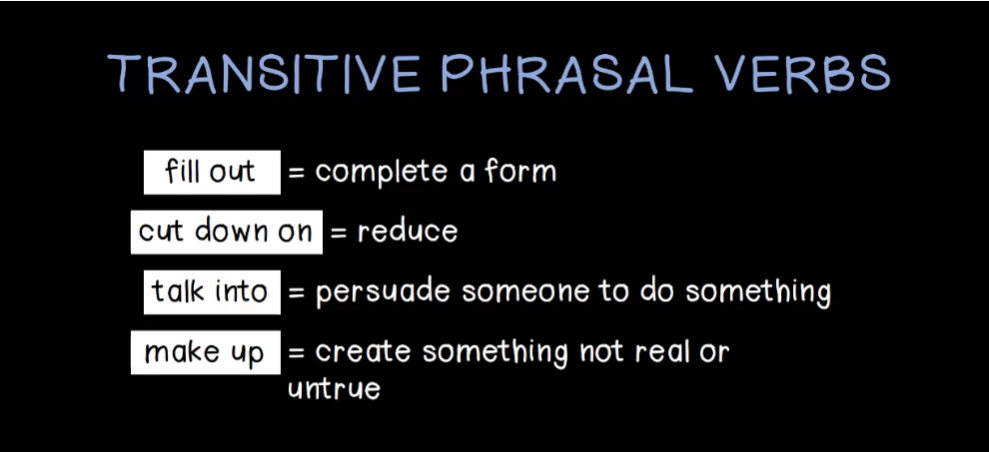
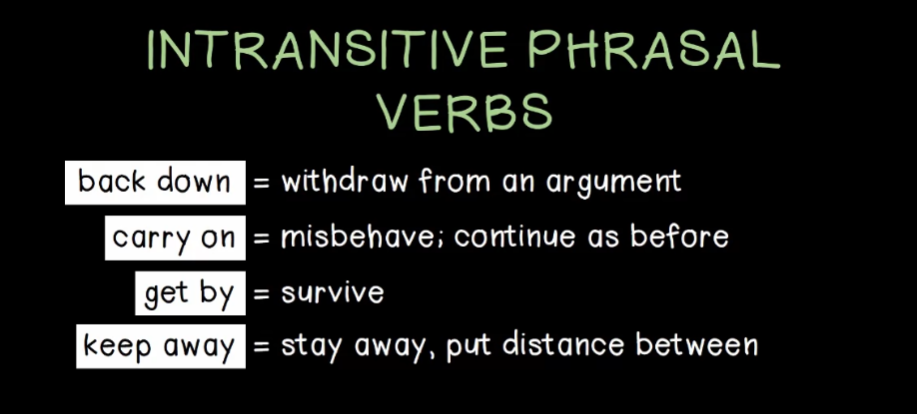
Check a good learners’ dictionary,
online or in a book, to find out if a phrasal verb is transitive or
intransitive if you aren’t sure. Some phrasal verbs can be separated by
the direct object, and some cannot. Instead, the direct object separates
the verb and adverb or preposition. These are called separable verbs. But only transitive verbs can
be separable or inseparable, since transitive verbs
need direct objects. For example, blow up can mean
explode like a bomb or in anger. The army blew up the mine. Where the mine is the direct object
after the verb blew, and adverb, up. Or we can say the army blew the mine up. Where now the direct object
separates the verb and adverb.
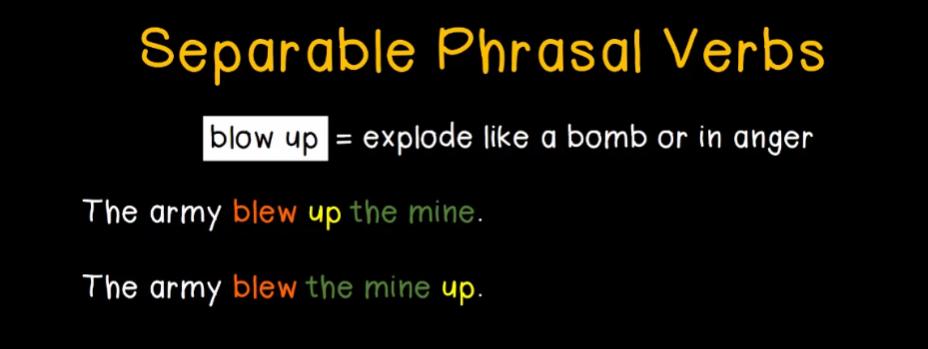
Call off means to cancel an event. As in, the manager called off the meeting. Or, the manager called the meeting off.
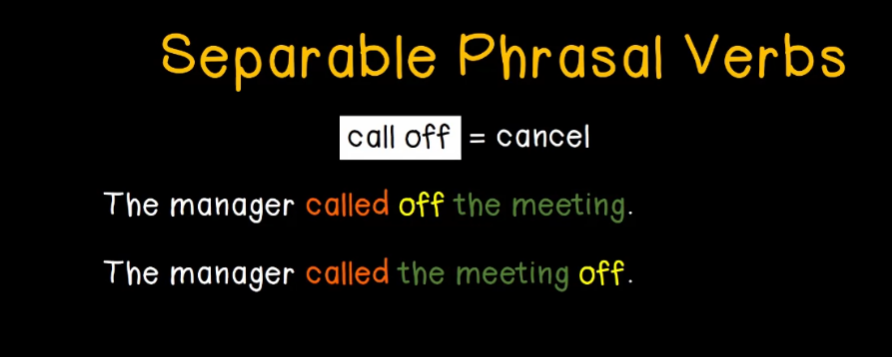
Pick out means to choose or select. We can use either sentence like,
Janet picked out her wedding dress. Or, Janet picked her wedding dress out.

With these sentences we can replace
the direct object with a pronoun. In these sentences we use, it. When we use a pronoun we must
separate the verb from the adverb or preposition if the phrasal
verb is separable. With really long direct objects, separable phrasal verbs should stay
with their adverb or preposition. For instance, Margo turned down a job
because it didn’t pay enough money. A job is the direct object in very short. Now let’s look at the sentence, Margo turned down a job that offered
her half of her current salary. That offered her half of her
current salary describes a job and makes the object very long. It’s easier to keep the verb, turned,
and adverb, down, together as a group.
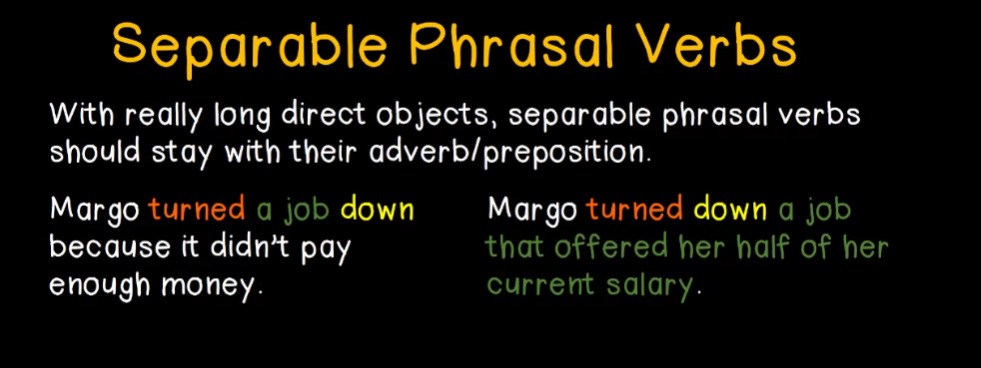
But with inseparable verbs, the verb and adverb preposition cannot be
separated from each other. They must go together
without interruption.
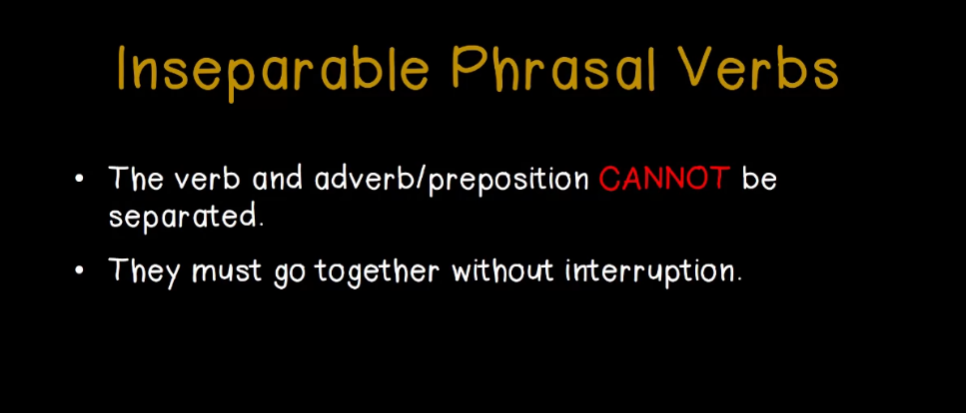
For example,
come by means to find by accident. As in the sentence,
Walt came by a hundred-dollar bill, But we cannot say,
Walt came a hundred-dollar bill by. Live on means to support oneself. For instance,
some people live on very little. But we can’t use,
some people live very little on.
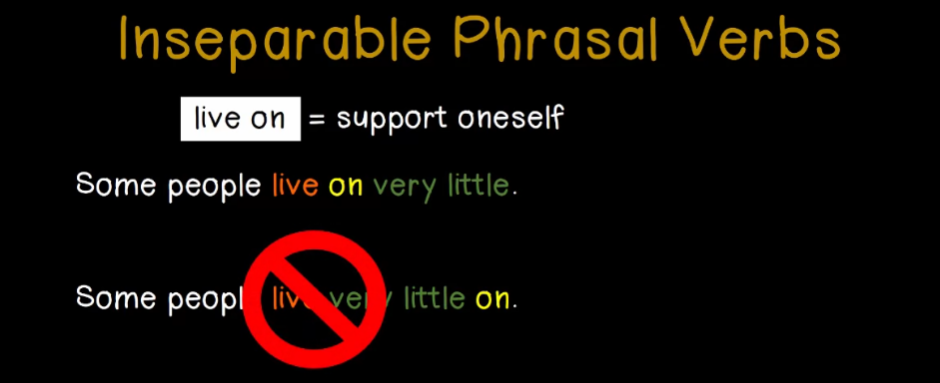
Take after means to look like or
resemble someone else. We could use the sentence,
George takes after his mother. But not, George takes his mother after. So in this lesson,
we reviewed the types of phrasal verbs, which are transitive and intransitive,
and separable and inseparable.
Problems with Phrasal Verbs Lecture
Welcome to part two of phrasal verbs. In this lesson, we will focus
on problems with phrasal verbs. But what makes using phrasal verbs so
troublesome? Well, there are a few things that
can make phrasal verbs difficult. One reason is the transitive and intransitive confusion, which goes with
the separable and inseparable uses. But phrasal verbs are also hard because
they have multiple meanings and are very idiomatic.
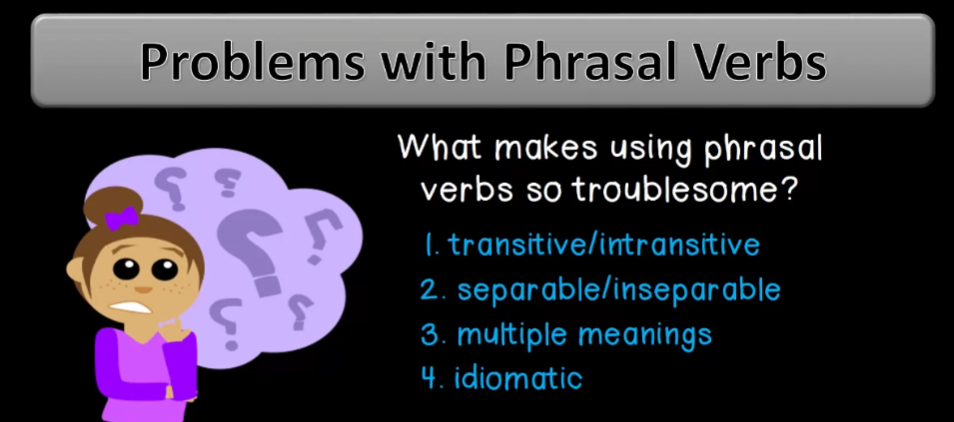
Remember from the review lesson,
transitive means a verb, an adverb, or preposition need to be
followed by a direct object. Intransitive means you
don’t need a direct object, and in fact, this is an error
if you add a direct object. For example, for
transitive verbs we can say, the teacher called on
the sleeping student. And the police are looking into the crime. And some examples with intransitive
verbs include, we often eat out and he was too tired to get up. It’s important with transitive phrasal
verbs, you have the direct object. Not having a direct object is a mistake
you need to avoid with phrasal verbs. Within intransitive phrasal verbs,
for example, we often eat out. And he was too tired to get up. If we add a direct object to these
types of verbs, that’s a mistake. If you’re not sure about which verb
is transitive or intransitive, check a good learner’s dictionary.
These will include notes about transitive
or intransitive status of phrasal verbs. Good learner dictionaries will
include notes about separable or inseparable status,
inseparable in this example. In fact, some dictionaries
will only state separable or inseparable and you need to remember. Only transitive phrasal verbs
can be separable or inseparable. Separable means that the adverb or preposition can be followed
by the direct object, or the direct object can be after the verb
and before the adverb or preposition.
So in the example of blow up,
it is a separable phrasal verb and can be used in a few ways. The army blew up the mine. The army blew the mine up. Or the army blew it up. It is better when using
pronouns to always separate.
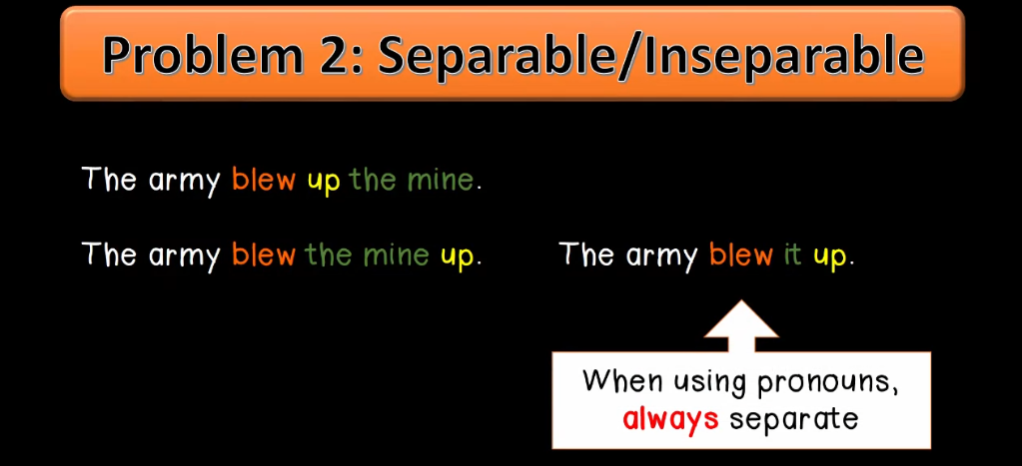
And some phrasal verbs must be separated. They follow three patterns. The first is verb plus direct object,
plus adverb. Like to ask someone back, meaning to
invite someone to return for a visit. Or to have something on,
meaning to wear clothing. Another pattern is verb
plus direct object plus preposition plus the object
to go with the preposition. For example, leaving someone for something, meaning abandon someone for
a reason. And run something by someone,
meaning share an idea with someone. The third pattern is verb plus direct
object plus adverb plus preposition and lastly, another direct object. So we end up with a long expression,
like make it up to someone. Meaning, you make a mistake and
promise to fix it. Or, pass something off as something else. Meaning, to say something fake,
like a purse, is real.
Here are some sample sentences with
our separable phrasal verb patterns. We asked back the professor who
lectured about global warming. He ran a new design by his boss for
her approval. Since he missed her birthday,
he made it up to her by taking her for a weekend to San Francisco.
Another problem for English learners is that phrasal verbs
often have more than one meaning. But how can you know
which meaning is used? Let’s take, for example, take out, which can mean borrow a library book or
go on a date with someone. For instance, I need to take out a book
about geology for my research paper. Or Jack wanted to take Sally
out on a date, but she said no. How can you know which
meaning of take out is used? You look at the context or
situation of the sentence. From the first sentence,
it’s clear we are talking about a book. In the second, we can see between
a man and a woman going on a date. We’re using the second meaning.
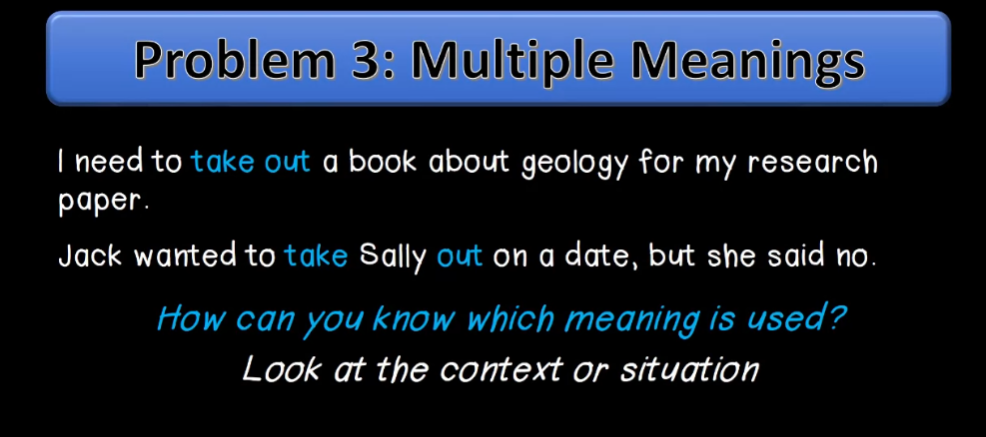
The last and maybe biggest
reason phrasal verbs are hard, is that they are very idiomatic. That means that the parts
don’t add up to the meaning. These types of idiomatic expressions are
natural for native English speakers, and make them very difficult to teach. Let’s look at turn, which usually
means a to twist a knob left or right. The adverb, off, means to separate or
remove but the preposition on, means physically in contact with and
supported by something. If we put the parts together, turn and
off, doesn’t seem to add up to turn off, meaning to switch off something
electronic like a computer or TV. And turn on doesn’t add up to meaning
to switch on something electronic like a computer or TV. Some phrasal verbs can be hard because we
cannot guess the meaning of the phrasal verb by knowing the parts. You need to learn and
study these words in groups. How can you study phrasal verbs? Treat them more like vocabulary words and
study them in groups. You can learn them by focusing
on a verb such as get, and learn the meaning of adverbs or
a preposition combinations. For example,
get out means be forced to leave.
Get up means to wake up and
get out of bed. Get in means to step inside
a vehicle like a car. Or get with, meaning to meet someone. Another way to study groups is to focus
on the adverb or preposition, and the combinations of verbs. So you can focus on out, and
speak out means to argue against an idea.

Take out means borrow a library book or
go on a date with someone. Get out means to be forced to leave. Walk out means to leave in anger. Lastly, turn out can mean to eject or
banish. In this lesson, you learned phrasal
verbs are difficult because they could be transitive or intransitive,
separable or inseparable. They have multiple meanings and
those meanings can be idiomatic. Thanks for listening.
Phrasal Verbs Practice
Practice
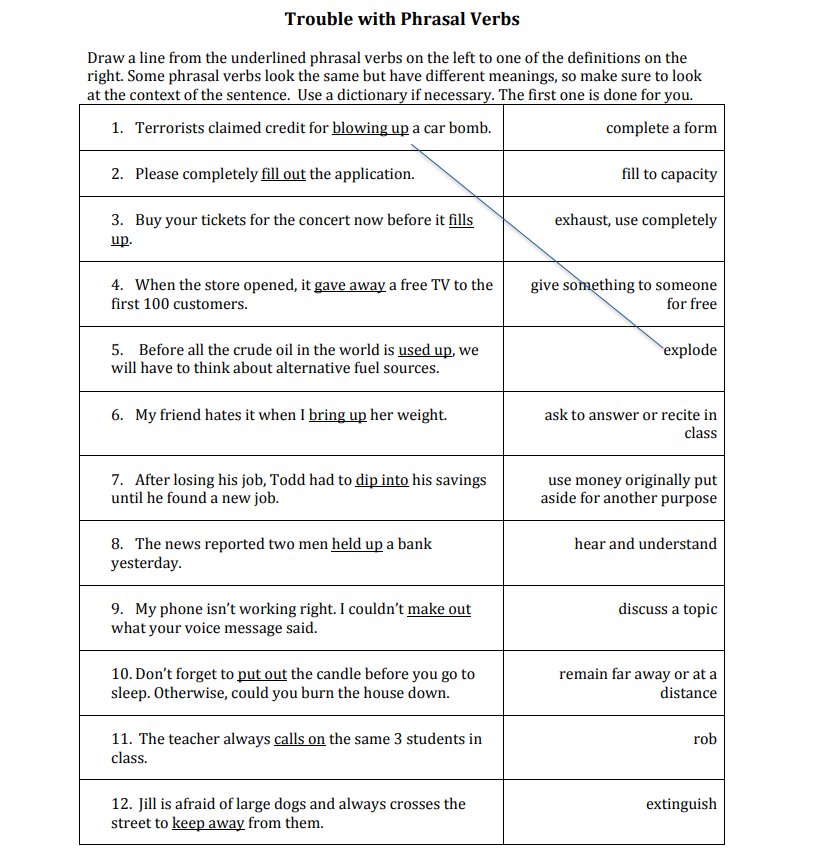
Practice key
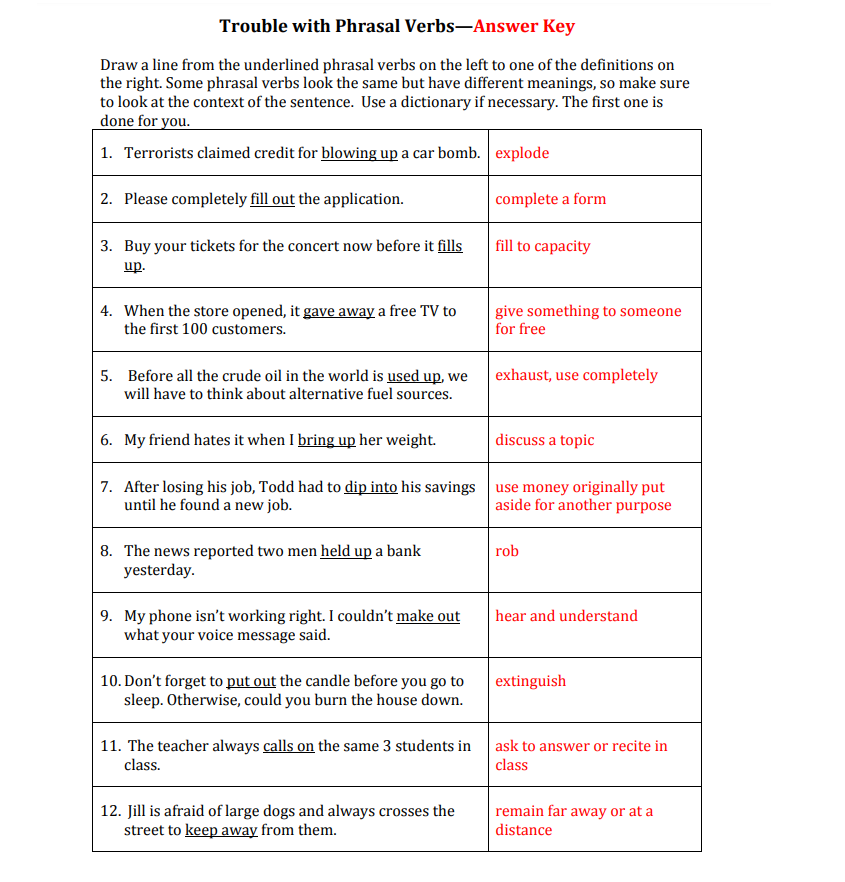
More practice
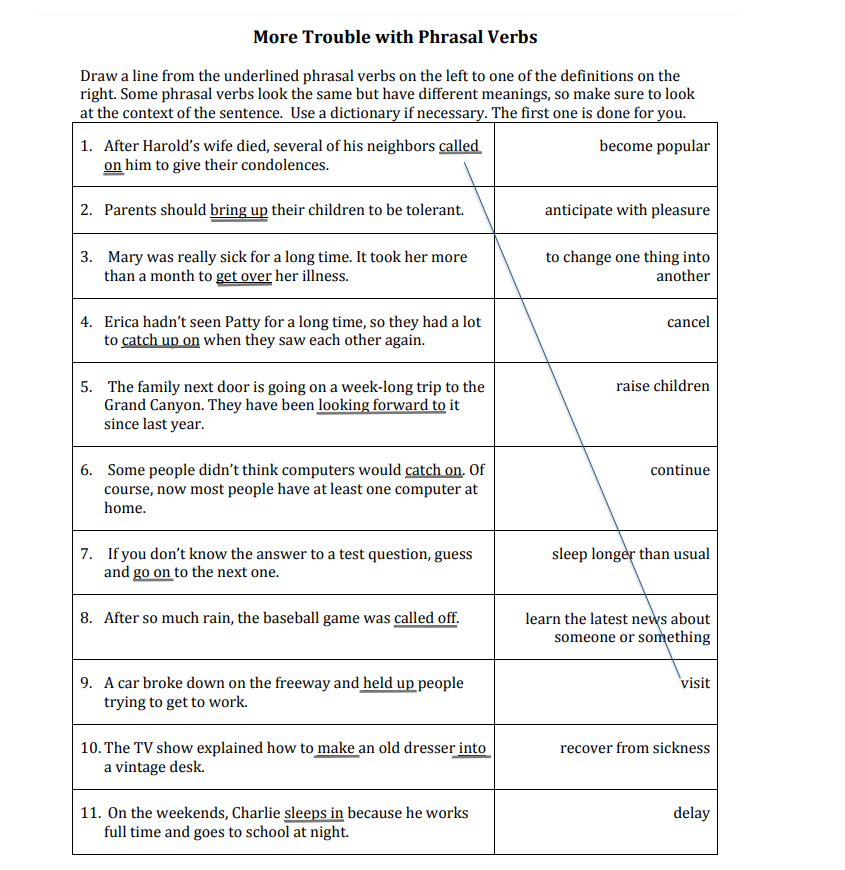
Key
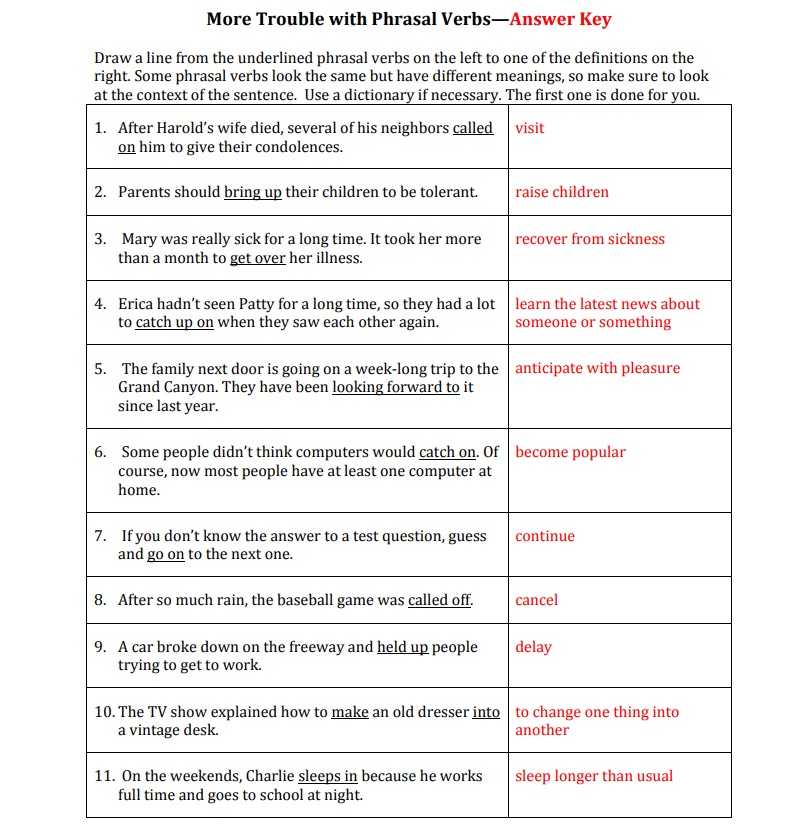
Phrasal Verbs Practice Quiz
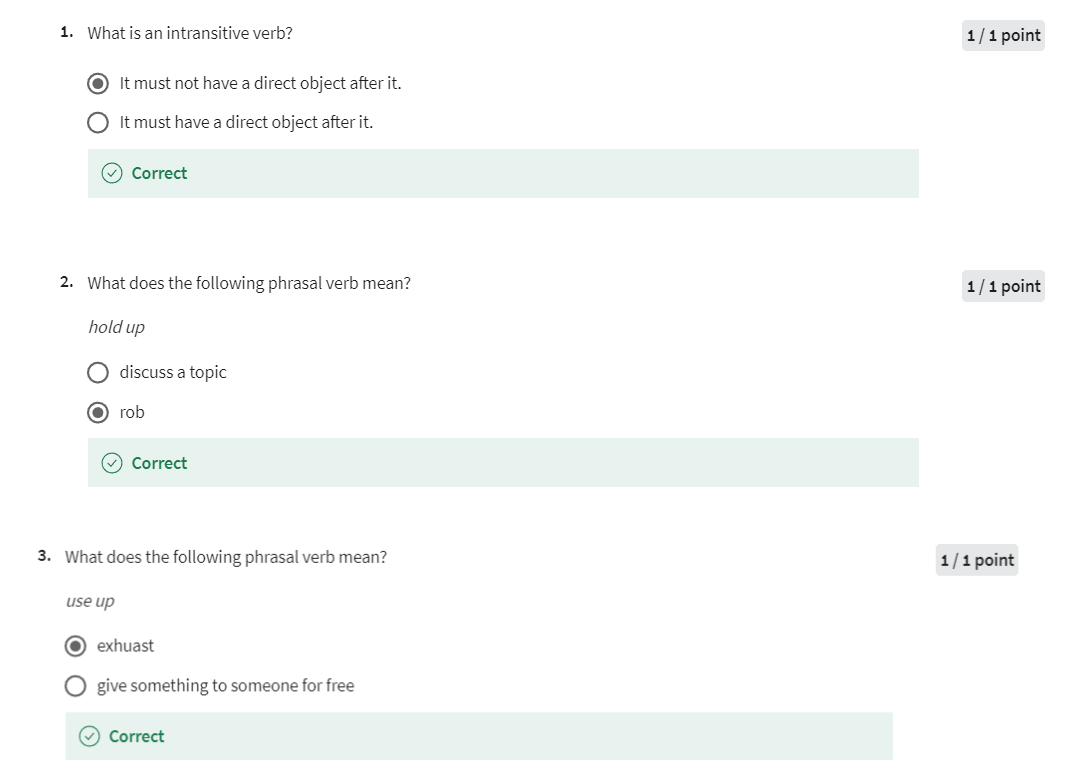

Collocations Review Lecture
A Review on Collocations. Hi, my name is Vera, and
I was born in the United States. My father, on the other hand,
was not born here. He moved here,
not knowing any English, and slowly learned English, over the years. Sometimes, when I talk to him,
he would use some strange English. For example,
he would say things like, wow, that girl has a shiny smile. Don’t drive crazily! You may have a car accident. Can you open the lights? I can’t see. That man’s singing is very amazing! I hate cleaning the laundry.
I always told him,
dad you’re saying it wrong. It should be, wow,
that girl has a bright smile. Don’t drive recklessly,
you may end up in a car accident. Can you turn on the lights? I can’t see. That man’s singing is truly amazing. I hate doing the laundry.
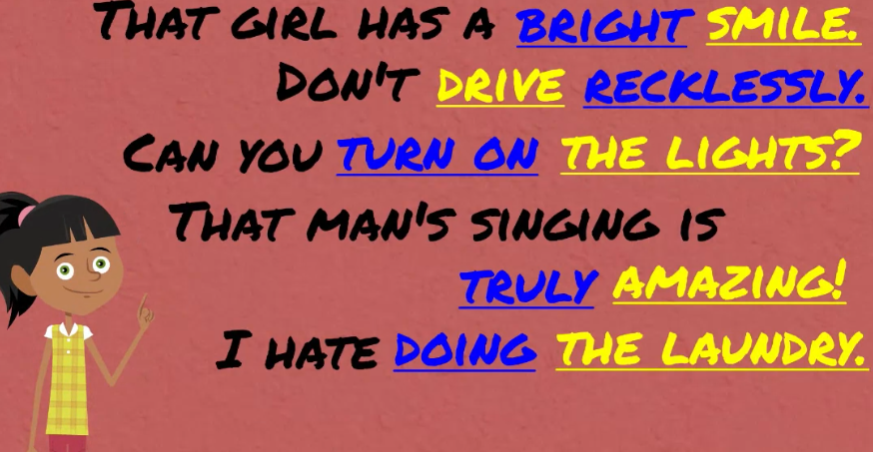
He would say, so confusing and it is.
And this is my introduction
of collocations, collocations are words that
frequently go together. A native speaker would not say
someone has a shiny smile. He would say that the girl
has a bright smile. When we describe a smile,
there are specific words to use. This is true for the rest of the examples
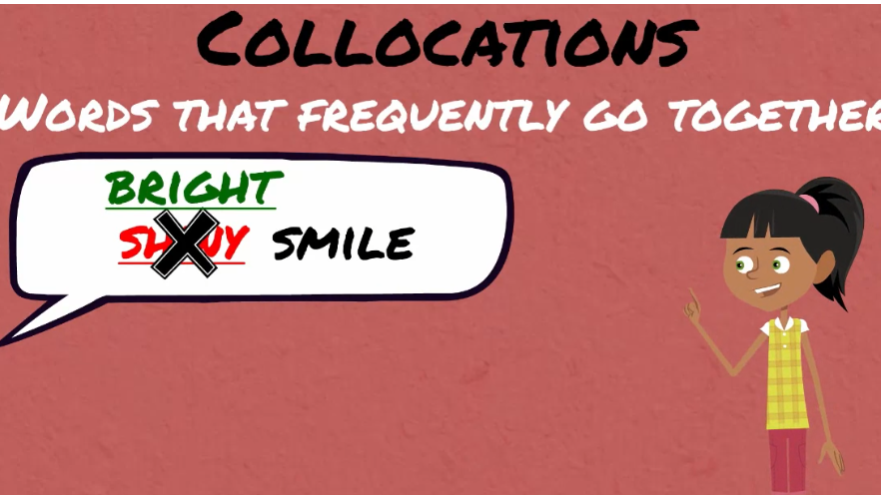
There are many different
types of collocations. I will highlight the more common
combinations with some examples in the table. We have Adjective + Noun,
Noun + Noun, Noun + Verb.

Then we have Adverb + Adjective Verb +
Preposition, also known as Phrasal verbs. Verb + Adverb and Verb + Noun.
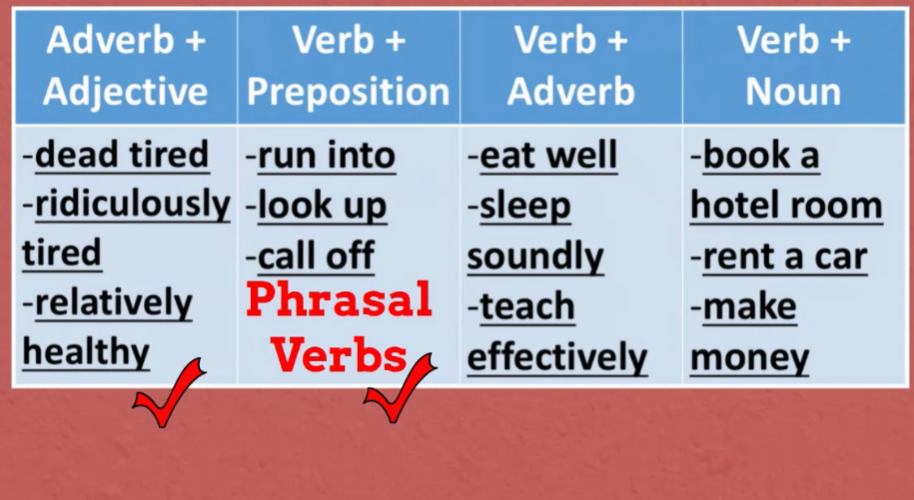
As you can see from the examples,
the underlined words go together. There is no fixed rule based
on the form or the meaning. To a native English speaker,
they just think, yeah, it sounds right. This way of thinking is a challenge for
non natives speakers. The next videos will reviews
some of the common errors.
Tricky Collocations Lecture
Tricky Collocations. From the previous video you have and
understanding of what collocations are. They are words that
are frequently used together. Non-native speakers find
them frustrating and often make mistakes because there are no
fixed rules about the form or meaning.
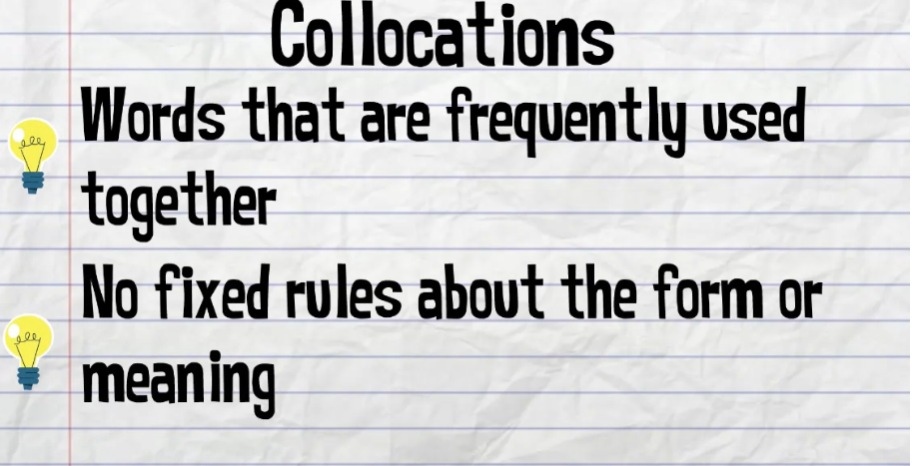
Maybe you are wondering why it’s so
easy to make mistakes. Most of you are probably thinking,
well I need to study more. That may be true, but
there’s also another reason. It is possible that many of you
are thinking about how to say something in your first language. So you directly translate it into English. Let me give you an example. My mother speaks Cantonese, and when she talks about her hobby of reading
books, she says, I like to watch books. In Cantonese, it’s possible to use
the same Chinese character of watch for books, magazines, TV,
movies, even scenery. However, in English we
would say read books and magazines, watch TV and movies,
and look at the scenery. Are you confused? Yes, English is quite complicated.
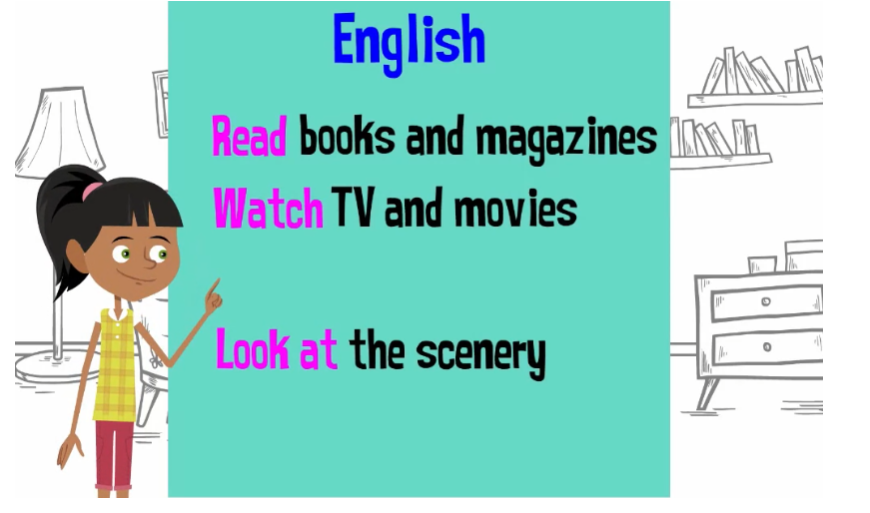
I have gathered a list of collocation
problems that other teachers have noticed in their non-native English students’
speech or writing, quite a lot, right?
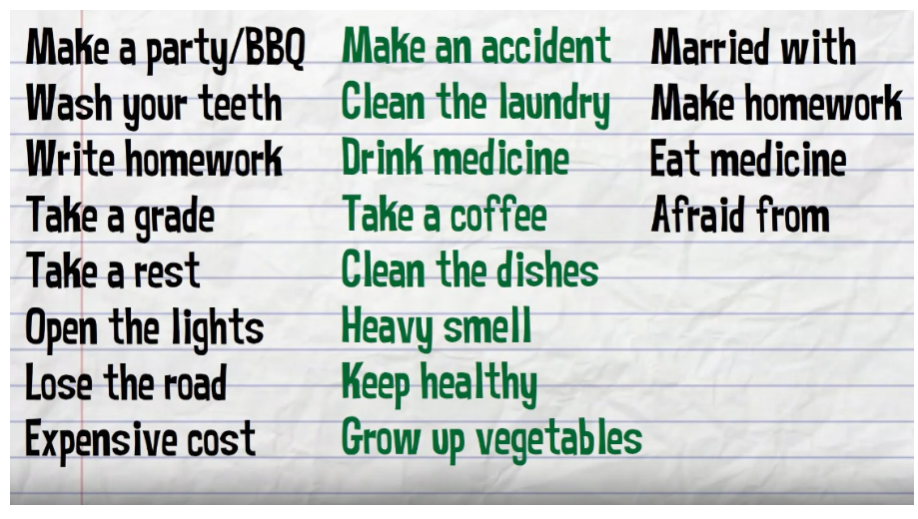
Well in order to review
them in an organized way, I would like to invite you to my
collocations house and give you a tour. Each part of my tour will have some
underlined incorrect collocations on small note sheets, so follow closely. Here at the front door,
I see the first one. It says, don’t open the outside
lights during the daytime. Hm, I think she means don’t
turn on the outside lights. We turn on and off lights,
not open or close.
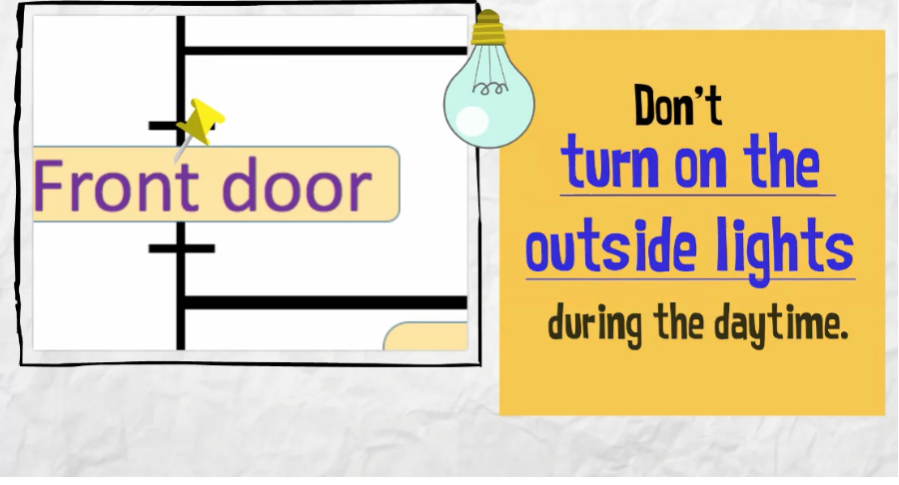
Open and close are for doors,
windows, closets, drawers. Next we walk into the kitchen. Hm, some notes here. Okay, let’s take a look. I am cooking coffee. Do you want to take a coffee? It has a heavy smell. But don’t drink too much coffee. If you want to keep healthy,
tea or water is better. In this case, you cannot cook drinks. You can make drinks,
like make coffee or tea or even soup. Also, we do not say take a coffee,
we say have coffee or drink coffee. I have coffee every morning.
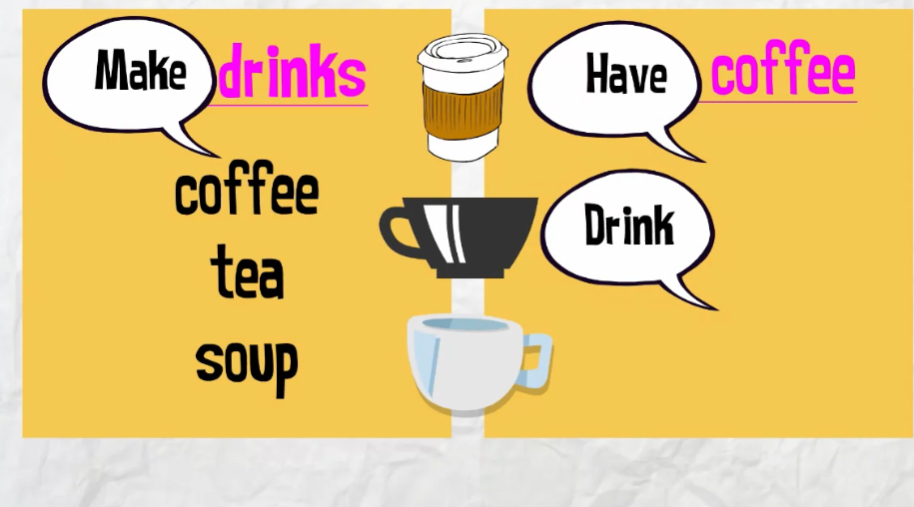
When you describe a smell,
it is not possible to say heavy. Instead, use strong or weak,
like the coffee has a strong smell.
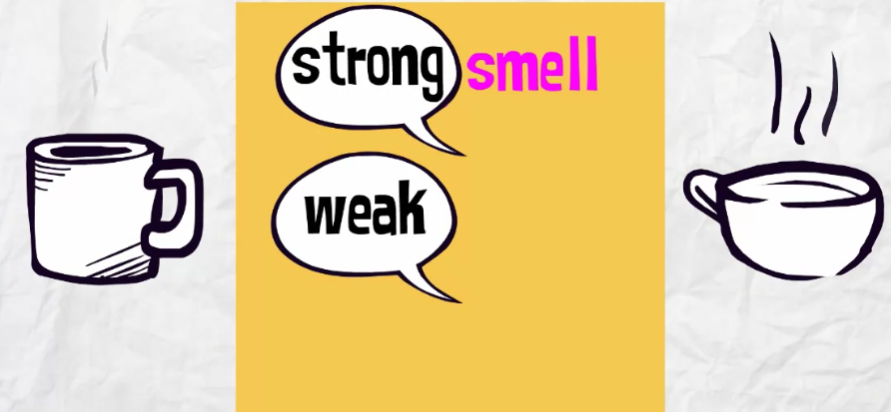
Finally, I think keep healthy
means continue to be healthy. You can’t use keep,
you should say stay, stay healthy. It is common to use stay with adjectives
like stay happy or stay young.
Okay, the second note is on the sink. You have to clean the dishes every night,
hm. Even though clean the dishes makes sense, native English speakers
don’t use that collocation. They use wash the dishes or do the dishes.
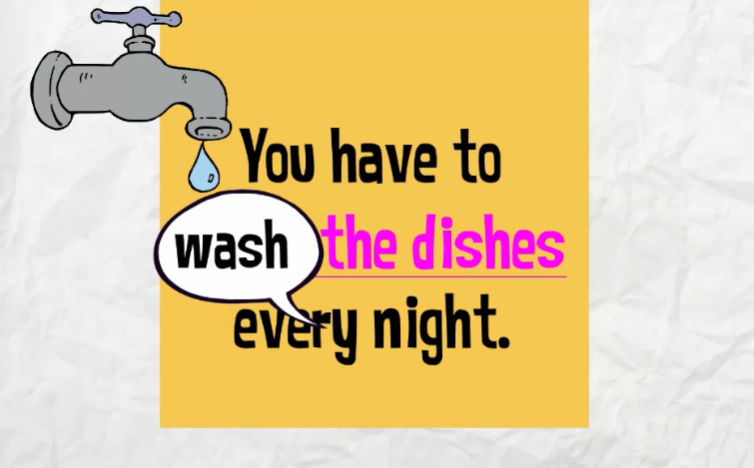
There’s a note on the medicine cabinet. If you have a headache, eat the aspirin. If you have a cough,
drink the cough syrup. Here, aspirin and
cough syrup are both types of medicine. In general, you do not say eat medicine or
drink medicine. The correct way is to say take medicine. Take works for almost all situations. Take aspirin, take cough syrup.
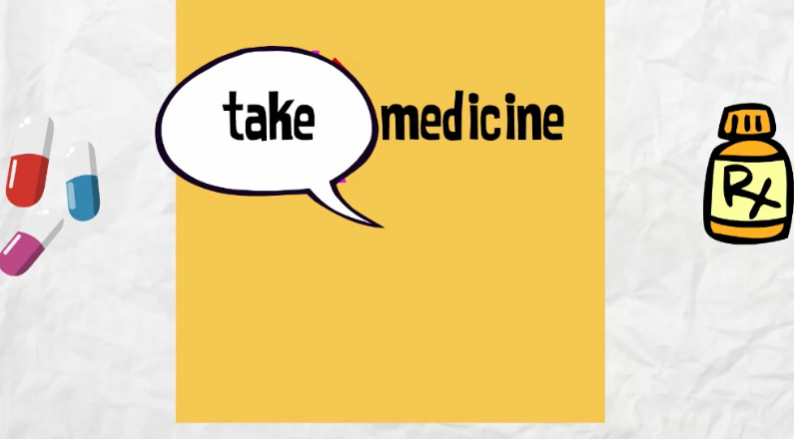
Moving to the bedroom,
there’s a note on the bed. It says please take a rest. Some people, especially in the USA,
feel that this collocation is strange, because they would say take a break or
get some rest.
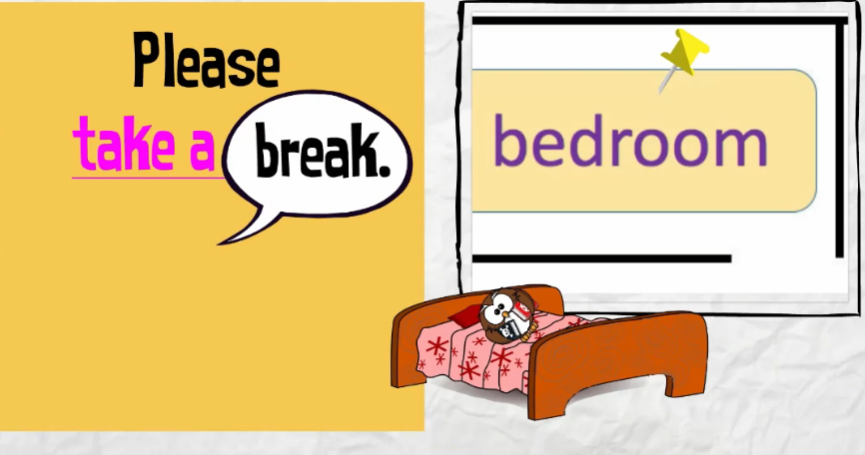
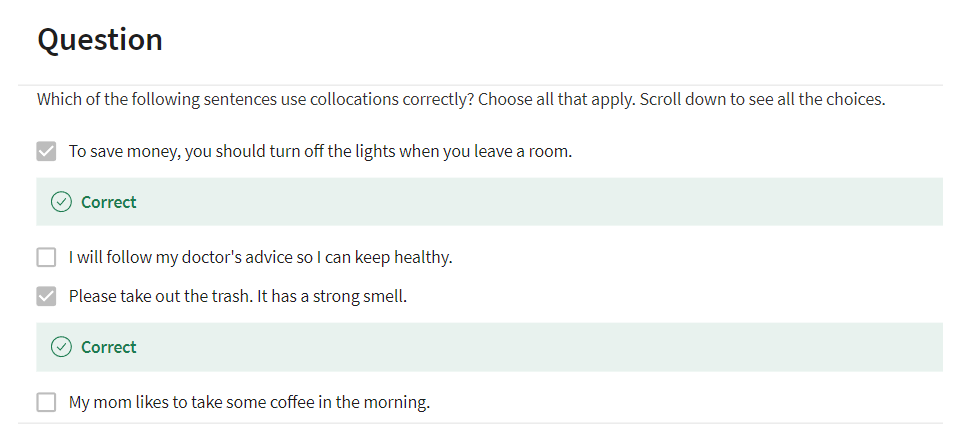
There’s another one on the desk. Write your homework every day. Then you can take a good grade. Actually, write homework or
even make homework are wrong. We actually say do homework. When we talk about grades, we use get,
get a good grade or get a bad grade.
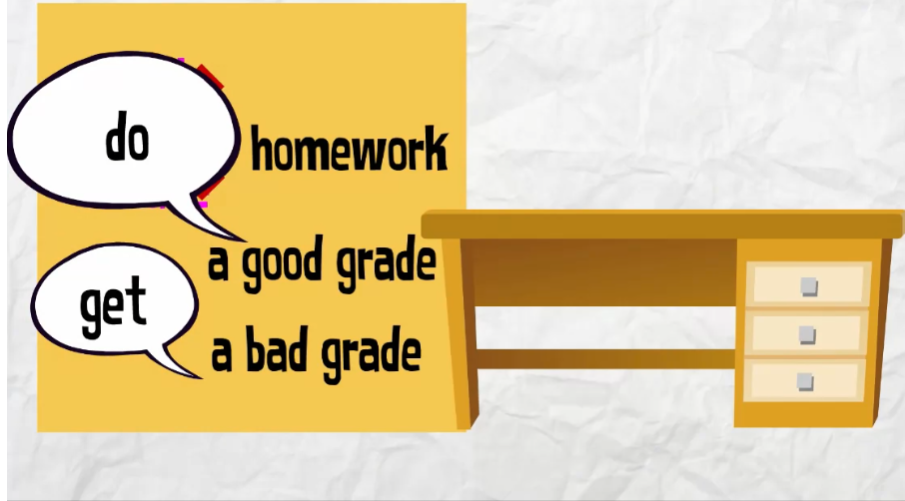
Let’s take a look at the bathroom. There’s a note near the toothbrush. It says wash your teeth every morning and
night. Well, people don’t
actually wash their teeth. They brush their teeth with a toothbrush. If they go to the dentist,
then the dentist cleans their teeth.
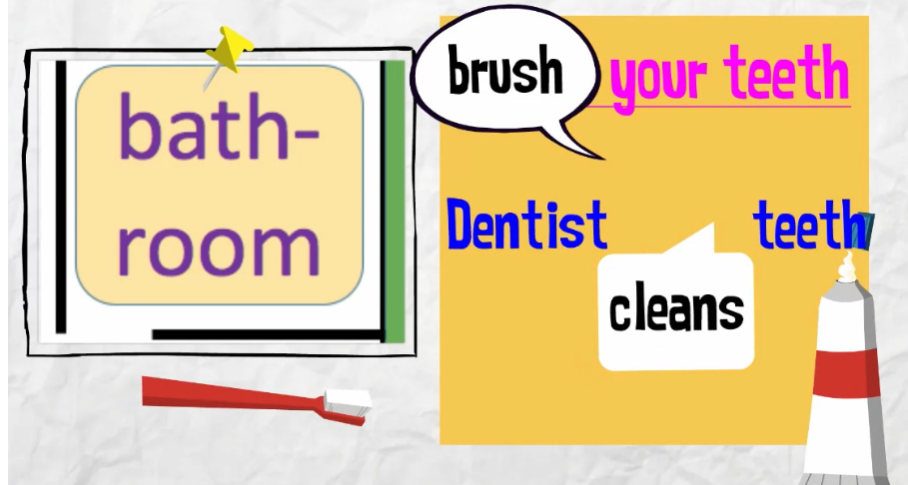
Okay, now it’s time to
look at the backyard. A backyard is an outside area
that belongs to the house. Some backyards have gardens. The note here says, the backyard is a good
place to make a party or a barbecue. If you grow up vegetables or fruit,
you can serve them at the party. Sometimes, the garden has spiders. But don’t be afraid from spiders,
they are harmless. First we don’t make parties, we have them. It’s natural to say, let’s have a party,
or let’s have a barbecue.
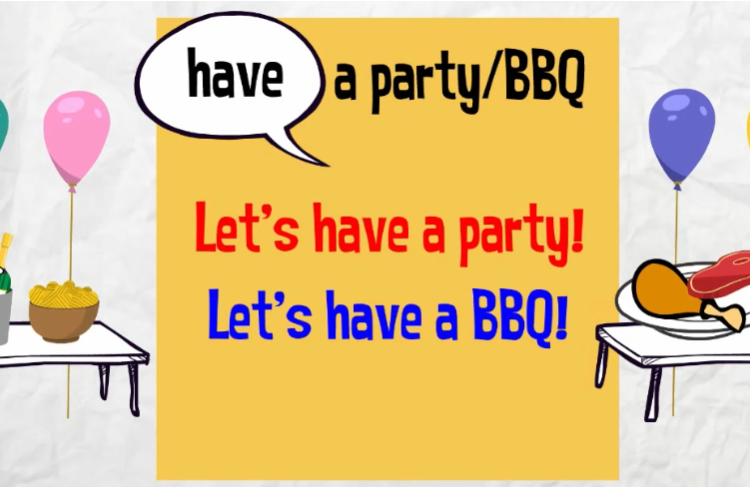
Also, you don’t grow up vegetables or
fruit, you just grow vegetables and fruits. There is no up, or
you can say plant vegetables or fruit. Lastly spiders, I actually hate spiders,
but I am not afraid from them. I am afraid of them. Be careful with prepositions.
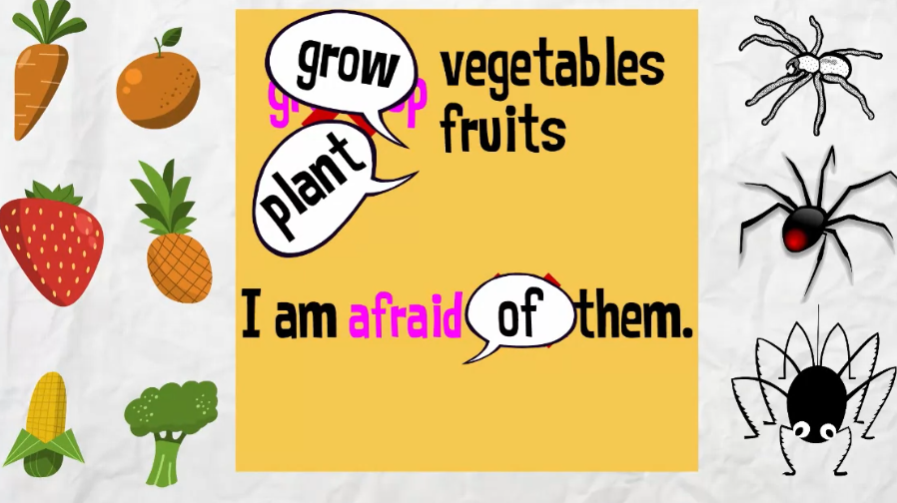
The last place is the garage. There is a washing machine and
dryer here with a note. It says save water by cleaning
the laundry once a week. Once again, clean sounds strange here. Native speakers say do the laundry. Laundry actually refers to both
washing and drying the clothes.
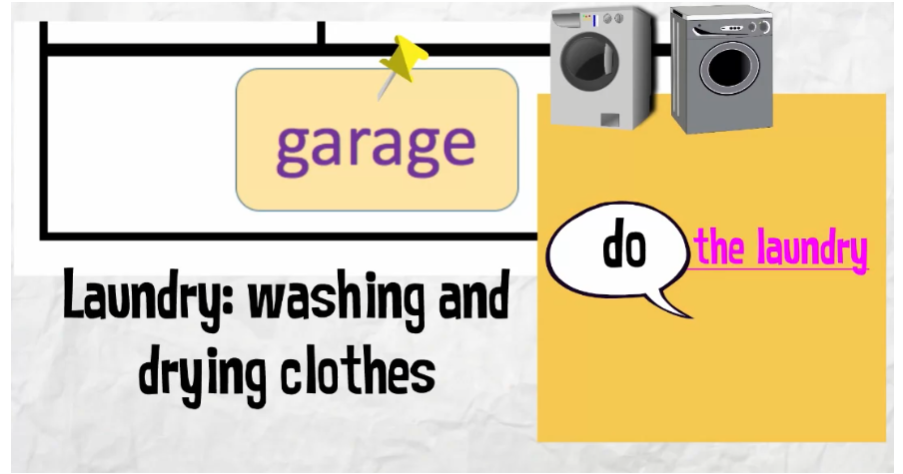
Next, there’s a very nice sports car
in the garage with another message. This car has an expensive cost,
please take care of it and do not make an accident. Also, if you lose the road,
don’t worry, the car has a GPS system. There are three mistakes. First, we don’t say that
something has expensive cost. We just say the car is expensive. Also, when we talk about accidents, we get
into an accident or cause an accident. Finally, we don’t lose the road. If we cannot find the way,
we will say we get lost.
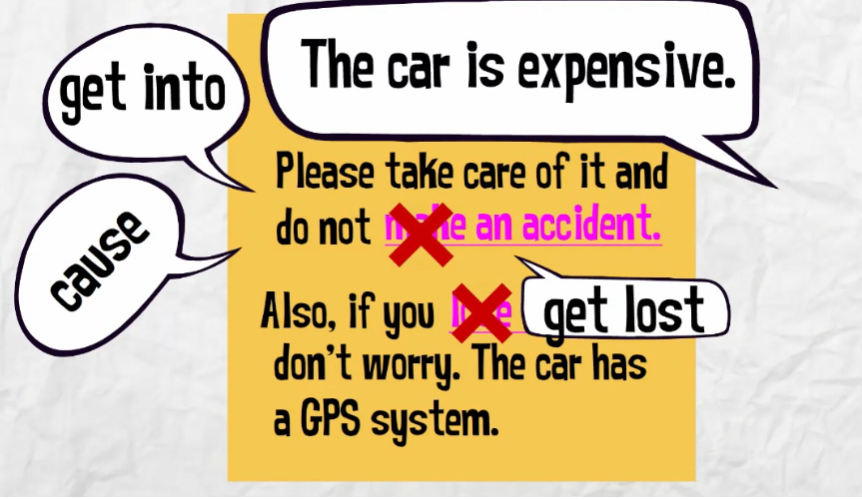
Phew, let’s go back into the house. It’s almost time to go home,
but here’s one final message. It’s on the picture frame. There are two people in the picture. The note says,
we hope you enjoyed our home. I am Brett, and I am married with Celine. Please come again! There is only one mistake here. You cannot say married with someone. It is another preposition error. It should be married to. Let’s also talk about divorce. Again, you do not say divorced with. Actually you don’t even
need a preposition. You can just say she divorced him.
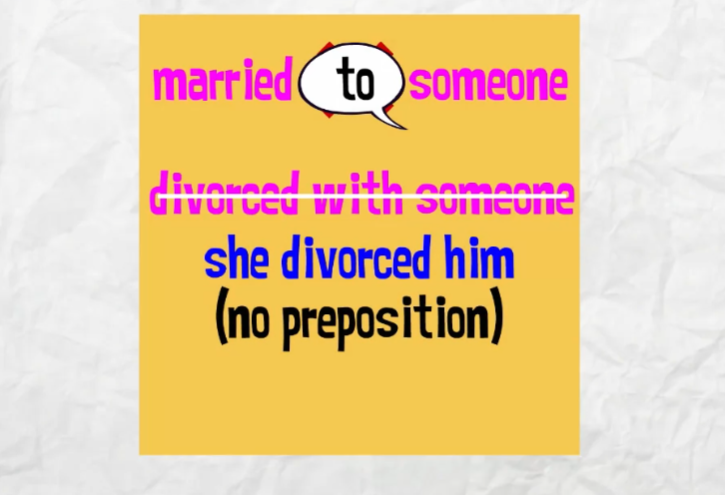
Well, that was a very long
tour with lots of notes. Collocations are certainly confusing. The list of collocations I have
provided is not a complete list, but it is very relevant to daily life topics. If you would like to improve your
collocations, here are some tips. Number one, study more collocations and try to use the correct
forms as much as you can. Number two, read more. There are a lot of collocations in
newspapers, magazines, and books. The more you read, the more you naturally
learn and remember correct collocations. Good luck and come back again, bye.
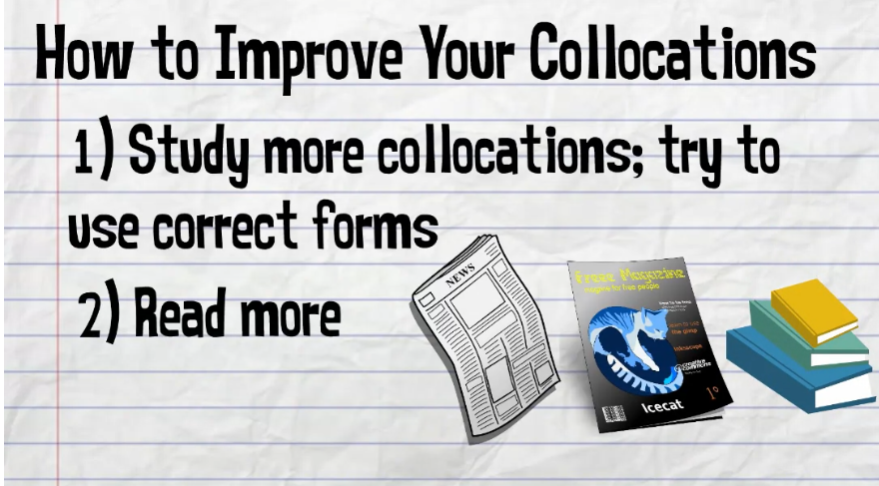
Collocations Practice Quiz
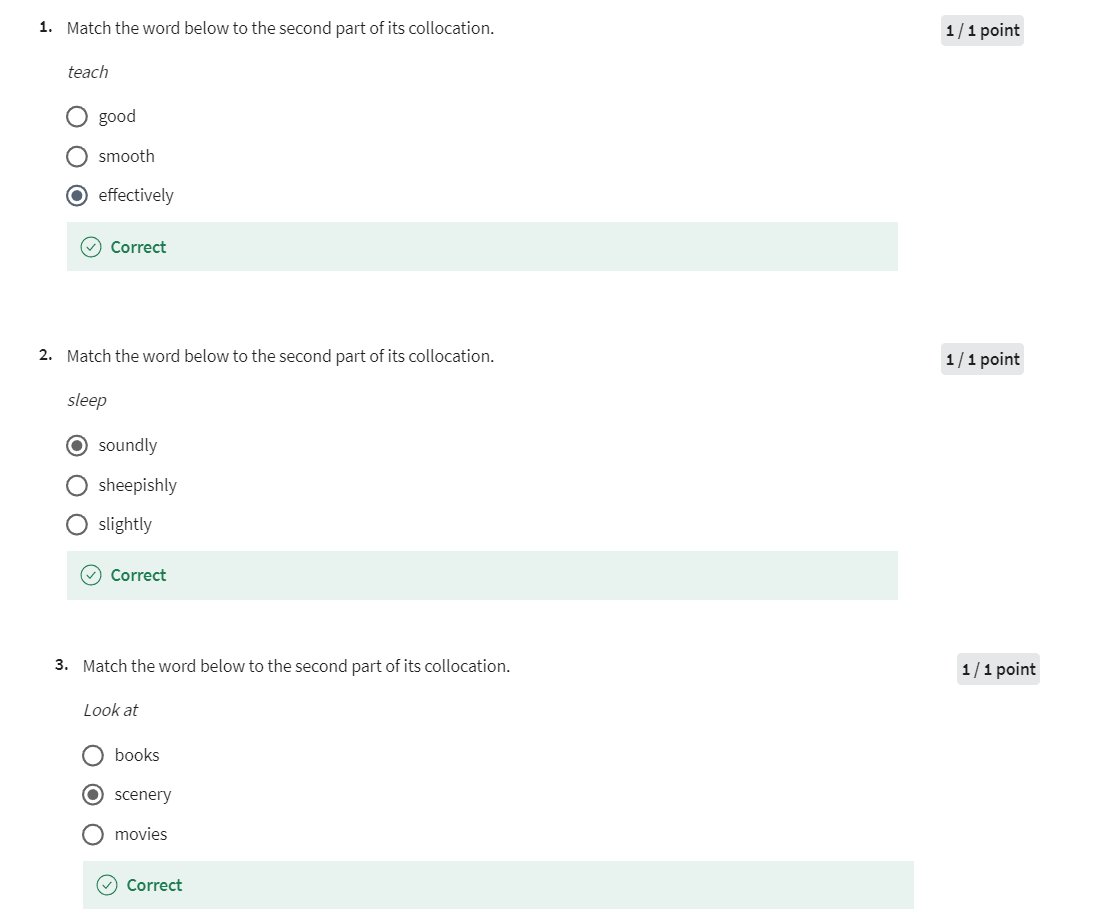
Tricky English Review
In this tricky grammar review you
will meet a character named Marie. Marie took this course and her family is really excited that
she’s taking English lessons online. Her husband Theo and
her 70 year old sister Layla both text Marie in English because
they wanted to practice English too. Marie is now confident after
taking this course and enjoys correcting their mistakes. See if you can correct their mistakes too. >> 8 AM at the office. [NOISE] I think that’s my husband. Honey, where is my red pants? Did you include them when
you clean the laundry? Why does he need his red pants? Theo really should be more careful
instead of saying where is my red pants? He should say, where are my red pants? Because pants is a plural noun and
it requires a plural verb. And I also remember learning that
laundry does not collocate with clean. It collocates with do. So he should have said, when you did
the laundry
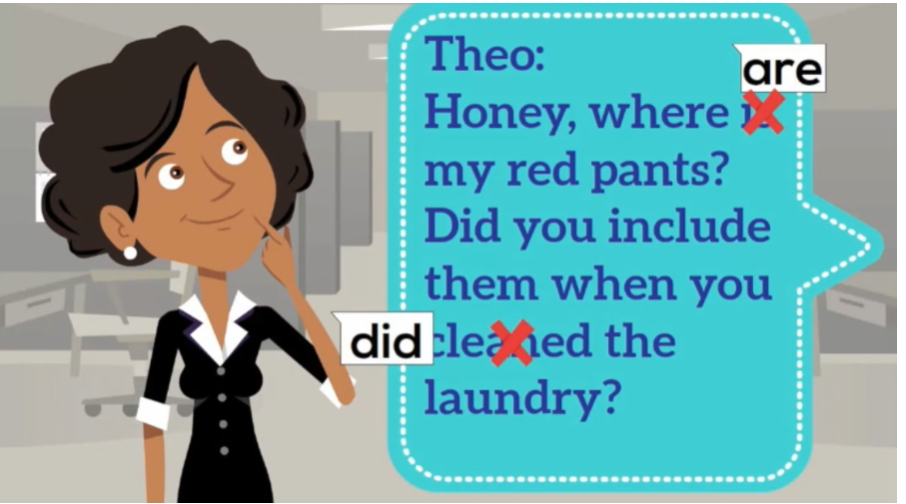
9 AM, still at the office. Another message from Theo! The bus came late again. I am in the bus now, but
I’ll be 20 minutes late. Aww, my poor husband. I hope his boss doesn’t
get too angry with him. But I noticed he said in the bus when
he should have said, on the bus. Like on a plane and on a train.
12 PM, lunch at the park. [NOISE] It’s Layla! Hi, big sister. Could you helping me find an university? I want study chemistry. [NOISE] There is a lot of informations. I don’t know where to start. I see a lot of mistakes here. Instead of saying could you helping,
she should have used the base form help. Could you help? And university begins with
a consonant sound, so instead of using an,
she should have used a, a university. And after the main verb want she
should have used an infinitive form. So she could add to and
say I want to study chemistry. And maybe she doesn’t know that
information is a non-count noun. So no s is needed here. Hm, what can I tell her?
I know, 12:04. Still at the park. [SOUND] It’s Layla responding. Thank you, Marie. You always give me the best advice. Also, can you borrow me your
silver dress for my graduation? I see a couple more mistakes. So instead of using advise, the verb, she
wants to use advice, the noun with a C. And I think she means can you
lend me your silver dress. She would borrow it, and
I would lend it to her.
4:15 PM, back at the office. [SOUND] That must be
Theo asking about dinner. Honey, don’t worry about dinner tonight. Myself will make dinner. Yay, I don’t have to make dinner,
but instead of saying myself will make dinner,
I think Theo meant I will make dinner. [SOUND] Can you bring desert? But no more fruit please. We have much fruit already. Desert? I’m sure he meant dessert. And I remember learning to use much in
affirmative sentences sounds very formal. So it would better to say a lot of fruit. Hm, I think I’ll buy
some chocolate ice cream.
6:30 at the market. [SOUND] It’s Layla again. You are the best sister in whole world. Me, you, and Theo should have dinner soon. I miss to hang out with you guys. Aw, she’s so sweet. But instead of saying in whole world, she should’ve said the whole
world because there’s one world. And instead of saying Me, you and
Theo, she should have said, you, Theo, and I, putting herself last. And after Miss, you need to use a gerund,
not an infinitive. So she should have said,
I miss hanging out with you guys. I miss hanging out with her too. [SOUND] Honey, where is cat? I don’t see her anywhere. Cat? Is he talking about our cat? Where is the cat? No! I better get home right away. Night time.
The end.
You might feel like Marie,
noticing mistakes and fixing them. Thanks to the lessons that
you’ve learned in this course. English can be tricky, but that’s okay. You can fix your own mistakes and the
mistakes of others and learn from them. Thanks for all of your hard work. We hope that you come back and
learn from us again, bye.
Tricky English Practice Quiz


Tricky English Final Practice
Practice
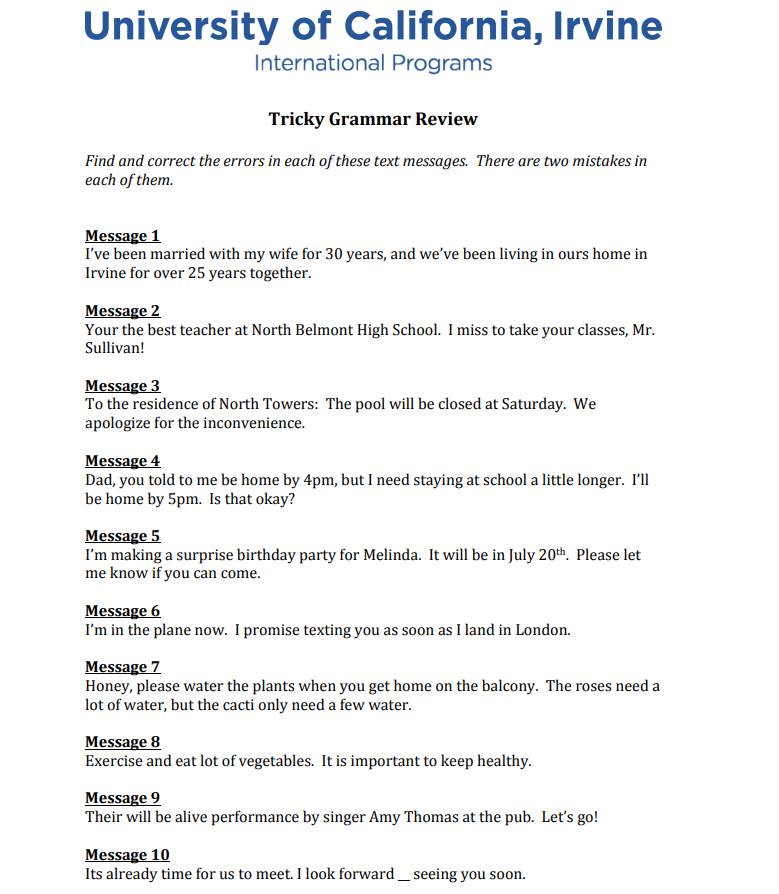
Practice key
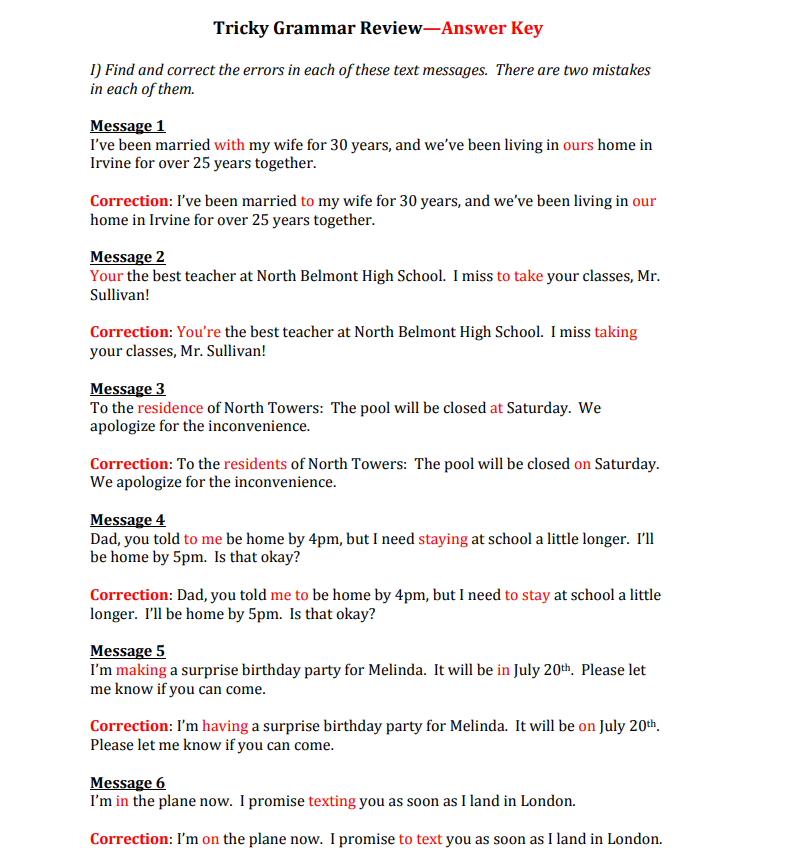
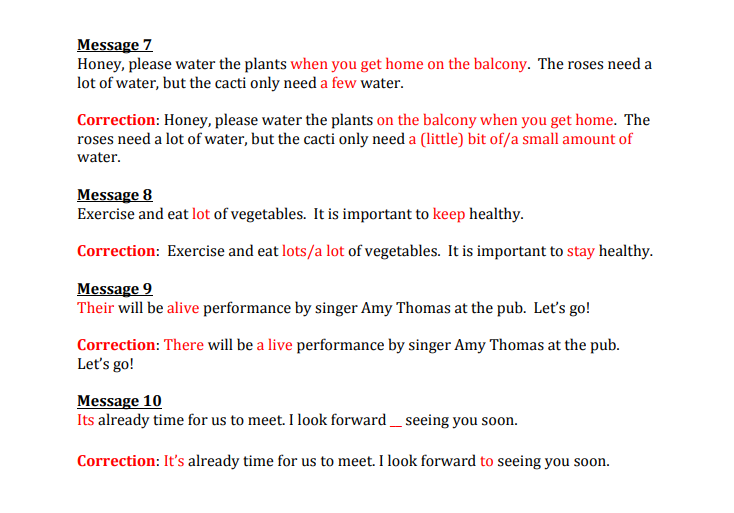
Graded Assignment: Tricky English Assignment
This assignment has two parts. First, write 5 sentences with collocations or phrasal verbs from this week’s lessons. Make sure to use them correctly. Then think about other tricky English words or phrases that give you difficulty. Use a dictionary to look them up. List at least 5 new tricky English words or phrases that were not mentioned in this class and explain their meanings using your own words. If the words or phrases are hard to understand, give an example too. Then use the new words or phrases in sentences.
One example of a new tricky English phrase not from this class:
A common mistake is saying, “I back to my country last week.” In this sentence, the word “back” is being used incorrectly as a verb. The correct way to say this sentence is to add a verb, for example, “I went back to my country last week.”
本周的课程包括:使用bright smile, turn on the lights, make coffee, drink soup,take medicine 这五个搭配
my try
Sentences with collocations or phrasal verbs from this week’s lessons:
- She greeted us with a bright smile when we arrived at the party.
- Could you please turn on the lights? It’s getting dark in here.
- Every morning, I make coffee to help me wake up and start my day.
- After feeling unwell for a few days, she decided to drink soup to help her feel better.
- The doctor advised me to take medicine three times a day for a week to treat my cold.
New tricky English words or phrases:
- Ubiquitous - This word means “existing or being everywhere at the same time.” Example: In today’s world, smartphones have become ubiquitous, with almost everyone owning one.
- Paradox - A paradox is a statement or proposition that seems self-contradictory or absurd but in reality expresses a possible truth. Example: The idea that less is more is a paradox, as it suggests that simplicity can be more effective than complexity.
- Serendipity - Serendipity refers to the occurrence of events by chance in a happy or beneficial way. Example: Meeting my best friend at a random party was a serendipitous moment that changed my life.
- Schadenfreude - Schadenfreude is the experience of pleasure, joy, or self-satisfaction that comes from learning of or witnessing the troubles, failures, or humiliation of another. Example: It’s not nice to feel schadenfreude when someone else fails; it’s important to be empathetic and supportive.
- Zeitgeist - Zeitgeist refers to the defining spirit or mood of a particular period of history as shown by the ideas and beliefs of the time. Example: The fashion of the 1960s reflected the zeitgeist of rebellion and social change.
Sentences using new tricky English words or phrases:
- The company’s logo has become ubiquitous, appearing on billboards, advertisements, and even merchandise around the world.
- It’s a paradox that sometimes the more we have, the less satisfied we feel.
- Their unexpected encounter on the train platform was a serendipitous moment that led to a lifelong friendship.
- It’s not healthy to experience schadenfreude when others fail; instead, we should strive to lift each other up.
- The music of the 1980s captured the zeitgeist of excess and glamour that characterized the era.
Graded Quiz

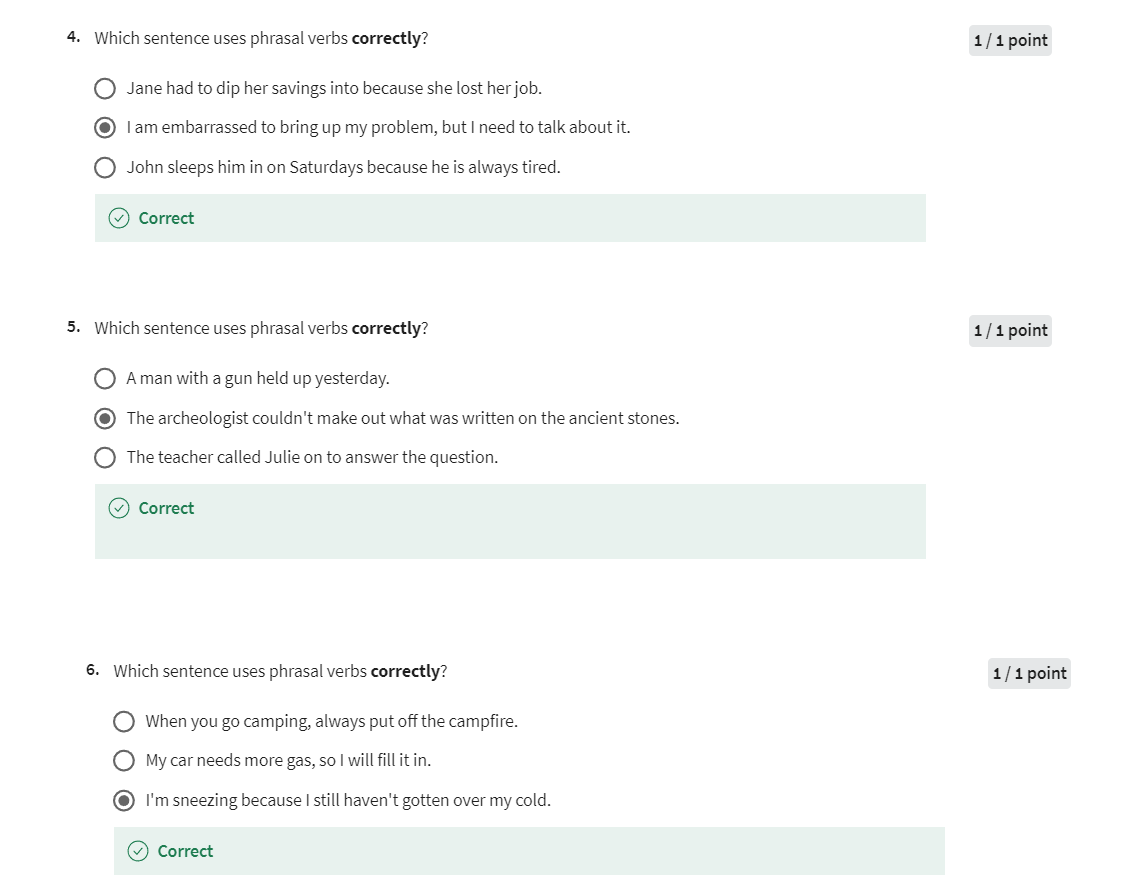
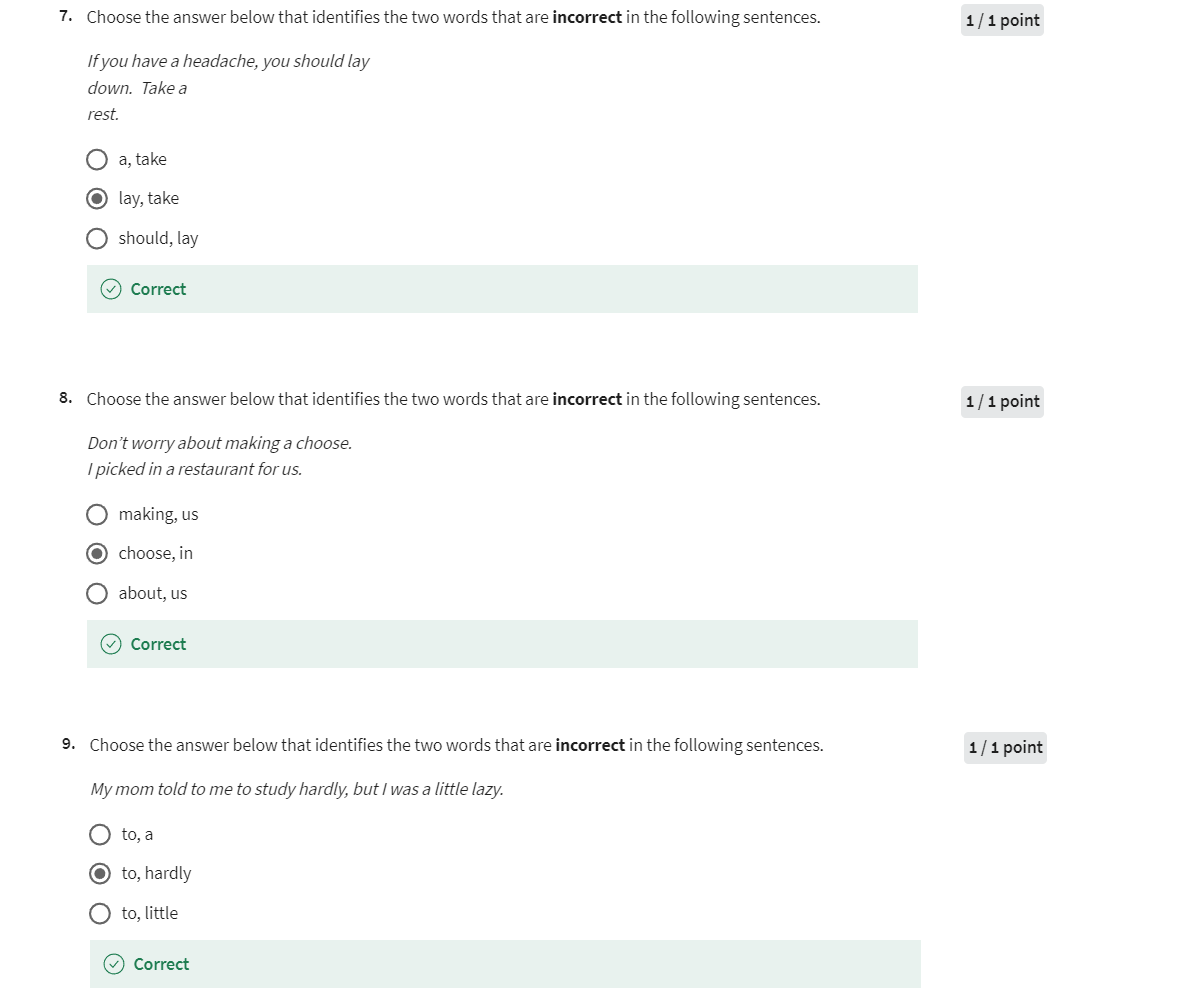
后记
今天是2024年5月3日,正是五一劳动节假期期间。花费5h完成这门课。
2024年5月3日19点59分于上海。

